Updated 12/13/2022
Oregon Average Drops Below $4 a Gallon
National Average Drops Below Year-Ago Price
PORTLAND, Ore., – For the first time since Feb. 23, the Oregon average for regular unleaded has dropped below $4 a gallon. Gas prices continue to fall in all 50 states again this week. Lower crude oil prices, lackluster demand for gas, and growing gasoline stocks are the major drivers. For the week, the national average for regular loses 14 cents to $3.25 a gallon. The Oregon average tumbles 18 cents to $3.98. Oregon has the ninth-largest weekly drop and fifth-largest monthly drop for a state in the nation.
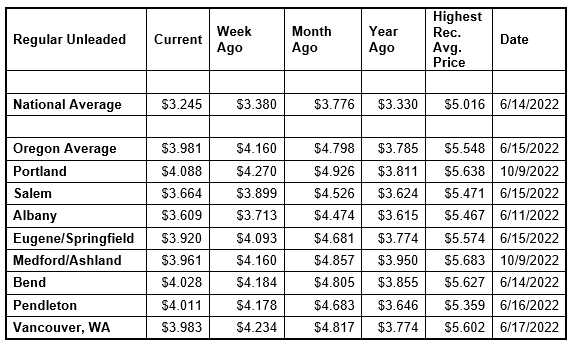
As of last Thursday, December 8, the national average dipped below its year-ago price for the first time in 654 days. As of today, 34 states have averages that are cheaper than last year. The Oregon average is 20 cents more than a year ago. AAA expects that Oregon and all other states except Alaska, Hawaii and Nevada will see gasoline deflation in the coming weeks.
“The seasonal pattern of less driving due to shorter days and winter weather along with lower crude oil prices are causing pump prices to fall. AAA expects the national average will drop below $3 a gallon in the coming weeks,” says Marie Dodds, public affairs director for AAA Oregon/Idaho.
This month crude oil fell below $72 per barrel, the lowest price December 2021. This month, West Texas Intermediate, the U.S. benchmark, has ranged between about $71.50 and $81 per barrel. In November, WTI ranged between $76 and $92 per barrel. In October, crude ranged between $82 and $92 per barrel. In September, crude prices ranged between about $76 and $88 per barrel. Crude reached a recent high of $122.11 per barrel on June 8. The all-time high for WTI crude oil is $147.27 in July 2008.
Crude prices rose dramatically leading up to and in the first few months of Russia’s invasion of Ukraine. Russia is one of the world’s top oil producers and its involvement in a war causes market volatility, and sanctions imposed on Russia by the U.S. and other western nations resulted in tighter global oil supplies. Oil supplies were already tight around the world as demand for oil increased as pandemic restrictions eased. A year ago, crude was around $71 per barrel compared to $76 today.
Crude oil is the main ingredient in gasoline and diesel, so pump prices are impacted by crude prices on the global markets. On average, about 56% of what we pay for in a gallon of gasoline is for the price of crude oil, 20% is refining, 11% distribution and marketing, and 14% are taxes, according to the U.S. Energy Information Administration.
Demand for gasoline in the U.S. is holding steady for the third consecutive week at about at 8.3 million b/d for the week ending December 2. This compares to 8.9 million b/d at this time last year. Total domestic gasoline stocks rose significantly by 5.3 million bbl to 219.1 million bbl. Increasing supply and lower gasoline demand will push pump prices lower barring any supply glitches.
Quick stats
Pump prices are lower this week in all 50 states and the District of Columbia. Alaska (-27 cents) has the largest weekly drop, followed by Montana (-27 cents), California (-21 cents), Nevada (-20 cents), and Michigan (-19 cents). Oregon (-18 cents) has the ninth-largest weekly drop. Hawaii (-4 cents) has the smallest weekly decline.
Hawaii ($5.14) is the state with the most expensive gas in the nation for the third week in a row and is the only state with an average at or above $5 a gallon. California ($4.51) is second and Nevada ($4.24) is third. This week four states have averages at or above $4, 31 states and the District of Columbia have averages in the $3-range, and 15 states have averages below $3 a gallon.
The cheapest gas in the nation is in Texas ($2.69) and Oklahoma ($2.70). For the 101st week in a row, no state has an average below $2 a gallon.
The difference between the most expensive and least expensive states is $2.46 which continues to be stark.
All 50 states and the District of Columbia have lower prices now than a month ago. The national average is 53 cents less and the Oregon average is 82 cents less than a month ago. Oregon has the fifth-largest monthly decrease in the nation. California (-93 cents) and Alaska (-91 cents) have the largest monthly decline. Hawaii (-5 cents) has the smallest.
Oregon is one of 16 states and the District of Columbia with higher prices now than a year ago. The national average is nine cents less and the Oregon average is 20 cents more than a year ago. This is the fifth-largest year-over-year increase in the nation. Hawaii (+81 cents), Nevada (+36 cents), Washington (+21 cents), and Pennsylvania (+20 cents) have the largest yearly gains. Colorado (-40 cents) has the biggest year-over-year decline.
West Coast
The West Coast region continues to have the most expensive pump prices in the nation with all seven states in the top 10. This is typical for the West Coast as this region tends to consistently have fairly tight supplies, consuming about as much gasoline as is produced. In addition, this region is located relatively far from parts of the country where oil drilling, production and refining occurs, so transportation costs are higher. And environmental programs in this region add to the cost of production, storage and distribution.
Refinery issues in California in September and October exacerbated the situation, creating extremely tight supplies and causing pump prices in this region to skyrocket.
| Rank | Region | Price on 12/13/22 | ||
| 1 | Hawaii | $5.14 | ||
| 2 | California | $4.51 | ||
| 3 | Nevada | $4.24 | ||
| 4 | Washington | $4.09 | ||
| 5 | Oregon | $3.98 | ||
| 6 | Alaska | $3.83 | ||
| 7 | Idaho | $3.77 | ||
| 8 | Pennsylvania | $3.76 | ||
| 9 | Arizona | $3.68 | ||
| 10 | Utah | $3.61 |
As mentioned above, Hawaii is the most expensive state in the nation, with California, Nevada, Washington, Oregon, and Alaska rounding out the top six. Arizona is ninth. Oregon is fifth most expensive for the fifth week in a row.
All of the states in the West Coast region are seeing weekly drops. Alaska (-27 cents) has the largest in the region and the country. Hawaii (-4 cents) has the smallest in the region and country.
The refinery utilization rate on the West Coast rose from 89.7% to 91.9% for the week ending December 2. This rate has ranged between about 76% to 93% in the last year.
According to EIA’s latest weekly report, total gas stocks in the region increased from 29.94 million bbl. to 30.74 million bbl.
Oil market dynamics
Crude prices softened last week due to a stronger dollar. Additionally, crude prices were pushed down after the EIA reported that total domestic commercial crude stocks fell by 5.2 million bbl, a lower amount than the market expected. The domestic commercial crude supply is 19 million bbl lower than the beginning of December 2021. For this week, crude prices could slide if the market continues to worry that global oil demand will stagnate or decline into 2023, especially in China, due to rising coronavirus infection rates.
At the close of Friday’s formal trading session, WTI decreased by 44 cents to settle at $71.02. At the close of Monday’s formal trading session, WTI added $2.15 to close at $73.17. Today crude is trading around $75, compared to $74 a week ago. Crude prices are about $2 more than a year ago.
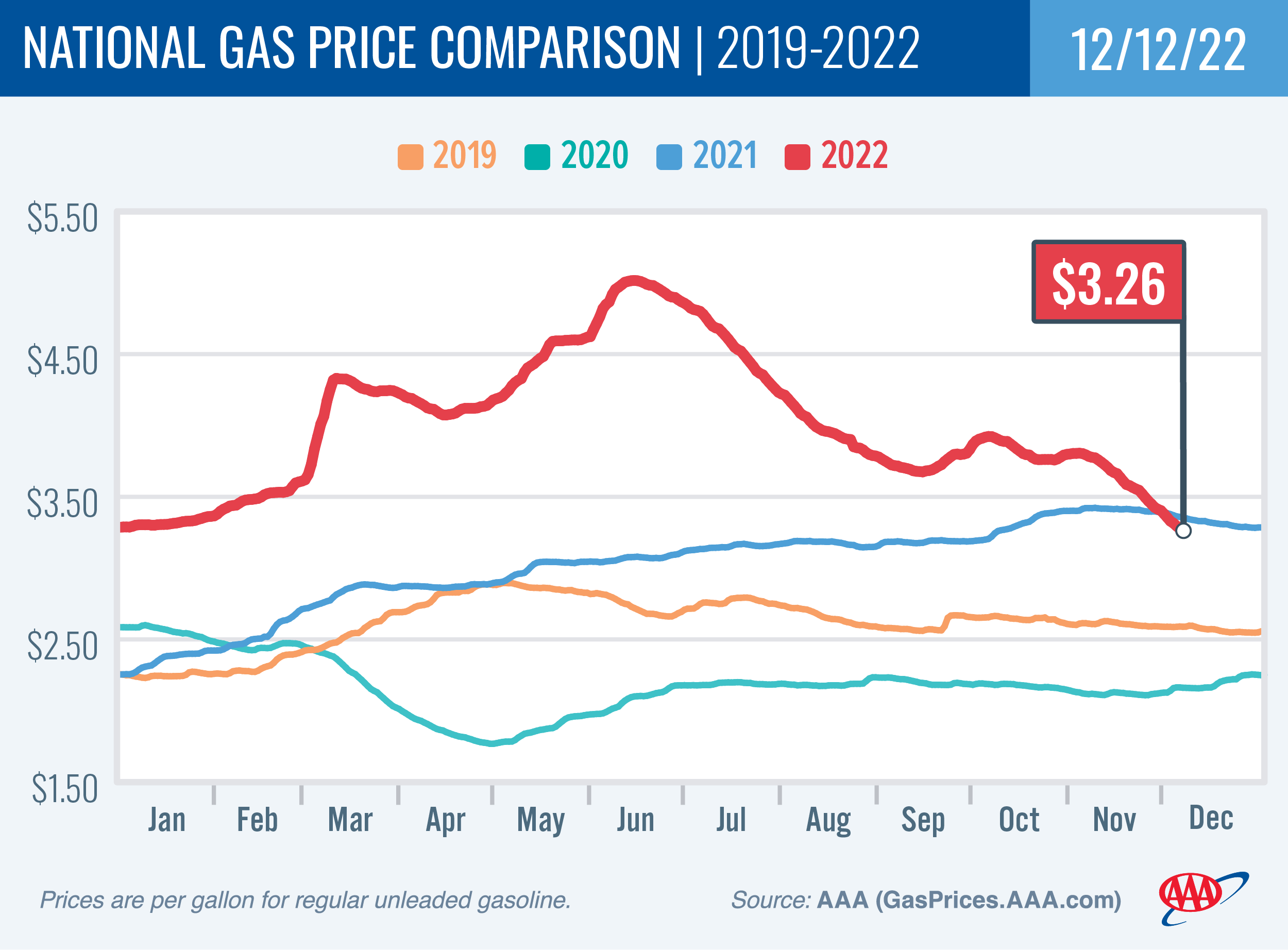
Drivers can find current gas prices along their route with the free AAA Mobile app for iPhone, iPad and Android. The app can also be used to map a route, find discounts, book a hotel and access AAA roadside assistance. Learn more at AAA.com/mobile.
Diesel
For the week, the national average falls 17 cents to $4.89 a gallon. The record high is $5.816 set on June 19. The Oregon average loses 19 cents to $5.09. The record high is $6.47 set on July 3. A year ago the national average for diesel was $3.60 and the Oregon average was $3.81.
Find current fuel prices at GasPrices.AAA.com.
AAA news releases, high resolution images, broadcast-quality video, fact sheets and podcasts are available on the AAA NewsRoom at NewsRoom.AAA.com.
Find local news releases at https://oregon.aaa.com/community/media/media-contacts.html
Fuel prices are updated daily at AAA’s Daily Fuel Gauge at AAA Gas Prices. For more info go www.AAA.com. AAA Oregon/Idaho provides more than 875,000 members with travel, insurance, financial and automotive-related services, and is an affiliate of AAA National, serving more than 63 million motorists in North America.
Updated 12/6/2022
Gas Prices Keep Plunging; West Coast has Largest Drops
Oregon has second-largest weekly decline and sixth-largest monthly drop
PORTLAND, Ore., – Drivers are getting an early holiday gift as pump prices continue to plummet. They’re lower in all 50 states again this week, driven by lower crude oil prices, steady demand for gas and growing gasoline stocks. For the week, the national average for regular tumbles 14 cents to $3.38 a gallon. The Oregon average slides 26 cents to $4.16. Oregon has the second-largest weekly drop and sixth-largest monthly drop for a state in the nation.
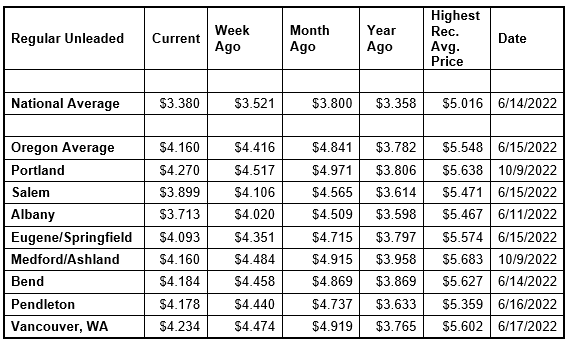
At its meeting on Sunday, OPEC+, a group of 23 oil-producing nations, including Saudi Arabia and Russia, decided to maintain its output cuts of 2 million barrels per day, about 2% of world oil demand. The purpose of the move is to boost the global price of oil, which has fallen recently on fears of demand weakness, specifically in China where stringent COVID-19 lockdowns have led to reduced oil consumption in that nation.
Despite the decision from OPEC+, crude oil prices are at their lowest prices since December 2021, below $80 per barrel, and that’s helping to push pump prices lower.
“Gas prices are dropping sharply. The national average is poised to drop below $3 a gallon and the Oregon average below $4 a gallon by the end of the year,” says Marie Dodds, public affairs director for AAA Oregon/Idaho. “But with oil being the main ingredient in gasoline, the move by OPEC+ had the potential to slow this decline, but it hasn’t happened yet.”
Crude reached a recent high of $122.11 per barrel on June 8, and ranged from about $94 to $110 per barrel in July. In August, crude prices ranged between about $86 and $97. In September, crude prices ranged between about $76 and $88 per barrel. In October, crude ranged between $82 and $92 per barrel. In November, crude ranged between $76 and $92 per barrel. The all-time high for WTI crude oil is $147.27 in July 2008.
Crude prices rose dramatically leading up to and in the first few months of Russia’s invasion of Ukraine. Russia is one of the world’s top oil producers and its involvement in a war causes market volatility, and sanctions imposed on Russia by the U.S. and other western nations resulted in tighter global oil supplies. Oil supplies were already tight around the world as demand for oil increased as pandemic restrictions eased. A year ago, crude was around $69 per barrel compared to $75 today.
Crude oil is the main ingredient in gasoline and diesel, so pump prices are impacted by crude prices on the global markets. On average, about 56% of what we pay for in a gallon of gasoline is for the price of crude oil, 20% is refining, 11% distribution and marketing, and 14% are taxes, according to the U.S. Energy Information Administration.
Demand for gasoline in the U.S. held steady at 8.3 million b/d for the week ending November 25. This compares to 8.8 million b/d at this time last year. Total domestic gasoline stocks rose by nearly 2.8 million bbl to 213.8 million bbl. Increasing supply and steady gasoline demand should continue to push pump prices lower barring any supply glitches.
Quick stats
Pump prices are lower this week in all 50 states and the District of Columbia. California (-28 cents) has the largest weekly drop, followed by Oregon (-26 cents), Delaware (-23 cents), Nevada (-22 cents), Washington (-22 cents), Alaska (-22 cents), Indiana (-21 cents), Arizona (-21 cents), Michigan (-20 cents) and Montana (-19 cents). Hawaii (-1 cent) has the smallest weekly decline.
Hawaii ($5.18) is the state with the most expensive gas in the nation for the second week in a row and is the only state with an average at or above $5 a gallon. California ($4.72) is second and Nevada ($4.44) is third. This week six states, including Oregon, have averages at or above $4, 34 states and the District of Columbia have averages in the $3-range, and 10 states have averages below $3 a gallon.
The cheapest gas in the nation is in Texas ($2.78) and Oklahoma ($2.86). For the 100th week in a row, no state has an average below $2 a gallon.
The difference between the most expensive and least expensive states is $2.40 which continues to be stark.
All 50 states and the District of Columbia have lower prices now than a month ago. The national average is 42 cents less and the Oregon average is 68 cents less than a month ago. Oregon has the sixth-largest monthly decrease in the nation. Wisconsin (-86 cents) has the largest monthly decline. Hawaii (-2 cents) has the smallest.
Oregon is one of 32 states and the District of Columbia with higher prices now than a year ago. The national average is two cents more and the Oregon average is 38 cents more than a year ago. This is the fifth-largest year-over-year increase in the nation. Hawaii (+85 cents), Nevada (+52 cents), Washington (+40 cents), and Alaska (+39 cents) have the largest yearly gains. Colorado (-30 cents) has the biggest year-over-year decline.
West Coast
The West Coast region continues to have the most expensive pump prices in the nation with all seven states in the top 10. This is typical for the West Coast as this region tends to consistently have fairly tight supplies, consuming about as much gasoline as is produced. In addition, this region is located relatively far from parts of the country where oil drilling, production and refining occurs, so transportation costs are higher. And environmental programs in this region add to the cost of production, storage and distribution.
Refinery issues in California in September and October exacerbated the situation, creating extremely tight supplies and causing pump prices in this region to skyrocket.
| Rank | Region | Price on 12/6/22 | ||
| 1 | Hawaii | $5.18 | ||
| 2 | California | $4.72 | ||
| 3 | Nevada | $4.44 | ||
| 4 | Washington | $4.27 | ||
| 5 | Oregon | $4.16 | ||
| 6 | Alaska | $4.10 | ||
| 7 | Idaho | $3.92 | ||
| 8 | Pennsylvania | $3.86 | ||
| 9 | Arizona | $3.85 | ||
| 10 | Utah | $3.76 |
As mentioned above, Hawaii is the most expensive state in the nation, with California, Nevada, Washington, Oregon, and Alaska rounding out the top six. Arizona is ninth. Oregon is fifth most expensive for the fourth week in a row.
All of the states in the West Coast region are seeing weekly drops. California (-28 cents) has the largest in the region and the country. Hawaii (-1 cent) has the smallest in the region and country.
The refinery utilization rate on the West Coast rose from 88.7% to 89.7%for the week ending November 25. This rate has ranged between about 76% to 93% in the last year.
According to EIA’s latest weekly report, total gas stocks in the region increased from 28.69 million bbl. to 29.94 million bbl.
Oil market dynamics
A weaker dollar contributed to decreasing crude prices at the end of last week. Earlier in the week, crude prices were boosted by the EIA reporting that total domestic commercial crude stocks fell dramatically by 12.6 million bbl. The domestic commercial crude supply is 14 million bbl lower than at the end of November 2021. For this week, crude prices could rise in response to the European Union, Australia, Japan, United States, Canada, and the U.K. beginning to implement a $60 per barrel price cap on Russian seaborne crude oil, which is meant to limit the country’s revenues in response to the Ukrainian invasion. This effort follows Sunday’s virtual meeting for the Organization of the Petroleum Exporting Countries (OPEC) and its allies, also known as OPEC+, where the cartel agreed to keep its production reduction agreement of 2 million b/d unchanged through 2023.
At the close of Friday’s formal trading session, WTI decreased by $1.24 to settle at $79.98. At the close of Monday’s formal trading session, WTI tumbled $3.05 to close at $76.93. Today crude is trading around $75, compared to $78 a week ago. Crude prices are about $10 more than a year ago.
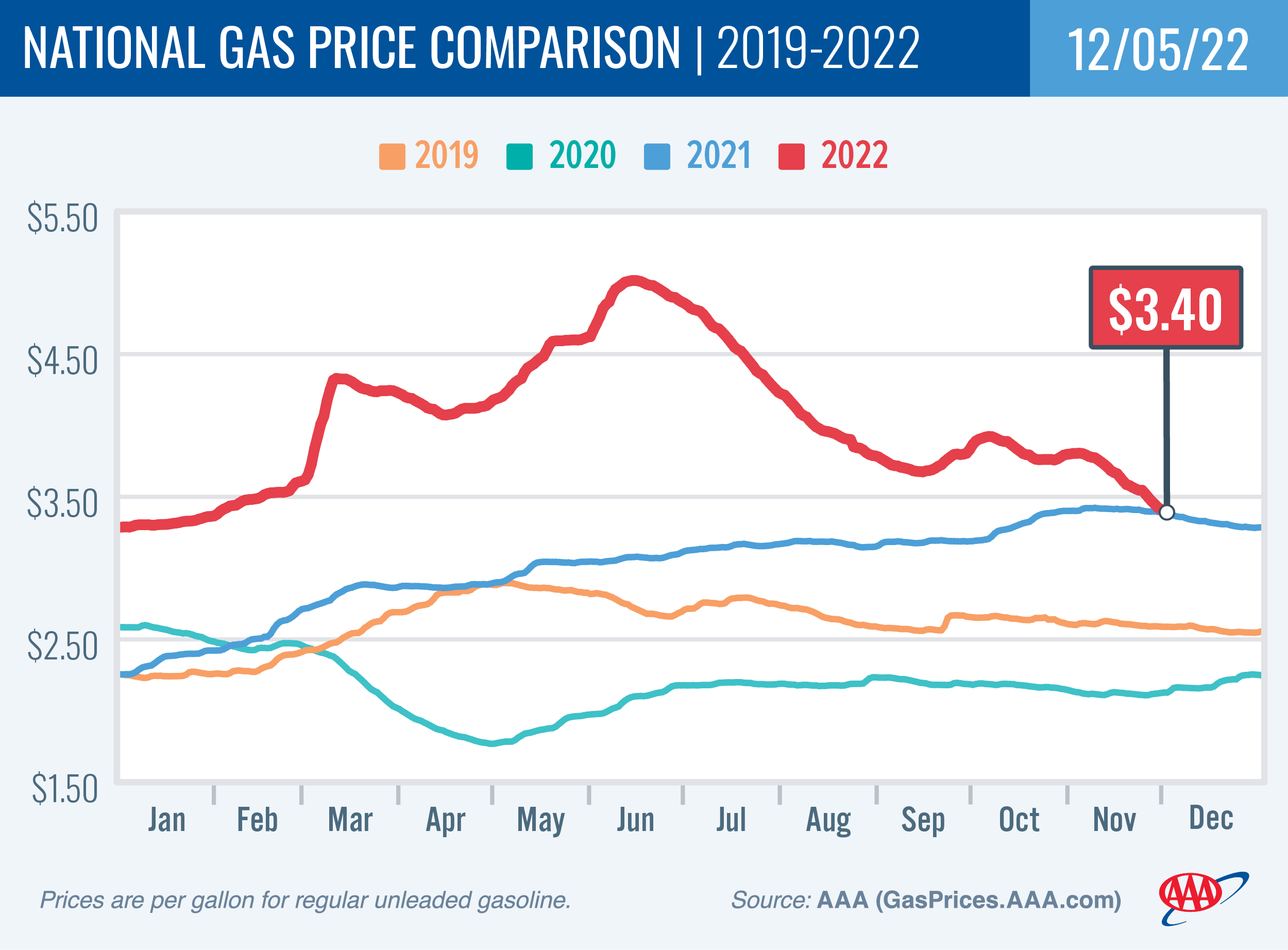
Drivers can find current gas prices along their route with the free AAA Mobile app for iPhone, iPad and Android. The app can also be used to map a route, find discounts, book a hotel and access AAA roadside assistance. Learn more at AAA.com/mobile.
Diesel
For the week, the national average loses 14 cents to $5.06 a gallon. The record high is $5.816 set on June 19. The Oregon average falls 18 cents to $5.27. The record high is $6.47 set on July 3. A year ago the national average for diesel was $3.62 and the Oregon average was $3.80.
Find current fuel prices at GasPrices.AAA.com.
AAA news releases, high resolution images, broadcast-quality video, fact sheets and podcasts are available on the AAA NewsRoom at NewsRoom.AAA.com.
Find local news releases at https://oregon.aaa.com/community/media/media-contacts.html
Fuel prices are updated daily at AAA’s Daily Fuel Gauge at AAA Gas Prices. For more info go www.AAA.com. AAA Oregon/Idaho provides more than 875,000 members with travel, insurance, financial and automotive-related services, and is an affiliate of AAA National, serving more than 63 million motorists in North America.
Updated 11/29/2022
Gas Prices Keep Sliding with Larger Drops on the West Coast
Oregon has fifth-largest weekly decline and second-largest monthly drop
PORTLAND, Ore., – Pump prices and crude oil prices are doing a nosedive. Gas prices are down in all 50 states this week, with Oregon and the other West Coast states seeing some of the biggest declines. For the week, the national average for regular loses 12 cents to $3.52 a gallon. The Oregon average plummets 19 cents to $4.42. Oregon has the fifth-largest weekly drop and second-largest monthly drop for a state in the nation.

Crude oil prices are at their lowest prices since December 2021, below $80 per barrel, and that’s helping to push pump prices lower. Extreme coronavirus restrictions in China and concerns over a global recession are the major driving factors behind the lower crude oil prices.
Crude oil prices rose above $90 briefly earlier this month but have been lower than $80 for the past week. Crude reached a recent high of $122.11 per barrel on June 8, and ranged from about $94 to $110 per barrel in July. In August, crude prices ranged between about $86 and $97. In September, crude prices ranged between about $76 and $88 per barrel. In October, crude ranged between $82 and $92 per barrel.
Crude prices rose dramatically leading up to and in the first few months of Russia’s invasion of Ukraine. Russia is one of the world’s top oil producers and its involvement in a war causes market volatility, and sanctions imposed on Russia by the U.S. and other western nations resulted in tighter global oil supplies. Oil supplies were already tight around the world as demand for oil increased as pandemic restrictions eased. A year ago, crude was around $70 per barrel compared to $77 today.
Crude oil is the main ingredient in gasoline and diesel, so pump prices are impacted by crude prices on the global markets. On average, about 56% of what we pay for in a gallon of gasoline is for the price of crude oil, 20% is refining, 11% distribution and marketing, and 14% are taxes, according to the U.S. Energy Information Administration.
Demand for gasoline in the U.S. fell from 8.74 million to 8.33 million b/d for the week ending November 18. This compares to 9.33 million b/d at this time last year. Total domestic gasoline stocks rose by more than 3 million bbl to 211 million bbl. Increasing supply and fewer drivers fueling up have pushed pump prices lower. As demand remains low and stocks grow, drivers will likely see pump prices keep falling barring any supply glitches.
Quick stats
Pump prices are lower this week in all 50 states and the District of Columbia. Alaska (-28 cents) has the largest weekly drop, and California (-21 cents) has the second-largest drop. Hawaii (-4/10ths of a cent) has the smallest weekly decline.
For the first time in 12 weeks, Hawaii ($5.20) bumps California ($4.99) as the state with the most expensive gas in the country. Hawaii is now the only state with an average at or above $5 a gallon. This week eight states, including Oregon, have averages at or above $4, and 42 states and the District of Columbia have averages in the $3-range.
The cheapest gas in the nation is in Texas ($2.87) and Mississippi ($3.02). For the 99th week in a row, no state has an average below $2 a gallon.
The difference between the most expensive and least expensive states is $2.33 which continues to be stark.
Oregon is one of 49 states and the District of Columbia with lower prices now than a month ago. The national average is 24 cents less and the Oregon average is 56 cents less than a month ago. Oregon has the second-largest monthly decrease in the nation. California (-59 cents) has the largest monthly declines. Florida (+7 cents) is the only state with a month-over-month increase.
Oregon is one of 40 states and the District of Columbia with higher prices now than a year ago. The national average is 13 cents more and the Oregon average is 63 cents more than a year ago. This is the third-largest year-over-year increase in the nation. Hawaii (+84 cents) and Nevada (+70 cents) have the largest yearly gains. Colorado (-20 cents) has the biggest year-over-year decline.
West Coast
The West Coast region continues to have the most expensive pump prices in the nation with all seven states in the top 10. This is typical for the West Coast as this region tends to consistently have fairly tight supplies, consuming about as much gasoline as is produced. In addition, this region is located relatively far from parts of the country where oil drilling, production and refining occurs, so transportation costs are higher. And environmental programs in this region add to the cost of production, storage and distribution.
Refinery issues in California in September and October exacerbated the situation, creating extremely tight supplies and causing pump prices in this region to skyrocket.
| Rank | Region | Price on 11/29/22 | ||
| 1 | Hawaii | $5.20 | ||
| 2 | California | $5.00 | ||
| 3 | Nevada | $4.67 | ||
| 4 | Washington | $4.49 | ||
| 5 | Oregon | $4.42 | ||
| 6 | Alaska | $4.32 | ||
| 7 | Idaho | $4.09 | ||
| 8 | Arizona | $4.06 | ||
| 9 | Pennsylvania | $3.96 | ||
| 10 | Utah | $3.90 |
As mentioned above, Hawaii bumps California as the most expensive state for the first time in 12 weeks. Nevada, Washington, Oregon, and Alaska round out the top six. Arizona is eighth. Oregon is fifth most expensive for the third week in a row.
All of the West Coast states are seeing weekly drops. Alaska (-28 cents) has the largest in the region and the country. Hawaii (-4/10ths of a cent) has the smallest in the region and country.
The refinery utilization rate on the West Coast fell from 92.7% to 887% for the week ending November 18. This rate has ranged between about 76% to 93% in the last year.
According to EIA’s latest weekly report, total gas stocks in the region increased from 27.99 million bbl. to 28.69 million bbl.
Oil market dynamics
Crude oil prices dropped last week despite the EIA reporting that total domestic commercial crude stocks had declined substantially by 3.7 million bbl. Instead, prices declined because the market is concerned that oil demand could decrease due to growing economic concerns. For this week, persistent concerns that economic growth might stall or reverse course could push prices lower. However, the Organization of the Petroleum Exporting Countries (OPEC) and its allies, including Russia, collectively known as OPEC+, are meeting on December 4. In October, OPEC+ decided to cut its collective crude oil output by 2 million b/d through 2023. If OPEC+ decides to revise its production reduction agreement to more than 2 million b/d, prices could spike.
At the close of Friday’s formal trading session, WTI decreased by $1.66 to settle at $76.28. At the close of Monday’s formal trading session, WTI added 96 cents to close at $77.24. Today crude is trading around $78, compared to $81 a week ago. Crude prices are about $9 more than a year ago.
Drivers can find current gas prices along their route with the free AAA Mobile app for iPhone, iPad and Android. The app can also be used to map a route, find discounts, book a hotel and access AAA roadside assistance. Learn more at AAA.com/mobile.
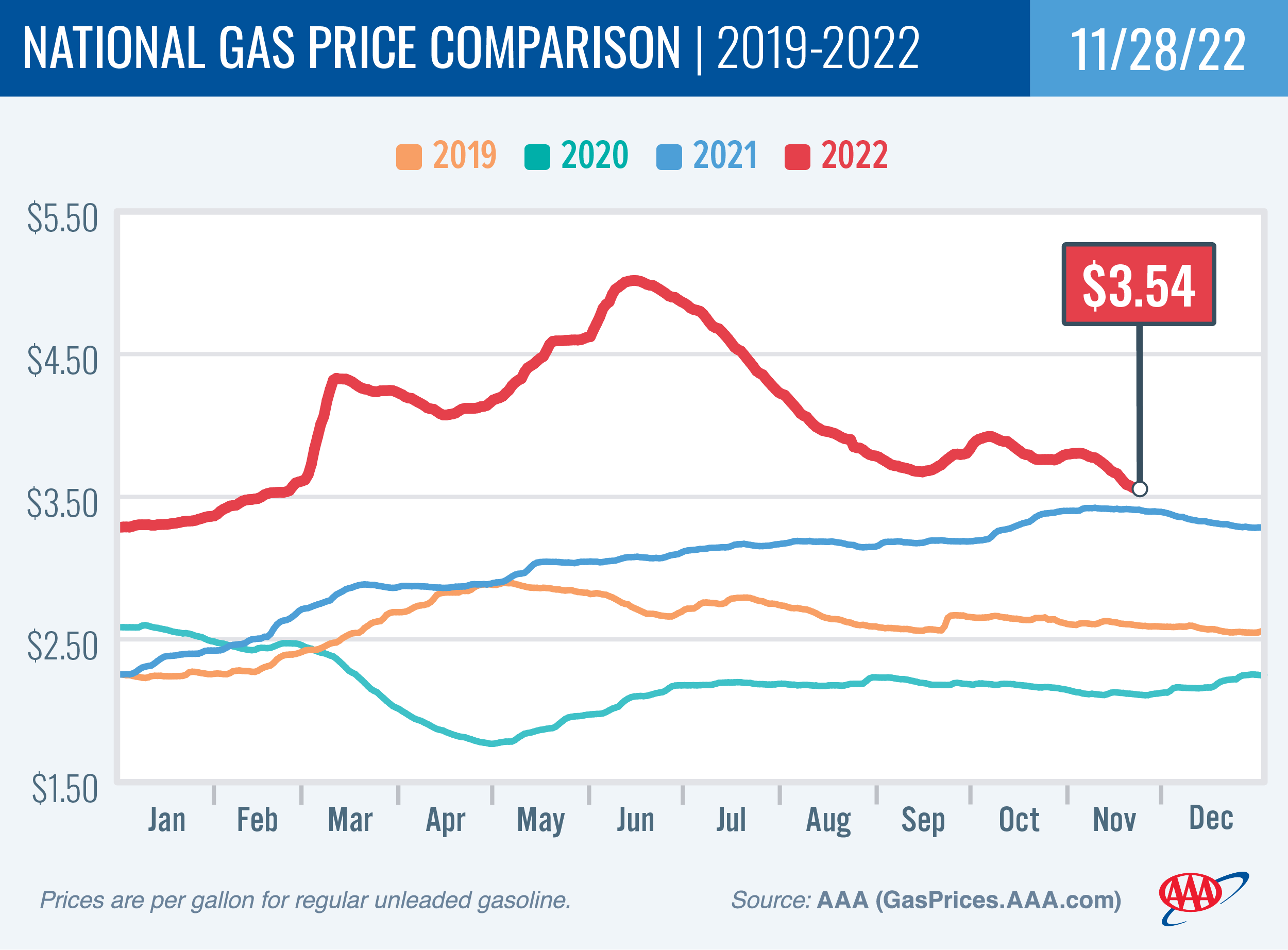
Diesel
For the week, the national average loses nine cents to $5.20 a gallon. The record high is $5.816 set on June 19. The Oregon average falls six cents to $5.46. The record high is $6.47 set on July 3. A year ago the national average for diesel was $3.64 and the Oregon average was $3.82.
Diesel supplies are tight in parts of the U.S., especially in parts of the eastern U.S. However, recent reports that the U.S. has less than a month worth of diesel aren’t accurate. While the U.S. Energy Information Administration shows the U.S. has 27.1 days’ worth of supply of diesel for the week ending November 18, this number actually measures supply IF no more diesel would be produced in the U.S. or imported from other countries. Supplies of diesel have slowly been rising, up from 25.4 days of diesel supply for the week ending Oct. 14. In 2019, diesel supplies were also very tight with the EIA reporting a low of 26.5 days.
Diesel supplies have been impacted by the same factors that have caused supply and demand issues in other industries including the pandemic and the Russian invasion of Ukraine. Tight supplies could result in climbing prices for diesel, but there have not been significant increases yet.
Find current fuel prices at GasPrices.AAA.com.
AAA news releases, high resolution images, broadcast-quality video, fact sheets and podcasts are available on the AAA NewsRoom at NewsRoom.AAA.com.
Find local news releases at https://oregon.aaa.com/community/media/media-contacts.html
Fuel prices are updated daily at AAA’s Daily Fuel Gauge at AAA Gas Prices. For more info go www.AAA.com. AAA Oregon/Idaho provides more than 875,000 members with travel, insurance, financial and automotive-related services, and is an affiliate of AAA National, serving more than 63 million motorists in North America.
Updated 11/22/2022
Pump Prices Plummet ahead of Thanksgiving
But gas prices are the most expensive ever for the holiday
PORTLAND, Ore., – Drivers fueling up ahead of Thanksgiving will find falling pump prices in all 50 states. Unfortunately, gas prices will be the most expensive ever for the holiday. For the week, the national average for regular tumbles 12 cents to $3.76 a gallon. The Oregon average plunges 17 cents to $4.77. This is the fifth-largest weekly drop for a state in the nation.
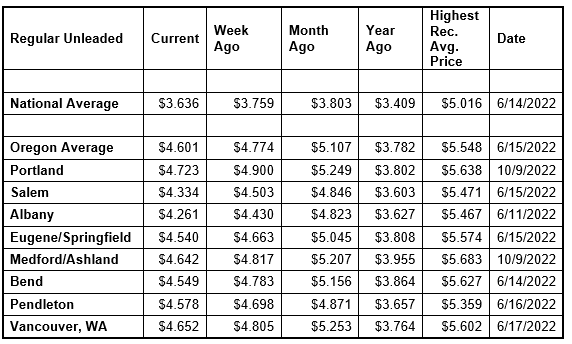
AAA projects 54.6 million Americans (16.4% of the population) will travel 50 miles or more from home for the Thanksgiving holiday, up 1.5% from 2021. This year is expected to be the third-busiest for Thanksgiving travel since AAA started tracking in 2000, only behind 2005 and 2019. About 777,000 Oregonians will head over the river and through the woods for turkey and all the trimmings. Find details and tips for travelers in the AAA Thanksgiving news release.
“Gas prices have never been more expensive for Thanksgiving with the national and Oregon averages at their highest prices ever for the holiday. Those who hit the road for Thanksgiving will find gas prices that are as much as 90 cents a gallon more expensive than last year,” says Marie Dodds, public affairs director for AAA Oregon/Idaho. “Still, we can be thankful that pump prices are moving in the right direction for now.
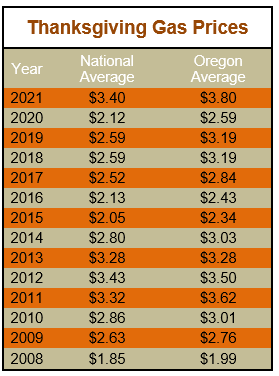
Crude oil prices are at their lowest prices in 10 months and that’s helping to put downward pressure on pump prices. Crude prices remained in a fairly tight range between about $85 and $93 per barrel for several weeks until this week when prices fell to $80 as markets focused on a potential slowdown for global economies, driven by the seemingly increasing COVID-19 outbreak in China.
Crude oil prices climbed above $90 briefly earlier this month. Crude reached a recent high of $122.11 per barrel on June 8, and ranged from about $94 to $110 per barrel in July. In August, crude prices ranged between about $86 and $97. In September, crude prices ranged between about $76 and $88 per barrel. In October, crude ranged between $82 and $92 per barrel.
Crude prices rose dramatically leading up to and in the first few months of Russia’s invasion of Ukraine. Russia is one of the world’s top oil producers and its involvement in a war causes market volatility, and sanctions imposed on Russia by the U.S. and other western nations resulted in tighter global oil supplies. Oil supplies were already tight around the world as demand for oil increased as pandemic restrictions eased. A year ago, crude was around $77 per barrel compared to $81 today.
Crude oil is the main ingredient in gasoline and diesel, so pump prices are impacted by crude prices on the global markets. On average, about 56% of what we pay for in a gallon of gasoline is for the price of crude oil, 20% is refining, 11% distribution and marketing, and 14% are taxes, according to the U.S. Energy Information Administration.
Demand for gasoline in the U.S. fell from 9.01 million to 8.74 million b/d for the week ending November 11.
This compares to 9.24 million b/d at this time last year. rose by nearly 2.2 million bbl to 207.9 million bbl. Increasing supply and falling demand have helped to push pump prices lower. As demand remains low and stocks grow, drivers will likely see pump prices dip through the Thanksgiving holiday.
Quick stats
Pump prices are lower this week in all 50 states and the District of Columbia. Wisconsin (-24 cents) has the largest weekly drop. Hawaii (-1 cent) has the smallest weekly decline.
California ($5.12) has the most expensive gas in the country for the 11th week in a row. California and Hawaii ($5.20) are the only two states with averages at or above $5 a gallon. This week nine states, including Oregon, have averages at or above $4, and 41 states and the District of Columbia have averages in the $3-range.
The cheapest gas in the nation is in Texas ($2.98) and Georgia ($3.09). For the 98th week in a row, no state has an average below $2 a gallon.
The difference between the most expensive and least expensive states is $2.23 which continues to be stark.
Oregon is one of 39 states and the District of Columbia with lower prices now than a month ago. The national average is 17 cents less and the Oregon average is 51 cents less than a month ago. Oregon has the third-largest monthly decrease in the nation. California (-58 cents) and Alaska (-55 cents) have the largest monthly declines. Maine (+22 cents) has the largest month-over-month increase.
Oregon is one of 47 states and the District of Columbia with higher prices now than a year ago. The national average is 23 cents more and the Oregon average is 82 cents more than a year ago. This is the fourth-largest year-over-year increase in the nation. Alaska (+87 cents) and Hawaii (+86 cents) have the largest yearly gains. Georgia (-14 cents) has the biggest year-over-year decline.
West Coast
The West Coast region continues to have the most expensive pump prices in the nation with all seven states in the top 10. This is typical for the West Coast as this region tends to consistently have fairly tight supplies, consuming about as much gasoline as is produced. In addition, this region is located relatively far from parts of the country where oil drilling, production and refining occurs, so transportation costs are higher. And environmental programs in this region add to the cost of production, storage and distribution.
Refinery issues in California in September and October exacerbated the situation, creating extremely tight supplies and causing pump prices in this region to skyrocket.
| Rank | Region | Price on 11/22/22 | ||
| 1 | California | $5.21 | ||
| 2 | Hawaii | $5.20 | ||
| 3 | Nevada | $4.83 | ||
| 4 | Washington | $4.64 | ||
| 5 | Oregon | $4.60 | ||
| 6 | Alaska | $4.60 | ||
| 7 | Idaho | $4.18 | ||
| 8 | Arizona | $4.17 | ||
| 9 | Pennsylvania | $4.01 | ||
| 10 | Utah | $3.97 |
As mentioned above, California is the most expensive state for the 11th consecutive week with Hawaii, Nevada, Washington, Oregon, and Alaska rounding out the top six. Arizona is eighth. Oregon is fifth most expensive for the second week in a row.
All of the West Coast states are seeing weekly drops. California (-22 cents) has the largest in the region. Hawaii (-1 cent) has the smallest.
The refinery utilization rate on the West Coast rose from 90.1% to 92.7% for the week ending November 11. This is the highest rate in the last year.
According to EIA’s latest weekly report, total gas stocks in the region increased from 27.19 million bbl. to 27.99 million bbl.
Oil market dynamics
Although crude prices jumped at the end of the week due to a weakening dollar, prices dropped earlier in the week after the EIA reported that total domestic commercial crude stocks increased dramatically by 4 million bbl. The inventory rise could mean that demand is falling due to growing economic concerns in the market. For this week, market concerns that economic growth will stall or reverses course, leading to lower crude demand, could push prices lower.
At the close of Friday’s formal trading session, WTI decreased by $1.56 to settle at $80.08. At the close of Monday’s formal trading session, WTI lost 35 cents to close at $79.73, the first time WTI closed below $80 a barrel since Sept. 30. Today crude is trading around $82, compared to $87 a week ago. Crude prices are about $4 more than a year ago.
Drivers can find current gas prices along their route with the free AAA Mobile app for iPhone, iPad and Android. The app can also be used to map a route, find discounts, book a hotel and access AAA roadside assistance. Learn more at AAA.com/mobile.
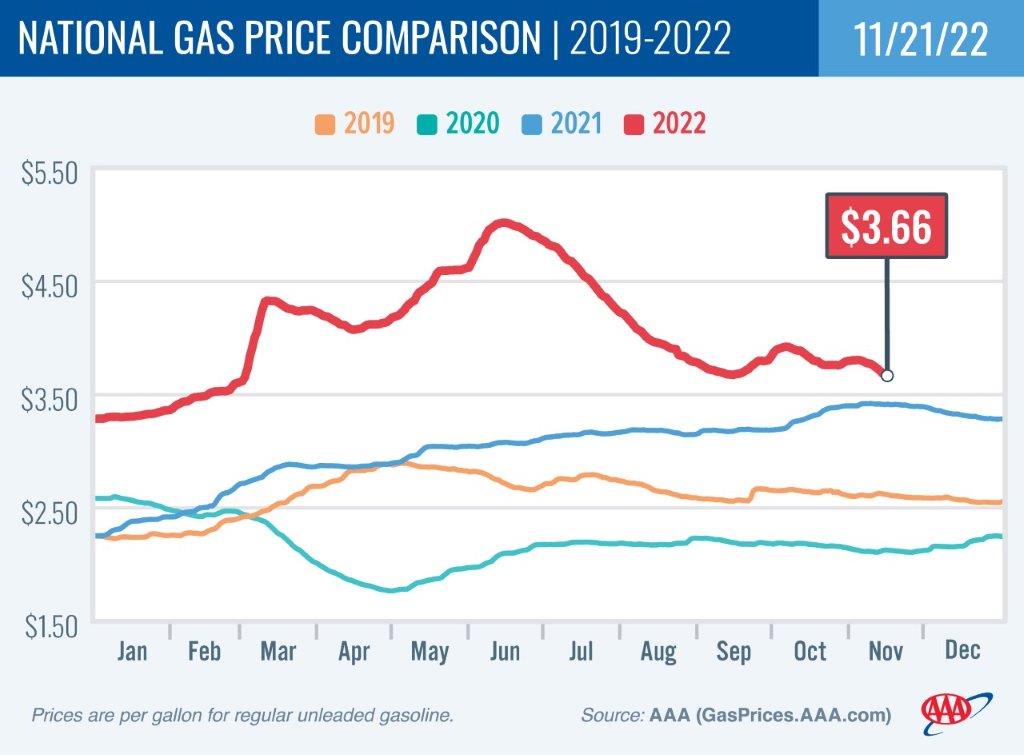
Diesel
For the week, the national average loses seven cents to $5.29 a gallon. The record high is $5.816 set on June 19. The Oregon average falls a nickel to $5.51. The record high is $6.47 set on July 3. A year ago the national average for diesel was $3.64 and the Oregon average was $3.80.
Diesel supplies are tight in parts of the U.S., especially in parts of the eastern U.S. However, recent reports that the U.S. has less than a month worth of diesel aren’t accurate. While the U.S. Energy Information Administration shows the U.S. has 26.6 days’ worth of supply of diesel for the week ending November 11, this number actually measures supply IF no more diesel would be produced in the U.S. or imported from other countries. Supplies of diesel have slowly been rising, up from 25.4 days of diesel supply for the week ending Oct. 14. In 2019, diesel supplies were also very tight with the EIA reporting a low of 26.5 days.
Diesel supplies have been impacted by the same factors that have caused supply and demand issues in other industries including the pandemic and the Russian invasion of Ukraine. Tight supplies could result in climbing prices for diesel, but there have not been significant increases yet.
Find current fuel prices at GasPrices.AAA.com.
AAA news releases, high resolution images, broadcast-quality video, fact sheets and podcasts are available on the AAA NewsRoom at NewsRoom.AAA.com.
Find local news releases at https://oregon.aaa.com/community/media/media-contacts.html
Fuel prices are updated daily at AAA’s Daily Fuel Gauge at AAA Gas Prices. For more info go www.AAA.com. AAA Oregon/Idaho provides more than 875,000 members with travel, insurance, financial and automotive-related services, and is an affiliate of AAA National, serving more than 63 million motorists in North America.
Updated 11/15/2022
Pump Prices Continue to Slide as Thanksgiving Approaches
PORTLAND, Ore., – Most states including Oregon are seeing prices at the pumps decline as travelers get ready for Thanksgiving travel next week. U.S. demand for gas has increased but fluctuating crude oil prices have helped keep pump prices in check. For the week, the national average for regular dips four cents to $3.76 a gallon. The Oregon average drops six cents to $4.77. This is the 10th-largest weekly drop for a state in the nation.

AAA projects 54.6 million Americans (16.4% of the population) will travel 50 miles or more from home for the Thanksgiving holiday, up 1.5% from 2021. This year is expected to be the third-busiest for Thanksgiving travel since AAA started tracking in 2000, only behind 2005 and 2019. About 777,000 Oregonians will head over the river and through the woods for turkey and all the trimmings. Find details and tips for travelers in the AAA Thanksgiving news release.
“Crude oil prices have remained in a fairly tight range between about $85 and $93 per barrel for several weeks. The national average has barely budged, but pump prices here on the West Coast have fallen 77 cents since October 9,” says,” says Marie Dodds, public affairs director for AAA Oregon/Idaho. Gas prices soared on the West Coast starting in late September when several refineries underwent planned and unplanned maintenance, putting a severe crimp in supplies.
Crude oil prices rose above $90 briefly earlier this month but fell back into the mid-$80 range on news of an increase in coronavirus cases in China. Monday, the Organization of the Petroleum Exporting Countries (OPEC) slightly lowered its forecast for global oil demand in its monthly report. These factors have created head winds for crude oil prices. Crude reached a recent high of $122.11 per barrel on June 8, and ranged from about $94 to $110 per barrel in July. In August, crude prices ranged between about $86 and $97. In September, crude prices ranged between about $76 and $88 per barrel. In October, crude ranged between $82 and $92 per barrel.
Crude prices rose dramatically leading up to and in the first few months of Russia’s invasion of Ukraine. Russia is one of the world’s top oil producers and its involvement in a war causes market volatility, and sanctions imposed on Russia by the U.S. and other western nations resulted in tighter global oil supplies. Oil supplies were already tight around the world as demand for oil increased as pandemic restrictions eased. A year ago, crude was around $81 per barrel compared to $87 today.
Crude oil is the main ingredient in gasoline and diesel, so pump prices are impacted by crude prices on the global markets. On average, about 56% of what we pay for in a gallon of gasoline is for the price of crude oil, 20% is refining, 11% distribution and marketing, and 14% are taxes, according to the U.S. Energy Information Administration.
Demand for gasoline in the U.S. rose from 8.66 million b/d to 9.01 million b/d for the week ending November 4. This compares to 9.26 million b/d at this time last year. Total domestic gasoline stocks decreased by nearly 1 million bbl to 205.7 million bbl. Tight supply and robust gasoline demand would typically push pump prices higher, but fluctuating oil prices have limited cost increases.
Quick stats
Oregon is one of 39 states and the District of Columbia with lower prices week-over-week. Wisconsin (-24 cents) has the largest weekly decline. Nebraska (+4 cents) has the largest weekly gain. The averages in Kansas and Maine are flat.
California ($5.42) has the most expensive gas in the country for the 10th week in a row. California and Hawaii ($5.21) are the only two states with averages at or above $5 a gallon. This week 12 states, including Oregon, have averages at or above $4, and 38 states and the District of Columbia have averages in the $3-range.
The cheapest gas in the nation is in Texas ($3.10) and Georgia ($3.16). For the 97th week in a row, no state has an average below $2 a gallon.
The difference between the most expensive and least expensive states is $2.32 which continues to be stark.
Oregon is one of 38 states and the District of Columbia with lower prices now than a month ago. The national average is 13 cents less and the Oregon average is 60 cents less than a month ago. Oregon has the third-largest monthly decrease in the nation. Alaska (-73 cents) and California (-68 cents) have the largest monthly declines. Maine (+29 cents) has the largest month-over-month increase.
Oregon is one of 48 states and the District of Columbia with higher prices now than a year ago. The national average is 34 cents more and the Oregon average is 99 cents more than a year ago. This is the third-largest year-over-year increase in the nation. Nevada (+$1.02) and Alaska (+$1.00) have the largest yearly gains. Georgia (-9 cents) and Colorado (-3 cents) are the only states with year-over-year declines.
West Coast
The West Coast region continues to have the most expensive pump prices in the nation with all seven states in the top 10. This is typical for the West Coast as this region tends to consistently have fairly tight supplies, consuming about as much gasoline as is produced. In addition, this region is located relatively far from parts of the country where oil drilling, production and refining occurs, so transportation costs are higher. And environmental programs in this region add to the cost of production, storage and distribution.
Refinery issues in California in September and October exacerbated the situation, creating extremely tight supplies and causing pump prices in this region to skyrocket.
| Rank | Region | Price on 11/15/22 | ||
| 1 | California | $5.42 | ||
| 2 | Hawaii | $5.21 | ||
| 3 | Nevada | $4.99 | ||
| 4 | Washington | $4.80 | ||
| 5 | Oregon | $4.77 | ||
| 6 | Alaska | $4.72 | ||
| 7 | Arizona | $4.25 | ||
| 8 | Idaho | $4.25 | ||
| 9 | Illinois | $4.14 | ||
| 10 | Pennsylvania | $4.08 |
As mentioned above, California is the most expensive state for the 10th consecutive week with Hawaii, Nevada, Washington, Oregon, Alaska, and Arizona rounding out the top seven. Oregon slips to fifth after two weeks at fourth.
Five of the West Coast states are seeing weekly drops. Oregon (-6 cents) has the largest in the region, followed by California (-3 cents), Alaska (-3 cents), Washington (-2 cents), and Arizona (-1 cent). Nevada (+3 cents) and Hawaii (+1/10th of a cent) have week-over-week increases.
The refinery utilization rate on the West Coast rose from 84.7% to 90.1% for the week ending November 4. The rate has ranged between about 76% and 90% in the last year.
According to EIA’s latest weekly report, total gas stocks in the region increased from 26.20 million bbl.to 27.19 million bbl.
Oil market dynamics
Although crude prices jumped at the end of last week due to a weakening dollar, prices dropped earlier in the week after the EIA reported that total domestic commercial crude stocks increased dramatically by 4 million bbl. The inventory rise could mean that demand is falling due to growing economic concerns in the market. For this week, market concerns that economic growth will stall or reverses course, leading to lower crude demand, could push prices lower.
At the close of Friday’s formal trading session, WTI increased by $2.49 to settle at $88.96. At the close of Monday’s formal trading session, WTI lost 82 ce$3.09 to close at $85.87. Today crude is trading around $87, compared to $89 a week ago. Crude prices are about $5 more than a year ago.
Drivers can find current gas prices along their route with the free AAA Mobile app for iPhone, iPad and Android. The app can also be used to map a route, find discounts, book a hotel and access AAA roadside assistance. Learn more at AAA.com/mobile.
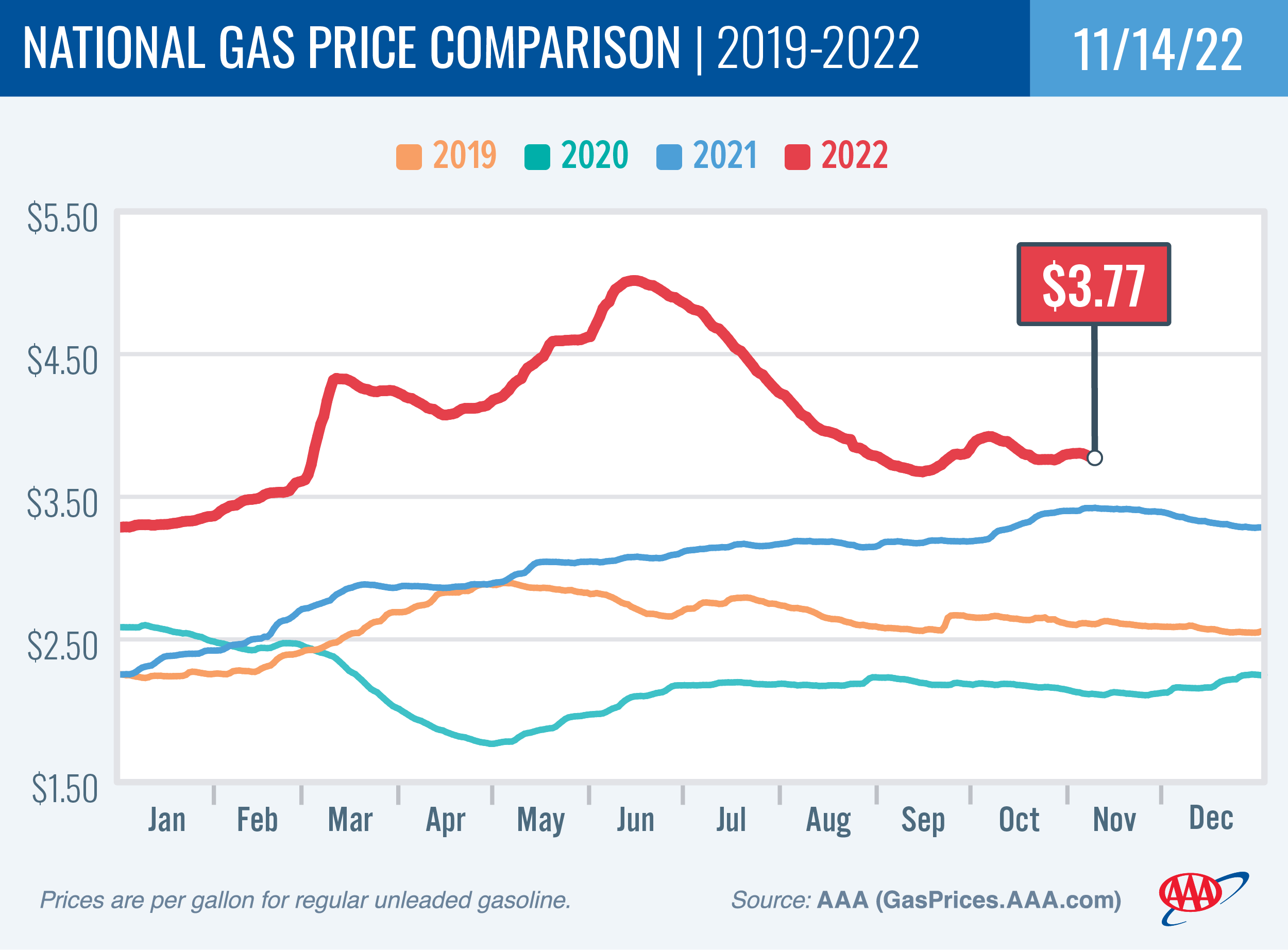
Diesel
For the week, the national average adds a penny to $5.36 a gallon. The record high is $5.816 set on June 19. Oregon’s average is flat at $5.56. The record high is $6.47 set on July 3. A year ago the national average for diesel was $3.65 and the Oregon average was $3.78.
Diesel supplies are tight in parts of the U.S., especially in parts of the eastern U.S. However, recent reports that the U.S. has less than a month worth of diesel aren’t accurate. While the U.S. Energy Information Administration shows the U.S. has 26 days’ worth of supply of diesel for the week ending November 4, this number actually measures supply IF no more diesel would be produced in the U.S. or imported from other countries. Supplies of diesel have slowly been rising, up from 25.4 days of diesel supply for the week ending Oct. 14. In 2019, diesel supplies were also very tight with the EIA reporting a low of 26.5 days.
Diesel supplies have been impacted by the same factors that have caused supply and demand issues in other industries including the pandemic and the Russian invasion of Ukraine. Tight supplies could result in climbing prices for diesel, but there have not been significant increases yet.
Find current fuel prices at GasPrices.AAA.com.
AAA news releases, high resolution images, broadcast-quality video, fact sheets and podcasts are available on the AAA NewsRoom at NewsRoom.AAA.com.
Find local news releases at https://oregon.aaa.com/community/media/media-contacts.html
Fuel prices are updated daily at AAA’s Daily Fuel Gauge at AAA Gas Prices. For more info go www.AAA.com. AAA Oregon/Idaho provides more than 875,000 members with travel, insurance, financial and automotive-related services, and is an affiliate of AAA National, serving more than 63 million motorists in North America.
Updated 11/8/2022
National Average Ticks Up while Oregon has Largest Weekly Drop in the Nation
PORTLAND, Ore., – Rising oil prices fueled by worries over Russian oil production cuts have put upward pressure on pump prices, sending the national average higher. But Oregon and other West Coast states are bucking the trend, with gas prices continuing to decline. For the week, the national average for regular adds a nickel to $3.80 a gallon. The Oregon average falls 11 cents to $4.83. This is the largest weekly drop for a state in the nation.

“Oil prices have risen, in part due to concerns of tight global supplies as the European Union’s embargo on Russia’s seaborne crude exports will start in early December. Higher crude oil prices generally result in higher pump prices. However, reports of new COVID-19 restrictions in China signal a potential economic slowdown for the world’s top oil-consuming nation, so higher oil prices could be short-lived,” says Marie Dodds, public affairs director for AAA Oregon/Idaho.
Crude oil prices rose above $90 last week for the first time since October 7. Crude reached a recent high of $122.11 per barrel on June 8, and ranged from about $94 to $110 per barrel in July. In August, crude prices ranged between about $86 and $97. In September, crude prices ranged between about $76 and $88 per barrel. In October, crude ranged between $82 and $92 per barrel.
Crude prices rose dramatically leading up to and in the first few months of Russia’s invasion of Ukraine. Russia is one of the world’s top oil producers and its involvement in a war causes market volatility, and sanctions imposed on Russia by the U.S. and other western nations resulted in tighter global oil supplies. Oil supplies were already tight around the world as demand for oil increased as pandemic restrictions eased. A year ago, crude was around $72 per barrel compared to $89 today.
Crude oil is the main ingredient in gasoline and diesel, so pump prices are impacted by crude prices on the global markets. On average, about 56% of what we pay for in a gallon of gasoline is for the price of crude oil, 20% is refining, 11% distribution and marketing, and 14% are taxes, according to the U.S. Energy Information Administration.
Demand for gasoline in the U.S. dipped slightly from 8.93 million b/d to 8.66 million b/d for the week ending October 28. This compares to 9.50 million b/d at this time last year. Total domestic gasoline stocks decreased by 1.3 million bbl to 206.6 million bbl. Pump prices could increase if supply remains tight alongside rising oil prices.
Quick stats
Oregon is one of 22 states with lower prices week-over-week. West Coast states have the largest weekly drops: Oregon (-11 cents), Alaska (-9 cents), California (-9 cents), and Washington (-9 cents). Indiana (+33 cents) has the largest weekly gain. The average in Texas is flat.
California ($5.45) has the most expensive gas in the country for the ninth week in a row. California and Hawaii ($5.21) are the only two states with averages at or above $5 a gallon. This week 13 states, including Oregon, have averages at or above $4, and 37 states and the District of Columbia have averages in the $3-range.
The cheapest gas in the nation is in Georgia ($3.13) and Texas ($3.17). For the 96th week in a row, no state has an average below $2 a gallon.
The difference between the most expensive and least expensive states is $2.33 which continues to be significant.
Oregon is one of 36 states with lower prices now than a month ago. The national average is 10 cents more and the Oregon average is 71 cents less than a month ago. Oregon has the third-largest monthly decrease in the nation. California (-90 cents) and Alaska (-79 cents) have the largest monthly declines. Rhode Island (+41 cents) has the largest month-over-month jump.
Oregon is one of 49 states and the District of Columbia with higher prices now than a year ago. The national average is 38 cents more and the Oregon average is $1.06 more than a year ago. This is the largest year-over-year increase in the nation, followed by Alaska (+$1.03), Nevada (+$1.01), Washington (+95 cents), Hawaii (+87 cents), and California (+83 cents). Colorado (+1/10th of a cent) has the smallest year-over-year increase. Georgia (-12 cents) is the only state with a year-over-year decrease.
West Coast
The West Coast region continues to have the most expensive pump prices in the nation with all seven states in the top 10. This is typical for the West Coast as this region tends to consistently have fairly tight supplies, consuming about as much gasoline as is produced. In addition, this region is located relatively far from parts of the country where oil drilling, production and refining occurs, so transportation costs are higher. And environmental programs in this region add to the cost of production, storage and distribution.
Refinery issues in California in September and October exacerbated the situation, creating extremely tight supplies and causing pump prices in this region to skyrocket.
| Rank | Region | Price on 11/8/22 | ||
| 1 | California | $5.45 | ||
| 2 | Hawaii | $5.21 | ||
| 3 | Nevada | $4.96 | ||
| 4 | Oregon | $4.83 | ||
| 5 | Washington | $4.82 | ||
| 6 | Alaska | $4.74 | ||
| 7 | Illinois | $4.29 | ||
| 8 | Idaho | $4.29 | ||
| 9 | Arizona | $4.26 | ||
| 10 | Michigan | $4.19 |
As mentioned above, California is the most expensive state for the ninth consecutive week with Hawaii, Nevada, Oregon, Washington, and Alaska rounding out the top six. Arizona is ninth. Oregon is fourth for the second week in a row.
Several West Coast states have the largest weekly drops in the nation: Oregon (-11 cents), Alaska (-9 cents), California (-9 cents), and Washington (-9 cents). Arizona (-3 cents), Nevada (-1 cent) and Hawaii (-3/10th of a cent) are also seeing week-over-week declines.
The refinery utilization rate on the West Coast rose from 81.1% to 84.7% for the week ending October 28. The rate has ranged between about 76% and 90% in the last year.
According to EIA’s latest weekly report, total gas stocks in the region ticked up from 26.16 million bbl. to 26.20 million bbl.
Oil market dynamics
Crude prices spiked at the end of last week after the dollar dropped in value. Commodities such as crude oil are priced in U.S. dollars. A weaker dollar can increase demand for oil by making it more attractive to investors using other currencies. Moreover, the price of oil rose after the EIA reported that total domestic crude stocks had declined by 3.1 million bbl. However, for this week, crude oil prices could face headwinds if market concerns regarding the likelihood of a recession persist. If economic growth stalls or reverses course, crude demand is likely to follow suit alongside prices.
At the close of Friday’s formal trading session, WTI increased by $4.44 to settle at $92.61. At the close of Monday’s formal trading session, WTI lost 82 cents to close at $91.79. Today crude is trading around $91, compared to $88 a week ago. Crude prices are about $10 more than a year ago.
Drivers can find current gas prices along their route with the free AAA Mobile app for iPhone, iPad and Android. The app can also be used to map a route, find discounts, book a hotel and access AAA roadside assistance. Learn more at AAA.com/mobile.
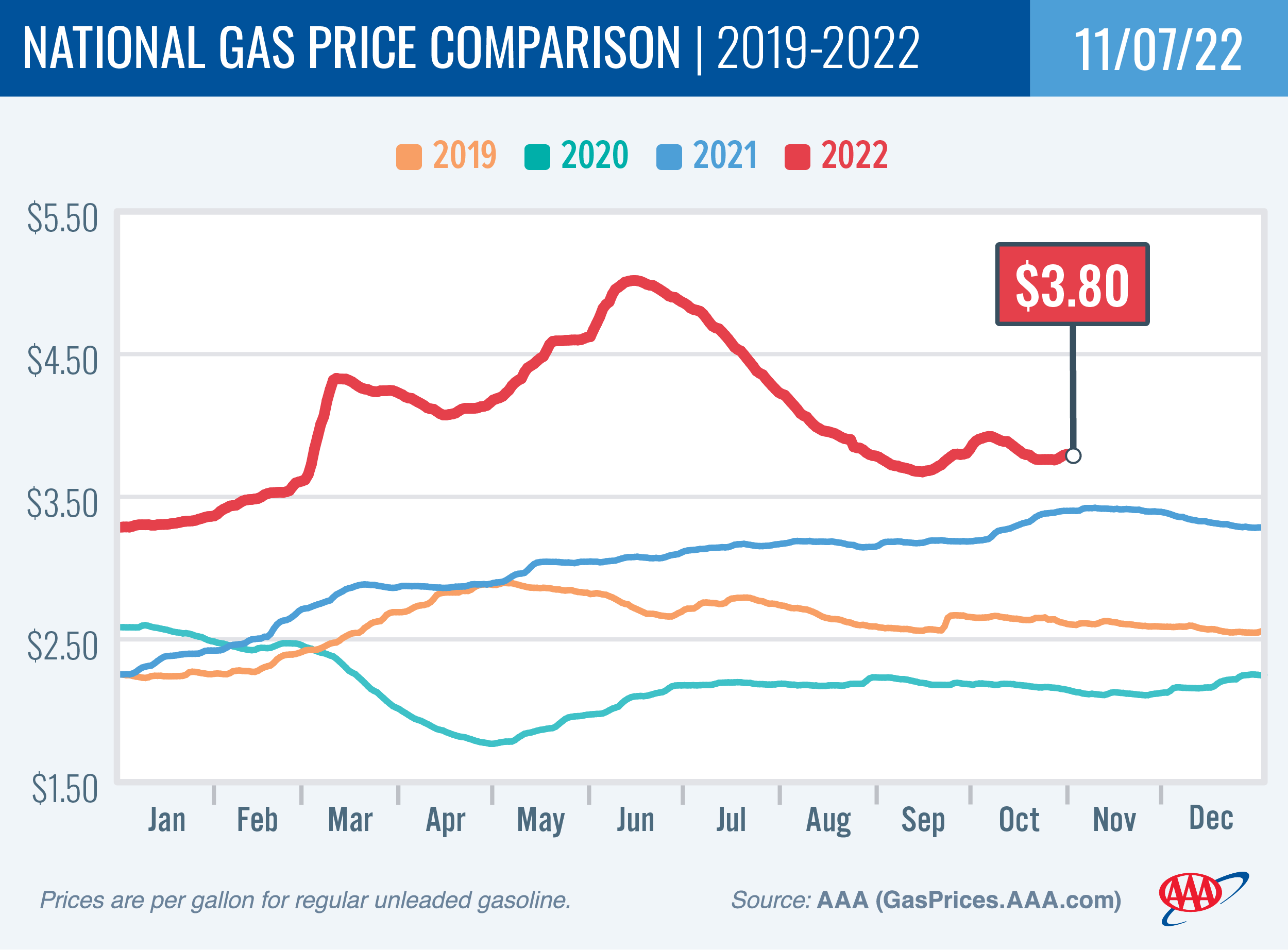
Diesel
For the week, the national average climbs four cents to $5.35 a gallon. The record high is $5.816 set on June 19. Oregon’s average loses a nickel to $5.56. The record high is $6.47 set on July 3. A year ago the national average for diesel was $3.64 and the Oregon average was $3.78.
Diesel supplies are tight in parts of the U.S., especially in parts of the eastern U.S. However, recent reports that the U.S. has less than a month worth of diesel aren’t accurate. While the U.S. Energy Information Administration shows the U.S. has 25.8 days’ worth of supply of diesel for the week ending Oct. 28, this number actually measures supply IF no more diesel would be produced in the U.S. or imported from other countries. Supplies of diesel have slowly been rising, up from 25.4 days of diesel supply for the week ending Oct. 14. In 2019, diesel supplies were also very tight with the EIA reporting a low of 26.5 days.
Diesel supplies have been impacted by the same factors that have caused supply and demand issues in other industries including the pandemic and the Russian invasion of Ukraine. Tight supplies could result in climbing prices for diesel, although here in Oregon the average diesel price has fallen five cents week-over-week for the second week in a row.
Find current fuel prices at GasPrices.AAA.com.
AAA news releases, high resolution images, broadcast-quality video, fact sheets and podcasts are available on the AAA NewsRoom at NewsRoom.AAA.com.
Find local news releases at https://oregon.aaa.com/community/media/media-contacts.html
Fuel prices are updated daily at AAA’s Daily Fuel Gauge at AAA Gas Prices. For more info go www.AAA.com. AAA Oregon/Idaho provides more than 875,000 members with travel, insurance, financial and automotive-related services, and is an affiliate of AAA National, serving more than 63 million motorists in North America.
Updated 11/1/2022
Gas Prices Drift Lower
Oregon has third-largest weekly drop
PORTLAND, Ore., – Gas prices continue to fall as expected this time of year with Oregon and other West Coast states again seeing the largest declines in the nation. Tepid demand for gas and crude oil prices below $90 per barrel are the main drivers. For the week, the national average for regular slips two cents to $3.76 a gallon. The Oregon average loses 11 cents to $4.95. This is the third-largest weekly drop for a state in the nation, only behind Alaska (-21 cents) and California (-17 cents).
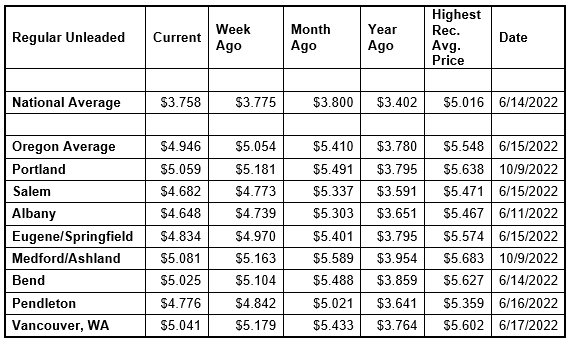
“Gas prices have been falling for the last three weeks. Here on the West Coast, pump prices shot up in late September after several regional refineries underwent planned and unplanned maintenance, putting a significant crimp in supplies,” says Marie Dodds, public affairs director for AAA Oregon/Idaho. “Barring unforeseen events, lackluster demand for gas in the U.S. along with relatively low crude oil prices should continue to put downward pressure on pump prices.”
The Oregon average came within a penny of reaching a new record high last month when it got to $5.54 a gallon on October 9. The national average climbed to $3.92 on October 11. Both the national and Oregon averages hit record highs in mid-June, then declined for 14 consecutive weeks before rising again starting in late September. The national average reached its record high of $5.016 on June 14 while the Oregon average reached its record high of $5.548 on June 15.
Crude oil prices have stayed below $90 per barrel since October 10. Crude reached a recent high of $122.11 per barrel on June 8, and ranged from about $94 to $110 per barrel in July. In August, crude prices ranged between about $86 and $97. In September, crude prices ranged between about $76 and $88 per barrel. In October, crude ranged between $82 and $92 per barrel.
Crude prices rose dramatically leading up to and in the first few months of Russia’s invasion of Ukraine. Russia is one of the world’s top oil producers and its involvement in a war causes market volatility, and sanctions imposed on Russia by the U.S. and other western nations resulted in tighter global oil supplies. Oil supplies were already tight around the world as demand for oil increased as pandemic restrictions eased. A year ago, crude was around $72 per barrel compared to $88 today.
Crude oil is the main ingredient in gasoline and diesel, so pump prices are impacted by crude prices on the global markets. On average, about 53% of what we pay for in a gallon of gasoline is for the price of crude oil, 12% is refining, 21% distribution and marketing, and 15% are taxes, according to the U.S. Energy Information Administration.
Demand for gasoline in the U.S. increased slightly from 8.68 million b/d to 8.93 million b/d for the week ending October 21. This is nearly 400,000 bbl lower than this time last year. Total domestic gasoline stocks decreased from 209.4 million bbl to 207.9 million bbl. If demand remains low and oil prices don’t spike, pump prices will likely keep falling.
Quick stats
Oregon is one of 34 states and the District of Columbia with lower prices week-over-week. West Coast states have the largest weekly drops: Alaska (-21 cents), California (-17 cents), Oregon (-11), and Washington (-9 cents). Rhode Island (+27 cents) has the largest weekly gain.
California ($5.54) has the most expensive gas in the country for the eighth week in a row. California and Hawaii ($5.21) are the only two states with averages at or above $5 a gallon. This week 11 states, including Oregon, have averages at or above $4, and 39 states and the District of Columbia have averages in the $3-range.
The cheapest gas in the nation is in Georgia ($3.15) and Texas ($3.17). For the 95th week in a row, no state has an average below $2 a gallon.
The difference between the most expensive and least expensive states is $2.39 which is significant.
Oregon is one of 27 states and the District of Columbia with lower prices now than a month ago. The national average is four cents less and the Oregon average is 46 cents less than a month ago. Oregon has the third-largest monthly decrease in the nation. California (-82 cents) and Nevada (-51 cents) have the largest monthly declines. Rhode Island (+46 cents) has the largest month-over-month jump.
Oregon is one of 48 states and the District of Columbia with higher prices now than a year ago. The national average is 36 cents more and the Oregon average is $1.17 more than a year ago. This is the largest year-over-year increase in the nation, followed by Alaska (+$1.12), Washington (+$1.03), Nevada (+$1.03), California (+94 cents), Hawaii (+90 cents) and Arizona (+77 cents)—all of the states in the West Coast region. Colorado (+2 cents) has the smallest year-over-year increase. Georgia (-10 cents) and Florida (-2 cents) are the only two states with year-over-year declines.
West Coast
The West Coast region continues to have the most expensive pump prices in the nation with all seven states in the top 10. This is typical for the West Coast as this region tends to consistently have fairly tight supplies, consuming about as much gasoline as is produced. In addition, this region is located relatively far from parts of the country where oil drilling, production and refining occurs, so transportation costs are higher. And environmental programs in this region add to the cost of production, storage and distribution.
Refinery issues in California in September and October exacerbated the situation, creating extremely tight supplies and causing pump prices in this region to skyrocket.
| Rank | Region | Price on 11/1/22 | ||
| 1 | California | $5.54 | ||
| 2 | Hawaii | $5.21 | ||
| 3 | Nevada | $4.97 | ||
| 4 | Oregon | $4.95 | ||
| 5 | Washington | $4.91 | ||
| 6 | Alaska | $4.84 | ||
| 7 | Idaho | $4.33 | ||
| 8 | Arizona | $4.29 | ||
| 9 | Illinois | $4.16 | ||
| 10 | Utah | $4.14 |
As mentioned above, California is the most expensive state for the eighth consecutive week with Hawaii, Nevada, Oregon, Washington, and Alaska rounding out the top six. Arizona is eighth. Oregon slips to fourth after five weeks at third.
Four of the seven states in the region are seeing the largest weekly declines in the country: Alaska (-21 cents), California (-17 cents), Oregon (-11), and Washington (-9 cents). Nevada (-7 cents) and Arizona (-6 cents) also have week-over-week declines. Hawaii (+1/2 cent) is the only state in the region with a weekly gain.
The refinery utilization rate on the West Coast fell from 82.3% to 81.1% for the week ending October 21. The rate has ranged between about 76% and 90% in the last year.
According to EIA’s latest weekly report, total gas stocks in the region rose from 25.89 million bbl. to 26.16 million bbl.
Oil market dynamics
A lower dollar contributed to price increases earlier last week; however, market concerns about global crude demand, after China announced more COVID lockdowns, sent prices lower at the end of the week. For this week, persistent market concerns that economic growth will stall or decline, alongside decreased crude oil demand, could put downward pressure on prices.
At the close of Friday’s formal trading session, WTI decreased by $1.18 to settle at $87.90. At the close of Monday’s formal trading session, WTI lost $1.37 cents to close at $86.53. Today crude is trading around $88, compared to $85 a week ago. Crude prices are about $3 more than a year ago.
Drivers can find current gas prices along their route with the free AAA Mobile app for iPhone, iPad and Android. The app can also be used to map a route, find discounts, book a hotel and access AAA roadside assistance. Learn more at AAA.com/mobile.
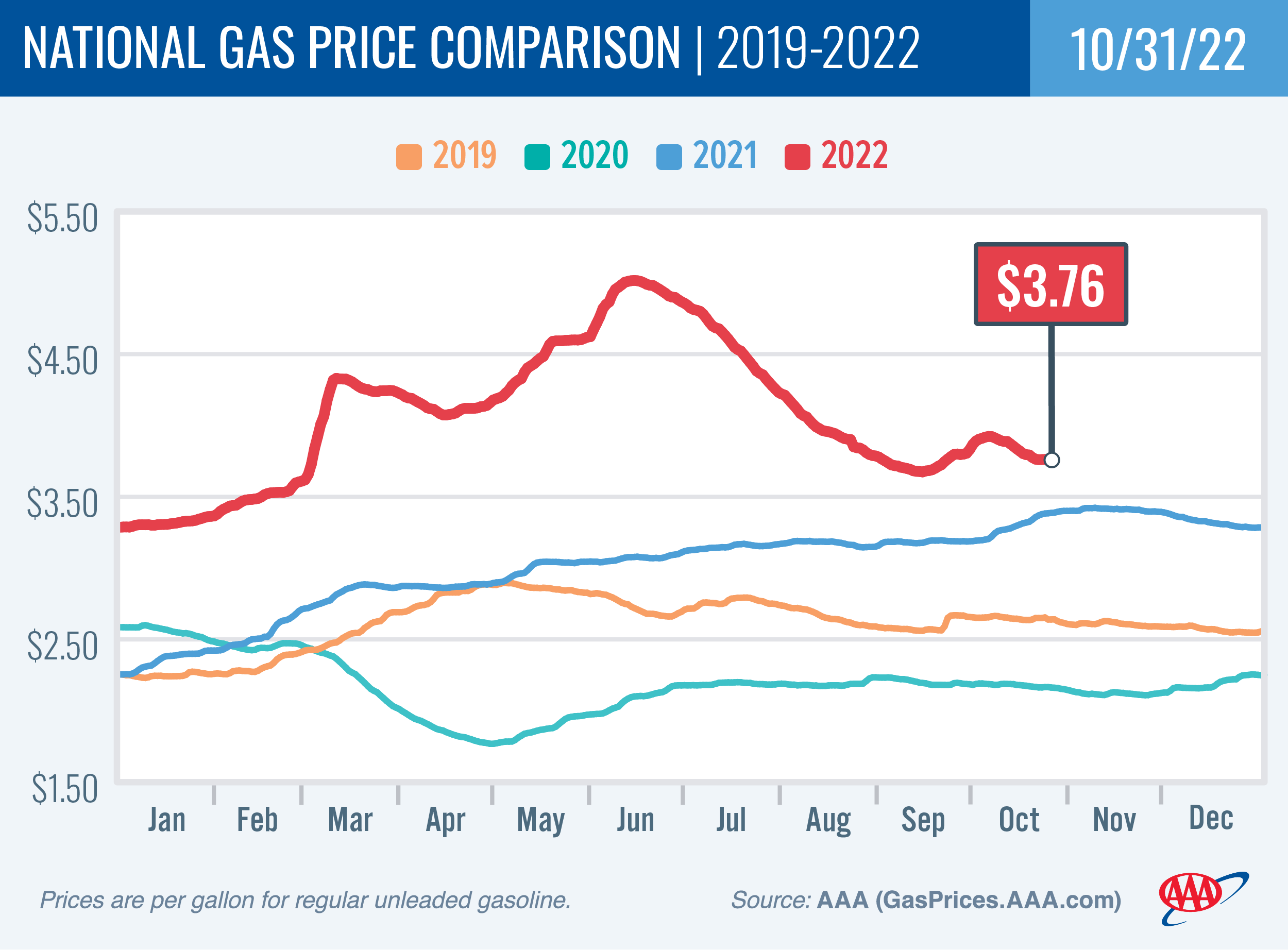
Diesel
For the week, the national average dips a penny to $5.31 a gallon. The record high is $5.816 set on June 19. Oregon’s average loses a nickel to $5.61. The record high is $6.47 set on July 3. A year ago the national average for diesel was $3.63 and the Oregon average was $3.77.
Diesel supplies are tight in parts of the U.S., especially in parts of the eastern U.S. However, reports that the U.S. has less than a month worth of diesel aren’t accurate. While the U.S. Energy Information Administration shows the U.S. has 25.9 days’ worth of supply of diesel, this number actually measures supply IF no more diesel would be produced in the U.S. or imported from other countries. Supplies of diesel have slowly been rising, up from 25.4 days of diesel supply for the week ending Oct. 14 to the current 25.9 days. In 2019, diesel supplies were also very tight with the EIA reporting a low of 26.5 days.
Diesel supplies have been impacted by the same factors that have caused supply and demand issues in other industries including the pandemic and the Russian invasion of Ukraine. Tight supplies could result in climbing prices for diesel, although here in Oregon the average diesel price has fallen five cents in the last week.
Find current fuel prices at GasPrices.AAA.com.
AAA news releases, high resolution images, broadcast-quality video, fact sheets and podcasts are available on the AAA NewsRoom at NewsRoom.AAA.com.
Find local news releases at https://oregon.aaa.com/community/media/media-contacts.html
Fuel prices are updated daily at AAA’s Daily Fuel Gauge at AAA Gas Prices. For more info go www.AAA.com. AAA Oregon/Idaho provides more than 875,000 members with travel, insurance, financial and automotive-related services, and is an affiliate of AAA National, serving more than 63 million motorists in North America.
Updated 10/25/2022
Fewer Tricks and More Treats for Oregon drivers as October Winds Down
Oregon and other West Coast states see largest weekly drops in pump prices
PORTLAND, Ore., – Pump prices have been falling every day for more than two weeks with Oregon and other West Coast states seeing the biggest weekly drops in the nation. Lower crude oil prices and fewer drivers than usual fueling up are helping to drive the decreases. For the week, the national average for regular drops 10 cents to $3.78 a gallon. The Oregon average tumbles 24 cents to $5.05. This is the third-largest weekly drop for a state in the nation, only behind Alaska (-36 cents) and California (-29 cents).
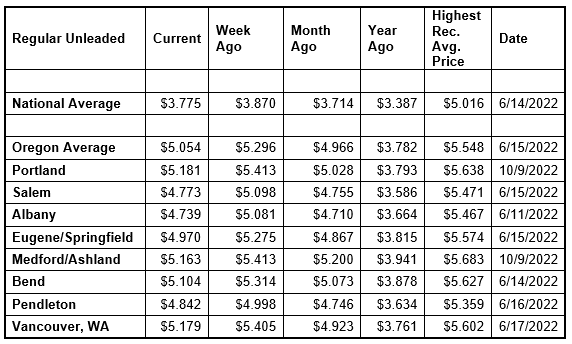
The Oregon average came within a penny of reaching a new record high this month when it got to $5.54 a gallon on October 9. It has decreased every day since then. The national average climbed to $3.92 on October 11 and has fallen every day since then. Refinery outages in the West Coast region and the resulting drop in supplies helped fuel the dramatic pump price increases in this area.
Both the national and Oregon averages hit record highs in mid-June, then declined for 14 consecutive weeks before rising again starting in late September. The national average reached its record high of $5.016 on June 14 while the Oregon average reached its record high of $5.548 on June 15.
“Crude oil prices have been tempered by fears of a global recession along with the Biden Administration’s plan to continue tapping the Strategic Petroleum Reserve into December. This should help take pressure off pump prices, bringing some relief to drivers and their wallets,” says Marie Dodds, public affairs director for AAA Oregon/Idaho.
Crude oil prices have stayed below $90 per barrel since October 10. Crude reached a recent high of $122.11 per barrel on June 8, and ranged from about $94 to $110 per barrel in July. In August, crude prices ranged between about $86 and $97. In September, crude prices ranged between about $76 and $88 per barrel. So far in October, crude has ranged between $82 and $92 per barrel.
Crude prices rose dramatically leading up to and in the first few months of Russia’s invasion of Ukraine. Russia is one of the world’s top oil producers and its involvement in a war causes market volatility, and sanctions imposed on Russia by the U.S. and other western nations resulted in tighter global oil supplies. Oil supplies were already tight around the world as demand for oil increased as pandemic restrictions eased. A year ago, crude was around $73 per barrel compared to $85 today.
Crude oil is the main ingredient in gasoline and diesel, so pump prices are impacted by crude prices on the global markets. On average, about 53% of what we pay for in a gallon of gasoline is for the price of crude oil, 12% is refining, 21% distribution and marketing, and 15% are taxes, according to the U.S. Energy Information Administration.
Demand for gasoline in the U.S. increased slightly from 8.28 million b/d to 8.68 million b/d for the week ending October 14. This is about 1 million b/d less than a year ago. Total domestic gasoline stocks decreased marginally from 209.5 million bbl to 209.4 million bbl. If demand remains low and oil prices don’t spike, pump prices will likely keep falling.
Quick stats
All 50 states and the District of Columbia have lower prices week-over-week. West Coast states have the largest weekly drops: Alaska (-36 cents), California (-29 cents), Oregon (-24), Washington (-23 cents) and Nevada (-19).
California ($5.71) has the most expensive gas in the country for the seventh week in a row, but the state average has dropped below $6 a gallon. Five states, including Oregon, have averages at or above $5 a gallon. This week 12 states have averages at or above $4, and 38 states and the District of Columbia have averages in the $3-range.
The cheapest gas in the nation is in Georgia ($3.19) and Texas ($3.20). For the 94th week in a row, no state has an average below $2 a gallon.
The difference between the most expensive and least expensive states is $2.52 which is stark.
Oregon is one of 32 states and the District of Columbia with higher prices now than a month ago. The national average is six cents more and the Oregon average is nine cents more than a month ago. Oregon has the 19th-largest monthly increase in the nation. Delaware (+27 cents) has the largest month-over-month jump. Colorado (-15 cents) has the largest monthly drop.
Oregon is one of 48 states and the District of Columbia with higher prices now than a year ago. The national average is 39 cents more and the Oregon average is $1.27 more than a year ago. This is the second-largest yearly increase in the nation. Alaska (+$1.32) has the biggest yearly increase. Florida (+3 cents) has the smallest year-over-year increase. Georgia (-5 cents) and Connecticut (-3 cents) are the only two states with year-over-year declines.
West Coast
The West Coast region continues to have the most expensive pump prices in the nation with all seven states in the top 10. This is typical for the West Coast as this region tends to consistently have fairly tight supplies, consuming about as much gasoline as is produced. In addition, this region is located relatively far from parts of the country where oil drilling, production and refining occurs, so transportation costs are higher. And environmental programs in this region add to the cost of production, storage and distribution.
Refinery issues in California in September and earlier this month exacerbated the situation, creating extremely tight supplies and causing pump prices in this region to skyrocket.
| Rank | Region | Price on 10/25/22 | ||
| 1 | California | $5.71 | ||
| 2 | Hawaii | $5.21 | ||
| 3 | Oregon | $5.05 | ||
| 4 | Alaska | $5.05 | ||
| 5 | Nevada | $5.04 | ||
| 6 | Washington | $4.99 | ||
| 7 | Idaho | $4.36 | ||
| 8 | Arizona | $4.35 | ||
| 9 | Illinois | $4.21 | ||
| 10 | Utah | $4.19 |
As mentioned above, California is the most expensive state for the seventh consecutive week with Hawaii, Oregon, Alaska, Nevada, and Washington rounding out the top six. Arizona is eighth. Oregon is third most expensive for the fifth consecutive week.
Five of the seven states in the region are seeing the largest weekly declines in the country: Alaska (-36 cents), California (-29 cents), Oregon (-24), Washington (-23 cents) and Nevada (-19). Arizona (-10 cents) has the 12th-largest weekly drop. Hawaii (-2 cents) as the 43rd-largest week-over-week decline.
The refinery utilization rate on the West Coast rose from 80.1% to 82.3% for the week ending October 14. The rate has ranged between about 76% and 90% in the last year.
According to EIA’s latest weekly report, total gas stocks in the region increased from 24.80 million bbl. to 25.89 million bbl.
Oil market dynamics
Although crude prices increased after the EIA reported that total domestic commercial crude inventories dropped by 1.7 million bbl to 437.4 million bbl last week, the price of oil had declined earlier in the week due to ongoing market concerns about crude demand as recession fears increased. If the market remains concerned about the rate of economic growth this week, crude prices could decline.
At the close of Friday’s formal trading session, WTI increased by 54 cents to settle at $85.05. At the close of Monday’s formal trading session, WTI slipped 47 cents to close at $84.58. Today crude is trading around $85, compared to $83 a week ago. Crude prices are about $1 more than a year ago.
Drivers can find current gas prices along their route with the free AAA Mobile app for iPhone, iPad and Android. The app can also be used to map a route, find discounts, book a hotel and access AAA roadside assistance. Learn more at AAA.com/mobile.
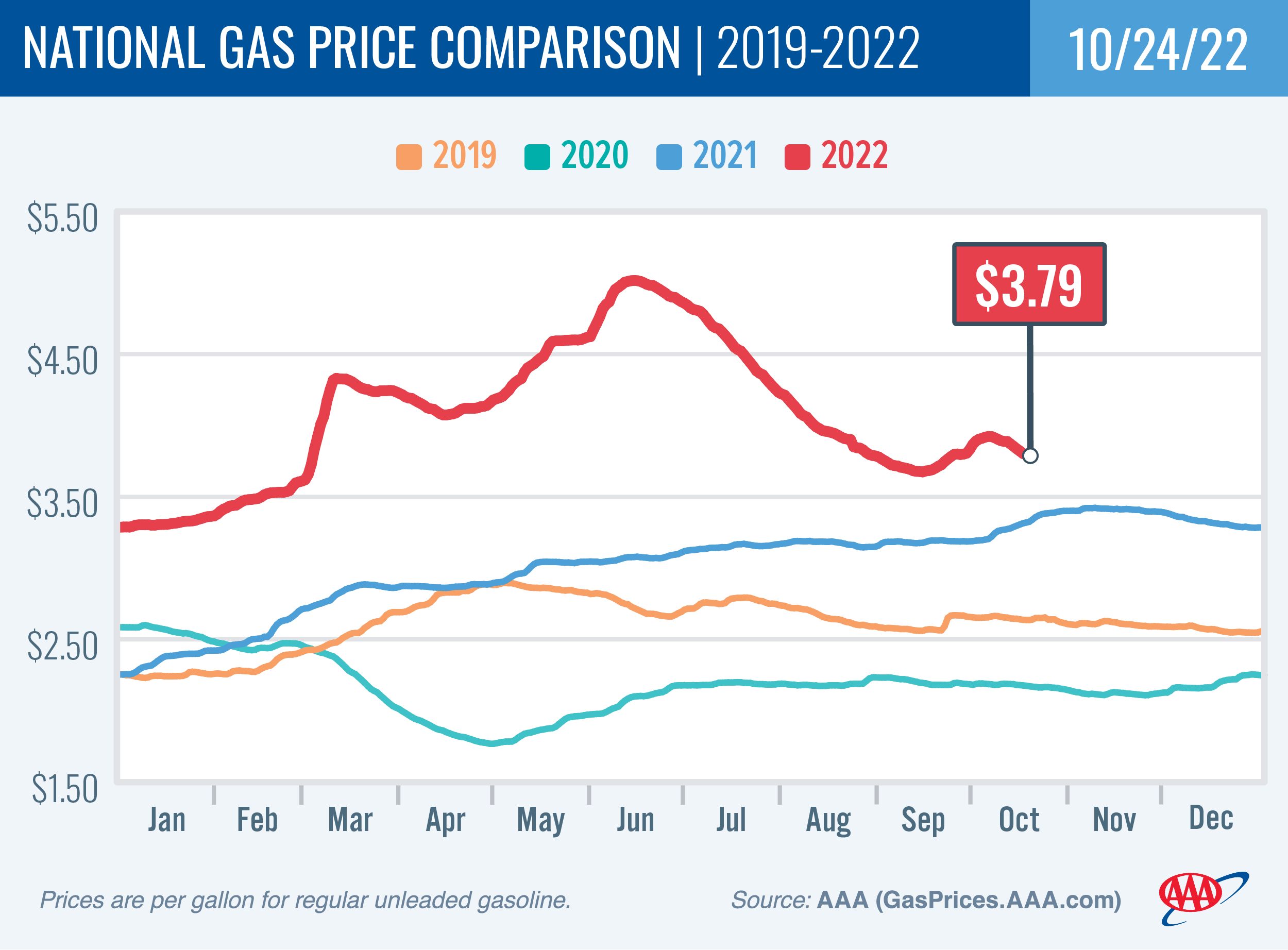
Diesel
For the week, the national average edges up 2 cents to $5.32 a gallon. The record high is $5.816 set on June 19. Oregon’s average falls six cents to $5.67. The record high is $6.47 set on July 3. A year ago the national average for diesel was $3.61 and the Oregon average was $3.77.
Find current fuel prices at GasPrices.AAA.com.
AAA news releases, high resolution images, broadcast-quality video, fact sheets and podcasts are available on the AAA NewsRoom at NewsRoom.AAA.com.
Find local news releases at https://oregon.aaa.com/community/media/media-contacts.html
Fuel prices are updated daily at AAA’s Daily Fuel Gauge at AAA Gas Prices. For more info go www.AAA.com. AAA Oregon/Idaho provides more than 875,000 members with travel, insurance, financial and automotive-related services, and is an affiliate of AAA National, serving more than 63 million motorists in North America.
Updated 10/18/2022
Oregon and other West Coast states see Big Drops at the Pumps
Oregon has second-largest weekly decline in the nation
PORTLAND, Ore., – Oregon and other West Coast states are seeing some of the biggest weekly decreases in the nation. Gasoline supplies in the area are returning to normal as regional refinery issues are resolved. In addition, falling crude oil prices and demand for gas in the U.S. are also helping to push pump prices lower. For the week, the national average for regular loses five cents to $3.87 a gallon. The Oregon average plummets 22 cents to $5.30. This is the second-largest weekly drop for a state in the nation.

The Oregon average came within a penny of reaching a new record high this month when it got to $5.54 a gallon. It has decreased 24 cents since then. Both the national and Oregon averages hit record highs in mid-June, then declined for 14 consecutive weeks before rising again for the last three weeks. The national average reached its record high of $5.016 on June 14 while the Oregon average reached its record high of $5.548 on June 15.
“Pump prices on the West Coast soared last month after several California refineries underwent planned or unplanned maintenance creating a huge drop in supplies in this region. The situation is getting back to normal and pump prices in this region should continue to decline, barring unforeseen events,” says Marie Dodds, public affairs director for AAA Oregon/Idaho.
Crude oil prices are again below $90 per barrel due to global economic concerns. Crude reached a recent high of $122.11 per barrel on June 8, and ranged from about $94 to $110 per barrel in July. In August, crude prices ranged between about $86 and $97. In September, crude prices ranged between about $76 and $88 per barrel. So far in October, crude has ranged between $82 and $92 per barrel.
Crude prices rose dramatically leading up to and in the first few months of Russia’s invasion of Ukraine. Russia is one of the world’s top oil producers and its involvement in a war causes market volatility, and sanctions imposed on Russia by the U.S. and other western nations resulted in tighter global oil supplies. Oil supplies were already tight around the world as demand for oil increased as pandemic restrictions eased. A year ago, crude was around $72 per barrel compared to $83 today.
Crude oil is the main ingredient in gasoline and diesel, so pump prices are impacted by crude prices on the global markets. On average, about 53% of what we pay for in a gallon of gasoline is for the price of crude oil, 12% is refining, 21% distribution and marketing, and 15% are taxes, according to the U.S. Energy Information Administration.
Demand for gasoline in the U.S. decreased from 9.47 million b/d to 8.28 million b/d for the week ending October 7. This is significantly less than a year ago at this time when demand was 9.2 million b/d. Total domestic gasoline stocks increased by 2 million bbl to 209.5 million bbl. Falling demand and increasing stocks should put downward pressure on pump prices, especially with decreasing crude oil prices.
Quick stats
Oregon is one of 32 states with lower prices now than a week ago. California (-29 cents) has the largest weekly drop in the nation. Oregon (-22 cents) has the second-largest week-over-week decline. Florida (+6 cents) has the largest weekly increase.
California ($6.00) has the most expensive gas in the country for the sixth week in a row and is the only state with an average at or above $6 a gallon. Six states, including Oregon, have averages at or above $5 a gallon. This week 13 states have averages at or above $4, and 37 states and the District of Columbia have averages in the $3-range.
The cheapest gas in the nation is in Georgia ($3.25) and Texas ($3.29). For the 93rd week in a row, no state has an average below $2 a gallon.
The difference between the most expensive and least expensive states is $2.75 which is stark.
Oregon is one of 40 states with higher prices now than a month ago. The national average is 19 cents more and the Oregon average is 65 cents more than a month ago. Oregon has the second-largest monthly increase in the nation. Alaska (+75 cents) has the largest month-over-month jump. New York (-11 cents) has the largest monthly drop.
All 50 states and the District of Columbia have higher prices now than a year ago. The national average is 55 cents more and the Oregon average is $1.53 more than a year ago. This is the second-largest yearly increase in the nation. Alaska (+$1.70) has the biggest yearly increase. Connecticut (+8 cents) has the smallest year-over-year increase.
West Coast
The West Coast region continues to have the most expensive pump prices in the nation with all seven states in the top 10. This is typical for the West Coast as this region tends to consistently have fairly tight supplies, consuming about as much gasoline as is produced. In addition, this region is located relatively far from parts of the country where oil drilling, production and refining occurs, so transportation costs are higher. And environmental programs in this region add to the cost of production, storage and distribution.
Refinery issues in California in September and earlier this month exacerbated the situation, creating extremely tight supplies and causing pump prices in this region to soar.
| Rank | Region | Price on 10/18/22 | ||
| 1 | California | $6.00 | ||
| 2 | Alaska | $5.40 | ||
| 3 | Oregon | $5.30 | ||
| 4 | Nevada | $5.23 | ||
| 5 | Hawaii | $5.23 | ||
| 6 | Washington | $5.22 | ||
| 7 | Arizona | $4.46 | ||
| 8 | Idaho | $4.40 | ||
| 9 | Illinois | $4.32 | ||
| 10 | Utah | $4.23 |
As mentioned above, California is the most expensive state for the sixth consecutive week with Alaska, Oregon, Nevada, Hawaii, Washington, and Arizona rounding out the top seven. Oregon is third most expensive for the fourth consecutive week.
All seven states in the region are seeing some of the largest declines in the country: California (-29 cents), and Oregon (-22 cents) have the largest weekly drops in the nation. Washington (-17 cents) has the fourth-largest weekly drop. Nevada (-17 cents) has the fifth-largest; Alaska (-14 cents) has the seventh-largest, and Arizona (-11 cents) has the 10th-largest weekly decline.
The refinery utilization rate on the West Coast fell from 83.3% to 80.1% for the week ending October 7. The rate has ranged between about 76% and 90% in the last year.
According to EIA’s latest weekly report, total gas stocks in the region increased from 24.68 million bbl.to 24.80 million bbl.
Oil market dynamics
Crude prices decreased last week as global economic fears pulled crude prices lower. For this week, crude prices could continue to weaken as interest rates rise globally, which could lead to an economic slowdown or recession. If a recession occurs, crude prices would likely fall alongside demand. Additionally, EIA’s latest weekly report showed that total commercial crude inventories increased by 9.9 million bbl to 439.1 million bbl.
At the close of Friday’s formal trading session, WTI decreased by $3.50 to settle at $85.61. At the close of Monday’s formal trading session, WTI slipped 15 cents to close at $85.46. Today crude is trading around $83, compared to $89 a week ago. Crude prices are about $1 more than a year ago.
Drivers can find current gas prices along their route with the free AAA Mobile app for iPhone, iPad and Android. The app can also be used to map a route, find discounts, book a hotel and access AAA roadside assistance. Learn more at AAA.com/mobile.
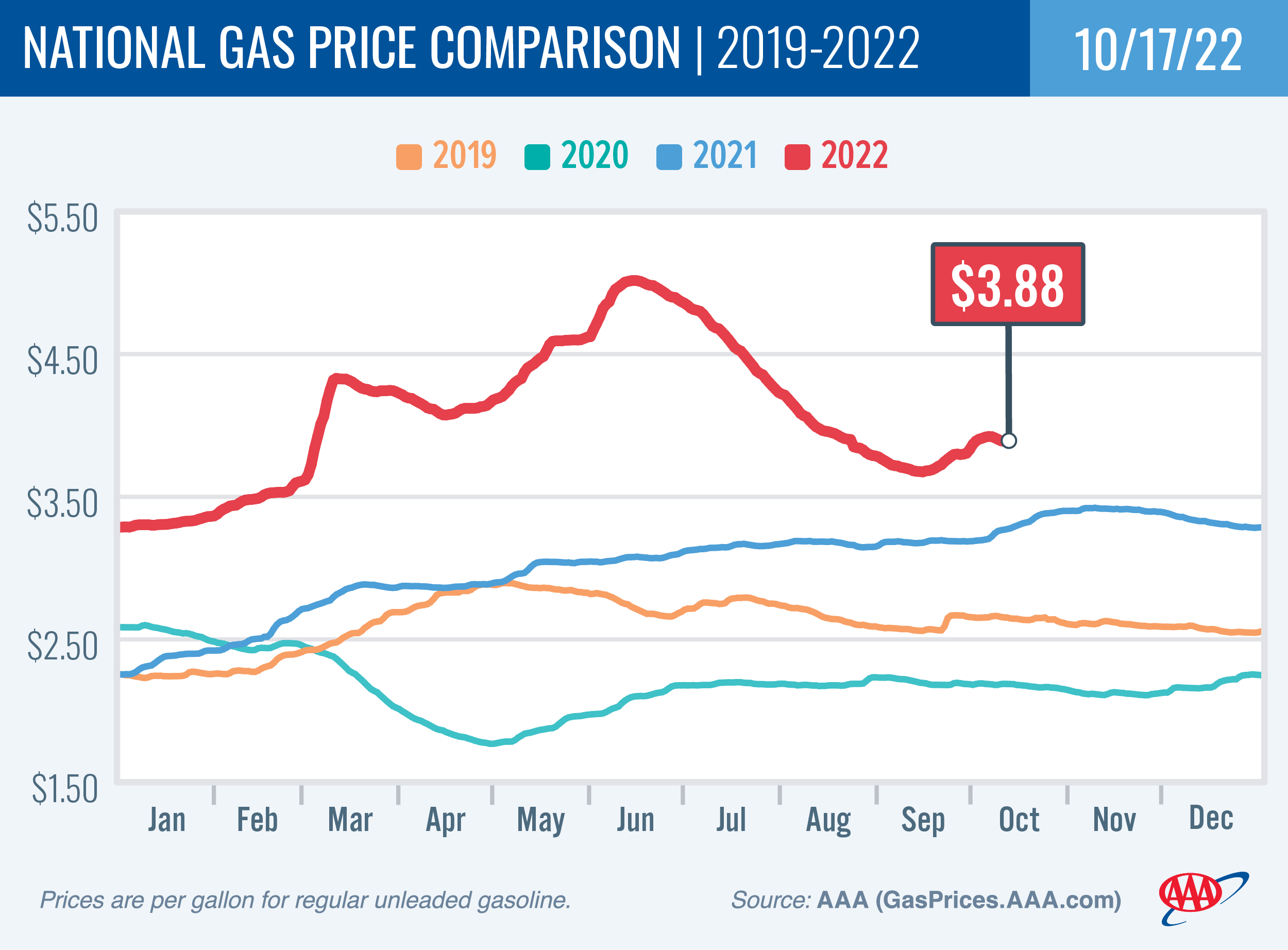
Diesel
For the week, the national average jumps 28 cents to $5.30 a gallon. The record high is $5.816 set on June 19. Oregon’s average rises a dime to $5.74. The record high is $6.47 set on July 3. A year ago the national average for diesel was $3.54 and the Oregon average was $3.74.
Find current fuel prices at GasPrices.AAA.com.
AAA news releases, high resolution images, broadcast-quality video, fact sheets and podcasts are available on the AAA NewsRoom at NewsRoom.AAA.com.
Find local news releases at https://oregon.aaa.com/community/media/media-contacts.html
Fuel prices are updated daily at AAA’s Daily Fuel Gauge at AAA Gas Prices. For more info go www.AAA.com. AAA Oregon/Idaho provides more than 875,000 members with travel, insurance, financial and automotive-related services, and is an affiliate of AAA National, serving more than 63 million motorists in North America.
Updated 10/11/2022
West Coast Gas Price Jumps Ease
Regional refineries come back online
PORTLAND, Ore., – Pump prices on the West Coast are finally settling down after three weeks of significant gains. Refineries in this region are coming back online after undergoing planned and unplanned maintenance. This is helping to ease the severe supply crunch. However, higher crude oil prices continue to put upward pressure on gas prices. For the week, the national average for regular adds 11 cents to $3.92 a gallon. The Oregon average climbs six cents to $5.52. Oregon went from having the fifth-largest weekly jump for a state last week to the 41st largest increase this week.
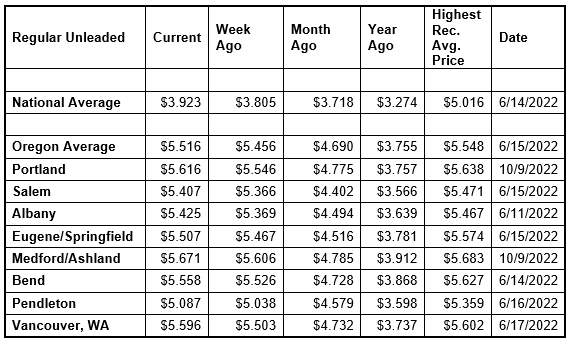
The Oregon average came within a penny of reaching a new record high this month when it got to $5.54 a gallon. It has decreased slightly since then. Both the national and Oregon averages hit record highs in mid-June, then declined for 14 consecutive weeks before rising again for the last three weeks. The national average reached its record high of $5.016 on June 14 while the Oregon average reached its record high of $5.548 on June 15.
“Pump prices on the West Coast skyrocketed after at least six refineries in California went offline or were operating at reduced capacity. This put a major dent in supplies in this region. Our pump prices shot up and also put upward pressure on the national average for gas,” says Marie Dodds, public affairs director for AAA Oregon/Idaho. “The improving refinery situation and the switch to winter blend fuel should help ease the upward momentum in gas prices, as long as crude oil prices don’t see significant gains.”
The change from summer blend gas to winter blend gas normally puts downward pressure on pump prices because winter blend gas is cheaper to produce. Summer blend fuel is more environmentally friendly than winter blend. It has a lower Reid vapor pressure, which means it is less volatile and doesn’t evaporate as quickly in hot weather. The switchover from summer- to winter blend can start on September 15 in most areas; however, in California the switch normally occurs on Oct. 31. This year, because of the supply issues, California Governor Gavin Newsom called for the switch to begin a month early.
Refineries typically perform maintenance in the spring and/or fall ahead of the seasonal switch. Most refineries in the U.S. are more than 50 years old. Some are more than 100 years old. Maintenance is necessary to keep refineries running smoothly.
Last week’s decision by OPEC+ to cut oil production by two million barrels a day has caused crude oil prices to rise back above $90 per barrel. Crude reached a recent high of $122.11 per barrel on June 8, and ranged from about $94 to $110 per barrel in July. In August, crude prices ranged between about $86 and $97. In September, crude prices ranged between about $76 and $88 per barrel. So far in October, crude has ranged between $82 and $92 per barrel.
Crude prices rose dramatically leading up to and in the first few months of Russia’s invasion of Ukraine. Russia is one of the world’s top oil producers and its involvement in a war causes market volatility, and sanctions imposed on Russia by the U.S. and other western nations resulted in tighter global oil supplies. Oil supplies were already tight around the world as demand for oil increased as pandemic restrictions eased. A year ago, crude was around $81 per barrel compared to $89 today.
Crude oil is the main ingredient in gasoline and diesel, so pump prices are impacted by crude prices on the global markets. On average, about 53% of what we pay for in a gallon of gasoline is for the price of crude oil, 12% is refining, 21% distribution and marketing, and 15% are taxes, according to the U.S. Energy Information Administration.
Despite rising pump prices, demand for gasoline in the U.S. increased from 8.83 million b/d to 9.47 million b/d for the week ending September 30. This is similar to last year at this time when demand was 9.43 million b/d. The increase may have been due to some prep ahead of Hurricane Ian as people fueled up before the storm.
Total domestic gasoline stocks decreased significantly by 4.7 million bbl to 207.5 million bbl. High gasoline demand, amid tight supply, has led to higher pump prices nationwide.
Quick stats
Oregon is one of 47 states and the District of Columbia with higher prices now than a week ago, and 32 states have double-digit increases. Delaware (+31 cents) has the largest weekly jump in the nation. California (-12 cents) has the largest weekly decline.
California ($6.29) has the most expensive gas in the country for the fifth week in a row and is the only state with an average above $6 a gallon. Six states, including Oregon, have averages at or above $5 a gallon. This week 13 states have averages at or above $4, and 37 states and the District of Columbia have averages in the $3-range.
The cheapest gas in the nation is in Georgia ($3.25) and Mississippi ($3.30). For the 92nd week in a row, no state has an average below $2 a gallon.
The difference between the most expensive and least expensive states is $3.04 which is extreme.
Oregon is one of 35 states with higher prices now than a month ago. The national average is 21 cents more and the Oregon average is 83 cents more than a month ago. Oregon has the third-largest monthly increase in the nation. California (+90 cents) has the largest month-over-month jump. New York (-25 cents) has the largest monthly drop. The average in Georgia is flat.
All 50 states and the District of Columbia have higher prices now than a year ago. The national average is 65 cents more and the Oregon average is $1.77 more than a year ago. This is the third-largest yearly increase in the nation. California (+$1.85) has the biggest yearly increase. Connecticut (+15 cents) has the smallest year-over-year increase.
West Coast
The West Coast region continues to have the most expensive pump prices in the nation with all seven states in the top 10. This is typical for the West Coast as this region tends to consistently have fairly tight supplies, consuming about as much gasoline as is produced. In addition, this region is located relatively far from parts of the country where oil drilling, production and refining occurs, so transportation costs are higher. And environmental programs in this region add to the cost of production, storage and distribution.
Refinery issues in California the last few weeks have exacerbated the situation, creating extremely tight supplies and causing pump prices in this region to soar.
| Rank | Region | Price on 10/11/22 | ||
| 1 | California | $6.29 | ||
| 2 | Alaska | $5.55 | ||
| 3 | Oregon | $5.52 | ||
| 4 | Nevada | $5.40 | ||
| 5 | Washington | $5.39 | ||
| 6 | Hawaii | $5.23 | ||
| 7 | Arizona | $4.57 | ||
| 8 | Idaho | $4.43 | ||
| 9 | Illinois | $4.40 | ||
| 10 | Michigan | $4.33 |
As mentioned above, California is the most expensive state for the fifth consecutive week with Alaska, Oregon, Nevada, Washington, Hawaii, and Arizona rounding out the top seven. Oregon is third most expensive for the third consecutive week.
Alaska (+13 cents) has the largest weekly jump in the West Coast region this week. California (-12 cents) has the largest week-over-week drop in the region.
The refinery utilization rate on the West Coast rose from 82.3% to 83.3% for the week ending September 30. The rate has ranged between about 76% and 90% in the last year.
According to EIA’s latest weekly report, total gas stocks in the region decreased from 24.92 million bbl to 24.68 million bbl.
Oil market dynamics
Crude prices increased last week after OPEC and its allies including Russia, known as OPEC+, announced intentions to cut crude production by 2 million b/d next month. Although crude prices have surged, the pricing impact may be short-lived as demand concerns continue to weigh on the market. For this week, crude prices could reverse course if the market continues to see indicators of weakening demand due to ongoing COVID-19 lockdowns in China and a slowdown in the economy as fears of recession grow, which could see crude prices decline due to falling demand. Crude prices did lose ground on Monday due to these concerns.
Additionally, EIA’s latest weekly report showed that total domestic crude inventories declined by 1.4 million bbl to 429.2 million bbl.
At the close of Friday’s formal trading session, WTI increased by $4.19 to settle at $92.64. At the close of Monday’s formal trading session, WTI fell $1.51 to close at $91.13. Today crude is trading around $89, compared to $78 a week ago. Crude prices are about $14 more than a year ago.
Drivers can find current gas prices along their route with the free AAA Mobile app for iPhone, iPad and Android. The app can also be used to map a route, find discounts, book a hotel and access AAA roadside assistance. Learn more at AAA.com/mobile.

Diesel
For the week, the national average soars 26 cents to $5.12 a gallon. The record high is $5.816 set on June 19. Oregon’s average jumps 19 cents to $5.64. The record high is $6.47 set on July 3. A year ago the national average for diesel was $3.36 and the Oregon average was $3.71.
Find current fuel prices at GasPrices.AAA.com.
AAA news releases, high resolution images, broadcast-quality video, fact sheets and podcasts are available on the AAA NewsRoom at NewsRoom.AAA.com.
Find local news releases at https://oregon.aaa.com/community/media/media-contacts.html
Fuel prices are updated daily at AAA’s Daily Fuel Gauge at AAA Gas Prices. For more info go www.AAA.com. AAA Oregon/Idaho provides more than 875,000 members with travel, insurance, financial and automotive-related services, and is an affiliate of AAA National, serving more than 63 million motorists in North America.
Updated 10/4/2022
Refinery Outages cause West Coast Gas Prices to Soar back near Record Highs
PORTLAND, Ore., – The West Coast is seeing the most extreme increase in gas prices in the country as several refineries in California undergo planned or unplanned maintenance. This is putting a severe crimp in supplies in this region. For the week, the national average for regular climbs six cents to $3.81 a gallon. The Oregon average leaps up 31 cents to $5.46. This is the fifth-largest weekly jump for a state in the nation.
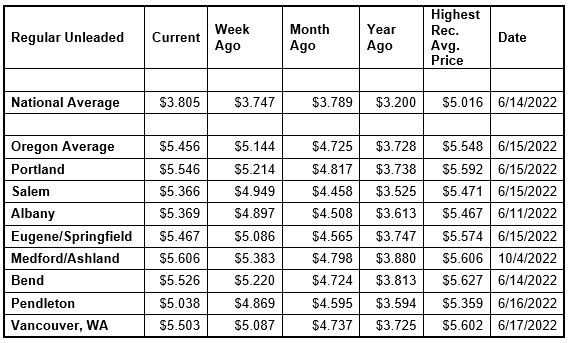
“At least six refineries in California are offline or operating at reduced capacity, and there is limited pipeline supply to the West Coast. This has put a huge dent in supplies in this region and gas prices are now again near the record highs we saw in mid-June,” says Marie Dodds, public affairs director for AAA Oregon/Idaho. “This is refinery maintenance season so it’s not unusual for refineries to be offline at this time of year. However, factor in the refineries that shut down unexpectedly with issues, and this creates a significant regional drop in gasoline supplies.”
Most refineries in the U.S. are more than 50 years old. Some are more than 100 years old. All refineries have to undergo regular maintenance in order to keep running.
California has the toughest environmental standards in the nation for its fuel, so other refineries in other parts of the country were not able to ship product here. California Governor Gavin Newsom just eased the California requirements effective immediately, allowing the sale of winter blend fuel a month early. This fuel is not as environmentally friendly as summer blend but is less expensive to produce. Oregon and Washington also have stringent clean fuel standards.
The situation on the West Coast is also putting upward pressure on the national average. Both the national and Oregon averages hit record highs in mid-June, then declined for 14 consecutive weeks before rising again for the last two weeks. The national average reached its record high of $5.016 on June 14 while the Oregon average reached its record high of $5.548 on June 15.
“The regional differences in gas prices are extreme, with prices in the West Coast region above $5 a gallon in many areas and even above $6 in California. Meantime, Texas and other Gulf Coast states have prices dipping below $3 a gallon in some places,” adds Dodds.
The Midwest has also seen gas prices surge due to a deadly refinery fire on September 20 in Toledo, Ohio, which closed the plant. According to the latest reports, the 160,000 barrel-per-day BP-Husky Toledo refinery could be down for months.
Crude oil prices are lower than they were in June but have risen back above $80 per barrel this week as OPEC+ considers production cuts. Crude reached a recent high of $122.11 per barrel on June 8, and ranged from about $94 to $110 per barrel in July. In August, crude prices ranged between about $86 and $97. In September, crude prices ranged between about $76 and $88 per barrel. In late September, West Texas Intermediate fell below $80 per barrel for the first time since January.
Crude prices rose dramatically leading up to and in the first few months of Russia’s invasion of Ukraine. Russia is one of the world’s top oil producers and its involvement in a war causes market volatility, and sanctions imposed on Russia by the U.S. and other western nations resulted in tighter global oil supplies. Oil supplies were already tight around the world as demand for oil increased as pandemic restrictions eased. A year ago, crude was around $78 per barrel compared to $87 today.
Crude oil is the main ingredient in gasoline and diesel, so pump prices are impacted by crude prices on the global markets. On average, about 53% of what we pay for in a gallon of gasoline is for the price of crude oil, 12% is refining, 21% distribution and marketing, and 15% are taxes, according to the U.S. Energy Information Administration.
Demand for gasoline in the U.S. increased from 8.32 million b/d to 8.83 million b/d to last week. This is lower than last year at this time when demand was at 9.4 million b/d. Total domestic gasoline stocks decreased by 2.4 million bbl to 212.2 million bbl., according to the U.S. Energy Information Administration (EIA). If demand remains robust as supply tightens, drivers should brace for rising pump prices through the weekend.
Quick stats
Oregon is one of 17 states with higher prices now than a week ago, and 11 states, including Oregon, have double-digit increases. California (+53 cents) has the largest weekly jump in the nation. Oregon (+31) has the fifth-largest week-over-week jump. Florida (-21 cents) has the largest weekly decline. The average in Idaho is flat this week.
California ($6.41) has the most expensive gas in the country for the fourth week in a row and is the only state with an average above $6 a gallon. Six states, including Oregon, have averages at or above $5 a gallon. This week 13 states have averages at or above $4, and 37 states and the District of Columbia have averages in the $3-range.
The cheapest gas in the nation is in Mississippi ($3.06) and Texas ($3.10). For the 91st week in a row, no state has an average below $2 a gallon.
The difference between the most expensive and least expensive states is $3.35 which is extremely stark.
Oregon is one of 16 states with higher prices now than a month ago. The national average is two cents more and the Oregon average is 73 cents more than a month ago. Oregon has the second-largest monthly increase in the nation. California (+$1.15 cents) has the largest month-over-month jump. Rhode Island (-51 cents) has the largest monthly drop.
All 50 states and the District of Columbia have higher prices now than a year ago. The national average is 61 cents more and the Oregon average is $1.73 more than a year ago. This is the second-largest yearly increase in the nation. California (+$2.00) has the biggest yearly increase. Connecticut (+6 cents) has the smallest year-over-year increase.
West Coast
The West Coast region continues to have the most expensive pump prices in the nation with all seven states in the top 10. This is typical for the West Coast as this region tends to consistently have fairly tight supplies, consuming about as much gasoline as is produced. In addition, this region is located relatively far from parts of the country where oil drilling, production and refining occurs, so transportation costs are higher. And environmental programs in this region add to the cost of production, storage and distribution.
Current refinery issues in California have exacerbated the situation, creating extremely tight supplies and sending prices in this region skyrocketing.
| Rank | Region | Price on 10/4/22 | ||
| 1 | California | $6.41 | ||
| 2 | Nevada | $5.51 | ||
| 3 | Oregon | $5.46 | ||
| 4 | Alaska | $5.41 | ||
| 5 | Washington | $5.33 | ||
| 6 | Hawaii | $5.22 | ||
| 7 | Arizona | $4.50 | ||
| 8 | Idaho | $4.42 | ||
| 9 | Illinois | $4.21 | ||
| 10 | Michigan | $4.18 |
As mentioned above, California is the most expensive state for the fourth consecutive week with Nevada, Oregon, Alaska, Washington, Hawaii, and Arizona rounding out the top seven. Oregon is third most expensive for the second consecutive week.
Six of the seven states in the West Coast region are seeing large jumps this week. California (+53 cents) has the largest increase in the region and the country. Alaska (+53 cents), Nevada (+38 cents), Arizona (+32 cents), Oregon (+31 cents), and Washington (+31 cents) have the largest increases in the region and the nation. Hawaii (-2 cents) is the only state in the region with a week-over-week decline.
The refinery utilization rate on the West Coast rose from 81.4% to 82.3% for the week ending September 23. The rate has ranged between about 76% and 90% in the last year.
According to EIA’s latest weekly report, total gas stocks in the region decreased from 25.78 million bbl. to 24.92 million bbl.
Oil market dynamics
Crude prices decreased at the end of last week due to lingering market concerns that demand will decline if global economic growth stalls or decreases due to a recession. However, reports the Organization of the Petroleum Exporting Countries (OPEC) and its allies—including Russia—known as OPEC+ intend to announce collective oil production cuts at their next meeting tomorrow (October 5) in Vienna have sent crude prices higher this week. Additionally, according to the EIA’s latest weekly report, total domestic commercial crude inventories decreased slightly by 200,000 bbl to 430.6 million bbl.
At the close of Friday’s formal trading session, WTI decreased by $1.74 to settle at $79.49. At the close of Monday’s formal trading session, WTI jumped $4.14 to close at $83.63. Today crude is trading around $87, compared to $79 a week ago. Crude prices are about $8 more than a year ago.
Drivers can find current gas prices along their route with the free AAA Mobile app for iPhone, iPad and Android. The app can also be used to map a route, find discounts, book a hotel and access AAA roadside assistance. Learn more at AAA.com/mobile.

Diesel
For the week, the national average falls three cents to $4.86 a gallon. The record high is $5.816 set on June 19. Oregon’s average dips a penny to $5.45. The record high is $6.47 set on July 3. A year ago the national average for diesel was $3.36 and the Oregon average was $3.68.
Find current fuel prices at GasPrices.AAA.com.
AAA news releases, high resolution images, broadcast-quality video, fact sheets and podcasts are available on the AAA NewsRoom at NewsRoom.AAA.com.
Find local news releases at https://oregon.aaa.com/community/media/media-contacts.html
Fuel prices are updated daily at AAA’s Daily Fuel Gauge at AAA Gas Prices. For more info go www.AAA.com. AAA Oregon/Idaho provides more than 850,000 members with travel, insurance, financial and automotive-related services, and is an affiliate of AAA National, serving more than 62 million motorists in North America.
Updated 9/27/2022
West Coast Pump Prices Skyrocket due to Refinery Issues
Gas Prices Rise after 14 Weeks of Declines
PORTLAND, Ore., – After 14 weeks of declines, gas prices are on the rise, soaring on the West Coast and in the Midwest with more moderate increases in other parts of the country. Several refineries in California are undergoing planned or unplanned maintenance, creating extremely tight supplies on the West Coast. For the week, the national average for regular adds seven cents to $3.75 a gallon. The Oregon average rockets up 50 cents to $5.14. This is the largest weekly jump in the nation.
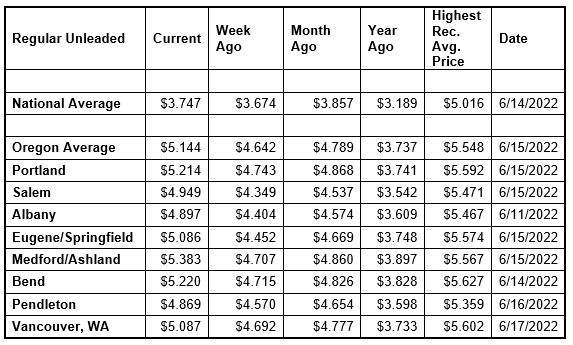
“Multiple refineries in the Los Angeles area and a refinery in Washington State are experiencing either planned or unplanned refinery work which could last several more days. This has put a significant crimp in supplies and sent pump prices soaring in this region. In addition, the Olympic pipeline in Washington is due for maintenance, perhaps as early as this week,” says Marie Dodds, public affairs director for AAA Oregon/Idaho.
Hurricane Ian also has the potential to cause problems, depending on the storm’s track, by disrupting oil production, refining and transportation in the Gulf of Mexico.
Until this week, the national and Oregon averages had been declining for 14 consecutive weeks, backing away from record highs set in mid-June. The national average reached its record high of $5.016 on June 14 while the Oregon average reached its record high of $5.548 on June 15.
“Lackluster demand for gas and lower crude oil prices should take some pressure off of rising pump prices. But drivers can expect a very volatile couple of weeks due to the refinery issues as well as Hurricane Ian slamming the Gulf Coast,” adds Dodds.
Crude oil prices have tumbled from recent highs due to fears of economic slowdowns elsewhere around the globe. Crude reached a recent high of $122.11 per barrel on June 8, and ranged from about $94 to $110 per barrel in July. In August, crude prices ranged between about $86 and $97. In September, crude prices have been between about $76 and $89 per barrel. Last week, West Texas Intermediate fell below $80 per barrel for the first time since January.
Crude prices rose dramatically leading up to and in the first few months of Russia’s invasion of Ukraine. Russia is one of the world’s top oil producers and its involvement in a war causes market volatility, and sanctions imposed on Russia by the U.S. and other western nations resulted in tighter global oil supplies. Oil supplies were already tight around the world as demand for oil increased as pandemic restrictions eased. A year ago, crude was around $75 per barrel compared to $77 today.
Crude oil is the main ingredient in gasoline and diesel, so pump prices are impacted by crude prices on the global markets. On average, about 53% of what we pay for in a gallon of gasoline is for the price of crude oil, 12% is refining, 21% distribution and marketing, and 15% are taxes, according to the U.S. Energy Information Administration.
Demand for gasoline in the U.S. decreased from 8.49 million b/d to 8.32 million b/d last week. This is lower than last year at this time when demand was at 8.9 million b/d. Total domestic gasoline stocks increased by 1.6 million bbl to 214.6 million bbl. Although gasoline demand has decreased, tight supply and fluctuating oil prices have increased the national average price. However, if gas demand remains low, pump price increases should be temporary.
Quick stats
Oregon is one of 28 states with higher prices now than a week ago, and 11 states, including Oregon, have double-digit increases. Oregon (+50 cents) has the largest weekly jump in the nation. Delaware (+4/10ths of a cent) has the smallest weekly increase. Rhode Island (-12 cents) has the largest weekly decline.
California ($5.88) has the most expensive gas in the country for the third week in a row. This week Oregon, Nevada ($5.12) and Washington ($5.02) join California and Hawaii ($5.27) as the only states with an average at or above $5 a gallon. This week 11 states have averages at or above $4, and 39 states and the District of Columbia have averages in the $3-range.
The cheapest gas in the nation is in Mississippi ($3.07) and Texas ($3.11). For the 90th week in a row, no state has an average below $2 a gallon.
Oregon is one of 11 states with higher prices now than a month ago. The national average is 11 cents less and the Oregon average is 36 cents more than a month ago. Oregon has the second-largest monthly increase in the nation. California (+60 cents) has the largest month-over-month jump. Connecticut (-58 cents) has the largest monthly drop.
All 50 states and the District of Columbia have higher prices now than a year ago. The national average is 56 cents more and the Oregon average is $1.41 more than a year ago. This is the second-largest yearly increase in the nation. California (+$1.49) has the biggest yearly increase. Connecticut (+13 cents) has the smallest year-over-year increase.
West Coast
The West Coast region continues to have the most expensive pump prices in the nation with all seven states in the top 10. This is typical for the West Coast as this region tends to consistently have fairly tight supplies, consuming about as much gasoline as is produced. In addition, this region is located relatively far from parts of the country where oil drilling, production and refining occurs, so transportation costs are higher. And environmental programs in this region add to the cost of production, storage and distribution.
The current refinery issues on the West Coast are causing pump prices here to spike this week due to limited supplies.
| Rank | Region | Price on 9/27/22 | ||
| 1 | California | $5.88 | ||
| 2 | Hawaii | $5.24 | ||
| 3 | Oregon | $5.14 | ||
| 4 | Nevada | $5.12 | ||
| 5 | Washington | $5.02 | ||
| 6 | Alaska | $4.88 | ||
| 7 | Idaho | $4.42 | ||
| 8 | Utah | $4.19 | ||
| 9 | Arizona | $4.18 | ||
| 10 | Michigan | $4.12 |
As mentioned above, California is the most expensive state for the third consecutive week. Hawaii, Oregon, Nevada, Washington, and Alaska round out the top six. Arizona is ninth. Oregon rises to third after a week at fourth.
Six of the seven states in the West Coast region are seeing large jumps this week. Oregon (+50 cents) has the largest increase in the region and the country. California (+43 cents), Washington (+40 cents), Alaska (+25 cents), and Nevada (+20 cents) also have large weekly increases. Hawaii (-3 cents) is the only state in the region with a week-over-week decline.
The refinery utilization rate on the West Coast fell from 83.8% to 81.4% for the week ending September 16. This decline is largely due to planned and unplanned refinery maintenance. The rate has ranged between about 76% and 90% in the last year.
According to EIA’s latest weekly report, total gas stocks in the region increased from 25.66 million bbl. to 25.78 million bbl.
Oil market dynamics
Crude prices fell below $80 per barrel last week, a price point not seen since early January 2022, as the market continues to worry about a global recession and high inflation. If a recession occurs, crude demand and prices would likely decline. For this week, crude prices could continue to decrease if recession fears persist. Additionally, EIA’s latest weekly report showed that total commercial crude inventories increased by 1.2 million bbl to 430.8 million bbl.
At the close of Friday’s formal trading session, WTI decreased by $4.75 to settle at $78.74. At the close of Monday’s formal trading session, WTI fell $2.03 to close at $76.71. Today crude is trading around $78, compared to $85 a week ago. Crude prices are about $3 more than a year ago.
Drivers can find current gas prices along their route with the free AAA Mobile app for iPhone, iPad and Android. The app can also be used to map a route, find discounts, book a hotel and access AAA roadside assistance. Learn more at AAA.com/mobile.

Diesel
For the week, the national average loses a nickel to $4.89 a gallon. The record high is $5.816 set on June 19. Oregon’s average slips two cents to $5.46. The record high is $6.47 set on July 3. A year ago the national average for diesel was $3.32 and the Oregon average was $3.68.
Find current fuel prices at GasPrices.AAA.com.
AAA news releases, high resolution images, broadcast-quality video, fact sheets and podcasts are available on the AAA NewsRoom at NewsRoom.AAA.com.
Find local news releases at https://oregon.aaa.com/community/media/media-contacts.html
Fuel prices are updated daily at AAA’s Daily Fuel Gauge at AAA Gas Prices. For more info go www.AAA.com. AAA Oregon/Idaho provides more than 850,000 members with travel, insurance, financial and automotive-related services, and is an affiliate of AAA National, serving more than 62 million motorists in North America.
Updated 9/26/2022
Special statement ahead of tomorrow’s weekly gas price update:
Gas Prices Skyrocket on the West Coast due to Refinery Issues
Hurricane Ian may also send pump prices higher
PORTLAND, Ore., – After 14 consecutive weeks of declines, the national and Oregon averages for regular gas are on the rise. Refinery issues on the West Coast have sent prices in this region soaring. For the week, the national average adds a nickel to $3.72. The Oregon average shoots up 36 cents to $5.01 a gallon. It’s the first time the Oregon average has been above $5 a gallon since early August.
At this time, multiple U.S. West Coast refineries in California and a refinery in Washington State are experiencing either planned or unplanned refinery work which could last several more days. This has put a significant crimp in supplies and sent pump prices soaring in this region.
Hurricane Ian has the potential to create problems, depending on the storm’s track, by disrupting oil drilling, production, and refining in the Gulf Coast.
“Drivers can expect a volatile couple of weeks, due to refinery issues here on the West Coast and the potential for reduced output due to Hurricane Ian,” says Marie Dodds, public affairs director for AAA Oregon/Idaho.
The West Coast always has tight supplies, as this area tends to produce about as much gasoline as is consumed. When there are issues that cause a disruption in supplies, such as planned or unplanned refinery maintenance, prices here can skyrocket, and that’s what we’re seeing this week.
Pump price increases should be temporary, as the price of crude oil has dropped below $80 a barrel for the first time since January, primarily due to fears of a global economic slowdown.
Updated 9/20/2022
Gas Prices Fall for 14th consecutive Week
National, Oregon averages are at their lowest prices in six months
PORTLAND, Ore., – The national and Oregon averages have fallen for 14 weeks in a row and are at their cheapest prices since early March. Lower crude oil prices, lackluster demand for gas in the U.S., and the switch to winter blend fuel are the major drivers of lower pump prices. For the week, the national average for regular slips three cents to $3.67 a gallon. The Oregon average loses four cents to $4.64.
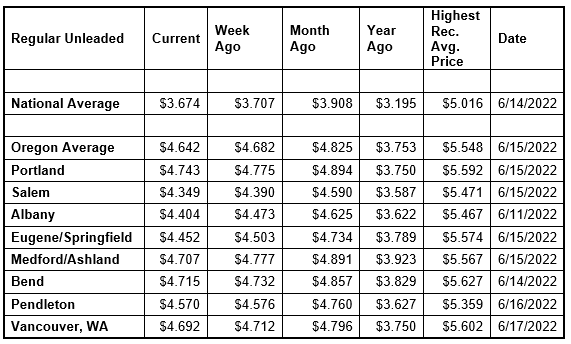
The national average reached its record high of $5.016 on June 14 while the Oregon average reached its record high of $5.548 on June 15. Both averages have been steadily declining since then.
“The switch to less expensive winter blend gasoline is putting a bit more downward pressure on pump prices this month; however, some factors have the potential to push prices higher, including the ongoing war in Ukraine, refinery maintenance, and the possibility of a hurricane that impacts oil and gas infrastructure, refining and transportation,” says Marie Dodds, public affairs director for AAA Oregon/Idaho. “Although AAA expects gas prices to continue to decline during the fall months, it’s possible we could see prices rise briefly at times.”
Most of the country is now using less expensive winter blend gasoline, so modest pump price reductions have occurred. On September 15, many refiners switch from summer-blend gasoline to winter-blend. The summer-blend gas has a lower Reid vapor pressure, meaning it doesn’t evaporate as easily and is more environmentally friendly during the hot summer months. In California, this switch occurs on November 1.
Crude oil prices have tumbled from recent highs due to fears of economic slowdowns elsewhere around the globe. Crude reached a recent high of $122.11 per barrel on June 8, and ranged from about $94 to $110 per barrel in July. In August, crude prices ranged between about $86 and $97. So far in September, crude prices have been between about $81 and $89 per barrel.
Crude prices rose dramatically leading up to and in the first few months of Russia’s invasion of Ukraine. Russia is one of the world’s top oil producers and its involvement in a war causes market volatility, and sanctions imposed on Russia by the U.S. and other western nations resulted in tighter global oil supplies. Oil supplies were already tight around the world as demand for oil increased as pandemic restrictions eased. A year ago, crude was around $70 per barrel compared to $84 today.
Crude oil is the main ingredient in gasoline and diesel, so pump prices are impacted by crude prices on the global markets. On average, about 53% of what we pay for in a gallon of gasoline is for the price of crude oil, 12% is refining, 21% distribution and marketing, and 15% are taxes, according to the U.S. Energy Information Administration.
Demand for gasoline in the U.S. decreased from 8.73 million b/d to 8.49 million b/d last week. Thisis lower than last year at this time when demand was at 8.89 million b/d. Total domestic gasoline stocks declined by 1.8 million bbl to 213 million bbl., according to the U.S. Energy Information Administration (EIA). Although gasoline demand has decreased, fluctuating oil prices have led to smaller pump price decreases. If oil prices spike, the national average will likely reverse as pump prices increase.
Quick stats
Oregon is one of 37 states and the District of Columbia with lower prices now than a week ago, and nine states have double-digit declines. Rhode Island (-14 cents) has the largest weekly drop. Nevada (-2/10ths of a cent) has the smallest. Iowa (+14 cents) has the largest weekly jump. Wisconsin (+2/10ths of a cent) has the smallest weekly increase.
California ($5.46) has the most expensive gas in the country for the second week in a row. California and Hawaii ($5.27) remain the only two states with an average at or above $5 a gallon, same as a week ago. This week eight states, including Oregon, have averages at or above $4, and 42 states and the District of Columbia have averages in the $3-range.
The cheapest gas in the nation is in Mississippi ($3.10) and Louisiana ($3.14). For the 89th week in a row, no state has an average below $2 a gallon.
Oregon is one of 49 states and the District of Columbia with lower prices now than a month ago. The national average is 23 cents less and the Oregon average is 18 cents less than a month ago. Oregon has the 13th-smallest monthly decrease in the nation. Connecticut (-60 cents) has the largest monthly drop. California (+12 cents) is the only state with a month-over-month increase. Nevada is the only state where the current price is the same as a month ago.
All 50 states and the District of Columbia have higher prices now than a year ago. The national average is 48 cents more and the Oregon average is 89 cents more than a year ago. This is the 5th-largest yearly increase in the nation. Hawaii (+$1.21) has the biggest yearly increase. Colorado (+13 cents) has the smallest year-over-year increase.
West Coast
The West Coast region continues to have the most expensive pump prices in the nation with all seven states in the top 10. This is typical for the West Coast as this region tends to consistently have fairly tight supplies, consuming about as much gasoline as is produced. In addition, this region is located relatively far from parts of the country where oil drilling, production and refining occurs, so transportation costs are higher. And environmental programs in this region add to the cost of production, storage and distribution.
| Rank | Region | Price on 9/20/22 | ||
| 1 | California | $5.46 | ||
| 2 | Hawaii | $5.27 | ||
| 3 | Nevada | $4.92 | ||
| 4 | Oregon | $4.64 | ||
| 5 | Alaska | $4.64 | ||
| 6 | Washington | $4.62 | ||
| 7 | Idaho | $4.40 | ||
| 8 | Utah | $4.24 | ||
| 9 | Arizona | $3.98 | ||
| 10 | Montana | $3.93 |
As mentioned above, California is the most expensive state for the second consecutive week. Hawaii, Nevada, Oregon, Alaska and Washington round out the top six. Arizona is ninth. Oregon rises to fourth after seven weeks at fifth.
Six of the seven states in the region are seeing lower prices this week. Alaska (-6) has the largest weekly decline in the West Coast region. Oregon (-4 cents), Arizona (-4 cents), Washington (-3 cents), Hawaii (-1 cent) and Nevada (-2/10ths of a cent) are the other states in the region with week-over-week decreases. California (+3 cents) has a week-over-week increase.
The refinery utilization rate on the West Coast fell from 88.1% to 83.8% for the week ending September 9. This decline is largely due to refinery maintenance. The rate has ranged between about 76% and 90% in the last year.
According to EIA’s latest weekly report, total gas stocks in the region decreased from 25.97 million bbl to 25.66 million bbl.
Oil market dynamics
While a strengthening dollar helped to cap crude price increases at the end of last week, prices decreased earlier in the week after the Consumer Price Index showed that inflation remains stronger than expected. As a result, the market is concerned that the Federal Reserve could take more drastic measures that could lead to a recession, which would likely lead to a drop in crude demand and prices. For this week, persistent demand concerns could put downward pressure on prices. EIA’s latest weekly report also showed that total commercial crude inventories increased by 2.4 million bbl to 429.6 million bbl.
At the close of Friday’s formal trading session, WTI increased by a penny to settle at $85.11. At the close of Monday’s formal trading session, WTI gained 62 cents to close at $85.73. Today crude is trading around $83, compared to $87 a week ago. Crude prices are about $14 more than a year ago.
Drivers can find current gas prices along their route with the free AAA Mobile app for iPhone, iPad and Android. The app can also be used to map a route, find discounts, book a hotel and access AAA roadside assistance. Learn more at AAA.com/mobile.
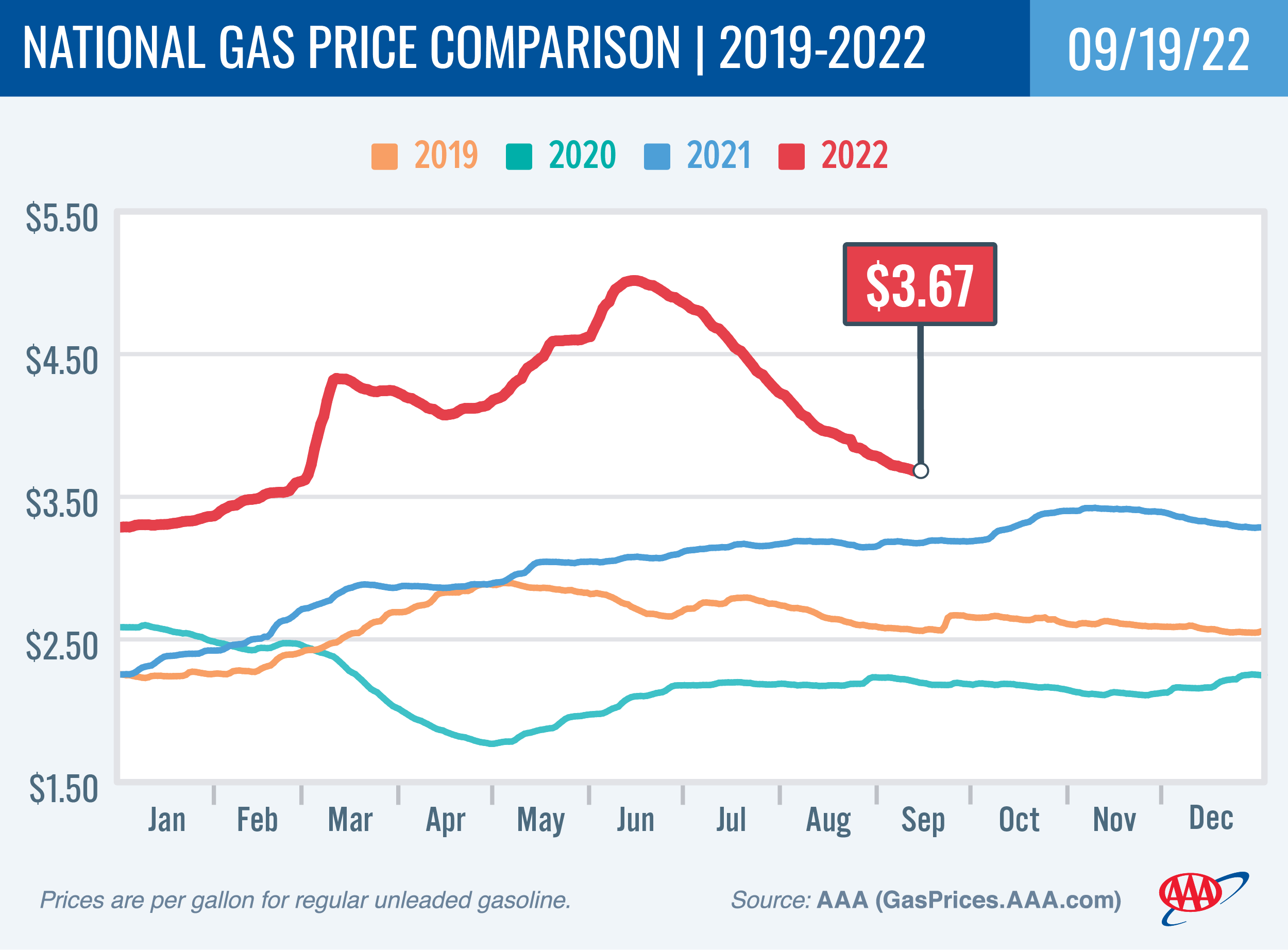
Diesel
For the week, the national average loses six cents to $4.94 a gallon. The record high is $5.816 set on June 19. Oregon’s average drops seven cents to $5.48. The record high is $6.47 set on July 3. A year ago the national average for diesel was $3.31 and the Oregon average was $3.68.
Find current fuel prices at GasPrices.AAA.com.
AAA news releases, high resolution images, broadcast-quality video, fact sheets and podcasts are available on the AAA NewsRoom at NewsRoom.AAA.com.
Find local news releases at https://oregon.aaa.com/community/media/media-contacts.html
Fuel prices are updated daily at AAA’s Daily Fuel Gauge at AAA Gas Prices. For more info go www.AAA.com. AAA Oregon/Idaho provides more than 850,000 members with travel, insurance, financial and automotive-related services, and is an affiliate of AAA National, serving more than 62 million motorists in North America.
Updated 9/13/2022
Pump Prices Keep Falling as Summer Driving Season Ends
PORTLAND, Ore., – The national and Oregon averages for gasoline continue to drop and are at their lowest prices since the spring. This marks the 13th consecutive week of declines, which are driven in part by lower crude oil prices. For the week, the national average for regular loses seven cents to $3.71 a gallon. The Oregon average dips four cents to $4.68.

The national average is at its lowest price since early March while the Oregon average is at its lowest price since early April. The national average reached its record high of $5.016 on June 14 while the Oregon average reached its record high of $5.548 on June 15. Both averages have been steadily declining since then. The major drivers of lower pump prices have been falling crude oil prices and several weeks of seasonally low demand for gas during the summer driving season.
“Less expensive oil usually translates into lower pump prices, and this trend has helped pump prices fall for 13 consecutive weeks. Barring unforeseen events, AAA expects gas prices to continue to drop with fall approaching,” says Marie Dodds, public affairs director for AAA Oregon/Idaho. “However, one factor that always has the potential to send oil and gas prices higher is a hurricane that impacts oil and gas infrastructure, production and transportation.”
Crude oil prices have tumbled from recent highs due to fears of economic slowdowns elsewhere around the globe. Crude reached a recent high of $122.11 per barrel on June 8, and ranged from about $94 to $110 per barrel in July. In August, crude prices ranged between about $86 and $97. So far in September, crude prices have been between about $81 and $89 per barrel.
Crude prices rose dramatically leading up to and in the first few months of Russia’s invasion of Ukraine. Russia is one of the world’s top oil producers and its involvement in a war causes market volatility, and sanctions imposed on Russia by the U.S. and other western nations resulted in tighter global oil supplies. Oil supplies were already tight around the world as demand for oil increased as pandemic restrictions eased. A year ago, crude was around $69 per barrel compared to $92 today.
Crude oil is the main ingredient in gasoline and diesel, so pump prices are impacted by crude prices on the global markets. On average, about 53% of what we pay for in a gallon of gasoline is for the price of crude oil, 12% is refining, 21% distribution and marketing, and 15% are taxes, according to the U.S. Energy Information Administration.
Demand for gasoline in the U.S. increased slightly from 8.59 million b/d to 8.73 million b/d last week. However, this is lower than last year at this time when demand was at 9.61 million b/d. Total domestic gasoline stocks rose by 300,000 bbl to 214.8 million bbl., according to the U.S. Energy Information Administration (EIA). Although gasoline demand has increased slightly, lower oil prices have led to falling pump prices. If gasoline demand begins to subside, as it typically does post-Labor Day with the end of summer driving, pump prices will likely continue to decrease.
Quick stats
Oregon is one of 46 states and the District of Columbia with lower prices now than a week ago, and 17 states have double-digit declines. Maryland (-16 cents) has the largest weekly drop. Nebraska (-1 cent) has the smallest. California (+16 cents) has the largest weekly jump, driven mostly by the extreme heat in the state and the impact on refining. Nevada (+8 cents), Arizona (+5 cents) and Michigan (+1 cent) are the other states with week-over-week increases.
After three weeks, California ($5.43) bumps Hawaii ($5.28) as the state with the most expensive gas in the nation. Hawaii and California remain the only two states with an average at or above $5 a gallon, same as a week ago. This week nine states, including Oregon, have averages at or above $4, and 41 states and the District of Columbia have averages in the $3-range.
The cheapest gas in the nation is in Texas ($3.15) and Mississippi ($3.15). For the 88th week in a row, no state has an average below $2 a gallon.
Oregon is one of 49 states and the District of Columbia with lower prices now than a month ago. The national average is 26 cents less and the Oregon average is 20 cents less than a month ago. Oregon has the 11th-smallest monthly decrease in the nation. Connecticut (-57 cents) has the largest monthly drop. Nevada (-2 cents) has the smallest. California (+5 cents) is the only state with a month-over-month increase.
All 50 states and the District of Columbia have higher prices now than a year ago. The national average is 53 cents more and the Oregon average is 92 cents more than a year ago. This is the 5th-largest yearly increase in the nation. Hawaii (+$1.23) has the biggest yearly increase. Colorado (+8 cents) has the smallest year-over-year increase.
West Coast
The West Coast region continues to have the most expensive pump prices in the nation with all seven states in the top 10. This is typical for the West Coast as this region tends to consistently have fairly tight supplies, consuming about as much gasoline as is produced. In addition, this region is located relatively far from parts of the country where oil drilling, production and refining occurs, so transportation costs are higher. And environmental programs in this region add to the cost of production, storage and distribution.
| Rank | Region | Price on 9/13/22 | ||
| 1 | California | $5.43 | ||
| 2 | Hawaii | $5.28 | ||
| 3 | Nevada | $4.93 | ||
| 4 | Alaska | $4.70 | ||
| 5 | Oregon | $4.68 | ||
| 6 | Washington | $4.65 | ||
| 7 | Idaho | $4.46 | ||
| 8 | Utah | $4.30 | ||
| 9 | Arizona | $4.02 | ||
| 10 | Illinois | $3.99 |
As mentioned above, California bumps Hawaii as the most expensive state. Hawaii, Nevada, Alaska, Oregon, and Washington round out the top six. Arizona is ninth. Oregon is fifth for the seventh week in a row.
Three of the West Coast states are seeing fairly large increases this week: California (+16 cents), Nevada (+8 cents), and Arizona (+5 cents). Alaska (-6 cents) has the largest weekly drop in the region. Hawaii (-2 cents) has the smallest.
The refinery utilization rate on the West Coast rose from 84.7% to 88.1% for the week ending September 2. The rate has ranged between about 76% and 90% in the last year.
According to EIA’s latest weekly report, total gas stocks in the region decreased from 26.69 million bbl to 25.97 million bbl.
Oil market dynamics
Although a weakening dollar helped to increase crude prices at the end of the week, prices dropped earlier in the week amid ongoing market concerns that oil demand will fall if economic growth slows or stalls due to a recession. For this week, crude prices could decrease if demands concerns persist. Additionally, EIA’s latest weekly report showed that total commercial crude inventories increased significantly by 8.9 million bbl to 427.2 million bbl.
At the close of Friday’s formal trading session, WTI increased by $3.25 to settle at $86.79. At the close of Monday’s formal trading session, WTI gained 99 cents to close at $87.78. Today crude is trading around $86, compared to $87 a week ago. Crude prices are about $19 more than a year ago.
Drivers can find current gas prices along their route with the free AAA Mobile app for iPhone, iPad and Android. The app can also be used to map a route, find discounts, book a hotel and access AAA roadside assistance. Learn more at AAA.com/mobile.

Diesel
For the week, the national average falls six cents to $5.00 a gallon. The record high is $5.816 set on June 19. Oregon’s average loses four cents to $5.55. The record high is $6.47 set on July 3. A year ago the national average for diesel was $3.30 and the Oregon average was $3.70.
Find current fuel prices at GasPrices.AAA.com.
AAA news releases, high resolution images, broadcast-quality video, fact sheets and podcasts are available on the AAA NewsRoom at NewsRoom.AAA.com.
Find local news releases at https://oregon.aaa.com/community/media/media-contacts.html
Fuel prices are updated daily at AAA’s Daily Fuel Gauge at AAA Gas Prices. For more info go www.AAA.com. AAA Oregon/Idaho provides more than 850,000 members with travel, insurance, financial and automotive-related services, and is an affiliate of AAA National, serving more than 62 million motorists in North America.
Updated 8/30/2022
Gas Prices Fall ahead of Labor Day Holiday
But Oregon drivers will stay pay the highest pump prices ever for the holiday
PORTLAND, Ore., – The national and Oregon averages for gasoline are falling for the 11th week in a row ahead of the Labor Day holiday. The major drivers continue to be lower crude oil prices and seasonally low demand for gas. For the week, the national average for regular slips a nickel to $3.84 a gallon. The Oregon average also loses a nickel to $4.78.
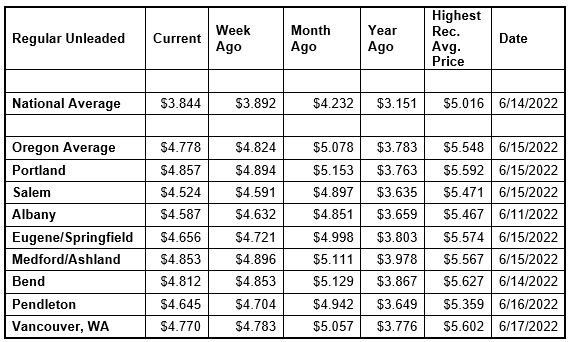
“Oregon Drivers will pay the most ever for gas over the Labor Day holiday weekend,” says Marie Dodds, public affairs director for AAA Oregon/Idaho. “The only other time that the Oregon average was above $4 a gallon for the holiday was in 2012 when the average on Labor Day was $4.02. Nationally, gas prices over Labor Day will be similar to 2012 when the Labor Day average was $3.83.”
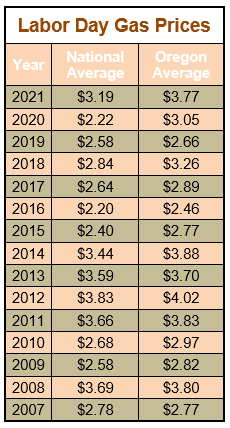
While Memorial Day marks the unofficial start to the summer travel season, Labor Day marks the unofficial end. Although this will be a busy travel weekend compared to other weekends in August and September, travel volume over Labor Day is always significantly less than the other major summer holidays, Memorial Day and Independence Day. With many schools already back in session or starting soon, families tend to take shorter trips that are closer to home over Labor Day.
Here are the top 10 destinations for Labor Day based on bookings and searches at AAA.com/travel over the past 30 days:
- Anaheim, CA
- Seattle, WA
- Central Oregon
- Oregon Coast
- Las Vegas, NV
- San Diego, CA
- Honolulu, HI
- Vancouver, British Columbia
- Jackson Hole, WY
- San Francisco, CA
The national average reached its record high of $5.016 on June 14 while the Oregon average reached its record high of $5.548 on June 15. Both averages have been steadily declining since then. The major drivers of lower pump prices have been falling crude oil prices and a few weeks of seasonally low demand for gas.
“Demand for gas in the U.S. has been seasonally low for a number of weeks this summer, likely because prices have remained elevated after climbing to record highs in June,” says Dodds.
A recent survey from AAA showed that Americans have changed their driving habits to cope with high gas prices. Almost two-thirds (64%) of U.S. adults have changed their driving habits or lifestyle since March, with 23% making “major changes.” Drivers’ top three changes to offset high gas prices are driving less, combining errands, and reducing shopping or dining out. Other changes include delaying major purchases, postponing vacations and saving less money.
Find complete results in the AAA consumer gas price survey news release.
Demand for gasoline in the U.S. tumbled from 9.35 million b/d to 8.43 million b/d last week, which is low for this time of year. Last year, demand was at 9.6 million b/d for the same period. Total domestic gasoline stocks decreased slightly by 47,000 bbl to 215.6 million bbl., according to the U.S. Energy Information Administration (EIA). Lower gasoline demand and steady supplies are helping to put downward pressure on gas prices; however, a bump in demand over the Labor Day holiday weekend has the potential to put some upward pressure on prices, especially in areas with high tourism.
Crude oil prices have tumbled from recent highs due to fears of economic slowdowns elsewhere around the globe. Crude reached a recent high of $122.11 per barrel on June 8, and ranged from about $94 to $110 in July. This month, crude has ranged between about $87 and $97. Crude prices rose dramatically leading up to and in the first few months of Russia’s invasion of Ukraine. Russia is one of the world’s top oil producers and its involvement in a war causes market volatility, and sanctions imposed on Russia by the U.S. and other western nations resulted in tighter global oil supplies. Oil supplies were already tight around the world as demand for oil increased as pandemic restrictions eased. A year ago, crude was around $69 per barrel compared to $92 today.
Crude oil is the main ingredient in gasoline and diesel, so pump prices are impacted by crude prices on the global markets. On average, about 53% of what we pay for in a gallon of gasoline is for the price of crude oil, 12% is refining, 21% distribution and marketing, and 15% are taxes, according to the U.S. Energy Information Administration.
Consumers can still enjoy a tasty AAA gas price–related treat courtesy of Krispy Kreme Doughnuts. Running every Wednesday through Labor Day, Krispy Kreme will lower the price of a dozen Original Glazed donuts to the national average that AAA reports each Monday. A dozen glazed doughnuts typically cost around $12. This Wednesday’s dozen should cost $3.85, not including sales tax, and is available only in shop, drive-thru, or online pickup.
Quick stats
Oregon is one of 48 states and the District of Columbia with lower prices now than a week ago, and nine states have double-digit declines, up from seven a week ago. Maine (-16 cents) has the largest weekly drop. Tennessee (-1/10 cent) has the smallest. Kansas (+2 cents) and New Mexico (+1 cent) are the only states with week-over-week increases.
For the second week in a row, Hawaii ($5.30) has the most expensive gas in the nation. Hawaii and California ($5.27) remain the only two states with an average at or above $5 a gallon, same as a week ago. This week 15 states, including Oregon, and the District of Columbia have averages at or above $4, and 35 states have averages in the $3-range.
The cheapest gas in the nation is in Arkansas ($3.34) and Mississippi ($3.36). For the 86th week in a row, no state has an average below $2 a gallon.
All 50 states and the District of Columbia have lower prices now than a month ago. The national average is 39 cents less and the Oregon average is 30 cents less than a month ago. Oregon has the 6th-smallest monthly decrease in the nation. Colorado (-63 cents) has the largest monthly drop. Hawaii (-16 cents) has the smallest.
All 50 states and the District of Columbia have higher prices now than a year ago. The national average is 69 cents more and the Oregon average is $1.00 more than a year ago. This is the 4th-largest yearly increase in the nation. Hawaii (+$1.23) has the biggest yearly increase. Colorado (+19 cents) has the smallest year-over-year increase.
West Coast
The West Coast region continues to have the most expensive pump prices in the nation with six of the seven states in the top 10. This is typical for the West Coast as this region tends to consistently have fairly tight supplies, consuming about as much gasoline as is produced. In addition, this region is located relatively far from parts of the country where oil drilling, production and refining occurs, so transportation costs are higher. And environmental programs in this region add to the cost of production, storage and distribution.
As mentioned above, Hawaii is the most expensive state for the second week in a row. California, Nevada, Alaska, Oregon, and Washington round out the top six. Arizona is 16th. Oregon is fifth for the fifth week in a row.
| Rank | Region | Price on 8/30/22 | ||
| 1 | Hawaii | $5.30 | ||
| 2 | California | $5.27 | ||
| 3 | Nevada | $4.87 | ||
| 4 | Alaska | $4.84 | ||
| 5 | Oregon | $4.78 | ||
| 6 | Washington | $4.74 | ||
| 7 | Idaho | $4.58 | ||
| 8 | Utah | $4.46 | ||
| 9 | Illinois | $4.16 | ||
| 10 | New York | $4.13 |
Like the rest of the country, all seven states in the region are seeing week-over-week declines. California (-5 cents) has the largest weekly drop in the region. Hawaii (-3 cents) has the smallest weekly decline in the region.
The refinery utilization rate on the West Coast rose from 81.0% to 82.4% for the week ending August 19. The rate has ranged between about 76% and 90% in the last year.
According to EIA’s latest weekly report, total gas stocks in the region decreased from 28.15 million bbl to 27.68 million bbl.
Oil market dynamics
Crude prices increased last week, in part due to EIA reporting that total domestic crude supply decreased by 3.3 million bbl to 422 million bbl. Oil prices rose Monday due to supply concerns involving Iraq and Libya, as well as the potential of possible production cuts from OPEC+. Today, fears of a global economic slowdown and its impact on oil demand are sending crude oil prices lower.
At the close of Friday’s formal trading session, WTI increased by 54 cents to settle at $93.06. At the close of Monday’s formal trading session, WTI gained $3.95 to close at $97.01. Today crude is trading around $92, compared to $94 a week ago. Crude prices are about $23 more than a year ago.
Drivers can find current gas prices along their route with the free AAA Mobile app for iPhone, iPad and Android. The app can also be used to map a route, find discounts, book a hotel and access AAA roadside assistance. Learn more at AAA.com/mobile.
Diesel
For the week, the national average jumps a dime to $5.07 a gallon. The record high is $5.816 set on June 19. Oregon’s average dips a penny to $5.64. The record high is $6.47 set on July 3. A year ago the national average for diesel was $3.28 and the Oregon average was $3.70.
Find current fuel prices at GasPrices.AAA.com.
AAA news releases, high resolution images, broadcast-quality video, fact sheets and podcasts are available on the AAA NewsRoom at NewsRoom.AAA.com.
Find local news releases at https://oregon.aaa.com/community/media/media-contacts.html
Fuel prices are updated daily at AAA’s Daily Fuel Gauge at AAA Gas Prices. For more info go www.AAA.com. AAA Oregon/Idaho provides more than 850,000 members with travel, insurance, financial and automotive-related services, and is an affiliate of AAA National, serving more than 62 million motorists in North America.
Updated 8/23/2022
Drivers Find Relief at the Pumps for Now
Increasing demand, tighter supplies may slow gas price decreases
PORTLAND, Ore., – Pump prices continue to fall for now. Demand for gas in the U.S. is rising and supplies are tighter; however, lower crude oil prices are helping to put downward pressure on pump prices. Most states, including Oregon, are seeing gas prices fall for the 10th week in a row. For the week, the national average for regular declines six cents to $3.89 a gallon. The Oregon average slips four cents to $4.82.
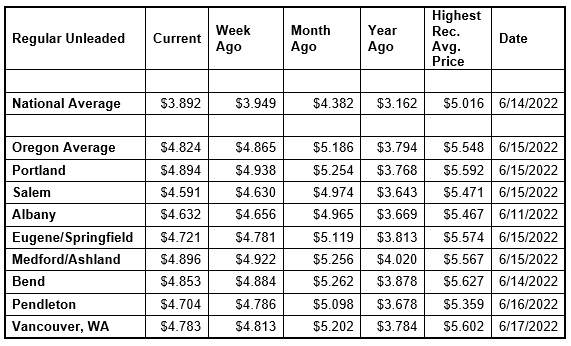
The national average reached its record high of $5.016 on June 14 while the Oregon average reached its record high of $5.548 on June 15. Both averages have been steadily declining since then. The major drivers of lower pump prices have been falling crude oil prices and a few weeks of seasonally low demand for gas.
“Demand for gas in the U.S. has been ticking up after a few weeks of seasonally low demand for gas that were likely due to the record high pump prices we saw this spring. Increasing demand and hurricane season have the potential to send pump prices higher,” says Marie Dodds, public affairs director for AAA Oregon/Idaho. “Any storms that disrupt oil production in the Gulf of Mexico and impact large coastal refineries can impact fuel prices.”
A recent survey from AAA showed that Americans have changed their driving habits to cope with high gas prices. Almost two-thirds (64%) of U.S. adults have changed their driving habits or lifestyle since March, with 23% making “major changes.” Drivers’ top three changes to offset high gas prices are driving less, combining errands, and reducing shopping or dining out. Other changes include delaying major purchases, postponing vacations and saving less money.
Find complete results in the AAA consumer gas price survey news release.
Demand for gasoline in the U.S. rose slightly from 9.12 million b/d to 9.35 million b/d last week, which is nearly identical to this time last year. Total domestic gasoline stocks decreased by nearly 5 million bbl to 215.7 million bbl., according to the U.S. Energy Information Administration (EIA). Although gasoline demand has risen and supplies have tightened, easing oil prices have helped lower pump prices. If oil prices edge lower, drivers will likely see falling pump prices.
Crude oil prices have tumbled from recent highs due to fears of economic slowdowns elsewhere around the globe. Crude reached a recent high of $122.11 per barrel on June 8, and ranged from about $94 to $110 in July. This month, crude has ranged between about $87 and $94. Crude prices rose dramatically leading up to and in the first few months of Russia’s invasion of Ukraine. Russia is one of the world’s top oil producers and its involvement in a war causes market volatility, and sanctions imposed on Russia by the U.S. and other western nations resulted in tighter global oil supplies. Oil supplies were already tight around the world as demand for oil increased as pandemic restrictions eased. A year ago, crude was around $67 per barrel compared to $93 today.
Crude oil is the main ingredient in gasoline and diesel, so pump prices are impacted by crude prices on the global markets. On average, about 53% of what we pay for in a gallon of gasoline is for the price of crude oil, 12% is refining, 21% distribution and marketing, and 15% are taxes, according to the U.S. Energy Information Administration.
Consumers can still enjoy a tasty AAA gas price–related treat courtesy of Krispy Kreme Doughnuts. Running every Wednesday through Labor Day, Krispy Kreme will lower the price of a dozen Original Glazed donuts to the national average that AAA reports each Monday. A dozen glazed doughnuts typically cost around $12. This Wednesday’s dozen should cost $3.90, not including sales tax, and is available only in shop, drive-thru, or online pickup.
Quick stats
Oregon is one of 48 states and the District of Columbia with lower prices now than a week ago, and seven states have double-digit declines, down from 18 a week ago. Rhode Island (-11 cents) has the largest weekly drop. Indiana (-1/2 cent) has the smallest. New Mexico (+3 cents) and Oklahoma (+2 cents) are the only states with week-over-week increases.
For the first time in 83 weeks, Hawaii ($5.32) bumps California ($5.317) as the most expensive state. Both remain the only two states with an average at or above $5 a gallon, same as a week ago. This week 21 states, including Oregon, and the District of Columbia have averages at or above $4, and 29 states have averages in the $3-range.
The cheapest gas in the nation is in Arkansas ($3.40) and Mississippi ($3.42). For the 85th week in a row, no state has an average below $2 a gallon.
All 50 states and the District of Columbia have lower prices now than a month ago. The national average is 49 cents less and the Oregon average is 36 cents less than a month ago. Oregon has the 4th-smallest monthly decrease in the nation. Colorado (-77 cents) has the largest monthly drop. Hawaii (-21 cents) has the smallest.
All 50 states and the District of Columbia have higher prices now than a year ago. The national average is 73 cents more and the Oregon average is $1.03 more than a year ago. This is the 7th-largest yearly increase in the nation. Hawaii (+$1.26) has the biggest yearly increase. Colorado (+26 cents) has the smallest year-over-year increase.
West Coast
The West Coast region continues to have the most expensive pump prices in the nation with six of the seven states in the top 10. This is typical for the West Coast as this region tends to consistently have fairly tight supplies, consuming about as much gasoline as is produced. In addition, this region is located relatively far from parts of the country where oil drilling, production and refining occurs, so transportation costs are higher. And environmental programs in this region add to the cost of production, storage and distribution.
| Rank | Region | Price on 8/23/22 | ||
| 1 | Hawaii | $5.32 | ||
| 2 | California | $5.32 | ||
| 3 | Nevada | $4.91 | ||
| 4 | Alaska | $4.88 | ||
| 5 | Oregon | $4.82 | ||
| 6 | Washington | $4.77 | ||
| 7 | Idaho | $4.64 | ||
| 8 | Utah | $4.52 | ||
| 9 | Illinois | $4.24 | ||
| 10 | New York | $4.23 |
As mentioned above, Hawaii bumps California for the first time in 83 weeks as the most expensive state. California, Nevada, Alaska, Oregon, and Washington round out the top six. Arizona is 19th. Oregon is fifth for the fourth week in a row.
Like the rest of the country, all seven states in the region are seeing week-over-week declines. Arizona (-8 cents) has the largest weekly drop in the region. Hawaii (-2 cents) has the smallest weekly decline in the region.
The refinery utilization rate on the West Coast fell from 84.2% to 81.0% for the week ending August 12. The rate has ranged between about 76% and 90% in the last year.
According to EIA’s latest weekly report, total gas stocks in the region decreased from 29.19 million bbl. to 28.15 million bbl.
Oil market dynamics
Although crude prices increased at the end of last week due to EIA reporting that total domestic crude supply decreased by 7 million bbl to 425 million bbl, crude prices declined earlier in the week after U.S. housing data showed that homebuilding dropped to its lowest level in 1.5 years in July. Higher mortgage rates, alongside the rising costs of materials, played a role in decreasing the demand for new housing. Lower housing demand also pushed oil demand expectations lower. This week, crude prices have risen on news of possible production cuts by OPEC+.
At the close of Friday’s formal trading session, WTI increased by 27 cents to settle at $90.77. At the close of Monday’s formal trading session, WTI fell 54 cents to close at $90.23. Today crude is trading around $93, compared to $87 a week ago. Crude prices are about $28 more than a year ago.
Drivers can find current gas prices along their route with the free AAA Mobile app for iPhone, iPad and Android. The app can also be used to map a route, find discounts, book a hotel and access AAA roadside assistance. Learn more at AAA.com/mobile.
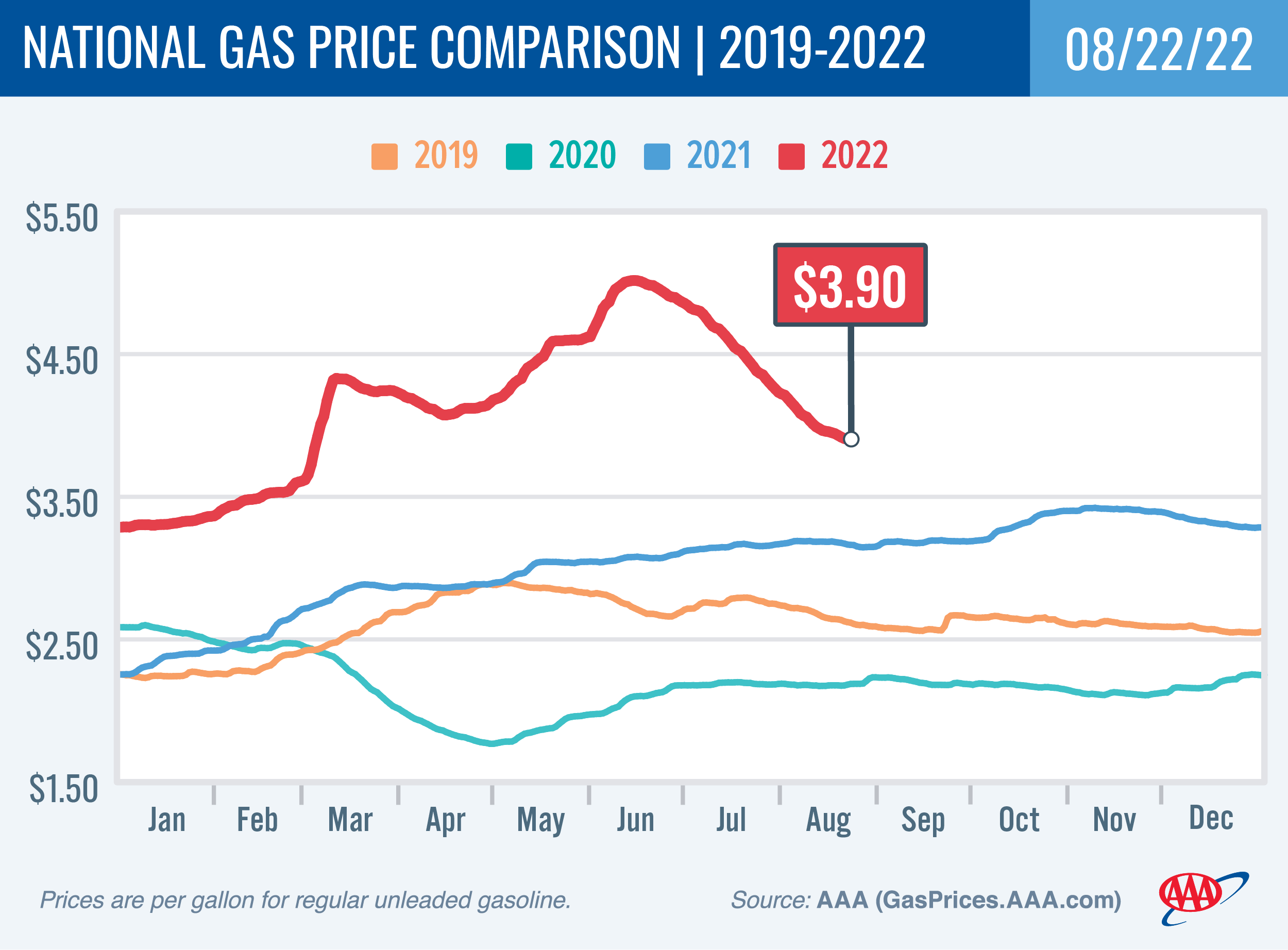
Diesel
For the week, the national average falls a nickel to $4.97 a gallon. The record high is $5.816 set on June 19. Oregon’s average also loses a nickel to $5.65. The record high is $6.47 set on July 3. A year ago the national average for diesel was $3.29 and the Oregon average was $3.71.
Find current fuel prices at GasPrices.AAA.com.
AAA news releases, high resolution images, broadcast-quality video, fact sheets and podcasts are available on the AAA NewsRoom at NewsRoom.AAA.com.
Find local news releases at https://oregon.aaa.com/community/media/media-contacts.html
Fuel prices are updated daily at AAA’s Daily Fuel Gauge at AAA Gas Prices. For more info go www.AAA.com. AAA Oregon/Idaho provides more than 850,000 members with travel, insurance, financial and automotive-related services, and is an affiliate of AAA National, serving more than 62 million motorists in North America.
Updated 8/16/2022
Ninth Consecutive Week of Falling Gas Prices
Demand rises but remains lower than a year ago
PORTLAND, Ore., – Pump prices are down in Oregon and across the country for the ninth week in a row. Crude oil prices remain below $100 per barrel and demand for gas is lower than a year ago. These factors continue to put downward pressure on pump prices. For the week, the national average for regular loses eight cents to $3.95 a gallon. The Oregon average dips four cents to $4.87.
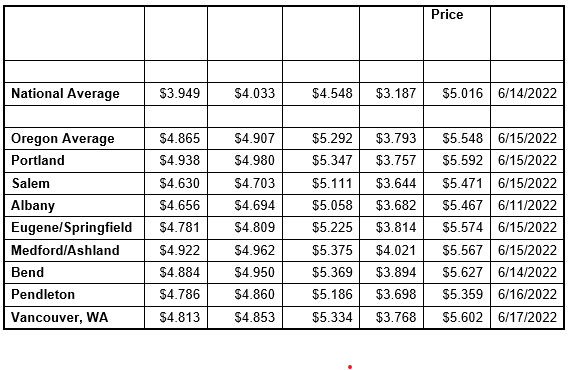
The national average reached its record high of $5.016 on June 14 while the Oregon average reached its record high of $5.548 on June 15. Both averages have been steadily declining since then. The major drivers of lower pump prices have been falling crude oil prices and a few weeks of seasonally low demand for gas.
“Falling pump prices may eventually entice drivers to hit the road but it’s not happening yet. It appears drivers are waiting for lower prices before going back to their typical driving habits,” says Marie Dodds, public affairs director for AAA Oregon/Idaho.
A recent survey from AAA showed that Americans have changed their driving habits to cope with high gas prices. Almost two-thirds (64%) of U.S. adults have changed their driving habits or lifestyle since March, with 23% making “major changes.” Drivers’ top three changes to offset high gas prices are driving less, combining errands, and reducing shopping or dining out. Other changes include delaying major purchases, postponing vacations and saving less money.
Find complete results in the AAA consumer gas price survey news release.
Demand for gasoline in the U.S. rose from 8.54 million b/d to 9.12 million b/d last week. However, the rate is 307,000 b/d lower than last year. Also, total domestic gasoline stocks decreased by 5 million bbl to 220.3 million bbl, according to the U.S. Energy Information Administration (EIA). Although gasoline demand has risen and supplies have tightened, easing oil prices have helped lower pump prices. If oil prices edge lower, drivers will likely see falling pump prices.
Crude oil prices continue to fall due to fears of economic slowdowns elsewhere around the globe. Crude reached a recent high of $122.11 per barrel on June 8, and ranged from about $94 to $110 in July. This month, crude has ranged between about $88 and $94. Crude prices rose dramatically leading up to and in the first few months of Russia’s invasion of Ukraine. Russia is one of the world’s top oil producers and its involvement in a war causes market volatility, and sanctions imposed on Russia by the U.S. and other western nations resulted in tighter global oil supplies. Oil supplies were already tight around the world as demand for oil increased as pandemic restrictions eased. A year ago, crude was around $67 per barrel compared to $87 today.
Crude oil is the main ingredient in gasoline and diesel, so pump prices are impacted by crude prices on the global markets. On average, about 53% of what we pay for in a gallon of gasoline is for the price of crude oil, 12% is refining, 21% distribution and marketing, and 15% are taxes, according to the U.S. Energy Information Administration.
Consumers can still enjoy a tasty AAA gas price–related treat courtesy of Krispy Kreme Doughnuts. Running every Wednesday through Labor Day, Krispy Kreme will lower the price of a dozen Original Glazed donuts to the national average that AAA reports each Monday. A dozen glazed doughnuts typically cost around $12. This Wednesday’s dozen should cost $3.96, not including sales tax, and is available only in shop, drive-thru, or online pickup.
Quick stats
Oregon is one of 49 states and the District of Columbia with lower prices now than a week ago, and 18 states have double-digit declines, down from 46 a week ago. Maine (-19 cents) has the largest weekly drop. Nevada (-3 cents) has the smallest. Wisconsin (+2 cents) is the only state with a week-over-week increase.
California ($5.36) is the most expensive state and is one of only two states with an average at or above $5 a gallon, same as a week ago. Hawaii ($5.35) is the only other state with an average at or above $5. This week 21 states, including Oregon, and the District of Columbia have averages at or above $4, and 29 states have averages in the $3-range.
The cheapest gas in the nation is in Texas ($3.46) and Arkansas ($3.46). For the 84th week in a row, no state has an average below $2 a gallon.
All 50 states and the District of Columbia have lower prices now than a month ago. The national average is 60 cents less and the Oregon average is 43 cents less than a month ago. Oregon has the 44th-largest monthly decrease in the nation. Kansas (-85 cents) has the largest monthly drop. Hawaii (-25 cents) has the smallest.
All 50 states and the District of Columbia have higher prices now than a year ago. The national average is 76 cents more and the Oregon average is $1.07 more than a year ago. This is the 9th-largest yearly increase in the nation. Hawaii (+$1.26) has the biggest yearly increase. Colorado (+34 cents) has the smallest year-over-year increase.
West Coast
The West Coast region continues to have the most expensive pump prices in the nation with six of the seven states in the top 10. This is typical for the West Coast as this region tends to consistently have fairly tight supplies, consuming about as much gasoline as is produced. In addition, this region is located relatively far from parts of the country where oil drilling, production and refining occurs, so transportation costs are higher. And environmental programs in this region add to the cost of production, storage and distribution.
| Rank | Region | Price on 8/16/22 | ||
| 1 | California | $5.36 | ||
| 2 | Hawaii | $5.35 | ||
| 3 | Nevada | $4.94 | ||
| 4 | Alaska | $4.92 | ||
| 5 | Oregon | $4.87 | ||
| 6 | Washington | $4.80 | ||
| 7 | Idaho | $4.70 | ||
| 8 | Utah | $4.60 | ||
| 9 | New York | $4.33 | ||
| 10 | Vermont | $4.31 |
California is the most expensive state for the 82nd week in a row with Hawaii, Nevada, Alaska, Oregon, and Washington rounding out the top six. Arizona is 21st. Oregon is fifth for the third week in a row.
Like the rest of the country, all seven states in the region are seeing week-over-week declines. Arizona (-14 cents) has the largest weekly drop in the region. Nevada (-3 cents) has the smallest weekly decline in the region and the nation.
The refinery utilization rate on the West Coast increased from 80.1% to 84.2% for the week ending August 5. The rate has ranged between about 76% and 90% in the last year.
According to EIA’s latest weekly report, total gas stocks in the region decreased from 30.19 million bbl to 29.19 million bbl.
Oil market dynamics
Although crude prices declined at the end of the week due to concerns that an economic slowdown could cause crude demand to stagnate or decline, prices rose earlier in the week after the U.S. Bureau of Labor Statistics reported a smaller than expected increase in inflation last month at 8.5 percent. The rise in market optimism helped to boost prices despite EIA reporting that total domestic crude supply increased by 5.4 million bbl. For this week, oil prices again fell below $90 on Monday and could continue to decline if demand concerns persist.
At the close of Friday’s formal trading session, WTI decreased by $2.25 to settle at $92.09. At the close of Monday’s formal trading session, WTI fell $2.68 to close at $89.41. Today crude is trading around $87, compared to $91 a week ago. Crude prices are about $20 more than a year ago.
Drivers can find current gas prices along their route with the free AAA Mobile app for iPhone, iPad and Android. The app can also be used to map a route, find discounts, book a hotel and access AAA roadside assistance. Learn more at AAA.com/mobile.
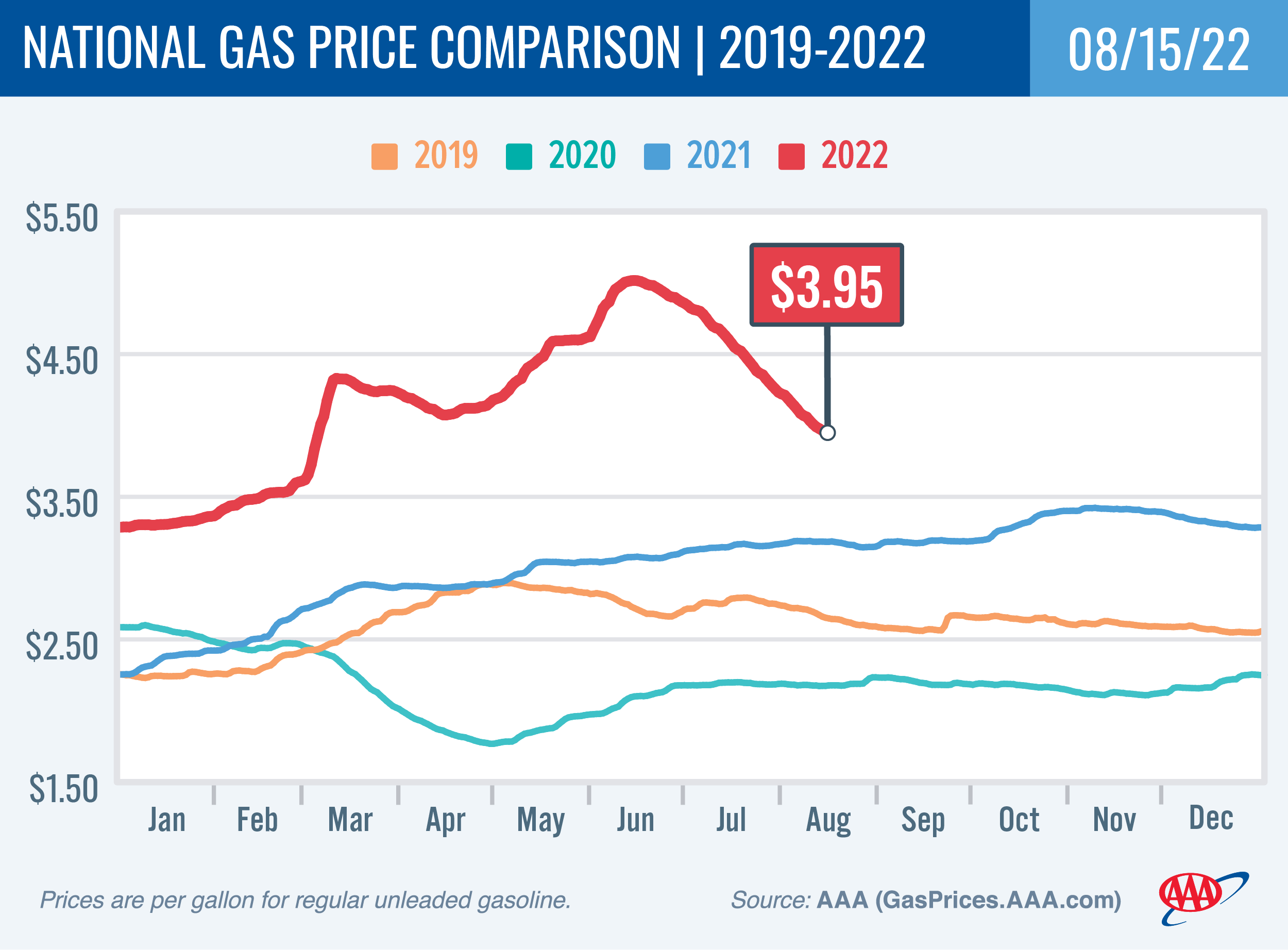
Diesel
For the week, the national average loses 10 cents to $5.02 a gallon. The record high is $5.816 set on June 19. Oregon’s average falls 12 cents to $5.71. The record high is $6.47 set on July 3. A year ago the national average for diesel was $3.30 and the Oregon average was $3.72.
Find current fuel prices at GasPrices.AAA.com.
AAA news releases, high resolution images, broadcast-quality video, fact sheets and podcasts are available on the AAA NewsRoom at NewsRoom.AAA.com.
Find local news releases at https://oregon.aaa.com/community/media/media-contacts.html
Fuel prices are updated daily at AAA’s Daily Fuel Gauge at AAA Gas Prices. For more info go www.AAA.com. AAA Oregon/Idaho provides more than 850,000 members with travel, insurance, financial and automotive-related services, and is an affiliate of AAA National, serving more than 62 million motorists in North America.
Updated 8/9/2022
Gas Prices Slide but not Enough to Lure Drivers to Fill Up
Falling crude prices and demand, rising stocks send pump prices lower
PORTLAND, Ore., – Pump prices continue to fall in the heart of the summer driving season. But the lower pump prices are not enticing drivers to fuel up. The seasonally low demand for gas along with declining crude oil prices are putting downward pressure on pump prices. For the week, the national average for regular slides 16 cents to $4.03 a gallon. The Oregon average loses 14 cents to $4.91.
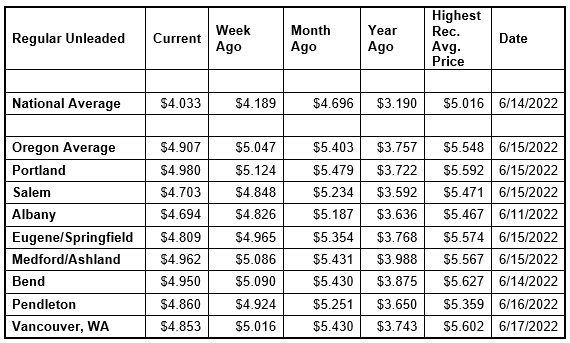
The national average reached its record high of $5.016 on June 14 while the Oregon average reached its record high of $5.548 on June 15. Both averages have been steadily declining since then. The Oregon average fell below $5 last Friday (August 5); it rose above $5 a gallon for the first time on May 16.
“For now, it appears that Americans continue to drive less due to the elevated fuel prices. Couple that with lower crude oil prices and that should lead to continued declines at the pumps. The national average is now poised to fall below $4 a gallon this week for the first time since early March,” says Marie Dodds, public affairs director for AAA Oregon/Idaho.
A recent survey from AAA showed that Americans have changed their driving habits to cope with high gas prices. Almost two-thirds (64%) of U.S. adults have changed their driving habits or lifestyle since March, with 23% making “major changes.” Drivers’ top three changes to offs high gas prices are driving less, combining errands, and reducing shopping or dining out. Other changes include delaying major purchases, postponing vacations and saving less money.
Find complete results in the AAA consumer gas price survey news release.
The national and Oregon averages for regular gas have been falling since mid-June with this week marking the eighth consecutive week of declines. The major drivers of lower pump prices have been falling crude oil prices and a few weeks of seasonally low demand for gas.
Demand for gasoline in the U.S. dropped from 9.25 million b/d to 8.54 million b/d last week. The rate is 1.24 million b/d lower than last year and is in line with the need at the end of July 2020, when COVID-19 restrictions were in place and fewer drivers hit the road. Additionally, the total domestic gasoline supply rose slightly by 200,000 bbl to 225.3 million bbl. If gas demand remains low and the supply continues to increase alongside falling oil prices, drivers will likely continue to see pump prices drop.
Crude oil prices continue to fall due to fears of economic slowdowns elsewhere around the globe. Crude reached a recent high of $122.11 per barrel on June 8, and ranged from about $94 to $110 in July. This month, crude has fallen below $90 per barrel. Crude prices rose dramatically leading up to and in the first few months of Russia’s invasion of Ukraine. Russia is one of the world’s top oil producers and its involvement in a war causes market volatility. Also, tight global supplies put upward pressure on crude prices as demand for oil increased as pandemic restrictions eased. A year ago, crude was around $66 per barrel compared to $91 today.
Crude oil is the main ingredient in gasoline and diesel, so pump prices are impacted by crude prices on the global markets. On average, about 53% of what we pay for in a gallon of gasoline is for the price of crude oil, 12% is refining, 21% distribution and marketing, and 15% are taxes, according to the U.S. Energy Information Administration.
Consumers can still enjoy a tasty AAA gas price–related treat courtesy of Krispy Kreme Doughnuts. Running every Wednesday through Labor Day, Krispy Kreme will lower the price of a dozen Original Glazed donuts to the national average that AAA reports each Monday. A dozen glazed doughnuts typically cost around $12. This Wednesday’s dozen should cost $4.06, not including sales tax, and is available only in shop, drive-thru, or online pickup.
Quick stats
All 50 states and the District of Columbia have lower prices now than a week ago, and 46 states, including Oregon, have double-digit declines. The District of Columbia (-25 cents) has the largest weekly drop. Hawaii (-2 cents) has the smallest.
California ($5.42) is the most expensive state and is one of only two states with an average at or above $5 a gallon, down from five states a week ago. Hawaii ($5.42) is the only other state with an average at or above $5. This week 26 states, including Oregon, and the District of Columbia have averages at or above $4, and 24 states have averages in the $3-range.
The cheapest gas in the nation is in Texas ($3.54) and Arkansas ($3.57). For the 83rd week in a row, no state has an average below $2 a gallon.
All 50 states and the District of Columbia have lower prices now than a month ago. The national average is 66 cents less and the Oregon average is 50 cents less than a month ago. Oregon has the 39th-largest monthly decrease in the nation. Ohio (-90 cents) has the largest monthly drop. Hawaii (-2 cents) has the smallest.
All 50 states and the District of Columbia have higher prices now than a year ago. The national average is 84 cents more and the Oregon average is $1.15 more than a year ago. This is the 9th-largest yearly increase in the nation. Hawaii (+$1.34) has the biggest yearly increase. Colorado (+50 cents) has the smallest year-over-year increase.
West Coast
The West Coast region continues to have the most expensive pump prices in the nation with six of the seven states in the top 10. This is typical for the West Coast as this region tends to consistently have fairly tight supplies, consuming about as much gasoline as is produced. In addition, this region is located relatively far from parts of the country where oil drilling, production and refining occurs, so transportation costs are higher. And environmental programs in this region add to the cost of production, storage and distribution.
| Rank | Region | Price on 8/9/22 | ||
| 1 | California | $5.42 | ||
| 2 | Hawaii | $5.42 | ||
| 3 | Alaska | $4.97 | ||
| 4 | Nevada | $4.96 | ||
| 5 | Oregon | $4.91 | ||
| 6 | Washington | $4.84 | ||
| 7 | Idaho | $4.78 | ||
| 8 | Utah | $4.71 | ||
| 9 | Maine | $4.44 | ||
| 10 | New York | $4.41 |
California is the most expensive state for the 81st week in a row with Hawaii, Alaska, Nevada, Oregon, and Washington rounding out the top six. Arizona is 18th. Oregon is fifth for the second week in a row.
Like the rest of the country, all seven states in the region are seeing week-over-week drops. Arizona (-22 cents) has the largest weekly drop in the region. Hawaii (-2 cents) has the smallest weekly decline in the region and the nation.
The refinery utilization rate on the West Coast decreased from 82.5% to 80.1% for the week ending July 29. The rate has ranged between about 76% and 90% in the last year.
According to EIA’s latest weekly report, total gas stocks in the region increased from 30.17 million bbl to 30.19 million bbl.
Oil market dynamics
Although crude prices made slight gains on Friday due to a strong U.S. jobs report for July, they saw significant declines throughout the week as a result of continuing market concern that demand will decline if economic growth stalls or reverses course. Prices have not been this low since mid-February 2022—before Russia invaded Ukraine. Additionally, EIA reported that total domestic crude supply increased by 4.5 million bbl to 426.6 million bbl. The sharp inventory increase, during the usually high-demand summer driving season, signals low demand could continue pushing prices lower. For this week, crude prices could continue to decline if demand concerns persist.
At the close of Friday’s formal trading session, WTI increased by 47 cents to settle at $89.01. At the close of Monday’s formal trading session, WTI added $1.75 to close at $90.76. Today crude is trading around $89, compared to $94 a week ago. Crude prices are about $23 more than a year ago.
Drivers can find current gas prices along their route with the free AAA Mobile app for iPhone, iPad and Android. The app can also be used to map a route, find discounts, book a hotel and access AAA roadside assistance. Learn more at AAA.com/mobile.
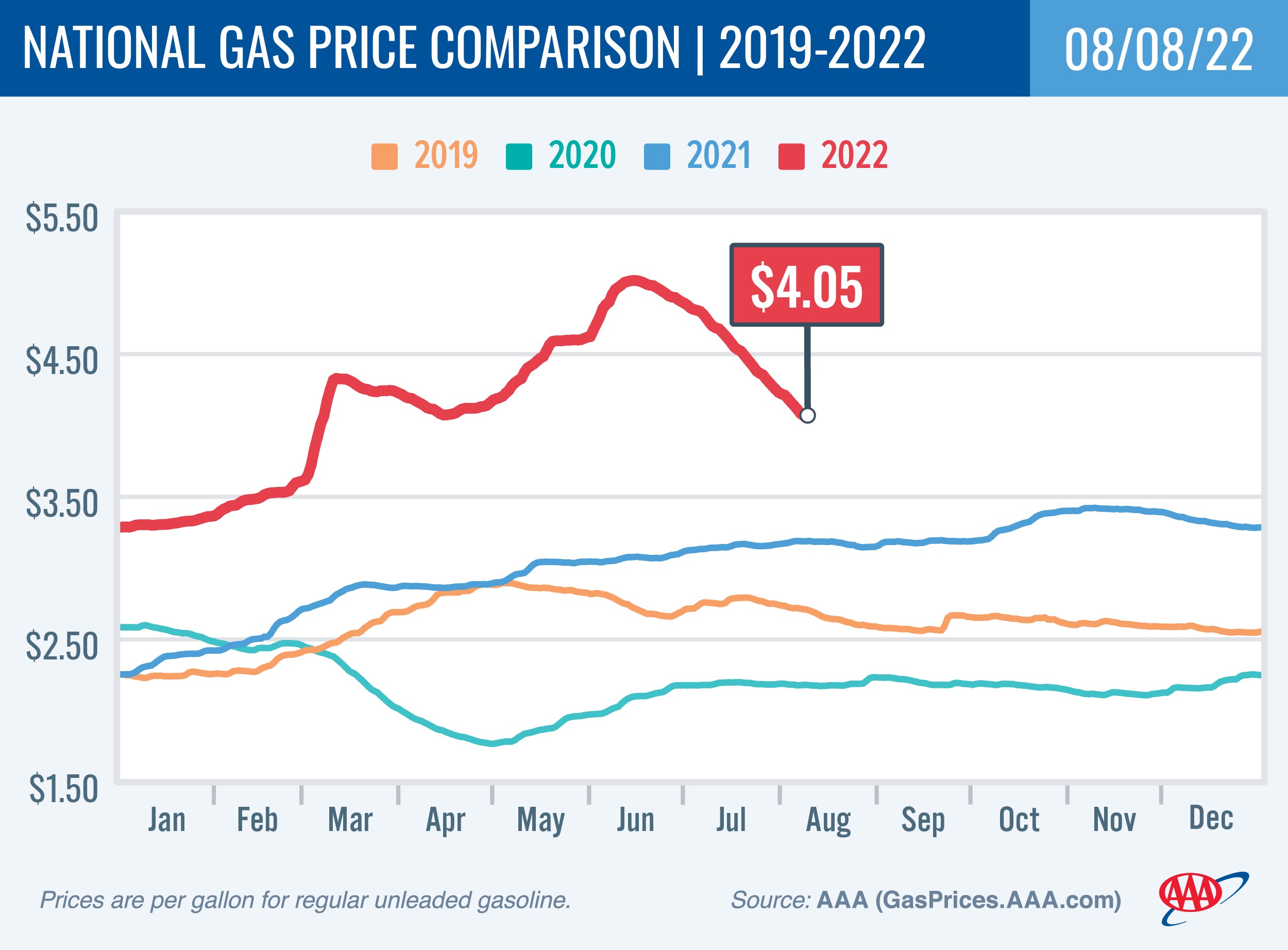
Diesel
For the week, the national average loses 14 cents to $5.12 a gallon. The record high is $5.816 set on June 19. Oregon’s average falls 17 cents to $5.83. The record high is $6.47 set on July 3. A year ago the national average for diesel was $3.30 and the Oregon average was $3.67.
Find current fuel prices at GasPrices.AAA.com.
AAA news releases, high resolution images, broadcast-quality video, fact sheets and podcasts are available on the AAA NewsRoom at NewsRoom.AAA.com.
Find local news releases at https://oregon.aaa.com/community/media/media-contacts.html
Fuel prices are updated daily at AAA’s Daily Fuel Gauge at AAA Gas Prices. For more info go www.AAA.com. AAA Oregon/Idaho provides more than 850,000 members with travel, insurance, financial and automotive-related services, and is an affiliate of AAA National, serving more than 62 million motorists in North America.
Updated 8/2/2022
Pump Prices Fall for Seventh Consecutive Week
Will rising demand put the brakes on declines?
PORTLAND, Ore., – Gas prices continue to slide with 39 states, including Oregon, seeing double-digit decreases this week. But an uptick in gas demand as more people fuel up could slow or even end the steady declines in pump prices. For the week, the national average for regular tumbles 14 cents to $4.19 a gallon. The Oregon average slides a dime to $5.05.
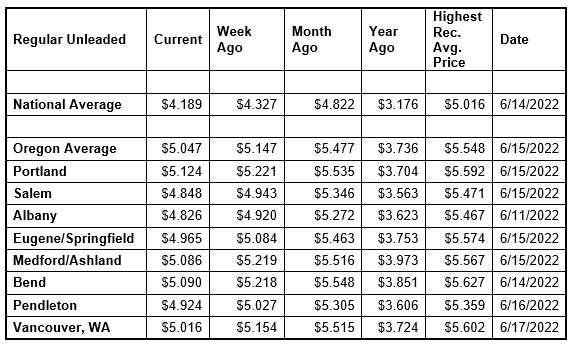
The national average reached its record high of $5.016 on June 14 while the Oregon average reached its record high of $5.548 on June 15. Both averages have been steadily declining since then.
“A recent survey from AAA showed that Americans have changed their driving habits to cope with high gas prices. Now with gas below $4 a gallon at nearly half of the gas stations around the country, increasing demand could slow or even end the daily gas price declines,” says Marie Dodds, public affairs director for AAA Oregon/Idaho.
The consumer survey from AAA shows that drivers are making significant changes to cope with high pump prices. Almost two-thirds (64%) of U.S. adults have changed their driving habits or lifestyle since March, with 23% making “major changes.” Drivers’ top three changes to offset high gas prices are driving less, combining errands, and reducing shopping or dining out. Other changes include delaying major purchases, postponing vacations and saving less money.
Find complete results in the AAA consumer gas price survey news release.
The national and Oregon averages for regular gas have been falling since mid-June with this week marking the seventh consecutive week of declines. The major drivers of lower pump prices have been falling crude oil prices and a few weeks of seasonally low demand for gas.
Demand for gasoline in the U.S. rose from 8.52 million b/d to 9.25 million b/d last week. The estimated rate is 80,000 b/d lower than last year, but it could slow pump price decreases if the trend holds. Additionally, total domestic gasoline stocks decreased by 3.3 million bbl to 225.1 million bbl, signaling that higher demand reduced inventory last week.
Crude oil reached a recent high of $122.11 per barrel on June 8, then has been between $93 and $105 per barrel since July 5. Still, crude prices remain higher than a year ago due to tight global supplies and the Russian invasion of Ukraine. Russia is one of the world’s top oil producers and its involvement in a war causes market volatility. A year ago, crude was around $71 per barrel compared to $96 today.
Crude oil is the main ingredient in gasoline and diesel, so pump prices are impacted by crude prices on the global markets. On average, about 53% of what we pay for in a gallon of gasoline is for the price of crude oil, 12% is refining, 21% distribution and marketing, and 15% are taxes, according to the U.S. Energy Information Administration.
Consumers can still enjoy a tasty AAA gas price–related treat courtesy of Krispy Kreme Doughnuts. Running every Wednesday through Labor Day, Krispy Kreme will lower the price of a dozen Original Glazed donuts to the national average that AAA reports each Monday. A dozen glazed doughnuts typically cost around $12. This Wednesday’s dozen should cost $4.21, not including sales tax, and is available only in shop, drive-thru, or online pickup.
Quick stats
All 50 states and the District of Columbia have lower prices now than a week ago, and 39 states, including Oregon, have double-digit declines. Colorado (-22 cents) has the largest weekly drop. Connecticut (-3 cents) has the smallest.
California ($5.59) is the most expensive state. There are five states, including Oregon, with averages at or above $5, down from seven states a week ago. This week 31 states and the District of Columbia have averages at or above $4, and 19 states have averages in the $3-range.
The cheapest gas in the nation is in Texas ($3.69) and South Carolina ($3.71). For the 82nd week in a row, no state has an average below $2 a gallon.
All 50 states and the District of Columbia have lower prices now than a month ago. The national average is 63 cents less and the Oregon average is 42 cents less than a month ago. Oregon has the 6th-smallest monthly decrease in the nation. Ohio (-85 cents) has the largest monthly drop. Hawaii (-17 cents) has the smallest.
All 50 states and the District of Columbia have higher prices now than a year ago, and all have a current average that’s at least 77 cents a gallon higher than a year ago. The national average is $1.01 more and the Oregon average is $1.31 more than a year ago. This is the 9th-largest yearly increase in the nation. Maine (+$1.45) has the biggest yearly increase. Georgia (+77 cents) has the smallest year-over-year increase.
West Coast
The West Coast region continues to have the most expensive pump prices in the nation with six of the seven states in the top 10. This is typical for the West Coast as this region tends to consistently have fairly tight supplies, consuming about as much gasoline as is produced. In addition, this region is located relatively far from parts of the country where oil drilling, production and refining occurs, so transportation costs are higher. And environmental programs in this region add to the cost of production, storage and distribution.
| Rank | Region | Price on 8/2/22 | ||
| 1 | California | $5.59 | ||
| 2 | Hawaii | $5.44 | ||
| 3 | Alaska | $5.08 | ||
| 4 | Nevada | $5.06 | ||
| 5 | Oregon | $5.05 | ||
| 6 | Washington | $4.99 | ||
| 7 | Idaho | $4.89 | ||
| 8 | Utah | $4.80 | ||
| 9 | Illinois | $4.60 | ||
| 10 | Maine | $4.57 |
California is the most expensive state for the 80th week in a row with Hawaii, Alaska, Nevada, Oregon, and Washington rounding out the top six. Arizona is 14th. Oregon slips to fifth after three weeks at fourth.
Like the rest of the country, all seven states in the region are seeing week-over-week drops. Arizona (-18 cents) has the largest weekly drop in the region. Hawaii (-7 cents) has the smallest weekly decline in the region.
The refinery utilization rate on the West Coast increased from 81.5% to 82.5% for the week ending July 22. The rate has ranged between about 76% and 90% in the last year.
According to EIA’s latest weekly report, total gas stocks in the region decreased from 31.49 million bbl to 30.17 million bbl.
Oil market dynamics
Crude prices increased last week as market concerns about weakening demand this summer eased after the EIA reported that total domestic crude stocks decreased by 4.5 million bbl to 422.1 million bbl last week, 13.5 million bbl lower than the storage level at the end of July 2021. Additionally, crude prices rose after the market adjusted its expectations for supply since the Organization of the Petroleum Exporting Countries (OPEC) and its allies, a group also known as OPEC+, will most likely announce its output will remain unchanged for September at its videoconference meeting on August 3. For this week, crude prices fell Monday due to continued concerns about global demand.
At the close of Friday’s formal trading session, WTI increased by $2.20 to settle at $98.62. At the close of Monday’s formal trading session, WTI fell $4.73 to close at $93.89. Today crude is trading around $96, compared to $95 a week ago. Crude prices are about $20 more than a year ago.
Drivers can find current gas prices along their route with the free AAA Mobile app for iPhone, iPad and Android. The app can also be used to map a route, find discounts, book a hotel and access AAA roadside assistance. Learn more at AAA.com/mobile.
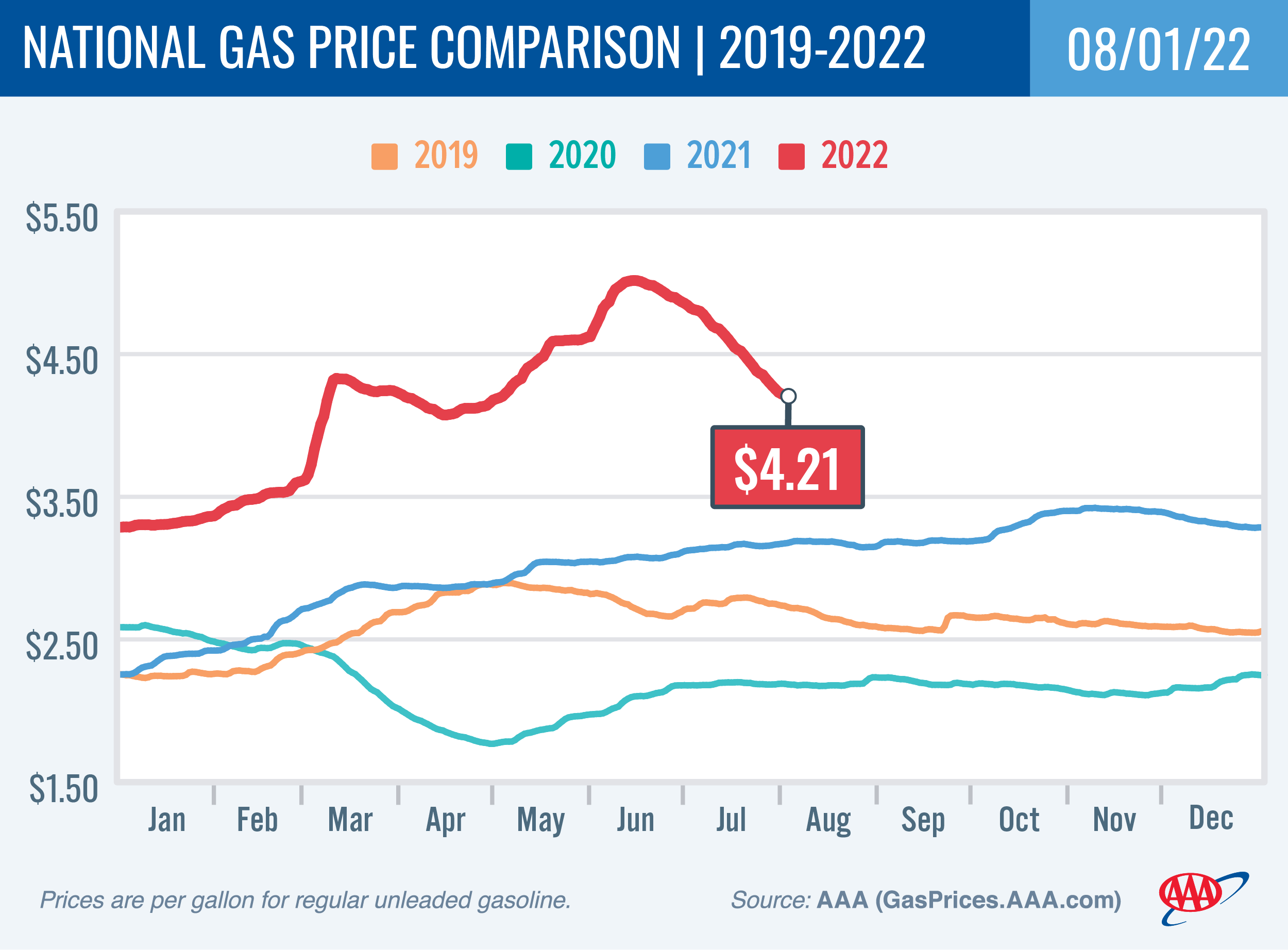
Diesel
For the week, the national average loses 13 cents to $5.26 a gallon. The record high is $5.816 set on June 19. Oregon’s average falls 17 cents to $6.00. The record high is $6.47 set on July 3. A year ago the national average for diesel was $3.29 and the Oregon average was $3.64.
Find current fuel prices at GasPrices.AAA.com.
AAA news releases, high resolution images, broadcast-quality video, fact sheets and podcasts are available on the AAA NewsRoom at NewsRoom.AAA.com.
Find local news releases at https://oregon.aaa.com/community/media/media-contacts.html
Fuel prices are updated daily at AAA’s Daily Fuel Gauge at AAA Gas Prices. For more info go www.AAA.com. AAA Oregon/Idaho provides more than 850,000 members with travel, insurance, financial and automotive-related services, and is an affiliate of AAA National, serving more than 62 million motorists in North America.
Updated 7/26/2022
Sixth Week in a Row of Falling Pump Prices
Declines driven by lower crude prices, lackluster demand
PORTLAND, Ore., – Gas prices have been steadily falling since mid-June with this week marking the sixth consecutive week of declines for the national and Oregon averages. Pump prices are down week-over-week in all 50 states due to lower crude oil prices and lackluster demand for gasoline in the U.S. For the week, the national average for regular slides 17 cents to $4.33 a gallon. The Oregon average drops 12 cents to $5.15.
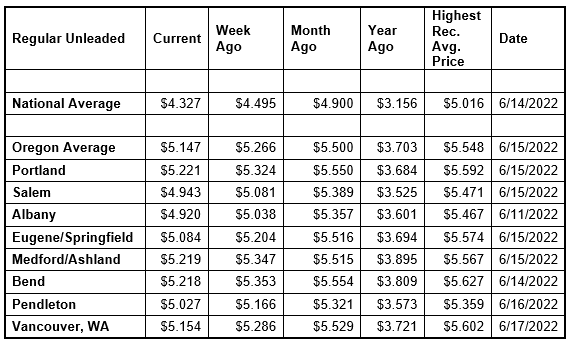
The national average reached its record high of $5.016 on June 14 while the Oregon average reached its record high of $5.548 on June 15. Both averages have been steadily declining since then.
“Consumers appear to be filling up less at a time of year when demand is usually robust. The seasonally low demand combined with crude oil prices remaining below $100 per barrel are putting downward pressure on pump prices,” says Marie Dodds, public affairs director for AAA Oregon/Idaho.
A new consumer survey from AAA shows that drivers are making significant changes to cope with high pump prices. Almost two-thirds (64%) of U.S. adults have changed their driving habits or lifestyle since March, with 23% making “major changes.” Drivers’ top three changes to offset high gas prices are driving less, combining errands, and reducing shopping or dining out. Other changes include delaying major purchases, postponing vacations and saving less money.
Find complete results in the AAA consumer gas price survey news release.
Crude oil is the main ingredient in gasoline and diesel, so pump prices are impacted by crude prices on the global markets. On average, about 53% of what we pay for in a gallon of gasoline is for the price of crude oil, 12% is refining, 21% distribution and marketing, and 15% are taxes, according to the U.S. Energy Information Administration.
Crude oil reached a recent high of $122.11 per barrel on June 8, then has been between $94 and $105 per barrel since July 5. Still, crude prices remain higher than a year ago due to tight global supplies and the Russian invasion of Ukraine. A year ago, crude was around $72 per barrel compared to $95 today.
Demand for gasoline in the U.S. rose slightly from 8.06 million b/d to 8.52 million b/d. However, that’s 800,000 b/d lower than last year and is in line with demand during the middle of July 2020, when COVID-19 restrictions curbed demand. Total domestic gas stocks increased by 3.5 million bbl to 228.4 million bbl for the week ending 15, according to the U.S. Energy Information Administration (EIA). This signals that low demand led to growth in inventory last week. If gas demand remains low as stocks increase, alongside a continuing reduction in crude prices, drivers will likely continue to see pump prices decline.
Consumers can still enjoy a tasty AAA gas price–related treat courtesy of Krispy Kreme Doughnuts. Running every Wednesday through Labor Day, Krispy Kreme will lower the price of a dozen Original Glazed donuts to the national average that AAA reports each Monday. A dozen glazed doughnuts typically cost around $12. This Wednesday’s dozen should cost $4.36, not including sales tax, and is available only in shop, drive-thru, or online pickup.
Quick stats
All 50 states and the District of Columbia have lower prices now than a week ago, and 48 states have double-digit declines. Kansas (-28 cents) has the largest weekly drop. The District of Columbia (-8 cents) has the smallest.
California ($5.71) is the most expensive state. There are seven states, including Oregon, with averages at or above $5, down from eight states a week ago. This week 39 states and the District of Columbia have averages at or above $4, and 11 states have averages in the $3-range.
The cheapest gas in the nation is in Texas ($3.83) and South Carolina ($3.84). For the 81st week in a row, no state has an average below $2 a gallon.
All 50 states and the District of Columbia have lower prices now than a month ago. The national average is 57 cents less and the Oregon average is 35 cents less than a month ago. Oregon has the 6th-smallest monthly decrease in the nation. Ohio (-76 cents) has the largest monthly drop. Hawaii (-7 cents) has the smallest.
All 50 states and the District of Columbia have higher prices now than a year ago, and all have a current average that’s at least 90 cents a gallon higher than a year ago. The national average is $1.17 more and the Oregon average is $1.44 more than a year ago. This is the 7th-largest yearly increase in the nation. Alaska (+$1.58) has the biggest yearly increase. Georgia (+90 cents) has the smallest year-over-year increase.
West Coast
The West Coast region continues to have the most expensive pump prices in the nation with all seven states in the top 10. This is typical for the West Coast as this region tends to consistently have fairly tight supplies, consuming about as much gasoline as is produced. In addition, this region is located relatively far from parts of the country where oil drilling, production and refining occurs, so transportation costs are higher. And environmental programs in this region add to the cost of production, storage and distribution.
| Rank | Region | Price on 7/26/22 | ||
| 1 | California | $5.71 | ||
| 2 | Hawaii | $5.50 | ||
| 3 | Alaska | $5.21 | ||
| 4 | Oregon | $5.15 | ||
| 5 | Nevada | $5.13 | ||
| 6 | Washington | $5.10 | ||
| 7 | Idaho | $5.00 | ||
| 8 | Utah | $4.91 | ||
| 9 | Illinois | $4.79 | ||
| 10 | Arizona | $4.65 |
California is the most expensive state for the 79th week in a row with Hawaii, Alaska, Oregon, Nevada, and Washington rounding out the top six. Arizona is 10th. Oregon is fourth for the third week in a row.
Like the rest of the country, all seven states in the region are seeing week-over-week drops. California (-19 cents) has the largest weekly drop in the region. Hawaii (-2 cents) has the smallest weekly decline in the region and nation.
The refinery utilization rate on the West Coast fell from 83.5% to 81.5% for the week ending July 15. The rate has ranged between about 76% and 90% in the last year.
According to EIA’s latest weekly report, total gas stocks in the region increased from 30.07 million bbl to 31.49 million bbl.
Oil market dynamics
Crude prices declined last week as the market continues to worry that weak demand, which was expected to remain robust throughout the summer, could continue to push prices lower. A strengthening dollar also helped to push crude prices lower last week. For this week, crude prices could continue to decline if demand concerns persist. Additionally, EIA reported that total domestic crude stocks decreased by 500,000 bbl to 426.6 million bbl, just over 13 million bbl lower than the storage level in mid-July 2021.
At the close of Friday’s formal trading session, WTI decreased by $1.65 to settle at $94.70. At the close of Monday’s formal trading session, WTI added $2.00 to close at $96.70. Today crude is trading around $97, compared to $104 a week ago. Crude prices are about $25 more than a year ago.
Drivers can find current gas prices along their route with the free AAA Mobile app for iPhone, iPad and Android. The app can also be used to map a route, find discounts, book a hotel and access AAA roadside assistance. Learn more at AAA.com/mobile.
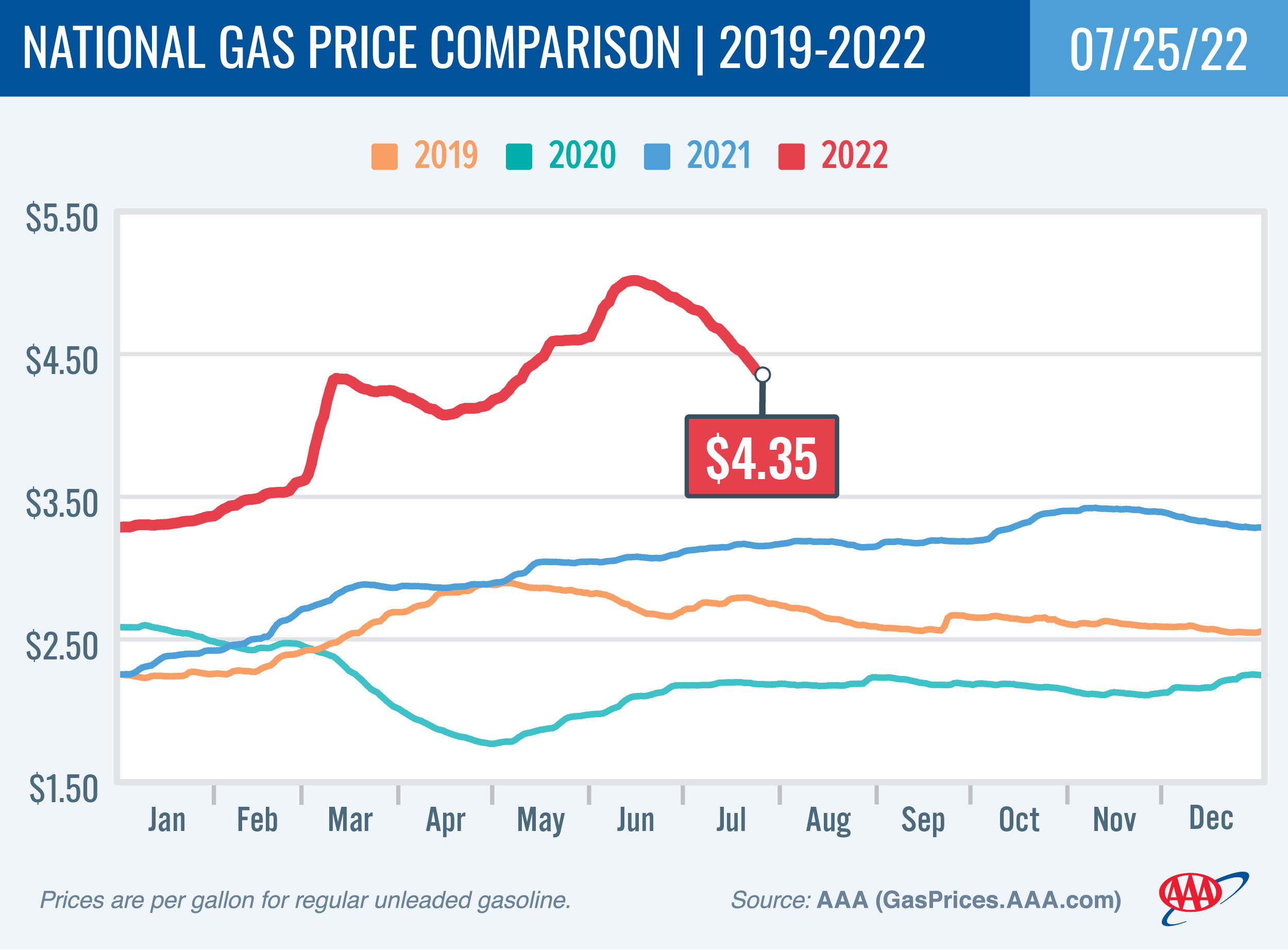
Diesel
For the week, the national average loses 13 cents to $5.39 a gallon. This is about 43 cents lower than the record high of $5.816 set on June 19. Oregon’s average falls 16 cents to $6.17. The is 30 cents below the record high of $6.47 set on July 3. A year ago the national average for diesel was $3.27 and the Oregon average was $3.61.
Find current fuel prices at GasPrices.AAA.com.
AAA news releases, high resolution images, broadcast-quality video, fact sheets and podcasts are available on the AAA NewsRoom at NewsRoom.AAA.com.
Find local news releases at https://oregon.aaa.com/community/media/media-contacts.html
Fuel prices are updated daily at AAA’s Daily Fuel Gauge at AAA Gas Prices. For more info go www.AAA.com. AAA Oregon/Idaho provides more than 850,000 members with travel, insurance, financial and automotive-related services, and is an affiliate of AAA National, serving more than 62 million motorists in North America.
Updated 7/19/2022
Fifth Consecutive Week of Falling Pump Prices
Lower Crude Prices, Shrinking Demand fuel Declines
PORTLAND, Ore., – Gas prices are down for the fifth week in a row, with declines driven by lower crude oil prices and shrinking demand for gasoline in the U.S. Pump prices are down in all 50 states and most are seeing double-digit decreases. For the week, the national average for regular drops 16 cents to $4.50 a gallon. The Oregon average falls 12 cents to $5.27.

“Lower crude oil prices are a major driver of falling pump prices. Crude oil reached a recent high of $122.11 per barrel on June 8, then fell below $100 per barrel last week,” says Marie Dodds, public affairs director for AAA Oregon/Idaho. “Another factor putting downward pressure on pump prices is lower domestic demand for gas, despite being in the heart of the summer driving season.”
Crude oil is the main ingredient in gasoline and diesel, so pump prices are impacted by crude prices on the global markets. On average, about 53% of what we pay for in a gallon of gasoline is for the price of crude oil, 12% is refining, 21% distribution and marketing, and 15% are taxes, according to the U.S. Energy Information Administration.
Crude prices remain higher than a year ago due to tight global supplies and the Russian invasion of Ukraine. A year ago, crude was around $66 per barrel compared to $98 today.
Demand for gasoline in the U.S. tumbled from 9.41 million b/d to 8.06 million b/d. Total domestic gas stocks increased by 5.8 million bbl. for the week ending July 8, according to the U.S. Energy Information Administration (EIA). The decrease in demand and declining oil prices have helped push pump prices down. If these supply and demand dynamics hold, drivers will likely continue to see price relief at the pump.
The EIA also reports that based on weekly estimates in its Weekly Petroleum Status Report, less gasoline has been consumed in the U.S. during the second quarter of 2022 and early July than during the same period in 2021. The latest Petroleum Supply Monthly confirms the trend, which shows that U.S. gasoline consumption (measured as product supplied) averaged 8.8 million b/d this April, or 0.4% less than during April 2021.
Consumers can still enjoy a tasty AAA gas price–related treat courtesy of Krispy Kreme Doughnuts. Running every Wednesday through Labor Day, Krispy Kreme will lower the price of a dozen Original Glazed donuts to the national average that AAA reports each Monday. A dozen glazed doughnuts typically cost around $12. This Wednesday’s dozen should cost $4.68, not including sales tax, and is available only in shop, drive-thru, or online pickup.
Quick stats
All 50 states and the District of Columbia have lower prices now than a week ago, and 45 states and D.C. have double-digit declines. Ohio (-21 cents) has the largest weekly drop. Hawaii (-2 cents) has the smallest.
California ($5.87) is the most expensive state but this week the California average has dropped below $6 a gallon for the first time since May 17. California is the only state to ever have an average above $6 a gallon. There are eight states, including Oregon, with averages at or above $5, down from nine states a week ago. This week one state, South Carolina ($3.99) has an average below $4 a gallon.
The cheapest gas in the nation is in South Carolina ($3.99) and Texas ($4.00). For the 80th week in a row, no state has an average below $2 a gallon.
Oregon is one of 49 states and the District of Columbia with lower prices now than a month ago. The national average is 49 cents less and the Oregon average is 28 cents less than a month ago. Oregon has the 7th-smallest monthly decrease in the nation. Texas (-65 cents) has the largest monthly drop. Idaho (-6 cents) has the smallest month-over-month decline. Hawaii (+4 cents) is the only state with a monthly increase.
All 50 states and the District of Columbia have higher prices now than a year ago, and all have a current average that’s at least $1.04 a gallon higher than a year ago. The national average is $1.33 more and the Oregon average is $1.57 more than a year ago. This is the 6th-largest yearly increase in the nation. Alaska (+$1.68) has the biggest yearly increase. Georgia (+$1.04) has the smallest year-over-year increase.
West Coast
The West Coast region continues to have the most expensive pump prices in the nation with all seven states in the top 10. This is typical for the West Coast as this region tends to consistently have fairly tight supplies, consuming about as much gasoline as is produced. In addition, this region is located relatively far from parts of the country where oil drilling, production and refining occurs, so transportation costs are higher. And environmental programs in this region add to the cost of production, storage and distribution.
| Rank | Region | Price on 7/19/22 | ||
| 1 | California | $5.87 | ||
| 2 | Hawaii | $5.60 | ||
| 3 | Alaska | $5.32 | ||
| 4 | Oregon | $5.27 | ||
| 5 | Nevada | $5.24 | ||
| 6 | Washington | $5.22 | ||
| 7 | Idaho | $5.11 | ||
| 8 | Utah | $5.04 | ||
| 9 | Illinois | $4.98 | ||
| 10 | Arizona | $4.81 |
California is the most expensive state for the 78th week in a row with Hawaii, Alaska, Oregon, Nevada, and Washington rounding out the top six. Arizona is 10th. Oregon is fourth for the second week in a row.
Like the rest of the country, all seven states in the region are seeing week-over-week drops. California (-19 cents) has the largest weekly drop in the region. Hawaii (-2 cents) has the smallest weekly decline in the region and nation.
The refinery utilization rate on the West Coast rose from 81.9% to 83.5% for the week ending July 8. The rate has ranged between about 76% and 90% in the last year.
According to EIA’s latest weekly report, total gas stocks in the region are basically flat, going from 30.08 million bbl to 30.07 million bbl.
Oil market dynamics
Crude prices increased slightly at the end of last week due to the market expecting crude supply to remain tight throughout summer. Tightening of supply is being driven by the potential for slower economic growth due to rising interest rates and inflation. Declining crude demand, due to reduced economic activity, could lead prices to follow suit. For this week, crude prices could rise if the market continues to believe supply will remain tight. Additionally, EIA reported that total domestic crude stocks increased by 3.3 million bbl to 427.1 million bbl last week, which is nearly 11 million bbl lower than the storage level last year.
At the close of Friday’s formal trading session, WTI increased by $1.81 to settle at $97.59. At the close of Monday’s formal trading session, WTI added $5.01 to close at $102.60. Today crude is trading around $99, compared to $94 a week ago. Crude prices are about $31 more than a year ago.
Drivers can find current gas prices along their route with the free AAA Mobile app for iPhone, iPad and Android. The app can also be used to map a route, find discounts, book a hotel and access AAA roadside assistance. Learn more at AAA.com/mobile.
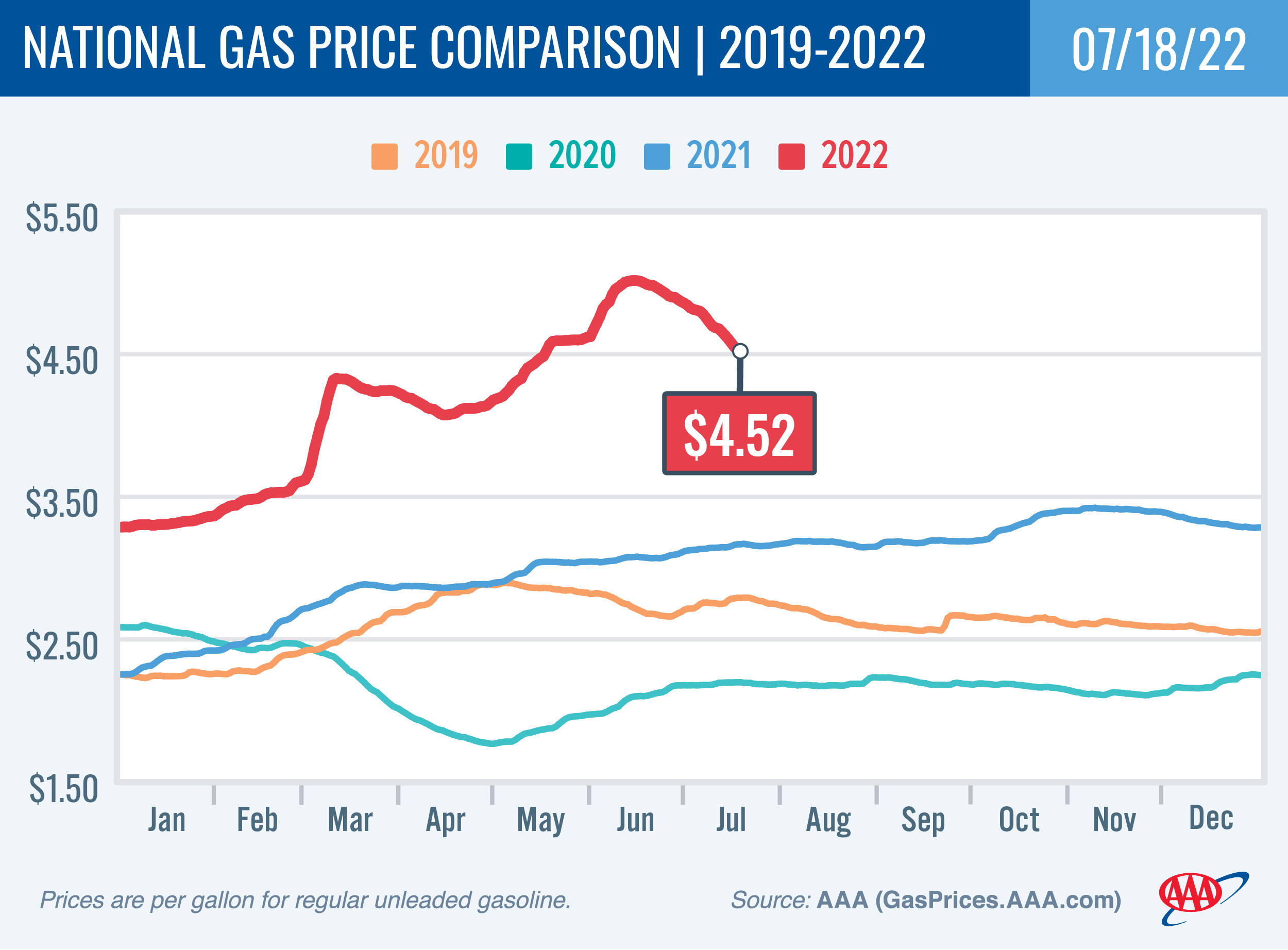
Diesel
For the week, the national average falls 11 cents to $5.52 a gallon. This is about 30 cents lower than the record high of $5.816 set on June 19. Oregon’s average decreases nine cents to $6.33. This is 14 cents below the record high of $6.47 set on July 3. A year ago the national average for diesel was $3.28 and the Oregon average was $3.58.
Find current fuel prices at GasPrices.AAA.com.
AAA news releases, high resolution images, broadcast-quality video, fact sheets and podcasts are available on the AAA NewsRoom at NewsRoom.AAA.com.
Find local news releases at https://oregon.aaa.com/community/media/media-contacts.html
Fuel prices are updated daily at AAA’s Daily Fuel Gauge at AAA Gas Prices. For more info go www.AAA.com. AAA Oregon/Idaho provides more than 850,000 members with travel, insurance, financial and automotive-related services, and is an affiliate of AAA National, serving more than 62 million motorists in North America.
Updated 7/12/2022
Pump Prices Fall for Fourth Consecutive Week
Lower Crude Oil Prices Help Bring Relief to Drivers
PORTLAND, Ore., – The global price of crude oil has fallen about 20% in the last month, putting downward pressure on gas prices. All 50 states are seeing decreases at the pumps, despite an increase in demand for gasoline. For the week, the national average for regular drops 14 cents to $4.66 a gallon. The Oregon average loses nine cents to $5.38.
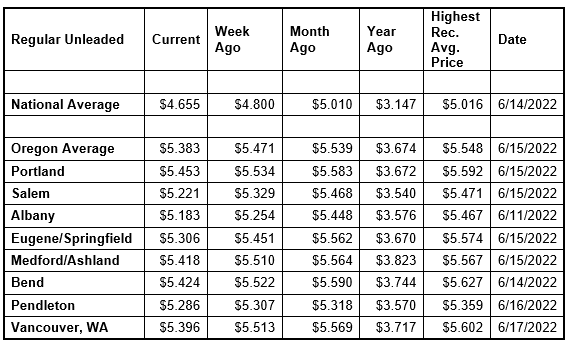
“Crude oil reached a recent high of $122.11 per barrel on June 8, and today is trading at the recent low of $97 per barrel. The drop in price is driving lower pump prices, even with a rise in demand seen ahead of the robust July 4th travel period,” says Marie Dodds, public affairs director for AAA Oregon/Idaho. AAA projected record car travel for the holiday, with 42 million Americans driving to their Independence Day destinations.
Crude oil is the main ingredient in gasoline and diesel, so pump prices are impacted by crude prices on the global markets. On average, about 53% of what we pay for in a gallon of gasoline is for the price of crude oil, 12% is refining, 21% distribution and marketing, and 15% are taxes, according to the U.S. Energy Information Administration.
Crude prices remain higher than a year ago due to tight global supplies. A year ago, crude was around $74 per barrel compared to $97 today.
Demand for gasoline in the U.S. rose ahead of the July 4th holiday from 8.92 million b/d to 9.41 million b/d. Total domestic gas stocks decreased by 2.5 million bbl. for the week ending July 1, according to the U.S. Energy Information Administration (EIA). Typically, an increase in demand and a decrease in supply would put upward pressure on pump prices; however, falling oil prices have contributed to lower pump prices.
Consumers can still enjoy a tasty AAA gas price–related treat courtesy of Krispy Kreme Doughnuts. Running every Wednesday through Labor Day, Krispy Kreme will lower the price of a dozen Original Glazed donuts to the national average that AAA reports each Monday. A dozen glazed doughnuts typically cost around $12. This Wednesday’s dozen should cost $4.68, not including sales tax, and is available only in shop, drive-thru, or online pickup.
Quick stats
All 50 states and the District of Columbia have lower prices now than a week ago. Texas (-19 cents) has the largest weekly drop. Hawaii (-1 cent) has the smallest.
California ($6.06) is the most expensive state in the nation and is the only state to ever have an average above $6 a gallon. There are nine states, including Oregon, with averages at or above $5, down from 10 states a week ago. All states have averages at or above $4 a gallon.
The cheapest gas in the nation is in Georgia ($4.16) and South Carolina ($4.16). No states have averages below $3 a gallon. For the 79th week in a row, no state has an average below $2 a gallon.
Oregon is one of 46 states and the District of Columbia with lower prices now than a month ago. The national average is 36 cents less and the Oregon average is 16 cents less than a month ago. Oregon has the 5th-smallest monthly decrease in the nation. Indiana (-52 cents) has the largest monthly drop. Utah (+16 cents) has the largest month-over-month gain.
All 50 states and the District of Columbia have higher prices now than a year ago, and all have a current average that’s at least $1.23 a gallon higher than a year ago. The national average is $1.51 more and the Oregon average is $1.71 more than a year ago. This is the 6th-largest yearly increase in the nation. Arizona (+$1.86) has the biggest yearly increase. Georgia (+$1.23) has the smallest year-over-year increase.
West Coast
The West Coast region continues to have the most expensive pump prices in the nation with all seven states in the top 10. This is typical for the West Coast as this region tends to consistently have fairly tight supplies, consuming about as much gasoline as is produced. In addition, this region is located relatively far from parts of the country where oil drilling, production and refining occurs, so transportation costs are higher. And environmental programs in this region add to the cost of production, storage and distribution.
| Rank | Region | Price on 7/12/22 | ||
| 1 | California | $6.06 | ||
| 2 | Hawaii | $5.61 | ||
| 3 | Alaska | $5.46 | ||
| 4 | Oregon | $5.38 | ||
| 5 | Nevada | $5.38 | ||
| 6 | Washington | $5.34 | ||
| 7 | Idaho | $5.20 | ||
| 8 | Utah | $5.17 | ||
| 9 | Illinois | $5.13 | ||
| 10 | Arizona | $4.99 |
California is the most expensive state for the 77th week in a row with Hawaii, Alaska, Oregon, Nevada, and Washington rounding out the top six. Arizona is 10th. Oregon rises to fourth after two weeks at fifth.
California (-18 cents) has the largest weekly drop in the region. Hawaii (-1 cent) has the smallest weekly decline in the region and nation.
The refinery utilization rate on the West Coast fell from 84.5% to 81.9% for the week ending July 1. The rate has ranged between about 76% and 90% in the last year.
According to EIA’s latest weekly report, total gas stocks in the region fell from 31.27 million bbl to 30.08 million bbl.
Oil market dynamics
Although the price of crude rose at the end of the week due to increased market optimism as markets rebounded, the price was still down nearly $4 per barrel from the previous week. For this week, crude prices continue to face strong headwinds as the market remains concerned that a potential recession will reduce demand for crude. If demand declines, crude prices will likely follow suit. Additionally, EIA reported that total domestic crude stocks increased by 8.2 million bbl to 423.8 million bbl, which is nearly 22 million bbl lower than the storage level one year ago.
At the close of Friday’s formal trading session, WTI increased by $2.06 to settle at $104.79. At the close of Monday’s formal trading session, WTI slipped 15 cents to close at $104.64. Today crude is trading around $96, compared to $100 a week ago. Crude prices are about $29 more than a year ago.
Drivers can find current gas prices along their route with the free AAA Mobile app for iPhone, iPad and Android. The app can also be used to map a route, find discounts, book a hotel and access AAA roadside assistance. Learn more at AAA.com/mobile.
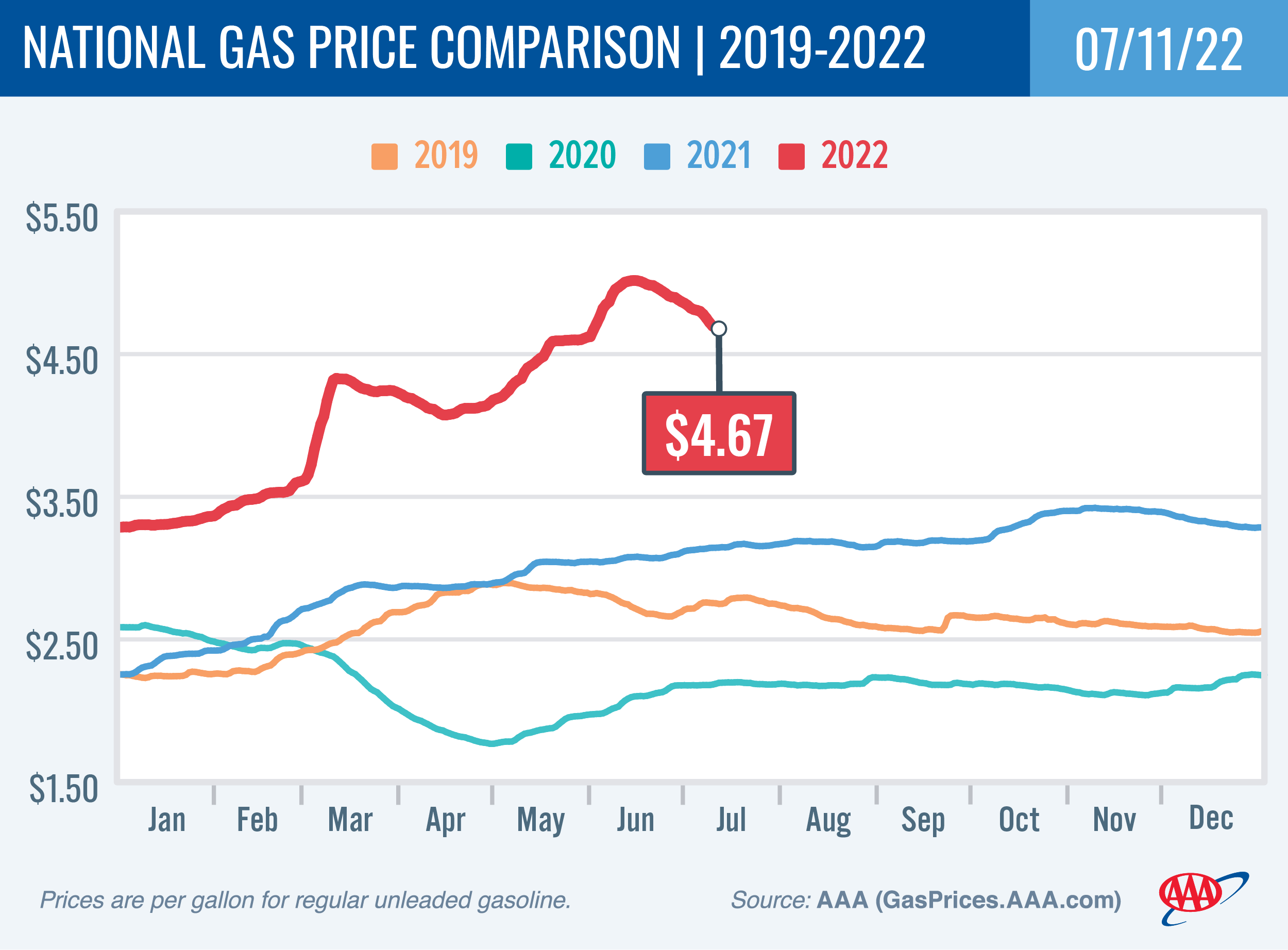
Diesel
For the week, the national average tumbles a dime to $5.63 a gallon. This is 19 cents lower than the record high of $5.816 set on June 19. Oregon’s average loses four cents to $6.42. This is a nickel below the record high of $6.47 set on July 3. A year ago the national average for diesel was $3.27 and the Oregon average was $3.55.
Find current fuel prices at GasPrices.AAA.com.
AAA news releases, high resolution images, broadcast-quality video, fact sheets and podcasts are available on the AAA NewsRoom at NewsRoom.AAA.com.
Find local news releases at https://oregon.aaa.com/community/media/media-contacts.html
Fuel prices are updated daily at AAA’s Daily Fuel Gauge at AAA Gas Prices. For more info go www.AAA.com. AAA Oregon/Idaho provides more than 850,000 members with travel, insurance, financial and automotive-related services, and is an affiliate of AAA National, serving more than 62 million motorists in North America.
Updated 6/28/2022
Gas Prices Edge Lower for Second Consecutive Week ahead of Independence Day Holiday Travel
PORTLAND, Ore., – A drop in the global price of crude oil is helping gas prices fall for the second week in a row. Concerns about a potential global economic slowdown which would lead to less demand for oil put downward pressure on crude prices, and pump prices also moved lower. For the week, the national average for regular drops nine cents to $4.88 a gallon. The Oregon average dips three cents to $5.50.
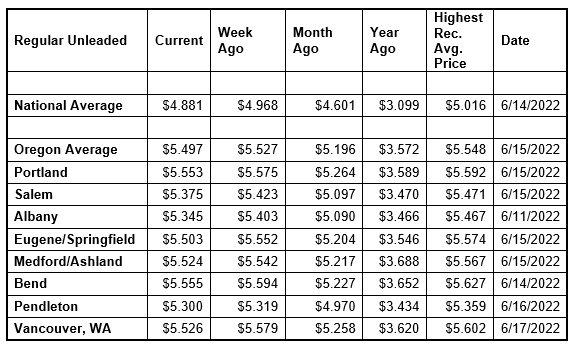
“Crude oil reached a recent high of $122.11 on June 8, then fell below $104 on June 22. The drop in price has led to slightly lower pump prices ahead of the 4th of July holiday,” says Marie Dodds, public affairs director for AAA Oregon/Idaho.
AAA projects the Independence Day holiday will see the second-highest travel volume on record, only behind 2019. Car travel will set a new record, despite elevated gas prices that are $1.50 to $2.15 a gallon higher than a year ago. Find all the details about Independence Day travel in the AAA 4th of July travel news release.

Crude oil is the main ingredient in gasoline and diesel, so pump prices are impacted by crude prices on the global markets. On average, about 53% of what we pay for in a gallon of gasoline is for the price of crude oil, 12% is refining, 21% distribution and marketing, and 15% are taxes, according to the U.S. Energy Information Administration.
Crude prices remain much higher than a year ago due to tight global supplies. A year ago, crude was around $66 per barrel compared to $110 today.
Please note that a vital gas price indicator was unavailable to AAA for this week’s report. The U.S. Energy Information Administration (EIA) said it was delaying the release of gasoline demand data because of “systems issues.” Demand is a sign of whether motorists are fueling up or not, which in turn may be reflected in higher or lower pump prices. The EIA says data will be released tomorrow (June 29). https://www.eia.gov/
On the bright side, consumers will once again enjoy a tasty AAA gas price–related treat courtesy of Krispy Kreme Doughnuts. Running every Wednesday through Labor Day, Krispy Kreme will lower the price of a dozen Original Glazed donuts to the national average that AAA reports each Monday. A dozen glazed doughnuts typically cost around $12. This Wednesday’s dozen should cost $4.90, not including sales tax, and is available only in shop, drive-thru, or online pickup.
Quick stats
Oregon is one of 46 states and the District of Columbia with lower prices now than a week ago. Florida (-15 cents) has the largest weekly drop. Idaho (+4 cents) has the largest week-over-week gain, and is one of four states with increases.
California ($6.31) is the most expensive state in the nation and is the only state to ever have an average above $6 a gallon. There are 12 states, including Oregon, and the District of Columbia with averages at or above $5, down from 15 states and D.C. a week ago. All states have averages at or above $4 a gallon.
The cheapest gas in the nation is in Georgia ($4.39) and Mississippi ($4.41). No states have averages below $3 a gallon. For the 77th week in a row, no state has an average below $2 a gallon.
All 50 states and the District of Columbia have higher prices now than a month ago. The national average is 28 cents more and the Oregon average is 32 cents more than a month ago. Oregon has the 26th-largest monthly jump in the nation. Colorado (+66 cents) has the largest monthly gain. New York (+3 cents) has the smallest.
All 50 states and the District of Columbia have higher prices now than a year ago, and four have a current average that’s at least $2 a gallon higher than a year ago. All other states have a current average that’s a $1.48 or more higher than a year ago. The national average is $1.78 more and the Oregon average is $1.93 more than a year ago. This is the 8th-largest yearly increase in the nation. Arizona (+$2.16) has the biggest yearly increase. Georgia (+$1.48) has the smallest year-over-year increase.
West Coast
The West Coast region continues to have the most expensive pump prices in the nation with all seven states in the top 10. This is typical for the West Coast as this region tends to consistently have fairly tight supplies, consuming about as much gasoline as is produced.
| Rank | Region | Price on 6/28/22 | ||
| 1 | California | $6.31 | ||
| 2 | Nevada | $5.58 | ||
| 3 | Hawaii | $5.57 | ||
| 4 | Alaska | $5.57 | ||
| 5 | Oregon | $5.50 | ||
| 6 | Washington | $5.49 | ||
| 7 | Illinois | $5.42 | ||
| 8 | Arizona | $5.28 | ||
| 9 | Idaho | $5.22 | ||
| 10 | Utah | $5.19 |
California is the most expensive state for the 75th week in a row with Nevada, Hawaii, Alaska, Oregon, and Washington rounding out the top six. Arizona is eighth. Oregon rises to fifth after two weeks at sixth.
The states in the West Coast region have small to moderate changes in gas prices this week. Arizona (-9) has the largest weekly drop in the region. Hawaii (+2 cents) is the only state in the region with a weekly increase.
Because of delays in data reporting at the EIA this week, there are no reports on the refinery utilization rate or total gas stocks.
Oil market dynamics
Although crude prices strengthened at the end of the week due to positive market sentiment after the stock market rallied, crude prices dropped earlier in the week amid broad market concern regarding the potential for economic growth to slow or stall due to rising interest rates and inflation. A lower economic growth rate than expected could cause crude demand to decline, leading prices to follow suit. For this week, crude prices have risen again to around $110 per barrel.
At the close of Friday’s formal trading session, WTI increased by $3.35 to settle at $107.62. At the close of Monday’s formal trading session, WTI added $1.95 to close at $109.57. Today crude is trading around $110, compared to $111 a week ago. Crude prices are about $37 more than a year ago.
Drivers can find current gas prices along their route with the free AAA Mobile app for iPhone, iPad and Android. The app can also be used to map a route, find discounts, book a hotel and access AAA roadside assistance. Learn more at AAA.com/mobile.
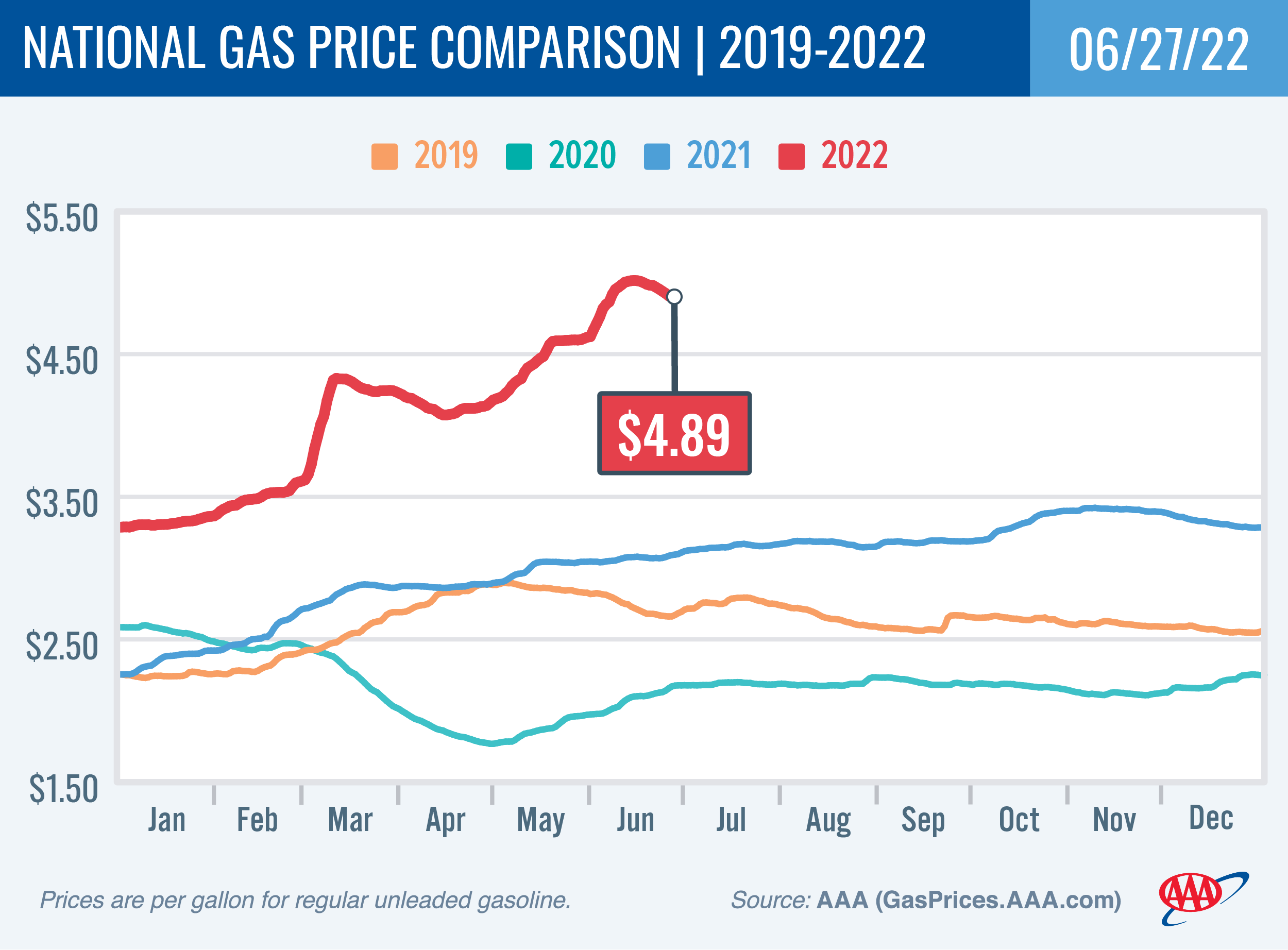
Diesel
For the week, the national average drops two cents to $5.79 a gallon. This is just below the record high of $5.816 set on June 19. Oregon’s average shoots up 15 cents to $6.47. This is a record high. A year ago the national average for diesel was $3.24 and the Oregon average was $3.49.
Find current fuel prices at GasPrices.AAA.com.
AAA news releases, high resolution images, broadcast-quality video, fact sheets and podcasts are available on the AAA NewsRoom at NewsRoom.AAA.com.
Find local news releases at https://oregon.aaa.com/community/media/media-contacts.html
Fuel prices are updated daily at AAA’s Daily Fuel Gauge at AAA Gas Prices. For more info go www.AAA.com. AAA Oregon/Idaho provides more than 850,000 members with travel, insurance, financial and automotive-related services, and is an affiliate of AAA National, serving more than 62 million motorists in North America.
Updated 6/21/2022
Gas Prices Back Away from Record Highs
National average dips below $5 a Gallon
PORTLAND, Ore., – Gas prices are stable or slipping in most states this week, including Oregon, as the cost of crude oil falls and U.S. demand for gas ticks lower. However, pump prices still remain near record highs. For the week, the national average for regular falls a nickel to $4.97 a gallon. The Oregon average slips one-and-a-half cents to $5.53.
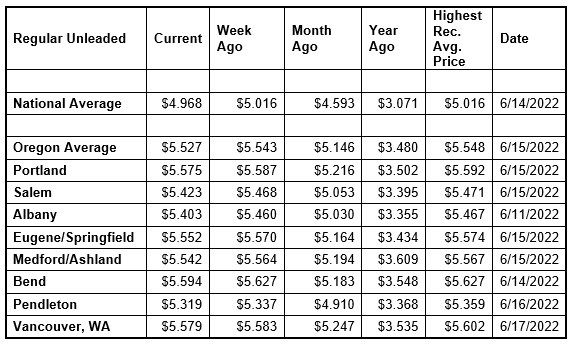
“The elevated gas prices may have led to a small drop in demand for gas in the U.S. as fewer drivers filled up their tanks last week. The dip in demand and falling crude oil prices have taken some steam out of skyrocketing pump prices,” says Marie Dodds, public affairs director for AAA Oregon/Idaho. “The slight reduction in demand is happening right before drivers fill up for what AAA forecasts will be an extremely busy 4th of July holiday weekend.”
Find all the details about Independence Day travel in the AAA 4th of July travel news release.
Crude oil prices have fallen about $10 per barrel in the last week amid broad market concern regarding the potential for economic growth to slow after the U.S. Federal Reserve last week raised the interest rate by 0.75 percent. Slower than expected economic growth could cause crude demand to decline, leading prices to follow suit. However, the decline could be temporary because on a global scale, demand for oil outpaces tight supplies as the world emerges from the COVID-19 pandemic. A year ago, crude was around $65 per barrel compared to $109 today.
Crude oil is the main ingredient in gasoline and diesel, so pump prices are impacted by crude prices on the global markets. On average, about 53% of what we pay for in a gallon of gasoline is for the price of crude oil, 12% is refining, 21% distribution and marketing, and 15% are taxes, according to the U.S. Energy Information Administration.
Demand for gasoline in the U.S. edged lower from 9.2 million b/d to 9.09 b/d. Total domestic gasoline stocks decreased by 700,000 bbl to 217.5 million bbl last week according to the U.S. Energy Information Administration (EIA).
The slight drop in gas demand has helped to limit pump price increases. However, as crude oil prices remain volatile, and with demand expected to rise during the Independence Day holiday travel period, the price per gallon for gasoline will likely remain elevated.
But on the bright side, consumers will once again enjoy a tasty AAA gas price–related treat courtesy of Krispy Kreme Doughnuts. Running every Wednesday through Labor Day, Krispy Kreme will lower the price of a dozen Original Glazed donuts to the national average that AAA reports each Monday. A dozen glazed doughnuts typically cost around $12. This Wednesday’s dozen should cost $4.98, not including sales tax, and is available only in shop, drive-thru, or online pickup.
Quick stats
Oregon is one of 41 states and the District of Columbia with lower prices now than a week ago. The District of Columbia (-13 cents) has the largest weekly drop.
California ($6.38) is the most expensive state in the nation and is the only state to ever have an average above $6 a gallon. There are 15 states, including Oregon, and the District of Columbia with averages at or above $5, down from 21 states and D.C. a week ago. All states have averages at or above $4 a gallon.
The cheapest gas in the nation is in Georgia ($4.46) and Mississippi ($4.48). No states have averages below $3 a gallon. For the 76th week in a row, no state has an average below $2 a gallon.
All 50 states and the District of Columbia have higher prices now than a month ago. The national average is 38 cents more and the Oregon average is also 38 cents more than a month ago. Oregon has the 26th-largest monthly jump in the nation. Colorado (+78 cents) has the largest monthly gain. New York (+7 cents) has the smallest.
All 50 states and the District of Columbia have higher prices now than a year ago, and 11 states, including Oregon have a current average that’s at least $2 a gallon higher than a year ago. All other states have a current average that’s a $1.50 or more higher than a year ago. The national average is $1.90 more and the Oregon average is $2.05 more than a year ago. This is the 6th-largest yearly increase in the nation. Arizona (+$2.26) has the biggest yearly increase. Georgia (+$1.57) has the smallest year-over-year increase.
West Coast
The West Coast region continues to have the most expensive pump prices in the nation with all seven states in the top 10. This is typical for the West Coast as this region tends to consistently have fairly tight supplies, consuming about as much gasoline as is produced.
| Rank | Region | Price on 6/21/22 | ||
| 1 | California | $6.38 | ||
| 2 | Nevada | $5.64 | ||
| 3 | Alaska | $5.60 | ||
| 4 | Hawaii | $5.55 | ||
| 5 | Washington | $5.54 | ||
| 6 | Oregon | $5.53 | ||
| 7 | Illinois | $5.50 | ||
| 8 | Arizona | $5.37 | ||
| 9 | Idaho | $5.19 | ||
| 10 | Utah | $5.18 |
California is the most expensive state for the 74th week in a row with Nevada, Alaska, Hawaii, Washington, and Oregon rounding out the top six. Arizona is eighth. Oregon is sixth for the second week in a row.
The states in the West Coast region have small changes in gas prices this week. California (-6) has the largest weekly drop in the region. Alaska (+2 cents) has the largest weekly increase in the region.
The refinery utilization rate on the West Coast fell from 90% to 84.8% for the week ending June 10. The rate has ranged between about 76% and 90% in the last year.
According to EIA’s latest weekly report, total gas stocks in the region ticked up from 31.37 million bbl to 31.41 million bbl.
Oil market dynamics
Crude oil prices fell last week and to start this week as concerns about slowing economic growth outweighed fears of tight global supplies. There’s broad market concern regarding the potential for economic growth to slow after the U.S. Federal Reserve raised interest rates by 0.75 percent. Slower than expected economic growth would likely lead to a decline in crude demand. Crude prices would likely follow suit. Additionally, crude prices decreased after the EIA reported that total domestic stocks increased by 1.9 million bbl to 418.7 million bbl. If EIA’s next report shows crude stocks increasing again, prices could decrease further.
At the close of Friday’s formal trading session, WTI tumbled $8.03 to settle at $109.56. U.S. markets were closed Monday for the federal holiday of Juneteenth. Today crude is trading around $109, compared to $119 a week ago. Crude prices are about $39 more than a year ago.
Drivers can find current gas prices along their route with the free AAA Mobile app for iPhone, iPad and Android. The app can also be used to map a route, find discounts, book a hotel and access AAA roadside assistance. Learn more at AAA.com/mobile.
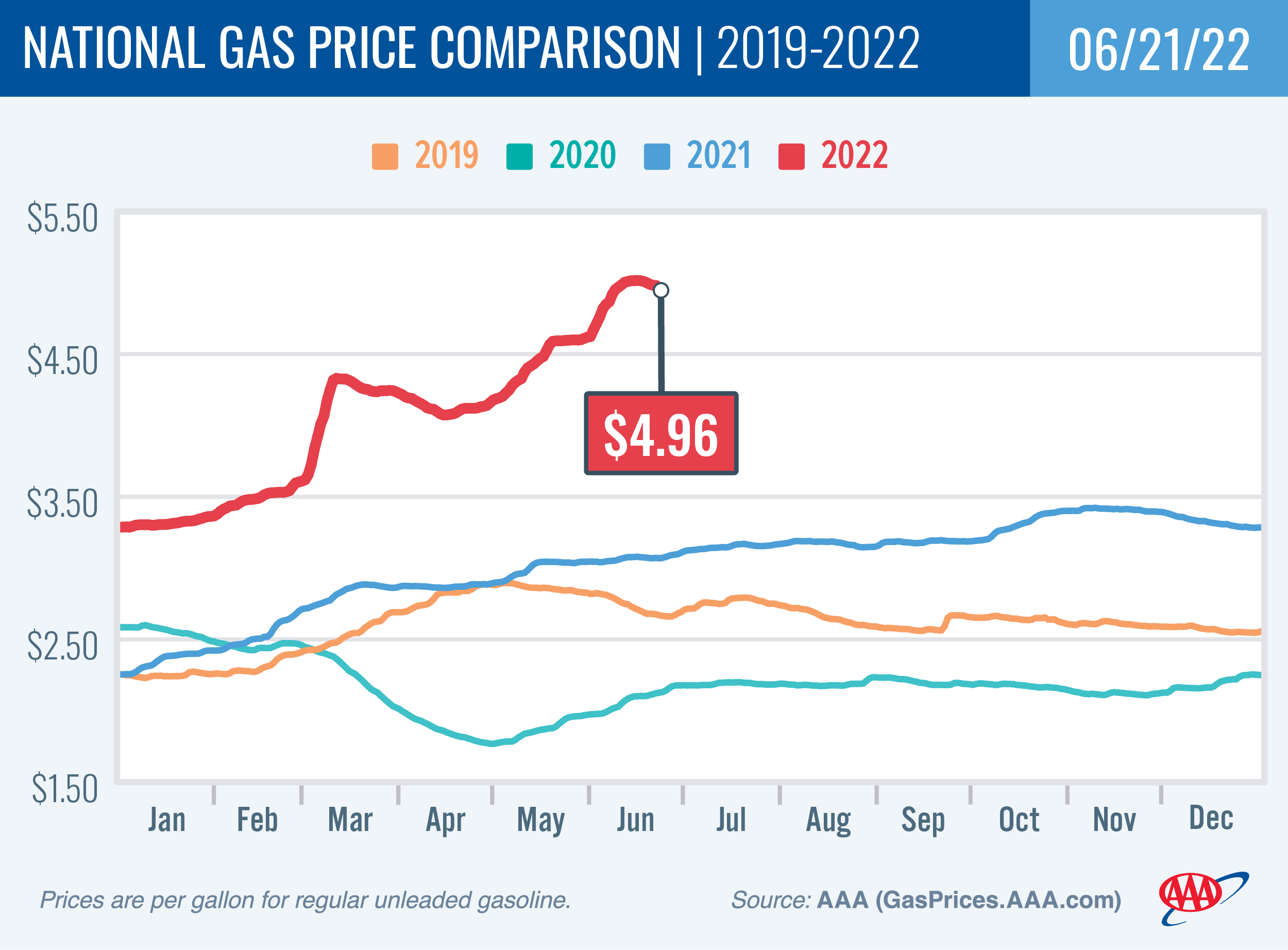
Diesel
For the week, the national average gains four cents to $5.81 a gallon. This is just below the record high of $5.816 set on June 19. Oregon’s average shoots up 15 cents to $6.32. This is a record high. A year ago the national average for diesel was $3.23 and the Oregon average was $3.42.
Find current fuel prices at GasPrices.AAA.com.
AAA news releases, high resolution images, broadcast-quality video, fact sheets and podcasts are available on the AAA NewsRoom at NewsRoom.AAA.com.
Find local news releases at https://oregon.aaa.com/community/media/media-contacts.html
Fuel prices are updated daily at AAA’s Daily Fuel Gauge at AAA Gas Prices. For more info go www.AAA.com. AAA Oregon/Idaho provides more than 850,000 members with travel, insurance, financial and automotive-related services, and is an affiliate of AAA National, serving more than 62 million motorists in North America.
Updated 6/14/2022
National Average Hits New All-Time High Above $5 a Gallon
Nearly half of all states now have averages at or above $5 a gallon
PORTLAND, Ore., – The cost of a barrel of oil remains about $120 per barrel, nearly double last August’s price, as increased demand for oil outpaces the tight global supply. Despite record high gas prices, demand for gasoline in the U.S. remains strong as the summer driving season ramps up. As a result, pump prices are up in all 50 states, and nearly half of all states have averages at or above $5 a gallon. For the week, the national average for regular jumps 10 cents to $5.02 a gallon. The Oregon average climbs eight cents to $5.54. These are both at record highs; in fact new record highs continue to be set almost daily.
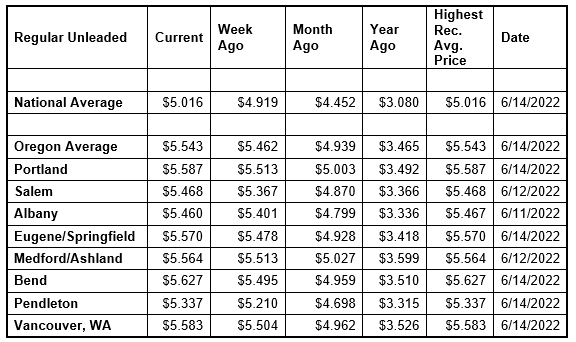
“The skyrocketing pump prices have not caused demand for gas to drop. If prices remain above $5, we may start to see demand destruction if people change their daily driving habits, but it hasn’t happened yet. People seem eager to drive and take summer vacations after staying close to home for two years during the pandemic,” says Marie Dodds, public affairs director for AAA Oregon/Idaho.
All 50 states have averages above $4 a gallon and 21 states, including Oregon, and the District of Columbia have averages above $5. California remains the only state with an average above $6. The national and Oregon averages continue to set new record highs almost daily.
Crude oil prices are climbing because demand outpaces the tight global supply. Higher crude oil prices result in higher pump prices since oil is the main ingredient in gasoline and diesel. On average, about 53% of what we pay for in a gallon of gasoline is for the price of crude oil, 12% is refining, 21% distribution and marketing, and 15% are taxes, according to the U.S. Energy Information Administration. A year ago, crude was around $64 per barrel compared to $118 today.
Demand for gasoline in the U.S. grew from 8.98 million b/d to 9.2 million b/d as drivers continue to fuel up for the summer driving season, typically a time when gas demand increases. Total domestic gasoline stocks decreased by 800,000 bbl to 218.2 million bbl last week according to the U.S. Energy Information Administration (EIA).
This dynamic between decreased supply and increased demand is contributing to rising prices at the pump. Coupled with increasing crude oil prices, this means that the price of gas will likely remain elevated for the near future.
But on the bright side, consumers will once again enjoy a tasty AAA gas price–related treat courtesy of Krispy Kreme Doughnuts. Running every Wednesday through Labor Day, Krispy Kreme will lower the price of a dozen Original Glazed donuts to the national average that AAA reports each Monday. A dozen glazed doughnuts typically cost around $12. This Wednesday’s dozen should cost $5.01, not including sales tax, and is available only in shop, drive-thru, or online pickup.
Quick stats
All 50 states and the District of Columbia have higher prices on the week, and 21 states and D.C. have double-digit increase. Montana (+23 cents) has the largest weekly increase. Wisconsin (+3 cents) has the smallest. Oregon (+8 cents) has the 31st largest increase.
California ($6.44) is the most expensive state in the nation and is the only state to ever have an average above $6 a gallon. There are 21 states, including Oregon, and the District of Columbia with averages at or above $5, up from 13 states and D.C. a week ago. All states have averages at or above $4 a gallon.
The cheapest gas in the nation is in Georgia ($4.49) and Mississippi ($4.53). No states have averages below $3 a gallon. For the 75th week in a row, no state has an average below $2 a gallon.
All 50 states and the District of Columbia have higher prices now than a month ago. The national average is 56 cents more and the Oregon average is 60 cents more than a month ago. This is the 19th-largest monthly jump in the nation. Michigan (+86 cents) has the largest monthly gain. Hawaii (+22 cents) has the smallest.
All 50 states and the District of Columbia have higher prices now than a year ago, and 16 states, including Oregon, and the District of Columbia, have a current average that’s at least $2 a gallon higher than a year ago. All other states have a current average that’s a dollar or more higher than a year ago. The national average is $1.94 more and the Oregon average is $2.08 more than a year ago. This is the 7th-largest yearly increase in the nation. Arizona (+$2.24) has the biggest yearly increase. Hawaii (+$1.58) has the smallest year-over-year increase.
West Coast
The West Coast region continues to have the most expensive pump prices in the nation with all seven states in the top 10. This is typical for the West Coast as this region tends to consistently have fairly tight supplies, consuming about as much gasoline as is produced.
| Rank | Region | Price on 6/14/22 | ||
| 1 | California | $6.44 | ||
| 2 | Nevada | $5.67 | ||
| 3 | Alaska | $5.58 | ||
| 4 | Illinois | $5.56 | ||
| 5 | Washington | $5.55 | ||
| 6 | Oregon | $5.54 | ||
| 7 | Hawaii | $5.54 | ||
| 8 | Arizona | $5.35 | ||
| 9 | District of Columbia | $5.26 | ||
| 10 | Michigan | $5.22 |
California is the most expensive state for the 73rd week in a row with Nevada, and Alaska rounding out the top three. Washington is fifth, Oregon is sixth, Hawaii is seventh, and Arizona is eighth. Oregon falls to sixth after spending one week at fourth.
Like every other state, all seven states in the West Coast region have week-over-week increases. Arizona (+19 cents) has the largest weekly increase in the region. Hawaii (+6 cents) has the region’s smallest weekly increase.
The refinery utilization rate on the West Coast climbed from 86.5% to 90% for the week ending June 3. The rate has ranged between about 76% and 90% in the last year.
According to EIA’s latest weekly report, total gas stocks in the region rose from 29.98 million bbl to 31.37 million bbl.
Oil market dynamics
Although prices ended lower on Friday due to the rising value of the dollar, crude prices increased earlier last week in response to global supply concerns amid expected demand increases, particularly as China emerges from lockdowns that reduced crude demand. Crude prices have increased despite EIA reporting that total domestic stocks increased by 2.1 million bbl to 416.8 million bbl last week. However, the current storage level is still approximately 12 percent lower than a year ago, contributing to rising crude prices. Crude prices could rise further this week if EIA’s next report shows an inventory decline.
At the close of Friday’s formal trading session, WTI decreased by 84 cents to settle at $120.67. At Monday’s formal trading session, WTI added 26 cents to close at $120.93. Today crude is trading around $122, compared to $119 a week ago. Crude prices are about $50 more than a year ago.
Drivers can find current gas prices along their route with the free AAA Mobile app for iPhone, iPad and Android. The app can also be used to map a route, find discounts, book a hotel and access AAA roadside assistance. Learn more at AAA.com/mobile.
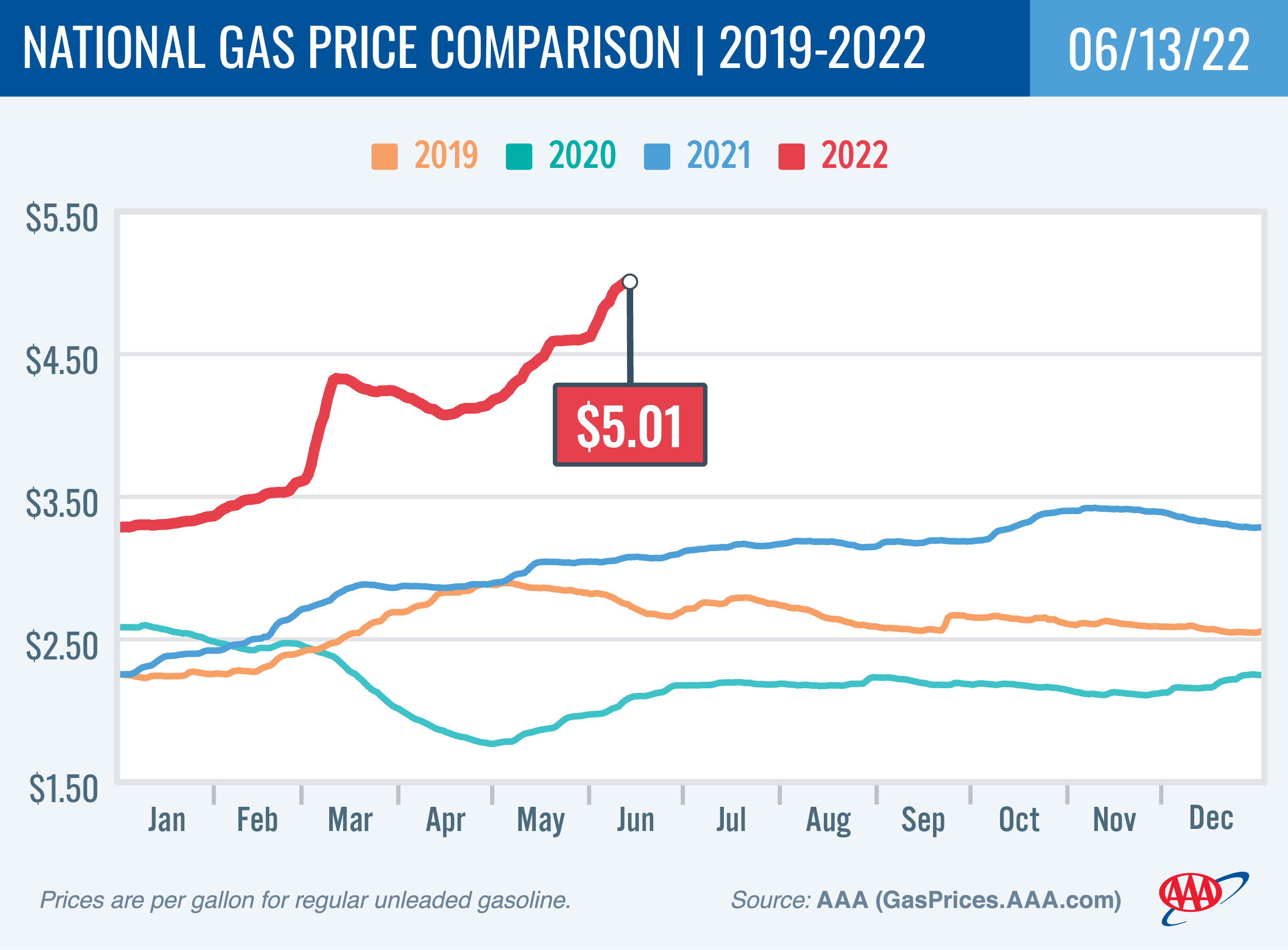
Diesel
For the week, the national average adds nine cents to $5.78 a gallon. This is a record high. Oregon’s average jumps 14 cents to $6.17. This is also a record high. A year ago the national average for diesel was $3.22 and the Oregon average was $3.40.
Find current fuel prices at GasPrices.AAA.com.
AAA news releases, high resolution images, broadcast-quality video, fact sheets and podcasts are available on the AAA NewsRoom at NewsRoom.AAA.com.
Find local news releases at https://oregon.aaa.com/community/media/media-contacts.html
Fuel prices are updated daily at AAA’s Daily Fuel Gauge at AAA Gas Prices. For more info go www.AAA.com. AAA Oregon/Idaho provides more than 850,000 members with travel, insurance, financial and automotive-related services, and is an affiliate of AAA National, serving more than 62 million motorists in North America.
Updated 6/7/2022
Rising Oil Cost, High Demand for Gas keep Pump Prices Surging
More than a quarter of all states now have averages at or above $5 a gallon
PORTLAND, Ore., – With the cost of a barrel of oil surging to near $120 per barrel, nearly double the price from last August, and robust demand for gas, pump prices continue to skyrocket. More than a quarter of all states now have averages at or above $5 a gallon, and the national average is likely to get there very soon as well. For the week, the national average for regular soars 30 cents to $4.92 gallon. The Oregon average shoots up 25 cents to $5.46. These are both at record highs; in fact new record highs continue to be set on a daily basis.
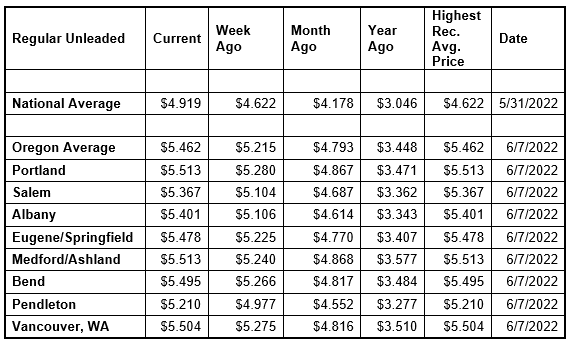
“People are still fueling up, despite these record-high prices. At some point, drivers may alter their daily driving habits but it hasn’t happened yet,” says Marie Dodds, public affairs director for AAA Oregon/Idaho.
All 50 states have averages above $4 a gallon and 13 states, including Oregon, and the District of Columbia have averages above $5. California remains the only state with an average above $6. The national and Oregon averages continue to set new record highs daily.
Crude oil prices are climbing because demand outpaces the tight global supply. Higher crude oil prices result in higher pump prices since oil is the main ingredient in gasoline and diesel. On average, about 53% of what we pay for in a gallon of gasoline is for the price of crude oil, 12% is refining, 21% distribution and marketing, and 15% are taxes, according to the U.S. Energy Information Administration. A year ago, crude was around $69 per barrel compared to $119 today.
Demand for gasoline in the U.S. rose with a busy Memorial Day holiday weekend of travel. It increased from 8.8 million b/d to 8.98 million b/d. Total domestic gasoline stocks decreased by 700,000 bbl to 219 million bbl last week according to the U.S. Energy Information Administration (EIA). These supply and demand dynamics have contributed to rising pump prices. Coupled with volatile crude oil prices, pump prices will likely remain elevated as long as demand grows and supply remains tight.
Quick stats
All 50 states and the District of Columbia have higher prices on the week, and all but two states have double-digit increase. Michigan (+56 cents) has the largest weekly increase. New York (+1 cent) has the smallest. Oregon (+25 cents) has the 37th largest increase.
California ($6.37) is the most expensive state in the nation and is the only state to ever have an average above $6 a gallon. There are 13 states, including Oregon, and the District of Columbia with averages at or above $5, up from seven states a week ago. All states have averages at or above $4 a gallon.
The cheapest gas in the nation is in Georgia ($4.33) and Arkansas ($4.45). No states have averages below $3 a gallon. For the 74th week in a row, no state has an average below $2 a gallon.
All 50 states and the District of Columbia have higher prices now than a month ago. The national average is 74 cents more and the Oregon average is 67 cents more than a month ago. This is the 11th-largest monthly jump in the nation. Indiana (+94 cents) has the largest monthly gain. Hawaii (+20 cents) has the smallest.
All 50 states and the District of Columbia have higher prices now than a year ago. 12 states, including Oregon, has a current average that’s at least $2 a gallon higher than a year ago. All other states and D.C. have a current average that’s a dollar or more higher than a year ago. The national average is $1.87 more and the Oregon average is $2.01 more than a year ago. This is the 11th-largest yearly increase in the nation. Illinois (+$2.15) has the biggest yearly increase. Georgia (+$1.42) has the smallest year-over-year increase.
West Coast
The West Coast region continues to have the most expensive pump prices in the nation with all seven states in the top 10. This is typical for the West Coast as this region tends to consistently have fairly tight supplies, consuming about as much gasoline as is produced.
| Rank | Region | Price on 6/7/22 | ||
| 1 | California | $6.37 | ||
| 2 | Nevada | $5.53 | ||
| 3 | Hawaii | $5.48 | ||
| 4 | Oregon | $5.46 | ||
| 5 | Washington | $5.46 | ||
| 6 | Illinois | $5.45 | ||
| 7 | Alaska | $5.42 | ||
| 8 | Michigan | $5.17 | ||
| 9 | Arizona | $5.16 | ||
| 10 | Indiana | $5.15 |
California is the most expensive state for the 72nd week in a row with Nevada, Hawaii, Oregon, and Washington rounding out the top five. Alaska is seventh. Arizona is ninth. Oregon rises to fourth after spending one week at fifth.
Like every other state, all seven states in the West Coast region have week-over-week increases, but they’re smaller than many other states. Oregon (+25 cents) has the largest weekly increase in the region. Hawaii (+5 cents) has the region’s smallest weekly increase.
The refinery utilization rate on the West Coast climbed from 83.0% to 86.5% for the week ending May 27. The rate has ranged between about 76% and 90% in the last year.
According to EIA’s latest weekly report, total gas stocks in the region fell from 30.47 million bbl to 29.98 million bbl.
Oil market dynamics
Crude prices rose last week after OPEC+ announced it would increase monthly production to 648,000 b/d in July and August instead of 400,000 b/d as previously planned. However, the market is still concerned that supply could remain tight as the European Union works to implement a 90 percent ban on Russian oil imports by the end of this year. Additionally, prices were boosted after EIA reported that total domestic stocks decreased by 5.1 million bbl to 414.7 million bbl. The current storage level is approximately 13.5 percent lower than a year ago, contributing to rising crude prices. For this week, crude prices could rise again if EIA’s next report shows another decrease in total domestic stocks.
At the close of Friday’s formal trading session, WTI increased $2 to settle at $118.87. At Monday’s formal trading session, WTI slipped 37 cents to close at $118.50. Today crude is trading around $118, compared to $115 a week ago. Crude prices are about $49 more than a year ago.
Drivers can find current gas prices along their route with the free AAA Mobile app for iPhone, iPad and Android. The app can also be used to map a route, find discounts, book a hotel and access AAA roadside assistance. Learn more at AAA.com/mobile.
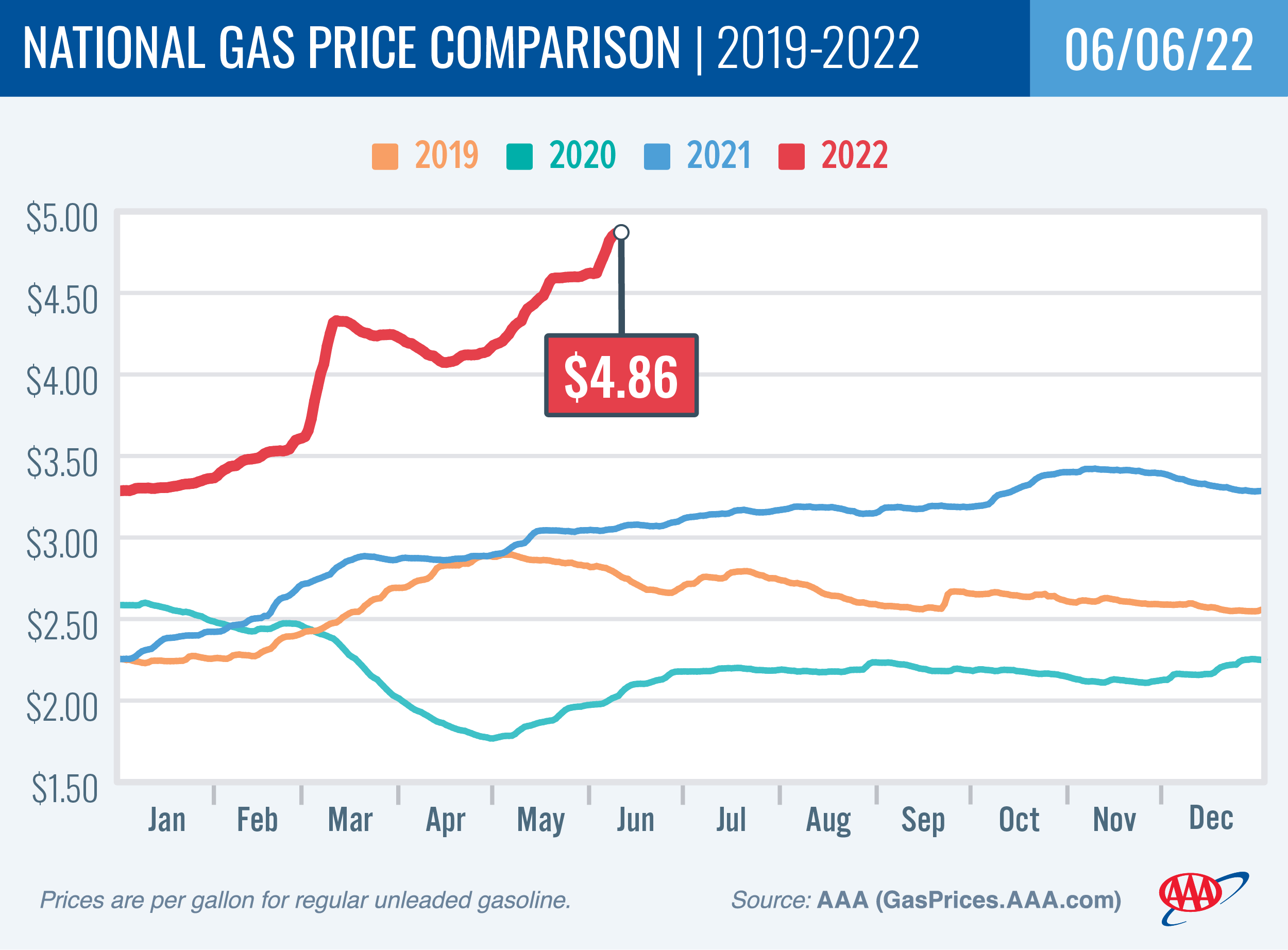
Diesel
For the week, the national average adds 16 cents to $5.68 a gallon. This is a record high. Oregon’s average surges 31 cents to $6.03. This is also a record high and the first time the Oregon average for diesel has ever been above $6. A year ago the national average for diesel was $3.19 and the Oregon average was $3.38.
Find current fuel prices at GasPrices.AAA.com.
AAA news releases, high resolution images, broadcast-quality video, fact sheets and podcasts are available on the AAA NewsRoom at NewsRoom.AAA.com.
Find local news releases at https://oregon.aaa.com/community/media/media-contacts.html
Fuel prices are updated daily at AAA’s Daily Fuel Gauge at AAA Gas Prices. For more info go www.AAA.com. AAA Oregon/Idaho provides more than 850,000 members with travel, insurance, financial and automotive-related services, and is an affiliate of AAA National, serving more than 62 million motorists in North America.
Updated 5/31/2022
Pump Prices Poised to Climb Even More as Crude Prices Rise Again
PORTLAND, Ore., – A dip in in gasoline demand provided drivers with a bit of stability at the pump, with gas prices showing smaller increases on the week. But the break could be brief. Crude oil prices have climbed above $116 per barrel due to fears of further global supply constraints caused by a European Union (EU) ban on Russian oil exports. And domestic gas demand may rise again as drivers fuel up for the summer travel season, which began this Memorial Day weekend. For the week, the national average for regular edges up two cents to $4.62 a gallon. The Oregon average adds a nickel to $5.22. These are both at record highs.
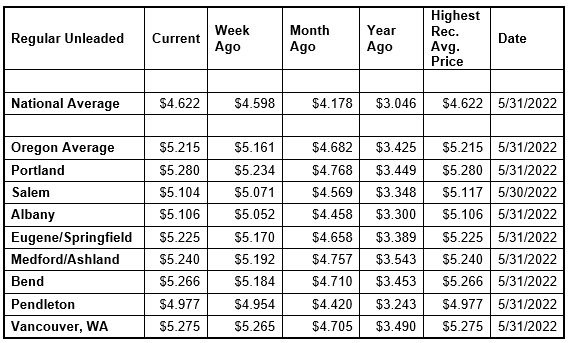
“So far, the pent-up desire to travel as we emerge from the pandemic outweighs record high pump prices for many consumers,” says Marie Dodds, public affairs director for AAA Oregon/Idaho. “However, a recent survey by AAA reveals that 67% of drivers say they would change their driving habits if gas hit $4.50 a gallon. That number rises to 75% at $5 a gallon. The Oregon average has already surpassed $5, so it remains to be seen if people will change their summer travel plans.”
All 50 states have averages above $4 a gallon and seven states, including Oregon, have averages above $5. California remains the only state with an average above $6. The national and Oregon averages continue to set new record highs almost daily, eclipsing the recent record highs set in March.
Higher crude oil prices result in higher pump prices since oil is the main ingredient in gasoline and diesel. On average, about 53% of what we pay for in a gallon of gasoline is for the price of crude oil, 12% is refining, 21% distribution and marketing, and 15% are taxes, according to the U.S. Energy Information Administration.
Crude oil prices remain elevated due to the Russian invasion of Ukraine. Russia is one of the top three oil producers in the world, behind the U.S. and Saudi Arabia, and about 25% of Europe’s oil is imported from Russia. Global supplies were already tight before the invasion and became worse with the reduction in product coming out of Russia, putting upward pressure on crude prices. A year ago, crude was around $67 per barrel compared to $116 today.
Demand for gasoline in the U.S. dipped from 9 million b/d to 8.8 million b/d, approximately 700,000 b/d lower than a year ago. Total domestic gasoline stocks also decreased by 500,000 bbl to 219.7 million bbl last week, according to the U.S. Energy Information Administration (EIA). The softening of gas demand helped minimize price increases ahead of Memorial Day. However, gas demand may spike this week after drivers took to the roads for the holiday. But pump price increases could be limited if demand slows again following the holiday weekend.
Meanwhile, the switch to the more expensive summer blend of gasoline, which usually adds seven to ten cents per gallon depending on the market, is happening now. This switchover should be complete nationwide by early June. This summer blend switch is an annual event.
Quick stats
Oregon is one of 36 states with higher prices week-over-week. Wisconsin (+11 cents) has the largest weekly increase. Texas (-3 cents) has the largest weekly decrease.
California ($6.17) is the most expensive state in the nation and is the only state to ever have an average above $6 a gallon. There are seven states, including Oregon, with averages at or above $5. Every other state and D.C. have averages at or above $4 a gallon.
The cheapest gas in the nation is in Kansas ($4.13) and Georgia ($4.14). This week no states have averages below $3 a gallon, same as a week ago. For the 73rd week in a row, no state has an average below $2 a gallon.
All 50 states and the District of Columbia have higher prices now than a month ago. The national average is 44 cents more and the Oregon average is 53 cents more than a month ago. This is the 13th-largest monthly jump in the nation. New York (+60 cents) has the largest monthly gain. Hawaii (+18 cents) has the smallest.
All 50 states and the District of Columbia have higher prices now than a year ago. Every state and D.C. have a current average that’s a dollar or more higher than a year ago. The national average is $1.58 more and the Oregon average is $1.79 more than a year ago. This is the sixth-largest yearly increase in the nation. California (+$1.96) has the biggest yearly increase. Colorado (+$1.16) has the smallest year-over-year increase.
West Coast
The West Coast region continues to have the most expensive pump prices in the nation with all seven states in the top 10. This is typical for the West Coast as this region tends to consistently have fairly tight supplies, consuming about as much gasoline as is produced.
| Rank | Region | Price on 5/31/22 | ||
| 1 | California | $6.17 | ||
| 2 | Hawaii | $5.44 | ||
| 3 | Nevada | $5.31 | ||
| 4 | Washington | $5.23 | ||
| 5 | Oregon | $5.22 | ||
| 6 | Alaska | $5.21 | ||
| 7 | Illinois | $5.00 | ||
| 8 | Arizona | $4.96 | ||
| 9 | New York | $4.93 | ||
| 10 | District of Columbia | $4.84 |
California is the most expensive state for the 71st week in a row with Hawaii, Nevada, Washington, Oregon, and Alaska rounding out the top six. Arizona is eighth. Oregon rises to fifth after spending one week at sixth.
Like most other states, all seven states in the West Coast region have week-over-week increases. California (+10 cents) has the largest weekly increase in the region. Alaska (+2 cents) has the region’s smallest weekly increase.
The refinery utilization rate on the West Coast fell from 85.4% to 83.0% for the week ending May 20. The rate has ranged between about 76% and 90% in the last year.
According to EIA’s latest weekly report, total gas stocks in the region rose from 30.05 million bbl to 30.47 million bbl.
Oil market dynamics
Crude prices rallied at the end of last week following news that the EU was seeking unanimous support of all 27 member countries to impose a ban on Russian oil later this year. Yesterday, EU leaders announced they will ban 90 percent of Russian oil imports by the end of 2022. Crude prices also increased last week after EIA reported that domestic crude supply decreased by 1 million bbl to 419.8 million bbl. The current level is approximately 13.3 percent lower than during the third week of May 2021. Crude prices could rise again this week if EIA’s next report shows total domestic supply remains tight.
At the close of Friday’s formal trading session, WTI increased 98 cents to settle at $115.07. U.S. markets were closed Monday for the Memorial Day holiday. Today crude is trading around $117, compared to $110 a week ago. Crude prices are about $48 more than a year ago.
Drivers can find current gas prices along their route with the free AAA Mobile app for iPhone, iPad and Android. The app can also be used to map a route, find discounts, book a hotel and access AAA roadside assistance. Learn more at AAA.com/mobile.
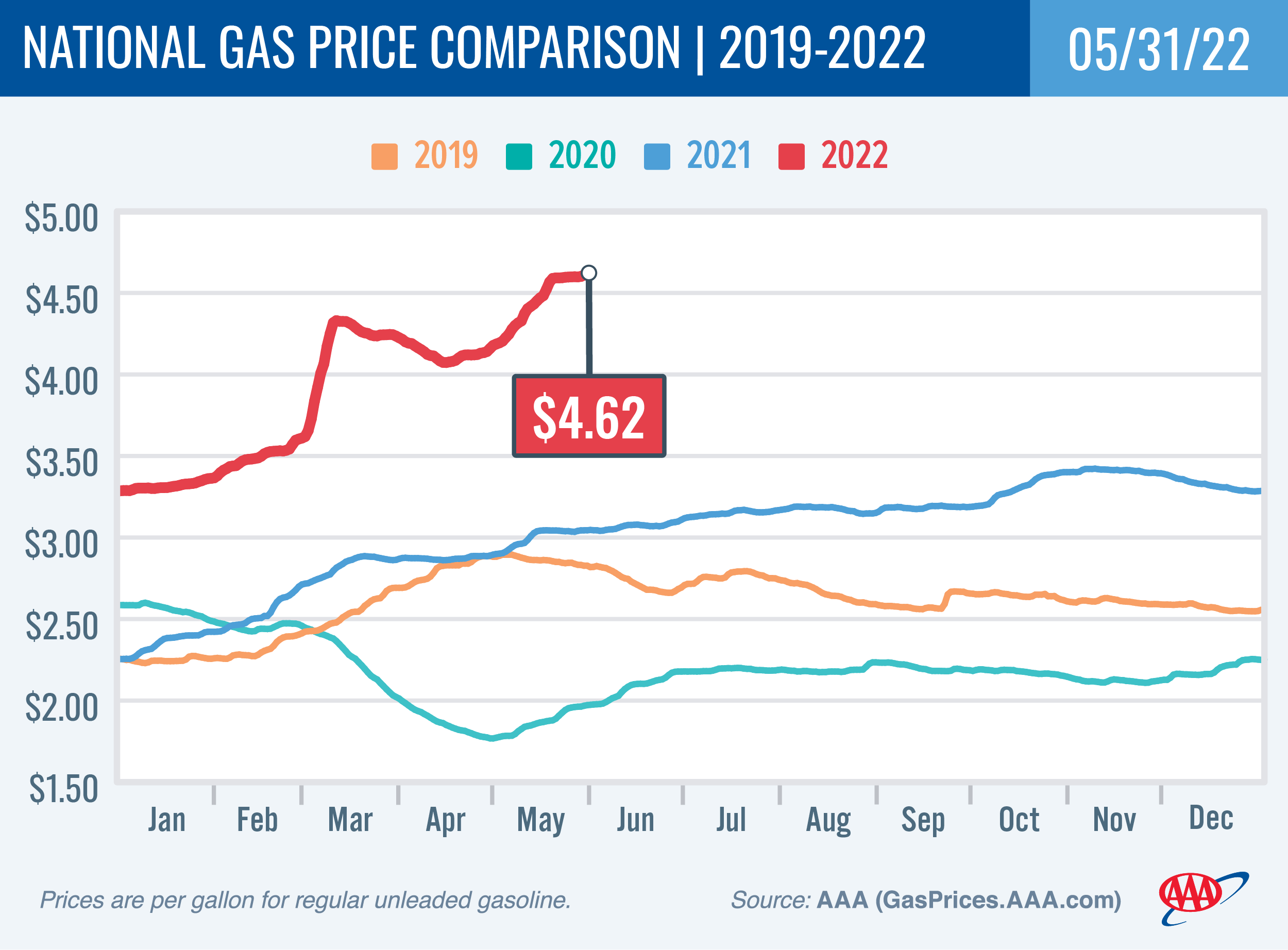
Diesel
For the week, the national average loses three cents to $5.52 a gallon. Oregon’s average rises four cents to $5.72. This is a record high. A year ago the national average for diesel was $3.19 and the Oregon average was $3.35.
Find current fuel prices at GasPrices.AAA.com.
AAA news releases, high resolution images, broadcast-quality video, fact sheets and podcasts are available on the AAA NewsRoom at NewsRoom.AAA.com.
Find local news releases at https://oregon.aaa.com/community/media/media-contacts.html
Fuel prices are updated daily at AAA’s Daily Fuel Gauge at AAA Gas Prices. For more info go www.AAA.com. AAA Oregon/Idaho provides more than 850,000 members with travel, insurance, financial and automotive-related services, and is an affiliate of AAA National, serving more than 62 million motorists in North America.
Updated 5/24/2022
Demand for Gas Increases Despite Record High Price
Skyrocketing pump prices won’t put brakes on Memorial Day Travel
PORTLAND, Ore., – Gas prices have either remained flat or risen every day in the last month, setting multiple new record highs. But demand for gasoline in the U.S. has increased to 9 million barrels a day, which is typical for this time of year. For the week, the national average for regular jumps eight cents to $4.60 a gallon. The Oregon average jumps 10 cents to $5.16.
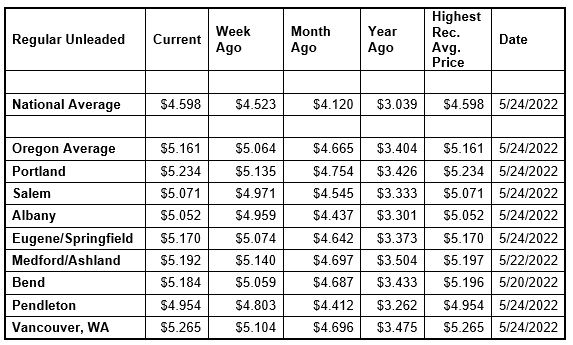
All 50 states have averages above $4 a gallon and six states, including Oregon, have averages above $5. California remains the only state with an average above $6. The national and Oregon averages continue to set new record highs almost daily, eclipsing the recent record highs set in March.
The Memorial Day holiday weekend will be a busy one, despite the soaring gas prices. AAA predicts 39.2 million people (11.8% of the population) will travel 50 miles or more from home this Memorial Day weekend. This is an increase of 8.3% over 2021, bringing travel volumes almost in line with those in 2017.
In the Pacific Region, Region (AK, CA, HI, OR, WA), 6.7 million people (12.5% of the population) are expected to travel, an 8.1% increase compared to 2021. About 530,000 Oregonians will travel over the long weekend.
While 89% of Memorial Day travelers will drive to their destinations, air travel continues to rebound, up 25% over last year, the second-largest increase since 2010. Gas prices will be the most expensive ever for the holiday.
Find all the details and graphics in the AAA Memorial Day travel news release.
“Gasoline is more than a dollar per gallon higher now than it was on February 24, when Russia invaded Ukraine. That sent shock waves through the global oil market and crude prices have remained significantly elevated ever since,” says Marie Dodds, public affairs director for AAA Oregon/Idaho. “Even with record high pump prices, demand for gas is rising as more drivers hit the road, despite the pain they’re feeling at the pumps.”
Higher crude oil prices result in higher pump prices since oil is the main ingredient in gasoline and diesel. On average, about 53% of what we pay for in a gallon of gasoline is for the price of crude oil,12% is refining, 21% distribution and marketing, and 15% are taxes, according to the U.S. Energy Information Administration.
Crude oil prices remain elevated due to the Russian invasion of Ukraine. Russia is one of the top three oil producers in the world, behind the U.S. and Saudi Arabia, and about 25% of Europe’s oil is imported from Russia. Tight global oil supplies made worse by the lack of product coming out of Russia have put upward pressure on crude prices. A year ago, crude was around $66 per barrel compared to $110 today.
Demand for gasoline in the U.S. rose from 8.7 million b/d to 9 million b/d. Total domestic gasoline stocks decreased by 4.8 million bbl to 220.2 million bbl last week, according to the U.S. Energy Information Administration (EIA). Tighter supply and increased demand have pushed pump prices higher. This supply/demand dynamic and volatile crude prices will keep upward pressure on pump prices.
Meanwhile, the switch to the more expensive summer blend of gasoline, which usually adds seven to ten cents per gallon depending on the market, is happening now. This switchover should be complete nationwide by early June. This summer blend switch is an annual event. It is unrelated to the Biden Administration’s announcement a few weeks ago to allow the higher ethanol E15 gas blend to remain on sale throughout the summer until September.
Quick stats
Pump prices are higher in all 50 states week-over-week. The District of Columbia (-1 cent) is the only area with a weekly decline. Alaska (+19 cents) has the largest weekly jump. New Mexico (+2 cents) has the smallest weekly gain.
California ($6.07) is the most expensive state in the nation and is the only state to ever have an average above $6 a gallon. There are six states, including Oregon, with averages at or above $5. Every other state and D.C. has an average at or above $4 a gallon.
The cheapest gas in the nation is in Oklahoma ($4.07) and Kansas ($4.07). This week no states have averages below $3 a gallon, same as a week ago. For the 72nd week in a row, no state has an average below $2 a gallon.
All 50 states and the District of Columbia have higher prices now than a month ago. The national average is 48 cents more and the Oregon average is 50 cents more than a month ago. This is the 24th-largest monthly jump in the nation. New York (+70 cents) has the largest monthly gain. Utah (+9 cents) has the smallest.
All 50 states and the District of Columbia have higher prices now than a year ago. Every state and D.C. have a current average that’s a dollar or more higher than a year ago. The national average is $1.56 more and the Oregon average is $1.76 more than a year ago. This is the ninth-largest yearly increase in the nation. Alaska (+$1.91) has the biggest yearly increase. Colorado (+$1.06) has the smallest year-over-year increase.
West Coast
The West Coast region continues to have the most expensive pump prices in the nation with all seven states in the top 10. This is typical for the West Coast as this region tends to consistently have fairly tight supplies, consuming about as much gasoline as is produced.
| Rank | Region | Price on 5/24/22 | ||
| 1 | California | $6.07 | ||
| 2 | Hawaii | $5.40 | ||
| 3 | Nevada | $5.25 | ||
| 4 | Washington | $5.21 | ||
| 5 | Alaska | $5.19 | ||
| 6 | Oregon | $5.16 | ||
| 7 | Illinois | $4.97 | ||
| 8 | New York | $4.93 | ||
| 9 | Arizona | $4.91 | ||
| 10 | District of Columbia | $4.85 |
California is the most expensive state for the 70th week in a row with Hawaii, Nevada, Washington, Alaska, and Oregon rounding out the top six. Arizona is ninth. Oregon slips to sixth after spending five weeks at fifth.
Like the rest of the country, all seven states have week-over-week increases. Alaska (+19 cents) has the largest weekly increase in the nation and the region. California (+5 cents) has the region’s smallest weekly increases.
The refinery utilization rate on the West Coast rose from 82.3% to 85.4% for the week ending May 13. The rate has ranged between about 76% and 90% in the last year.
According to EIA’s latest weekly report, total gas stocks in the region decreased from 30.20 million bbl to 30.05 million bbl.
Oil market dynamics
Crude prices rose last week after EIA reported that domestic crude supply decreased by 3.4 million bbl to 420.8 million bbl. The current level is approximately 13.4 percent lower than during the second week of May 2021. Additionally, market optimism for China’s efforts to end some COVID-19 restrictions by June 1 helped to bolster the market, which has continued to worry that global crude demand will decline as a result of continuing restrictions. For this week, however, crude prices may decline amid heightened economic uncertainty as the likelihood of a recession increases. A recession would likely cause crude demand to drop amid decreased economic activity and as a result crude prices would decline.
At the close of Friday’s formal trading session, WTI increased $1.02 to settle at $113.23—nearly $3 per barrel higher than the closing price at the end of the previous week. At Monday’s formal trading session, WTI added a penny to close at $110.29. Today crude is trading around $110, compared to $112 a week ago. Crude prices are about $47 more than a year ago.
Drivers can find current gas prices along their route with the free AAA Mobile app for iPhone, iPad and Android. The app can also be used to map a route, find discounts, book a hotel and access AAA roadside assistance. Learn more at AAA.com/mobile.

Diesel
For the week, the national average slips two cents to $5.55 a gallon, slightly lower than the record high of $5.577 set on May 18. Oregon’s average adds three cents to $5.68. This is a record high. A year ago the national average for diesel was $3.18 and the Oregon average was $3.32.
Find current fuel prices at GasPrices.AAA.com.
AAA news releases, high resolution images, broadcast-quality video, fact sheets and podcasts are available on the AAA NewsRoom at NewsRoom.AAA.com.
Find local news releases at https://oregon.aaa.com/community/media/media-contacts.html
Fuel prices are updated daily at AAA’s Daily Fuel Gauge at AAA Gas Prices. For more info go www.AAA.com. AAA Oregon/Idaho provides more than 850,000 members with travel, insurance, financial and automotive-related services, and is an affiliate of AAA National, serving more than 62 million motorists in North America.
Updated 5/17/2022
Oregon Average Surges Above $5 per Gallon for the First Time
PORTLAND, Ore., – Pump prices are setting new record highs again this week with the Oregon average climbing above $5 a gallon for the first time ever. The major driver is the high cost of crude oil which is above $110 per barrel. For the week, the national average for regular jumps 15 cents to $4.52 a gallon. The Oregon average soars 21 cents to $5.06.
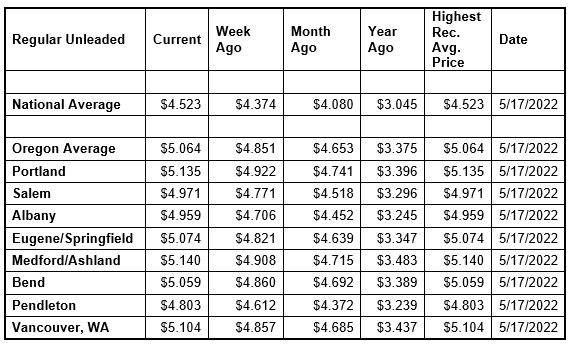
The national and Oregon averages continue to set new record highs almost daily, eclipsing the recent record highs set in March.
“The high cost of oil, the key ingredient in gasoline, is driving these high pump prices for consumers, and unfortunately, there’s no relief in sight,” says Marie Dodds, public affairs director for AAA Oregon/Idaho. “Even the annual seasonal demand dip for gasoline during the lull between spring break and Memorial Day, which would normally help lower prices, is having no effect this year.”
On average, about 53% of what we pay for in a gallon of gasoline is for the price of crude oil,12% is refining, 21% distribution and marketing, and 15% are taxes, according to the U.S. Energy Information Administration.
Crude oil prices remain elevated due to the Russian invasion of Ukraine. Russia is one of the top three oil producers in the world, behind the U.S. and Saudi Arabia, and about 25% of Europe’s oil is imported from Russia. Tight global oil supplies made worse by the lack of product coming out of Russia have put upward pressure on crude prices. A year ago, crude was around $66 per barrel compared to $112 today.
Meanwhile, the switch to the more expensive summer blend of gasoline, which usually adds seven to ten cents per gallon depending on the market, is happening now. This switchover should be complete nationwide by early June. This summer blend switch is an annual event. It is unrelated to the Biden Administration’s announcement a few weeks ago to allow the higher ethanol E15 gas blend to remain on sale throughout the summer until September.
Demand for gasoline in the U.S. decreased slightly from 8.86 million b/d to 8.7 million b/d. Total domestic gasoline stocks decreased by 3.6 million bbl to 225 million bbl last week, according to the U.S. Energy Information Administration (EIA). Typically, lower demand would put downward pressure on pump prices. However, crude prices remain volatile, and as they surge, pump prices follow suit. Pump prices will likely face upward pressure as oil prices stay above $105 per barrel.
Quick stats
Pump prices are higher in all 50 states and the District of Columbia week-over-week, and 33 states, including Oregon, and D.C. have double-digit increases. Connecticut (+24 cents) has the largest weekly jump. Colorado (+3 cents) has the smallest weekly gain.
California ($6.02) is the most expensive state in the nation and becomes the first state to ever have an average above $6 a gallon. There are five states, including Oregon, with averages at or above $5. Every other state and D.C. has an average at or above $4 a gallon.
The cheapest gas in the nation is in Kansas ($4.01) and Oklahoma ($4.01). This week no states have averages below $3 a gallon, same as a week ago. For the 71st week in a row, no state has an average below $2 a gallon.
All 50 states and the District of Columbia have higher prices now than a month ago. The national average is 44 cents more and the Oregon average is 41 cents more than a month ago. This is the 26th-largest monthly jump in the nation. Maryland (+79 cents) has the largest monthly gain. Utah (+8 cents) has the smallest.
All 50 states and the District of Columbia have higher prices now than a year ago. Every state and D.C. have a current average that’s a dollar or more higher than a year ago. The national average is $1.48 more and the Oregon average is $1.69 more than a year ago. This is the seventh-largest yearly increase in the nation. California (+$1.89) has the biggest yearly increase. Colorado (+$1.05) has the smallest year-over-year increase.
West Coast
The West Coast region continues to have the most expensive pump prices in the nation with all seven states in the top 10. This is typical for the West Coast as this region tends to consistently have fairly tight supplies, consuming about as much gasoline as is produced.
| Rank | Region | Price on 5/17/22 | ||
| 1 | California | $6.02 | ||
| 2 | Hawaii | $5.34 | ||
| 3 | Nevada | $5.20 | ||
| 4 | Washington | $5.10 | ||
| 5 | Oregon | $5.06 | ||
| 6 | Alaska | $5.00 | ||
| 7 | District of Columbia | $4.86 | ||
| 8 | Illinois | $4.84 | ||
| 9 | Arizona | $4.81 | ||
| 10 | New York | $4.81 |
California is the most expensive state for the 69th week in a row with Hawaii, Nevada, Washington, Oregon, and Alaska rounding out the top six. Arizona is ninth. Oregon is fifth for the fifth week in a row.
Like the rest of the country, all seven states have week-over-week increases. Alaska (+23 cents) has the largest weekly increase in the region. Hawaii (+4 cents) has the region’s smallest weekly increases.
The refinery utilization rate on the West Coast rose from 79.6% to 82.3% for the week ending May 6. The rate has ranged between about 76% and 90% in the last year.
According to EIA’s latest weekly report, total gas stocks in the region decreased from 30.76 million bbl to 30.20 million bbl.
Oil market dynamics
At the beginning of last week, the price of crude oil decreased due to global market concern that crude demand will suffer as COVID lockdowns in China remain in place. However, crude prices reversed course at the end of the week over growing market worries that Ukrainian and European Union actions against Russian oil and natural gas companies could spark retaliation by Russia, which would lead to more market disruption and uncertainty. Crude prices could fall this week if demand concerns continue to weigh the market down. Additionally, EIA reported that domestic crude supply increased by 8.5 million bbl to 424.2 million bbl. The current level is approximately 12.5 percent lower than during the first week of May 2021.
At the close of Friday’s formal trading session, WTI increased by $4.36 to settle at $110.49/bbl. At Monday’s formal trading session, WTI added $3.71 to close at $114.20. Today crude is trading around $112, compared to $100 a week ago. Crude prices are about $49 more than a year ago.
Drivers can find current gas prices along their route with the free AAA Mobile app for iPhone, iPad and Android. The app can also be used to map a route, find discounts, book a hotel and access AAA roadside assistance. Learn more at AAA.com/mobile.

Diesel
For the week, the national average gains two cents to $5.57 a gallon. This is a record high. Oregon’s average adds a nickel to $5.65. This is also a record high. A year ago the national average for diesel was $3.17 and the Oregon average was $3.31.
Find current fuel prices at GasPrices.AAA.com.
AAA news releases, high resolution images, broadcast-quality video, fact sheets and podcasts are available on the AAA NewsRoom at NewsRoom.AAA.com.
Find local news releases at https://oregon.aaa.com/community/media/media-contacts.html
Fuel prices are updated daily at AAA’s Daily Fuel Gauge at AAA Gas Prices. For more info go www.AAA.com. AAA Oregon/Idaho provides more than 850,000 members with travel, insurance, financial and automotive-related services, and is an affiliate of AAA National, serving more than 62 million motorists in North America.
Updated 5/10/2022
Pump Prices Surge to New Record Highs
PORTLAND, Ore., – The national and Oregon averages skyrocket to new record highs after the price of oil jumped above $110 per barrel last week. Drivers are paying more to fill up in 49 states including Oregon. For the week, the national average for regular soars 17 cents to $4.37 a gallon. The Oregon average jumps 16 cents to $4.85.
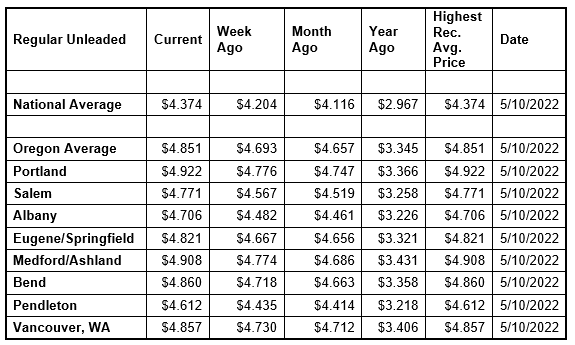
The national and Oregon averages are both at new record highs, eclipsing the record highs set in March.
“The cost of crude oil accounts for more than half of what we pay at the pumps, so higher crude oil prices translate into more expensive gas and diesel. Unfortunately, these high pump prices are not likely to ease anytime soon,” says Marie Dodds, public affairs director for AAA Oregon/Idaho.
On average, about 53% of what we pay for in a gallon of gasoline is for the price of crude oil,12% is refining, 21% distribution and marketing, and 15% are taxes, according to the U.S. Energy Information Administration.
About 3% of oil, and a total of 8% of oil and refined products used in the U.S. last year came from Russia, while about 25% of Europe’s oil is imported from Russia. The U.S. is the largest oil producer in the world. Other top producers are Saudi Arabia and Russia.
Demand for gasoline in the U.S. is up slightly, from 8.74 million b/d to 8.86 million b/d. Total domestic gasoline stocks decreased by 2.2 million bbl to 228.6 million bbl last week, according to the U.S. Energy Information Administration (EIA). Increasing gas demand and rising oil prices have pushed pump prices higher. Pump prices will likely face upward pressure as oil prices remain above $100 per barrel.
Quick stats
Oregon is one of 49 states and the District of Columbia where prices have risen in the last week, and 44 states and D.C. have double-digit increases. Indiana (+28 cents) has the largest weekly jump. Nevada (+3 cents) has the smallest weekly gain. Utah (-1 cent) is the only state in the nation with a weekly decline.
California ($5.84) is the most expensive state in the nation and is one of three states with an average above $5 a gallon. There are 44 states and the District of Columbia with an average at or above $4 a gallon.
The cheapest gas in the nation is in Georgia ($3.90) and Missouri ($3.93). This week no states have averages below $3 a gallon, same as a week ago. For the 70th week in a row, no state has an average below $2 a gallon.
Oregon is one of 48 states and the District of Columbia with higher prices now than a month ago. The national average is 26 cents more and the Oregon average is 15 cents more than a month ago. This is the 32nd-largest monthly jump in the nation. Utah (-1 cent) and Nevada (-1/10th of a cent) are the only states with monthly declines.
All 50 states and the District of Columbia have higher prices now than a year ago. Every state and D.C. have a current average that’s a dollar or more higher than a year ago. The national average is $1.41 more and the Oregon average is $1.51 more than a year ago. This is the 12th-largest yearly increase in the nation. California (+$1.74) has the biggest yearly increase. Colorado (+$1.09) has the smallest year-over-year increase.
West Coast
The West Coast region continues to have the most expensive pump prices in the nation with all seven states in the top 10. This is typical for the West Coast as this region tends to consistently have fairly tight supplies, consuming about as much gasoline as is produced.
| Rank | Region | Price on 5/10/22 | ||
| 1 | California | $5.84 | ||
| 2 | Hawaii | $5.30 | ||
| 3 | Nevada | $5.13 | ||
| 4 | Washington | $4.87 | ||
| 5 | Oregon | $4.85 | ||
| 6 | Alaska | $4.77 | ||
| 7 | District of Columbia | $4.71 | ||
| 8 | Illinois | $4.69 | ||
| 9 | Arizona | $4.67 | ||
| 10 | New York | $4.57 |
California is the most expensive state for the 68th week in a row with Hawaii, Nevada, Washington, Oregon, and Alaska rounding out the top six. Arizona is ninth. Oregon is fifth for the fourth week in a row.
All seven states have week-over-week increases. Oregon (+16 cents) has the largest weekly increase in the region. Hawaii (+3 cents) and Nevada (+3 cents) have the region’s smallest weekly increases.
The refinery utilization rate on the West Coast rose slightly from 79.1% to 79.6% for the week ending April 29. The rate has ranged between about 76% and 90% in the last year.
According to EIA’s latest weekly report, total gas stocks in the region increased from 30.52 million bbl to 30.76 million bbl.
Oil market dynamics
Crude oil prices rose last week after the European Union announced a proposal to ban Russian oil imports within six months, while refined product imports would be prohibited by the end of 2022. The price increases occurred despite continuing COVID lockdowns in China weighing down crude demand and EIA reporting that total domestic crude inventories increased by 1.3 million bbl to 415.7 million bbl, which is approximately 14 percent lower than the storage level at the end of April 2021. Since supply remains tight and the market remains highly volatile, crude prices will likely continue to fluctuate this week, potentially pushing pump prices higher.
At the close of Friday’s formal trading session, WTI increased by $1.51 to settle at $109.77. At Monday’s formal trading session, WTI fell $6.68 to close at $103.09. Today crude is trading around $100, compared to $102 a week ago. Crude prices are about $38 more than a year ago.
Drivers can find current gas prices along their route with the free AAA Mobile app for iPhone, iPad and Android. The app can also be used to map a route, find discounts, book a hotel and access AAA roadside assistance. Learn more at AAA.com/mobile.
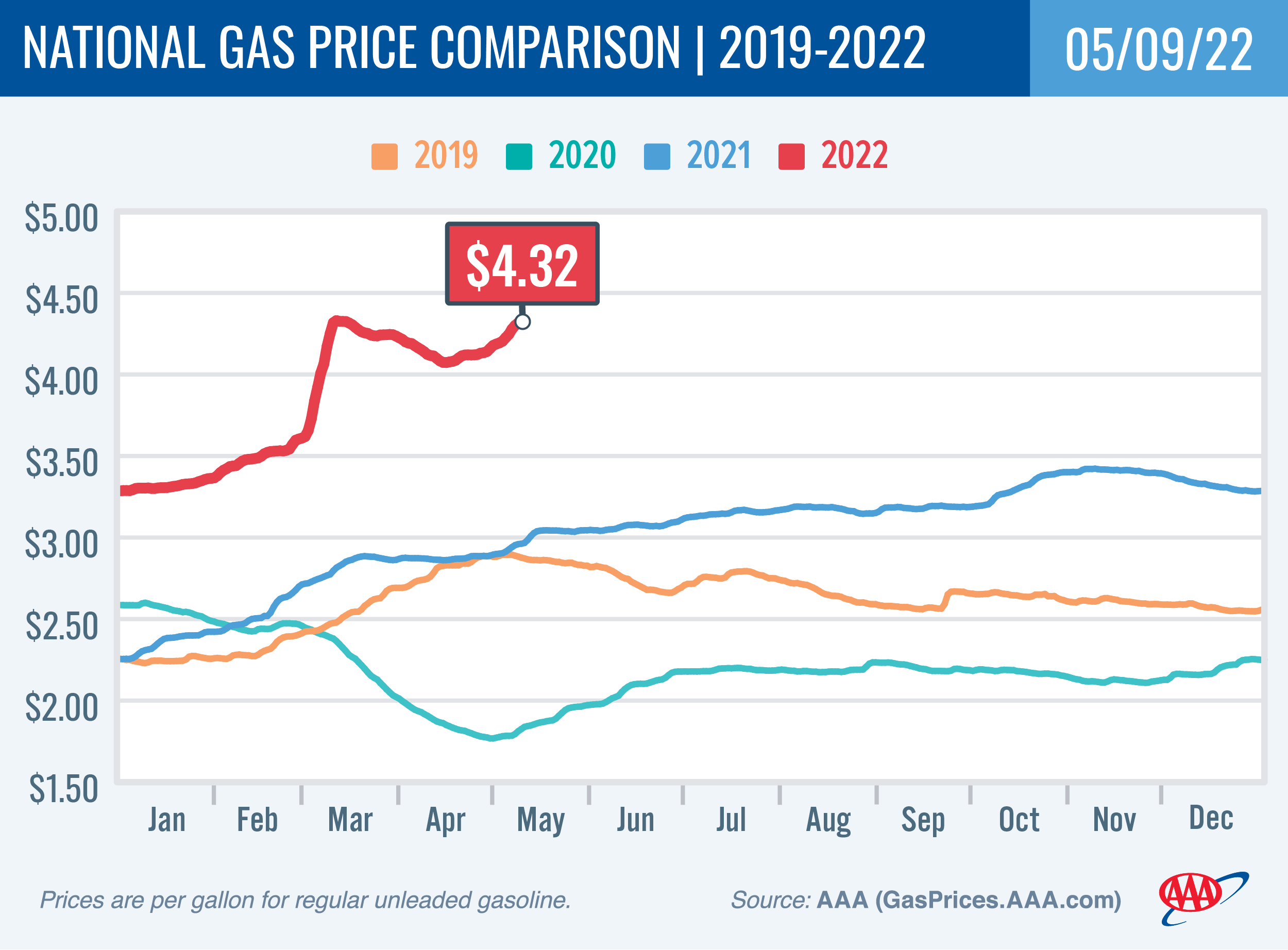
Diesel
For the week, the national average soars 18 cents to $5.55 a gallon. This is a record high. Oregon’s average jumps 13 cents to $5.60. This is also a record high. A year ago the national average for diesel was $3.12 and the Oregon average was $3.28.
Find current fuel prices at GasPrices.AAA.com.
AAA news releases, high resolution images, broadcast-quality video, fact sheets and podcasts are available on the AAA NewsRoom at NewsRoom.AAA.com.
Find local news releases at https://oregon.aaa.com/community/media/media-contacts.html
Fuel prices are updated daily at AAA’s Daily Fuel Gauge at AAA Gas Prices. For more info go www.AAA.com. AAA Oregon/Idaho provides more than 850,000 members with travel, insurance, financial and automotive-related services, and is an affiliate of AAA National, serving more than 62 million motorists in North America.
Updated 5/3/2022
Pump Prices Rise on High Cost of Crude
PORTLAND, Ore., – No relief for drivers due to the high cost of crude oil. Pump prices are climbing in 49 states, including Oregon, this week. Fear of a global energy supply disruption due to Russia’s invasion of Ukraine outweighs the demand concerns prompted by the impact of COVID-19 on China’s economy. The cost of a barrel of crude continues to hover around $100. For the week, the national average for regular gains seven cents to $4.20 a gallon. The Oregon average climbs two cents to $4.69.
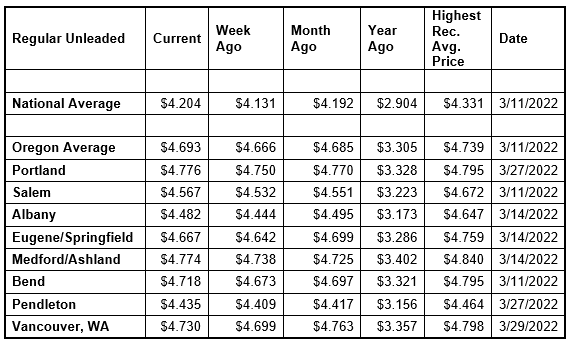
“As long as the supply remains tight, crude oil prices are not likely to fall, which means consumers will continue to face elevated prices at the pump,” says Marie Dodds, public affairs director for AAA Oregon/Idaho. “It now costs drivers in the U.S. about $23 more to fill up than a year ago.”
The national and Oregon averages are both a bit lower than their record highs set last month. The national average peaked at $4.331 on March 11 while the Oregon average peaked at $4.739 on March 11. These prices eclipse the old record highs set in 2008 when the national average peaked at $4.11 on July 17, and the Oregon average peaked at $4.29 on July 3.
On average, about 53% of what we pay for in a gallon of gasoline is for the price of crude oil,12% is refining, 21% distribution and marketing, and 15% are taxes, according to the U.S. Energy Information Administration.
About 3% of oil, and a total of 8% of oil and refined products used in the U.S. last year came from Russia, while about 25% of Europe’s oil is imported from Russia. The U.S. is the largest oil producer in the world. Other top producers are Saudi Arabia and Russia.
Demand for gasoline in the U.S. is down slightly, from 8.87 million b/d to 8.74 million b/d. Total domestic gasoline stocks decreased by 1.6 million bbl to 230.8 million bbl last week, according to the U.S. Energy Information Administration (EIA). Although lower gas demand would typically push pump prices lower, the fluctuating oil price and tight gasoline supply have pushed pump prices higher. Pump prices will likely face upward pressure as oil prices remain above $100 per barrel.
Meantime, consumers can enjoy a tasty gas price–related treat courtesy of Krispy Kreme Doughnuts. For the next two Wednesdays, Krispy Kreme will lower the price of a dozen Original Glazed donuts to the national average that AAA reports each Monday. The offer runs through Wednesday, May 4. A dozen glazed doughnuts typically cost around $12. This Wednesday’s dozen should cost $4.19, not including sales tax, only in shop, drive-through, and online pickup.
Quick stats
Oregon is one of 49 states and the District of Columbia where prices have risen in the last week. Maryland (+18 cents) has the largest weekly jump. New Mexico (+1/10th of a cent) has the smallest weekly gain. Utah (-3/10ths of a cent) is the only state in the nation with a weekly decline.
California ($5.75) is the most expensive state in the nation and is one of three states with an average above $5 a gallon. There are 30 states and the District of Columbia with an average at or above $4 a gallon.
The cheapest gas in the nation is in Georgia ($3.73) and Missouri ($3.79). This week no states have averages below $3 a gallon, same as a week ago. For the 69th week in a row, no state has an average below $2 a gallon.
Oregon is one of 33 states and the District of Columbia with higher prices now than a month ago. The national average is a penny more and the Oregon average is also a penny more than a month ago. Maryland (+47 cents) has the largest month-over-month jump. Georgia (-14 cents) has the largest monthly drop.
All 50 states and the District of Columbia have higher prices now than a year ago. Every state and D.C. have a current average that’s a dollar or more higher than a year ago. The national average is $1.30 more and the Oregon average is $1.39 more than a year ago. This is the 15th-largest yearly increase in the nation. California (+$1.70) has the biggest yearly increase. Georgia (+$1.03) has the smallest year-over-year increase.
West Coast
The West Coast region continues to have the most expensive pump prices in the nation with all seven states in the top 10. This is typical for the West Coast as this region tends to consistently have fairly tight supplies, consuming about as much gasoline as is produced.
California is the most expensive state for the 67th week in a row with Hawaii, Nevada, Washington, Oregon, Alaska and Arizona rounding out the top seven. Oregon is fifth for the third week in a row.
All seven states are seeing smaller increases than many other states this week. California (+6 cents) has the largest weekly increase in the region. Alaska (+1 cent) has the region’s smallest weekly increase.
The refinery utilization rate on the West Coast fell from 84.0% to 79.1% for the week ending April 22. The rate has ranged between about 76% and 90% in the last year.
According to EIA’s latest weekly report, total gas stocks in the region rose from 29.60 million bbl to 30.52 million bbl.
| Rank | Region | Price on 5/3/22 | ||
| 1 | California | $5.75 | ||
| 2 | Hawaii | $5.27 | ||
| 3 | Nevada | $5.09 | ||
| 4 | Washington | $4.73 | ||
| 5 | Oregon | $4.69 | ||
| 6 | Alaska | $4.67 | ||
| 7 | Arizona | $4.57 | ||
| 8 | District of Columbia | $4.52 | ||
| 9 | Utah | $4.50 | ||
| 10 | Illinois | $4.47 |
Oil market dynamics
Although prices declined on Friday due to crude demand concerns as lockdowns continue in China, crude prices gained earlier in the week after EIA’s weekly report showed that total current supply level is approximately 16 percent lower than at the end of April 2021. Crude inventories rose by 700,000 bbl to 414.4 million bbl, but supply remains tight and the market remains highly volatile. For this week, crude prices will likely continue to increase, pushing pump prices higher. Additionally, the market will be watching this week’s OPEC+ meeting via videoconference on Thursday, May 5, which could see the cartel increase crude production to help meet global demand.
At the close of Friday’s formal trading session, WTI decreased by 67 cents to settle at $104.69. At Monday’s formal trading session, WTI rose 48 cents to close at $105.17. Today crude is trading around $103, compared to $102 a week ago. Crude prices are about $41 more than a year ago.
Drivers can find current gas prices along their route with the free AAA Mobile app for iPhone, iPad and Android. The app can also be used to map a route, find discounts, book a hotel and access AAA roadside assistance. Learn more at AAA.com/mobile.
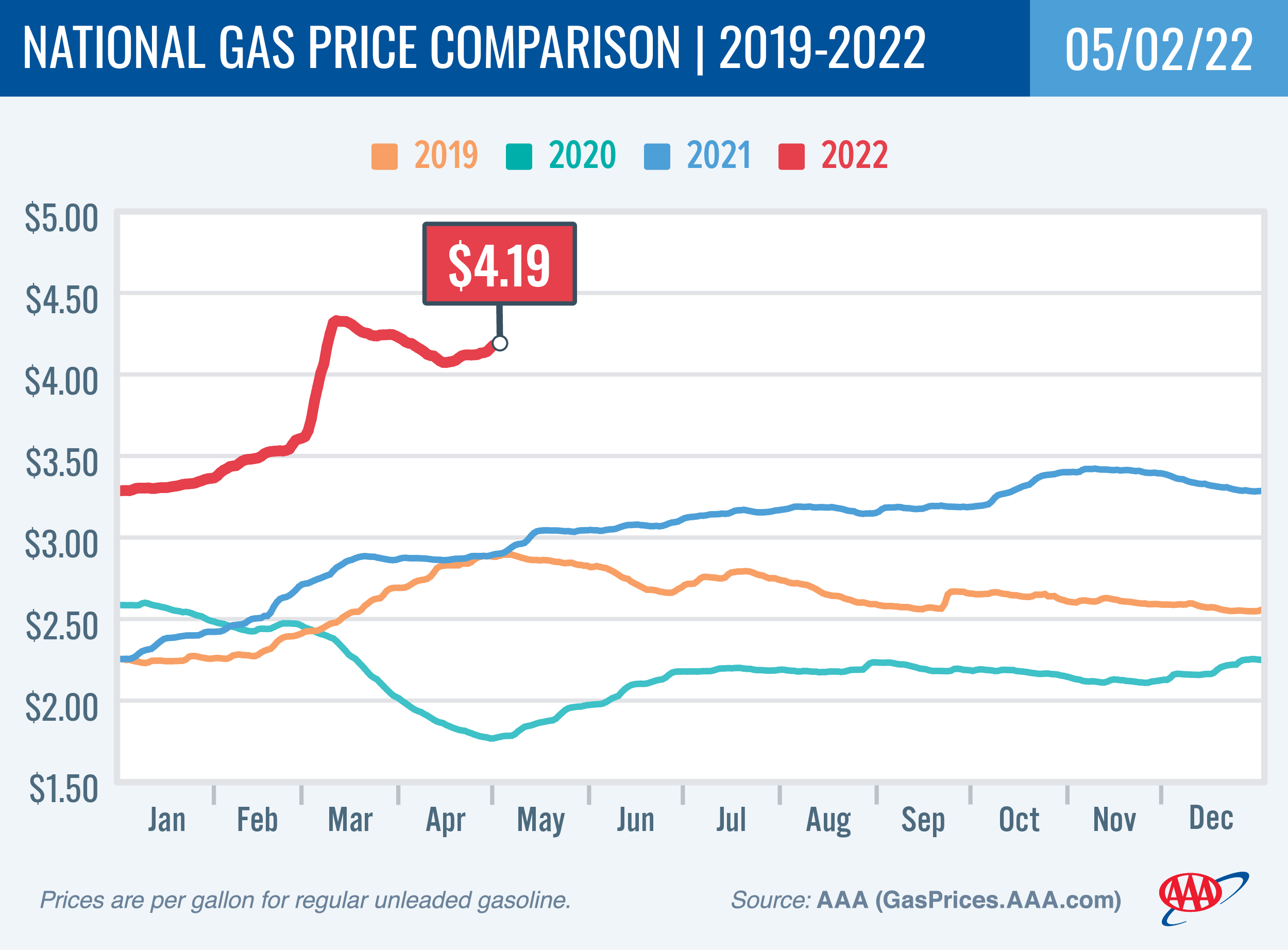
Diesel
For the week, the national average rockets up 29 cents to $5.37 a gallon. This is a record high. Oregon’s average climbs eight cents to $5.47. The record high for diesel in Oregon is $5.489 set on March 30 of this year. A year ago the national average for diesel was $3.09 and the Oregon average was $3.25.
Find current fuel prices at GasPrices.AAA.com.
AAA news releases, high resolution images, broadcast-quality video, fact sheets and podcasts are available on the AAA NewsRoom at NewsRoom.AAA.com.
Find local news releases at https://oregon.aaa.com/community/media/media-contacts.html
Fuel prices are updated daily at AAA’s Daily Fuel Gauge at AAA Gas Prices. For more info go www.AAA.com. AAA Oregon/Idaho provides more than 850,000 members with travel, insurance, financial and automotive-related services, and is an affiliate of AAA National, serving more than 62 million motorists in North America.
Updated 4/26/2022
Oregon Average Steady while National Average Ticks Up on Oil Market Volatility
PORTLAND, Ore., – The recent dip in gas prices has reversed as crude oil prices remain stubbornly elevated. Upward pricing pressure on concerns that less Russian oil will enter the global market is countered by fears of a COVID-induced economic slowdown in China, the world’s leading oil consumer. These opposing forces are causing the oil price to remain near $100 per barrel. For the week, the national average for regular adds three cents to $4.13 a gallon. The Oregon average holds steady at $4.67.
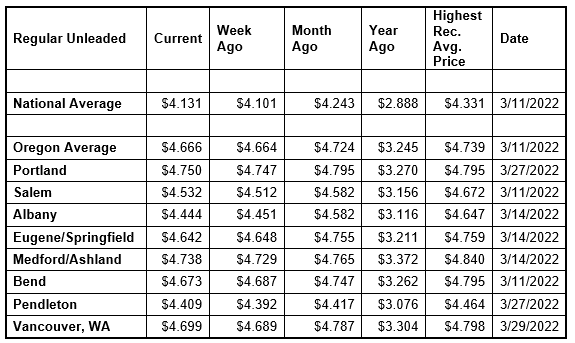
“Pump prices will struggle to fall as long as the price of oil remains elevated. While pump prices have slipped from record highs set in March, consumers shouldn’t expect any dramatic drops this spring,” says Marie Dodds, public affairs director for AAA Oregon/Idaho.
The national and Oregon averages are both a bit lower than their record highs set last month. The national average peaked at $4.331 on March 11 while the Oregon average peaked at $4.739 on March 11. These prices eclipse the old record highs set in 2008 when the national average peaked at $4.11 on July 17, and the Oregon average peaked at $4.29 on July 3.
On average, about 53% of what we pay for in a gallon of gasoline is for the price of crude oil,12% is refining, 21% distribution and marketing, and 15% are taxes, according to the U.S. Energy Information Administration.
About 3% of oil, and a total of 8% of oil and refined products used in the U.S. last year came from Russia, while about 25% of Europe’s oil is imported from Russia. The U.S. is the largest oil producer in the world. Other top producers are Saudi Arabia and Russia.
Demand for gasoline in the U.S. is up slightly, despite the high pump prices, from 8.73 million b/d to 8.86 million b/d. Total domestic gasoline stocks decreased by nearly 1 million bbl to 232.3 million bbl last week, according to the U.S. Energy Information Administration (EIA).
Meantime, consumers can enjoy a tasty gas price–related treat courtesy of Krispy Kreme Doughnuts. For the next two Wednesdays, Krispy Kreme will lower the price of a dozen Original Glazed donuts to the national average that AAA reports each Monday. The offer runs through Wednesday, May 4. A dozen glazed doughnuts typically cost around $12. This Wednesday’s dozen should cost $4.12, not including sales tax, only in shop, drive-through, and online pickup.
Quick stats
Oregon is one of 11 states where prices have changed by a penny or less in the last week, while 41 states and the District of Columbia have week-over-week increases. Delaware (+15 cents) has the largest weekly jump. North Carolina (-2 cents) has the largest weekly drop.
California ($5.68) is the most expensive state in the nation and is one of three states with an average above $5 a gallon. There are 26 states and the District of Columbia with an average at or above $4 a gallon.
The cheapest gas in the nation is in Georgia ($3.71) and Arkansas ($3.74). This week no states have averages below $3 a gallon, same as a week ago. For the 68th week in a row, no state has an average below $2 a gallon.
Oregon is one of 39 states and the District of Columbia with lower prices now than a month ago. The national average is 11 cents less and the Oregon average is six cents less than a month ago. Connecticut (-30 cents) has the largest month-over-month drop. Maryland (+27 cents) has the largest monthly increase.
All 50 states and the District of Columbia have higher prices now than a year ago. Every state and D.C. have a current average that’s a dollar or more higher than a year ago. The national average is $1.24 more and the Oregon average is $1.42 more than a year ago. This is the sixth-largest yearly increase in the nation. California (+$1.69) has the biggest yearly increase. Georgia (+$1.02) has the smallest year-over-year increase.
West Coast
The West Coast region continues to have the most expensive pump prices in the nation with all seven states in the top 10. This is typical for the West Coast as this region tends to consistently have fairly tight supplies, consuming about as much gasoline as is produced.
| Rank | Region | Price on 4/26/22 | ||
| 1 | California | $5.68 | ||
| 2 | Hawaii | $5.25 | ||
| 3 | Nevada | $5.08 | ||
| 4 | Washington | $4.69 | ||
| 5 | Oregon | $4.67 | ||
| 6 | Alaska | $4.66 | ||
| 7 | Arizona | $4.55 | ||
| 8 | Utah | $4.50 | ||
| 9 | Idaho | $4.43 | ||
| 10 | Illinois | $4.40 |
California is the most expensive state for the 66th week in a row with Hawaii, Nevada, Washington, Oregon, Alaska and Arizona rounding out the top seven. Oregon is fifth for the second week in a row.
Like the rest of the country, all seven states in the region have week-over-week decreases. Nevada (-8 cents) has the largest decline in the region. Alaska (-2 cents) has the smallest weekly decrease in the region.
Like most other states in the nation, all seven states in the region are seeing minimal movement in pump prices again this week. California (-2 cents) has the largest weekly decline in the region. Hawaii (+1 cent) has the region’s largest weekly increase.
The refinery utilization rate on the West Coast fell from 84.4% to 84.0% for the week ending April 15. The rate has ranged between about 76% and 90% in the last year.
According to EIA’s latest weekly report, total gas stocks in the region fell from 30.09 million bbl to 29.60 million bbl.
Oil market dynamics
Crude prices weakened at the end of the day Friday due to demand concerns in Shanghai as fears of a demand-reducing slowdown in global economic activity loom. Crude prices declined despite EIA reporting that total domestic oil inventories decreased by 8.1 million barrels to 413.7 million barrels. This week, crude prices could see further reductions if demand concerns continue to drag the market down.
At the close of Friday’s formal trading session, WTI decreased by $1.72 to settle at $102.07. At Monday’s formal trading session, WTI fell $3.53 to close at $98.54. Today crude is trading around $101, compared to $103 a week ago. Crude prices are about $36 more than a year ago.
Drivers can find current gas prices along their route with the free AAA Mobile app for iPhone, iPad and Android. The app can also be used to map a route, find discounts, book a hotel and access AAA roadside assistance. Learn more at AAA.com/mobile.

Updated 4/19/2022
Pump Prices Fairly Steady as Demand and Oil Prices Climb
PORTLAND, Ore., – The slide in gas prices has slowed as crude oil prices and U.S. demand for gasoline rise. The ongoing war in Ukraine and concerns of less Russian oil on the global market have sent crude prices back above $100 dollars per barrel, and that’s putting upward pressure on pump prices. For the week, the national average for regular holds steady at $4.10 a gallon. The Oregon average ticks up a penny to $4.66.

The national and Oregon averages are both a bit lower than their record highs set last month. The national average peaked at $4.331 on March 11 while the Oregon average peaked at $4.739 on March 11. These prices eclipse the old record highs set in 2008 when the national average peaked at $4.11 on July 17, and the Oregon average peaked at $4.29 on July 3.
“Demand for gasoline in the U.S. is edging up as pump prices dip below the record highs set in March. We tend to see gasoline consumption increase this time of year as the days get longer and people drive more,” says Marie Dodds, public affairs director for AAA Oregon/Idaho. “But these lower pump prices could be temporary if the global price of oil increases due to constrained supply.”
On average, about 53% of what we pay for in a gallon of gasoline is for the price of crude oil,12% is refining, 21% distribution and marketing, and 15% are taxes, according to the U.S. Energy Information Administration.
About 3% of oil, and a total of 8% of oil and refined products used in the U.S. last year came from Russia, while about 25% of Europe’s oil is imported from Russia. The U.S. is the largest oil producer in the world. Other top producers are Saudi Arabia and Russia.
Demand for gasoline in the U.S. is up slightly as an increasing number of markets saw pump prices fall below $4 a gallon. Demand climbed from 8.5 million b/d to 8.73 million b/d. Total domestic gasoline stocks decreased by 3.5 million bbl to 233.1 million bbl last week, according to the U.S. Energy Information Administration (EIA).
Meantime, consumers can enjoy a tasty gas price–related treat courtesy of Krispy Kreme Doughnuts. For the next three Wednesdays, Krispy Kreme will lower the price of a dozen Original Glazed donuts to the national average that AAA reports each Monday. The offer runs through Wednesday, May 4. A dozen glazed doughnuts typically cost around $12. This Wednesday’s dozen should cost $4.08, not including sales tax, only in shop, drive-through, and online pickup.
Quick stats
Oregon is one of 25 states and the District of Columbia with higher prices now than a week ago. Maryland (+31 cents) has the largest weekly jump. Ohio (-7 cents) has the largest weekly drop. The average in Hawaii is flat.
California ($5.70) is the most expensive state in the nation and is one of three states with an average above $5 a gallon. There are 23 states and the District of Columbia with an average at or above $4 a gallon.
The cheapest gas in the nation is in Georgia ($3.71) and Arkansas ($3.72). This week no states have averages below $3 a gallon, same as a week ago. For the 67th week in a row, no state has an average below $2 a gallon.
Oregon is one of 42 states and the District of Columbia with lower prices now than a month ago. The national average is 16 cents less and the Oregon average is four cents less than a month ago. Georgia (-48 cents) has the largest month-over-month drop. Utah (+14 cents) has the largest. The average in Nevada is flat month-over-month.
All 50 states and the District of Columbia have higher prices now than a year ago. Every state and D.C. have a current average that’s a dollar or more higher than a year ago. The national average is $1.23 more and the Oregon average is $1.44 more than a year ago. This is the sixth-largest yearly increase in the nation. California (+$1.73) has the biggest yearly increase. Georgia (+$1.01) has the smallest year-over-year increase.
West Coast
The West Coast region continues to have the most expensive pump prices in the nation with all seven states in the top 10. This is typical for the West Coast as this region tends to consistently have fairly tight supplies, consuming about as much gasoline as is produced.
| Rank | Region | Price on 4/19/22 | ||
| 1 | California | $5.70 | ||
| 2 | Hawaii | $5.24 | ||
| 3 | Nevada | $5.08 | ||
| 4 | Washington | $4.68 | ||
| 5 | Oregon | $4.66 | ||
| 6 | Alaska | $4.66 | ||
| 7 | Arizona | $4.57 | ||
| 8 | Utah | $4.48 | ||
| 9 | Idaho | $4.41 | ||
| 10 | Illinois | $4.35 |
California is the most expensive state for the 65th week in a row with Hawaii, Nevada, Washington, Oregon, Alaska and Arizona rounding out the top seven. Oregon rises to fifth after three weeks at sixth.
Like most other states, all seven states in the region are seeing minimal movement in pump prices. California (-5 cents), Arizona (-3 cents), Nevada (-3 cents) and Alaska (-1 cent) have week-over-week declines, while Oregon (+1 cent) and Washington (+1 cent) have weekly increases. The average in Hawaii is flat.
The refinery utilization rate on the West Coast fell from 90.1% to 84.4% for the week ending April 8. The rate has ranged between about 76% and 90% in the last year.
According to EIA’s latest weekly report, total gas stocks in the region increased from 29.75 million bbl. to 30.09 million bbl.
Oil market dynamics
U.S. commercial crude oil inventories increased by 9.4 million barrels from the previous week to reach 421.8 million barrels, according to EIA’s weekly report. Despite the larger inventory, crude oil prices jumped last week as the European Union announced they are drafting plans to ban Russian oil imports, a move that could tighten global supply as member countries look for new sources for crude oil in an already tight market. Additionally, the most recent Oil Market Report from the International Energy Agency (IEA) forecasts that Russian oil output will shrink by about 1.5 million barrels per day this month as the result of financial and export sanctions. The crude oil market will likely remain volatile this week and could continue to fluctuate if concerns about supply persist.
At the close of Thursday’s formal trading session, WTI increased by $2.70 to settle at $106.95. U.S. markets were closed Friday in observance of Good Friday. At Monday’s formal trading session, WTI rose $1.26 to close at $108.21. Today crude is trading around $102, compared to $101 a week ago. Crude prices are about $45 more than a year ago.
Drivers can find current gas prices along their route with the free AAA Mobile app for iPhone, iPad and Android. The app can also be used to map a route, find discounts, book a hotel and access AAA roadside assistance. Learn more at AAA.com/mobile.
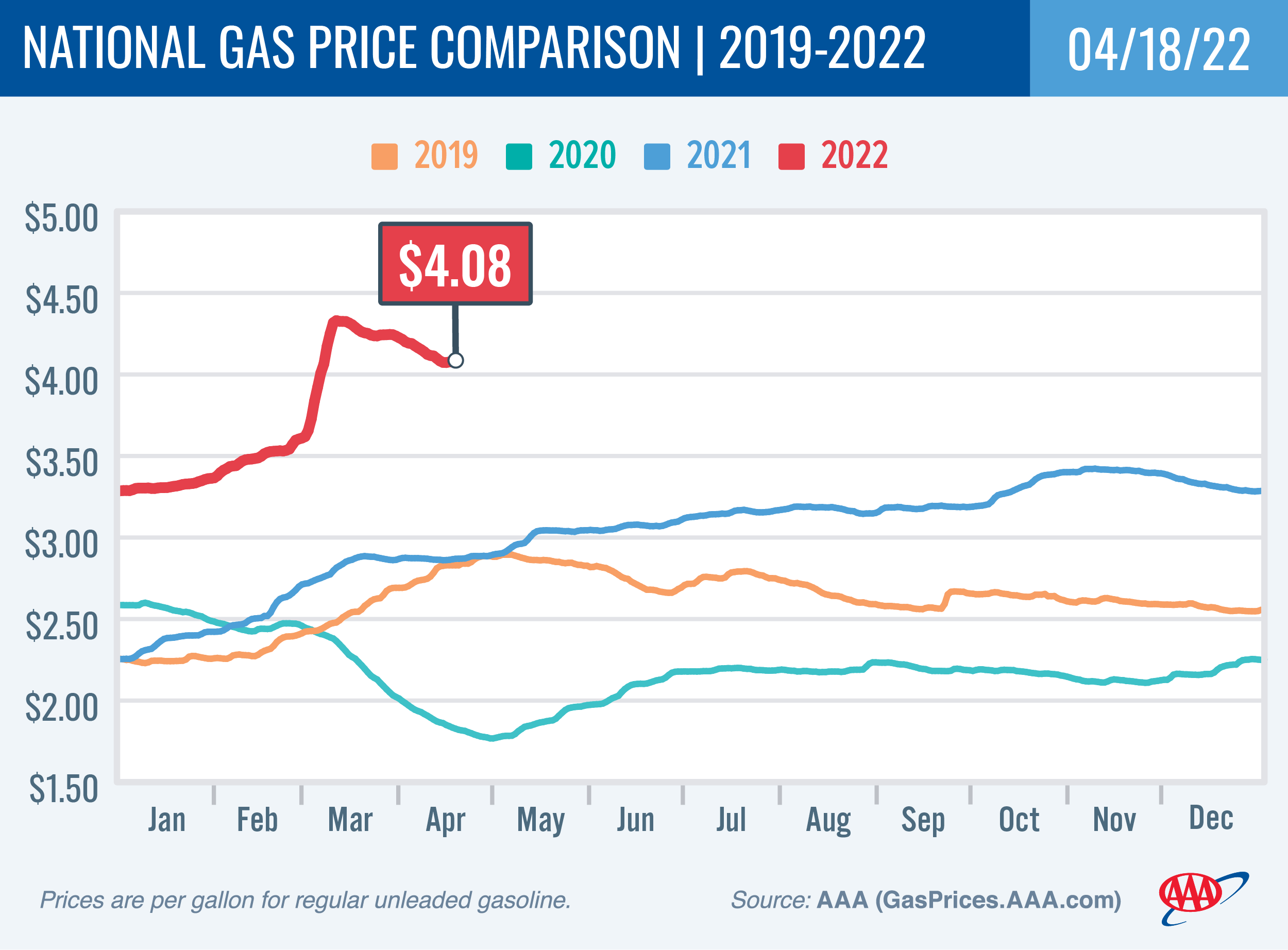
Diesel
For the week, the national average climbs a penny to $5.04 a gallon. Oregon’s average holds steady at $5.38. A year ago the national average for diesel was $3.08 and the Oregon average was $3.22.
Find current fuel prices at GasPrices.AAA.com.
AAA news releases, high resolution images, broadcast-quality video, fact sheets and podcasts are available on the AAA NewsRoom at NewsRoom.AAA.com.
Find local news releases at https://oregon.aaa.com/community/media/media-contacts.html
Fuel prices are updated daily at AAA’s Daily Fuel Gauge at AAA Gas Prices. For more info go www.AAA.com. AAA Oregon/Idaho provides more than 850,000 members with travel, insurance, financial and automotive-related services, and is an affiliate of AAA National, serving more than 62 million motorists in North America.
Updated 4/5/2022
Plan to Tap Strategic Petroleum Reserve puts the Brakes on Pump Price Increases
PORTLAND, Ore., – President Biden’s decision to release one million barrels of oil per day for six months (180 million barrels) from the Strategic Petroleum Reserve (SPR) helped send the global oil price tumbling to near $100 bbl. The release is intended to stem rising energy prices and pump prices have begun to retreat in all 50 states. For the week, the national average for regular loses seven cents to $4.18. The Oregon average slips four cents to $4.68.

The national and Oregon averages are both a bit lower than their record highs set last month. The national average peaked at $4.331 on March 11 while the Oregon average peaked at $4.739 on March 11. These prices eclipse the old record highs set in 2008 when the national average peaked at $4.11 on July 17, and the Oregon average peaked at $4.29 on July 3.
The SPR is a collection of underground salt caverns along the Gulf Coast where millions of gallons of crude oil are stored. Created in 1975 and managed by the U.S. Department of Energy, it is said to be the largest supply of emergency crude oil in the world. President Biden’s announcement came as OPEC and its allies announced they would maintain a plan to gradually ramp up production with 400,000 b/d monthly increases.
“Skyrocketing crude oil prices spurred by Russia’s war in Ukraine are finally easing from the planned SPR oil release and increased COVID fears in China, and the lower global crude prices are putting downward pressure on pump prices for U.S. consumers,” says Marie Dodds, public affairs director for AAA Oregon/Idaho.
On average, about 53% of what we pay for in a gallon of gasoline is for the price of crude oil,12% is refining, 21% distribution and marketing, and 15% are taxes, according to the U.S. Energy Information Administration.
About 3% of oil, and a total of 8% of oil and refined products used in the U.S. last year came from Russia, while about 25% of Europe’s oil is imported from Russia. The U.S. is the largest oil producer in the world. Other top producers are Saudi Arabia and Russia.
Demand for gasoline in the U.S. usually climbs this time of year. But demand is defying seasonal trends and has dipped for the third week in a row, possibly due to higher pump prices and consumers altering their driving habits. Demand dipped from 8.63 million b/d to 8.5 million b/d. Total domestic gasoline stocks rose by 800,000 bbl to 238.8 million bbl last week. The drop in gas demand, alongside growth in total stocks, contributes to price decreases. If demand continues to decline as gasoline stocks continue to build, the national average will likely continue to move lower, as long as crude oil prices don’t climb again.
Quick stats
All 50 states and the District of Columbia have lower prices now than a week ago. Connecticut (-30 cents) has the largest weekly drop. Idaho (-3/10ths of a cents) has the smallest week-over-week decline.
California ($5.84) is the most expensive state in the nation and is one of three states with an average above $5 a gallon. There are 28 states and the District of Columbia with an average at or above $4 a gallon.
The cheapest gas in the nation is in Missouri ($3.73) and Kansas ($3.75). This week no states have averages below $3 a gallon, same as a week ago. For the 65th week in a row, no state has an average below $2 a gallon.
Oregon is one of 49 states and the District of Columbia with higher prices now than a month ago. The national average is 25 cents more and the Oregon average is 30 cents more than a month ago. This is the 15th– largest monthly increase in the nation. Nevada (+76 cents) has the largest month-over-month increase. Georgia (+7 cents) has the smallest. Connecticut (-7 cents) is the only state with a monthly decline.
All 50 states and the District of Columbia have higher prices now than a year ago. Every state and D.C. have a current average that’s a dollar or more higher than a year ago. The national average is $1.30 more and the Oregon average is $1.49 more than a year ago. This is the sixth-largest yearly increase in the nation. California (+$1.92) has the biggest yearly increase. Maryland (+$1.01) has the smallest year-over-year increase.
West Coast
The West Coast region continues to have the most expensive pump prices in the nation with all seven states in the top 10. This is typical for the West Coast as this region tends to consistently have fairly tight supplies, consuming about as much gasoline as is produced.
| Rank | Region | Price on 4/5/22 | ||
| 1 | California | $5.84 | ||
| 2 | Hawaii | $5.23 | ||
| 3 | Nevada | $5.17 | ||
| 4 | Alaska | $4.72 | ||
| 5 | Washington | $4.71 | ||
| 6 | Oregon | $4.68 | ||
| 7 | Arizona | $4.64 | ||
| 8 | Idaho | $4.42 | ||
| 9 | Illinois | $4.42 | ||
| 10 | Utah | $4.42 |
California is the most expensive state for the 63rd week in a row with Hawaii, Nevada, Alaska, Washington, Oregon, and Arizona rounding out the top seven. Oregon is sixth for the second week in a row.
Like the rest of the country, all seven states in the region have week-over-week decreases. Nevada (-8 cents) has the largest decline in the region. Alaska (-2 cents) has the smallest weekly decrease in the region.
The refinery utilization rate on the West Coast holds steady at 87.7% for the week ending March 18. The rate has ranged between about 76% and 88% in the last year.
According to EIA’s latest weekly report, total gas stocks in the region fell from 29.13 million bbl. to 28.70 million bbl.
Oil market dynamics
Crude prices climbed early last week after EIA’s weekly report revealed that total domestic crude stocks declined by 3.5 million bbl to 409.9 million bbl, approximately 18 percent lower than the level at the end of March 2021. However, crude prices reversed course after the U.S. announced it will release 1 million barrels of oil per day from the SPR for six months. Investors are also watching lockdown measures in China to combat rising COVID-19 transmission rates. China became the world’s largest byer of crude oil in 2017, and reduced consumption in China would put downward pressure on oil prices. For this week, crude prices will likely remain volatile and could fluctuate if EIA’s next weekly report shows another decrease in total domestic stocks.
At the close of Friday’s formal trading session, WTI decreased by $1.01 to settle at $99.27. At Monday’s formal trading session, WTI rose $4.01 to close at $103.28. Today crude is trading around $103, compared to $104 a week ago. Crude prices are about $42 more than a year ago.
Drivers can find current gas prices along their route with the free AAA Mobile app for iPhone, iPad and Android. The app can also be used to map a route, find discounts, book a hotel and access AAA roadside assistance. Learn more at AAA.com/mobile.
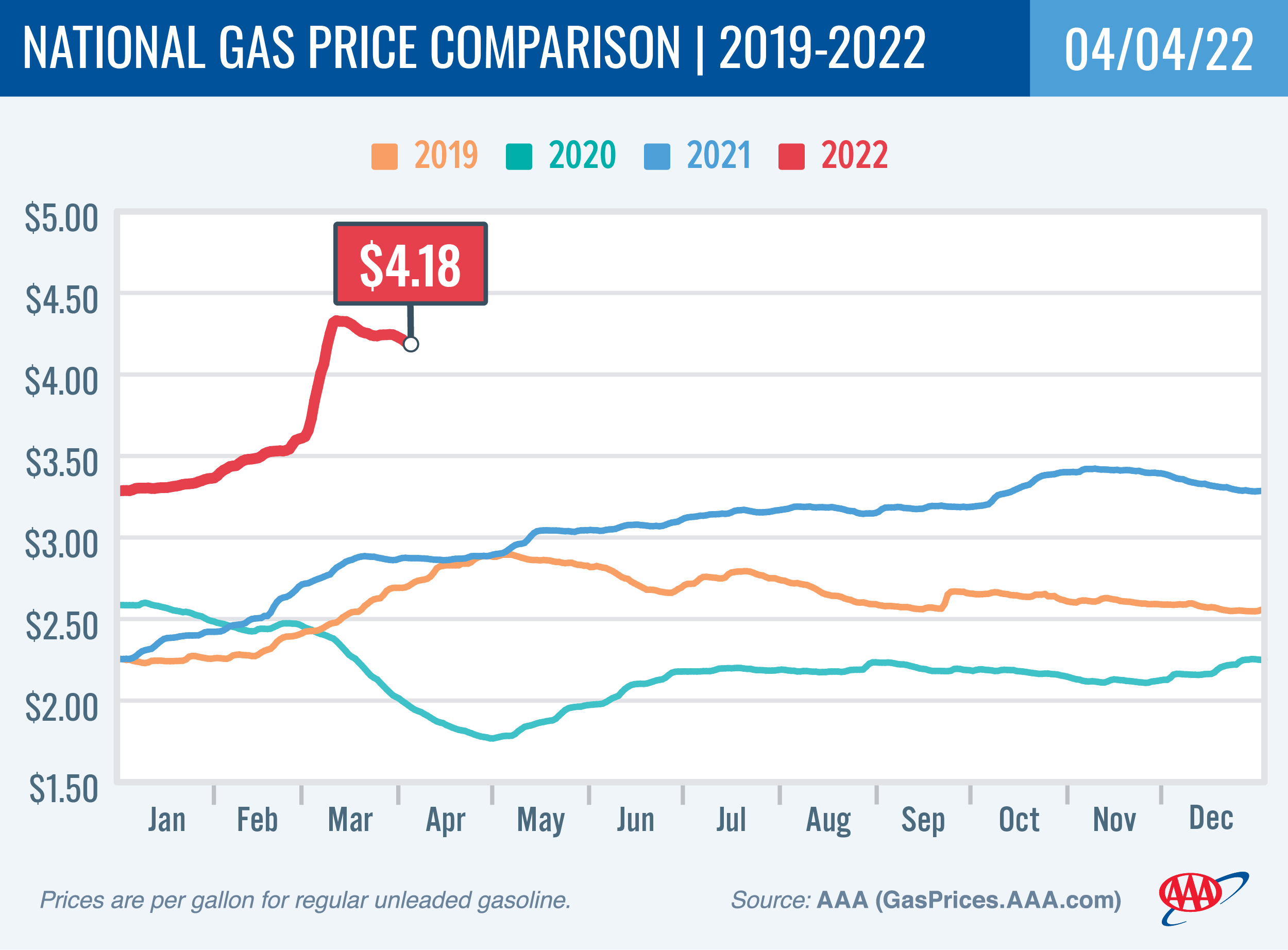
Diesel
For the week, the national average loses four-and-a-half cents to $5.08 a gallon. Oregon’s average falls a nickel to $5.43. A year ago the national average for diesel was $3.09 and the Oregon average was $3.21.
Find current fuel prices at GasPrices.AAA.com.
AAA news releases, high resolution images, broadcast-quality video, fact sheets and podcasts are available on the AAA NewsRoom at NewsRoom.AAA.com.
Find local news releases at https://oregon.aaa.com/community/media/media-contacts.html
Fuel prices are updated daily at AAA’s Daily Fuel Gauge at AAA Gas Prices. For more info go www.AAA.com. AAA Oregon/Idaho provides more than 850,000 members with travel, insurance, financial and automotive-related services, and is an affiliate of AAA National, serving more than 62 million motorists in North America.
Updated 3/29/2022
Gas Prices Stabilize as Crude Oil Remains above $100 per Barrel
PORTLAND, Ore., – Gas prices are showing little movement this week as the cost of a barrel of oil has stubbornly remained above $100 per barrel. Crude oil prices surged as Russia invaded Ukraine last month and have remained elevated. For the week, the national average for regular holds steady at $4.24. The Oregon average edges up one-and-a-half cents to $4.72.
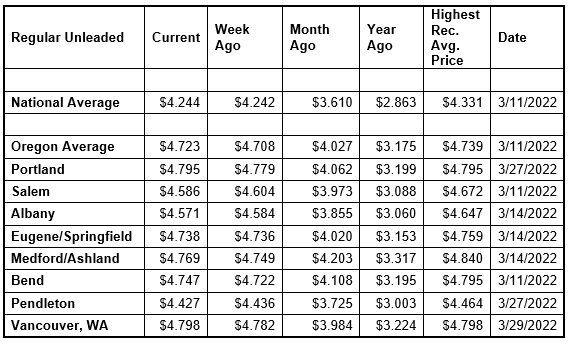
The national and Oregon averages are both a bit lower than their record highs set earlier this month. The national average peaked at $4.331 on March 11 while the Oregon average peaked at $4.739 on March 11. These prices eclipse the old record highs set in 2008 when the national average peaked at $4.11 on July 17, and the Oregon average peaked at $4.29 on July 3.
“The global oil market reflects the volatility caused by the war in Ukraine grinding onward with no resolution in sight,” says Marie Dodds. “With crude oil prices remaining high, pump prices are also staying elevated.”
On average, about 53% of what we pay for in a gallon of gasoline is for the price of crude oil,12% is refining, 21% distribution and marketing, and 15% are taxes, according to the U.S. Energy Information Administration.
About 3% of oil, and a total of 8% of oil and refined products used in the U.S. last year came from Russia, while about 25% of Europe’s oil is imported from Russia. The U.S. is the largest oil producer in the world. Other top producers are Saudi Arabia and Russia.
Demand for gasoline in the U.S. usually climbs this time of year. But demand is defying seasonal trends and has dipped for the second week in a row, possibly due to higher pump prices and consumers altering their driving habits. Demand slipped from 8.94 million b/d to 8.63 million b/d. Total domestic gasoline stocks also fell
by 3 million bbl to 238 million bbl last week, according to the U.S. Energy Information Administration (EIA). The decrease in gas demand is helping to put downward pressure on pump prices, but the high cost of crude oil is the major driver of sustained high pump prices.
Quick stats
Oregon is one of 33 states and the District of Columbia with higher prices now than a week ago. All but eight states and D.C. have relatively small gains of a nickel or less. Nevada (+12 cents) has the largest weekly increase. Georgia (-13 cents) has the largest week-over-week decline and is one of 17 states where prices fell.
California ($5.92) is the most expensive state in the nation and is one of three states with an average above $5 a gallon. There are 33 states and the District of Columbia with an average at or above $4 a gallon.
The cheapest gas in the nation is in Missouri ($3.79) and Kansas ($3.80). This week no states have averages below $3 a gallon, same as a week ago. For the 64th week in a row, no state has an average below $2 a gallon.
All 50 states and the District of Columbia have higher prices now than a month ago. The national average is 63 cents more and the Oregon average is 70 cents more than a month ago. This is the 11th– largest monthly increase in the nation. Nevada (+$1.23) has the largest month-over-month increase. Maryland (+22 cents) has the smallest.
All 50 states and the District of Columbia have higher prices now than a year ago. California is the only state with an average that’s $2 a gallon or more higher than a year ago, and every other state and D.C. have a current average that’s a dollar or more higher than a year ago. The national average is $1.38 more and the Oregon average is $1.55 more than a year ago. This is the fifth-largest yearly increase in the nation. California (+$2.02) has the biggest yearly increase. Maryland (+$1.02 cents) has the smallest year-over-year increase.
West Coast
The West Coast region continues to have the most expensive pump prices in the nation with all seven states in the top 10. This is typical for the West Coast as this region tends to consistently have fairly tight supplies, consuming about as much gasoline as is produced.
| Rank | Region | Price on 3/29/22 | ||
| 1 | California | $5.92 | ||
| 2 | Nevada | $5.26 | ||
| 3 | Hawaii | $5.15 | ||
| 4 | Washington | $4.74 | ||
| 5 | Alaska | $4.74 | ||
| 6 | Oregon | $4.72 | ||
| 7 | Arizona | $4.69 | ||
| 8 | Illinois | $4.49 | ||
| 9 | Utah | $4.44 | ||
| 10 | District of Columbia | $4.43 |
California is the most expensive state for the 62nd week in a row with Nevada, Hawaii, Washington, Alaska, Oregon, and Arizona rounding out the top seven. Oregon falls to sixth after one week at fifth.
All seven states in the region have week-over-week increases. Nevada (+12 cents) has the largest increase in the region and the nation. Washington (+1 cent) has the smallest weekly gain in the region.
The refinery utilization rate on the West Coast increased from 85.0% to 87.7% for the week ending March 18. The rate has ranged between about 76% and 88% in the last year.
According to EIA’s latest weekly report, total gas stocks in the region rose from 28.65 million bbl. to 29.13 million bbl.
The higher refinery utilization rate and increase in total gas stocks should help keep prices fairly steady in the region this week, if crude oil prices don’t jump.
Oil market dynamics
Crude prices climbed last week after EIA’s weekly report revealed that total domestic crude stocks declined by 2.5 million bbl to 413.4 million bbl, approximately 18 percent lower than the level in mid-March 2021. The current inventory level highlights tightness in the market, contributing to rising prices. For this week, crude prices fell on news that Shanghai is imposing new lockdown measures to curb COVID-19 transmission rates, which would likely reduce crude demand. According to EIA, China became the world’s largest buyer of crude oil in 2017.
At the close of Friday’s formal trading session, WTI increased by $1.56 to settle at $113.90. At Monday’s formal trading session, WTI fell $7.94 to close at $105.96. Today crude is trading around $102, compared to $112 a week ago. Crude prices are about $45 more than a year ago.
Drivers can find current gas prices along their route with the free AAA Mobile app for iPhone, iPad and Android. The app can also be used to map a route, find discounts, book a hotel and access AAA roadside assistance. Learn more at AAA.com/mobile.
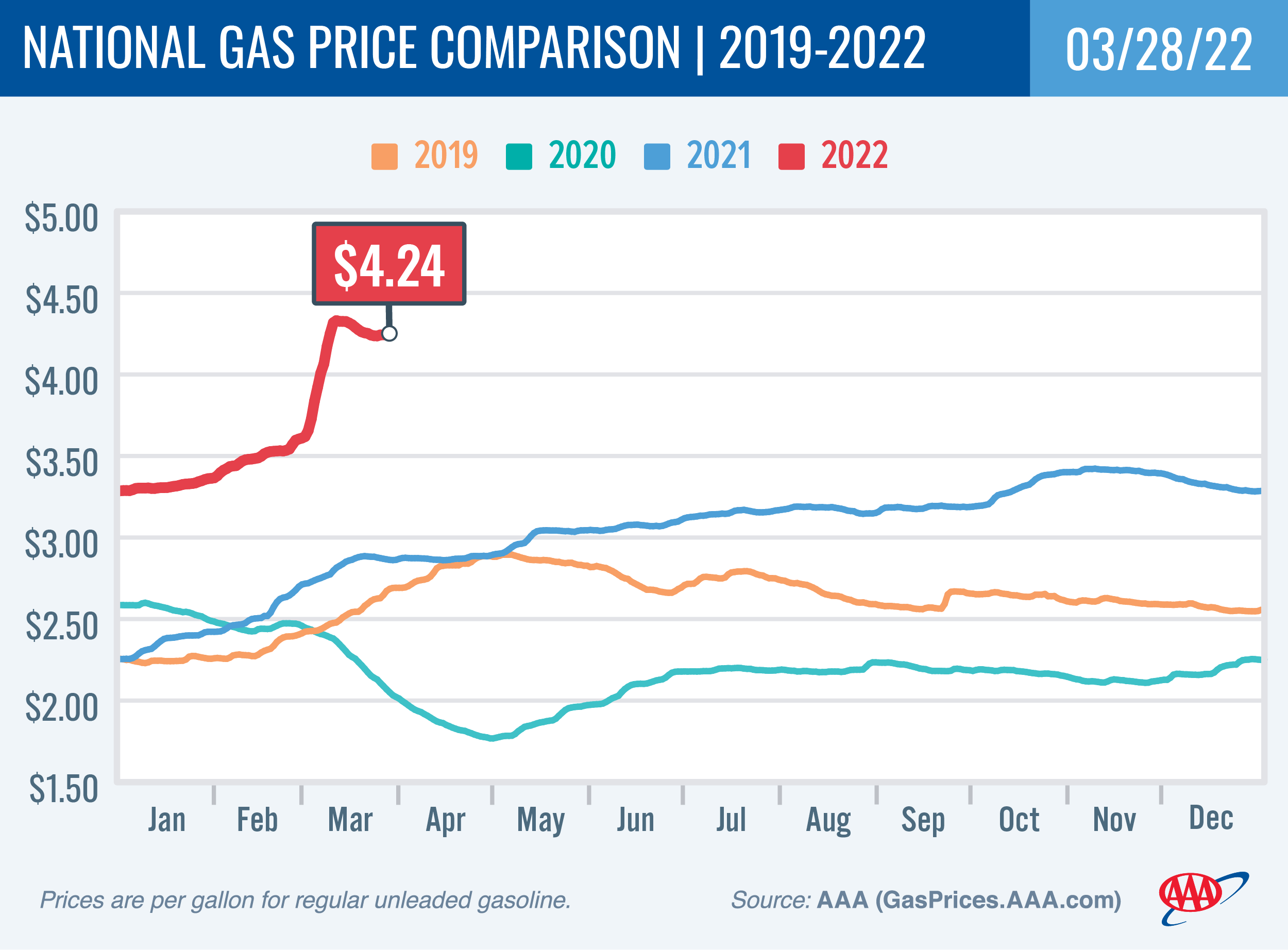
Diesel
For the week, the national average climbs nine cents to $5.13 a gallon. Oregon’s average jumps 13 cents to $5.48, which is a new record high. A year ago the national average for diesel was $3.10 and the Oregon average was $3.20.
Find current fuel prices at GasPrices.AAA.com.
AAA news releases, high resolution images, broadcast-quality video, fact sheets and podcasts are available on the AAA NewsRoom at NewsRoom.AAA.com.
Find local news releases at https://oregon.aaa.com/community/media/media-contacts.html
Fuel prices are updated daily at AAA’s Daily Fuel Gauge at AAA Gas Prices. For more info go www.AAA.com. AAA Oregon/Idaho provides more than 850,000 members with travel, insurance, financial and automotive-related services, and is an affiliate of AAA National, serving more than 62 million motorists in North America.
Updated 3/22/2022
March Madness at the Pumps: Gas Prices Sink Slowly for Now
PORTLAND, Ore., – After surging to record highs earlier this month, gas prices are declining in 44 states, including Oregon. The big driver is lower crude oil prices, which skyrocketed shortly after Russia invaded Ukraine. For the week, the national average for regular loses seven cents to $4.24. The Oregon average dips three cents to $4.71.
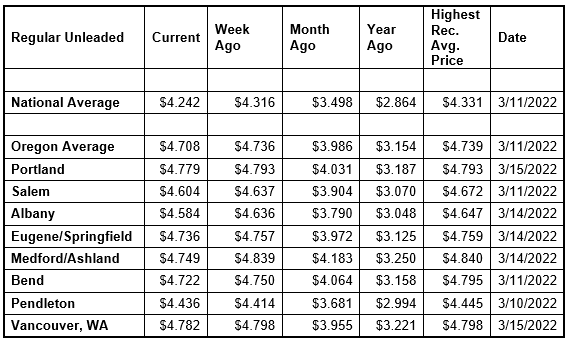
The national and Oregon averages are both a bit lower than their record highs set earlier in March. The national average peaked at $4.331 on March 11 while the Oregon average peaked at $4.739 on March 11. These prices eclipse the old record highs set in 2008 when the national average peaked at $4.11 on July 17, and the Oregon average peaked at $4.29 on July 3.
“Lower crude oil prices and a slight reduction in demand are helping to put the brakes on rising pump prices. But the tight global crude oil market remains, so it’s impossible to say whether gas prices will rise again or if they have peaked. If oil prices climb again, pump prices will follow suit,” says Marie Dodds, public affairs director for AAA Oregon/Idaho.
On average, about 53% of what we pay for in a gallon of gasoline is for the price of crude oil,12% is refining, 21% distribution and marketing, and 15% are taxes, according to the U.S. Energy Information Administration.
About 3% of oil, and a total of 8% of oil and refined products used in the U.S. last year came from Russia, while about 25% of Europe’s oil is imported from Russia. The U.S. is the largest oil producer in the world. Other top producers are Saudi Arabia and Russia.
U.S. gasoline demand dipped slightly from 8.96 million b/d to 8.94 million b/d, perhaps because of the near-record-high prices. Total domestic gasoline stocks also decreased by 3.6 million bbl to 241 million bbl last week, according to the U.S. Energy Information Administration (EIA). The small decline in gas demand is helping to put downward pressure on pump prices, but the major factor is decreasing oil prices.
Quick stats
Oregon is one of 44 states and the District of Columbia with lower prices now than a week ago. Maryland (-47 cents) has the largest weekly decline. Nevada (+18 cents) has the largest week-over-week increase. The average is flat in Montana.
California ($5.87) is the most expensive state in the nation and is one of three states with an average above $5 a gallon. There are 34 states and the District of Columbia with an average at or above $4 a gallon.
The cheapest gas in the nation is in Kansas ($3.76) and Missouri ($3.77). This week no states have averages below $3 a gallon, same as a week ago. For the 63rd week in a row, no state has an average below $2 a gallon.
All 50 states and the District of Columbia have higher prices now than a month ago. The national average is 74 cents more and the Oregon average is 72 cents more than a month ago. This is the 17th– largest monthly increase in the nation. Nevada (+$1.18) has the largest month-over-month increase. Maryland (+20 cents) has the smallest.
All 50 states and the District of Columbia have higher prices now than a year ago, and 49 states and D.C. have a current average that’s a dollar or more higher than a year ago. The national average is $1.38 more and the Oregon average is $1.55 more than a year ago. This is the fourth-largest yearly increase in the nation. California (+$1.98) has the biggest yearly increase. Maryland (+94 cents) has the smallest year-over-year increase.
West Coast
The West Coast region continues to have the most expensive pump prices in the nation with all seven states in the top 10. This is typical for the West Coast as this region tends to consistently have fairly tight supplies, consuming about as much gasoline as is produced.
| Rank | Region | Price on 3/22/22 | ||
| 1 | California | $5.87 | ||
| 2 | Nevada | $5.14 | ||
| 3 | Hawaii | $5.09 | ||
| 4 | Washington | $4.73 | ||
| 5 | Oregon | $4.71 | ||
| 6 | Alaska | $4.70 | ||
| 7 | Arizona | $4.62 | ||
| 8 | Illinois | $4.50 | ||
| 9 | District of Columbia | $4.37 | ||
| 10 | New York | $4.36 |
California is the most expensive state for the 61st week in a row with Nevada, Hawaii, Washington, Oregon, Alaska, and Arizona rounding out the top seven. Oregon climbs to fifth after one week at sixth.
Nevada (+18 cents) has the largest weekly increase in the region while Alaska (-4 cents) has the largest week-over-week decline in the region.
The refinery utilization rate on the West Coast increased from 81.2% to 85.0% for the week ending March 11. The rate has ranged between about 76% and 88% in the last year.
According to EIA’s latest weekly report, total gas stocks in the region fell from 30.12 million bbl. to 28.65 million bbl.
Oil market dynamics
After crude prices spiked in response to Russia’s invasion of Ukraine, crude prices changed course last week in reaction to China announcing new lockdowns alongside rising COVID-19 infection rates. Additionally, EIA reported that total domestic crude stocks increased by 4.3 million bbl to 415.9 million bbl last week.
However, crude prices climbed again Monday after a call by the International Energy Agency to reduce oil demand, and the European Union considered joining the U.S. in imposing a Russian oil ban.
At the close of Friday’s formal trading session, WTI increased by $1.72 to settle at $104.70. At Monday’s formal trading session, WTI added $7.42 to close at $112.12. Today crude is trading around $109, compared to $96 a week ago. Crude prices are about $51 more than a year ago.
Drivers can find current gas prices along their route with the free AAA Mobile app for iPhone, iPad and Android. The app can also be used to map a route, find discounts, book a hotel and access AAA roadside assistance. Learn more at AAA.com/mobile.
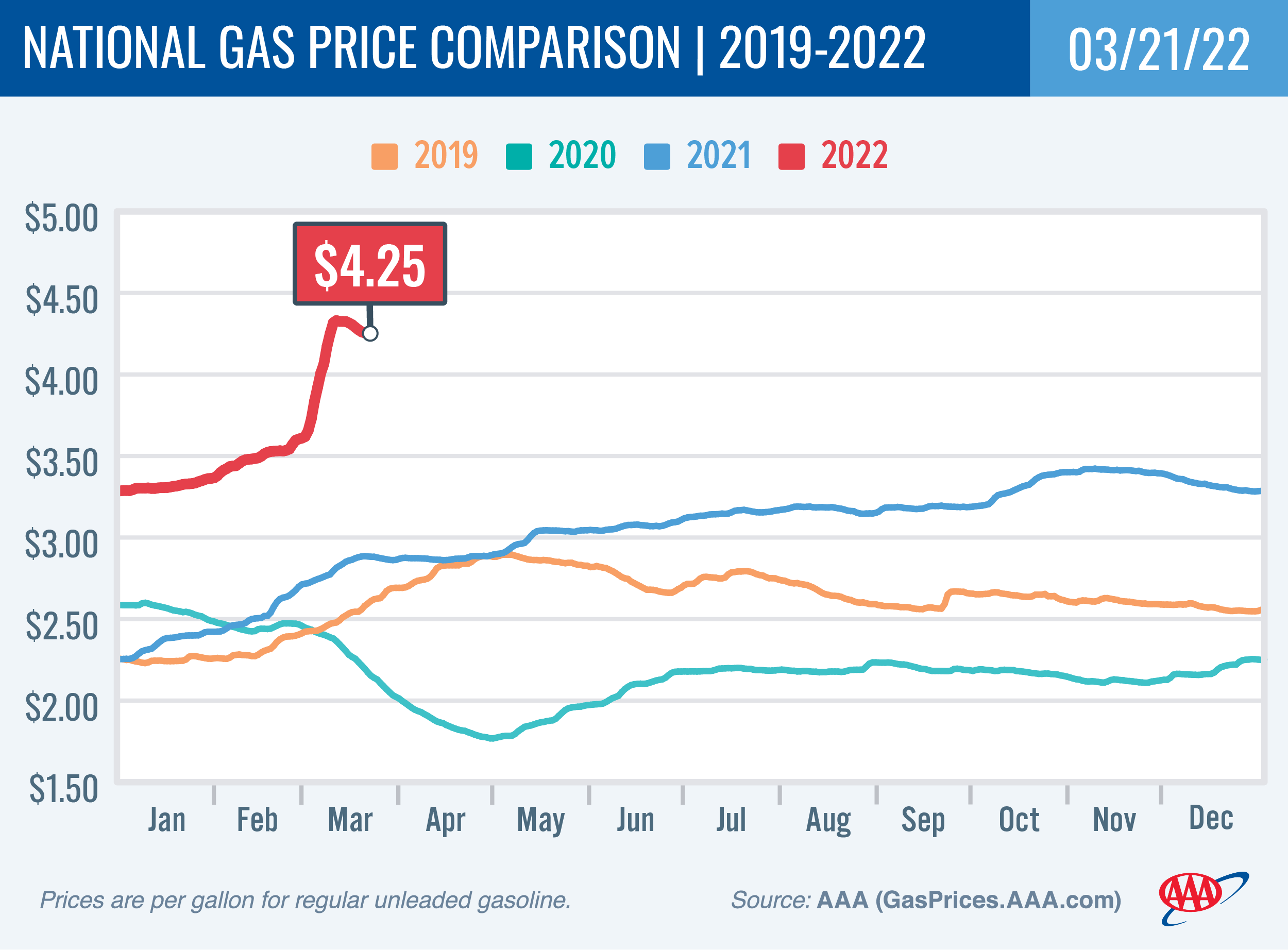
Diesel
For the week, the national average falls eight cents to $5.04 a gallon. Oregon’s average slips a nickel to $5.33. Both averages are slightly lower than the record highs reached in the last week. A year ago the national average for diesel was $3.11 and the Oregon average was $3.18.
Find current fuel prices at GasPrices.AAA.com.
AAA news releases, high resolution images, broadcast-quality video, fact sheets and podcasts are available on the AAA NewsRoom at NewsRoom.AAA.com.
Find local news releases at https://oregon.aaa.com/community/media/media-contacts.html
Fuel prices are updated daily at AAA’s Daily Fuel Gauge at AAA Gas Prices. For more info go www.AAA.com. AAA Oregon/Idaho provides more than 850,000 members with travel, insurance, financial and automotive-related services, and is an affiliate of AAA National, serving more than 62 million motorists in North America.
Updated 3/15/2022
Falling Oil Prices Put the Brakes on Surging Pump Prices for Now
PORTLAND, Ore., – After cresting above $123 per barrel shortly after Russia’s invasion of Ukraine, the price of crude oil has gradually fallen below $100 per barrel. If this trend holds, it may reduce some of the extreme upward price pressure consumers have found at the pumps, but not all. Prices continue to climb in 49 states, but the increases are not as dramatic as they were last week. For the week, the national average for regular adds 14 cents to $4.32. The Oregon average jumps 15 cents to $4.74.
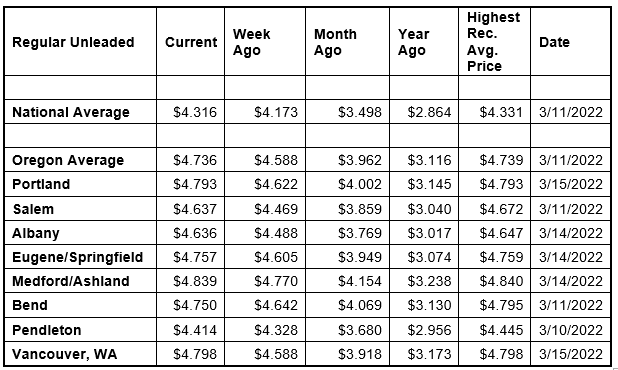
Last week the national average shot up 54 cents while the Oregon average jumped 55 cents. Both averages are slightly lower than their record highs set last week. The national average peaked at $4.33 on March 11 while the Oregon average peaked at $4.739 on March 11. These prices eclipse the old record highs set in 2008 when the national average peaked at $4.11 on July 17, and the Oregon average peaked at $4.29 on July 3.
“The violent invasion of Ukraine by Russia continues to impact an already tight global crude oil market, making it impossible to predict if pump prices have peaked or will surge again. It all depends on the direction of oil prices,” says Marie Dodds, public affairs director for AAA Oregon/Idaho.
On average, about 53% of what we pay for in a gallon of gasoline is for the price of crude oil,12% is refining, 21% distribution and marketing, and 15% are taxes, according to the U.S. Energy Information Administration.
About 3% of oil, and a total of 8% of oil and refined products used in the U.S. last year came from Russia, while about 25% of Europe’s oil is imported from Russia. The U.S. is the largest oil producer in the world. Other top producers are Saudi Arabia and Russia.
U.S. gasoline demand rose slightly from 8.74 million b/d to 8.96 million b/d. Total domestic gasoline stocks decreased by 1.4 million bbl to 244.6 million bbl last week, according to the U.S. Energy Information Administration (EIA). The increase in gas demand and a reduction in total supply contribute to rising pump prices. But increasing oil prices play the lead role in pushing gas prices higher.
Quick stats
Oregon is one of 49 states and the District of Columbia with higher prices now than a week ago. Utah (+35 cents) has the largest weekly increase. New Jersey (+5 cents) has the smallest. Last week, the increases ranged from 15 to 66 cents. Oregon (+15 cents) has the 17th-largest weekly increase in the nation. Delaware (-3 cents) is the only state with a week-over-week decline.
California ($5.75) is the most expensive state in the nation and is the first state to ever have an average above $5 a gallon. There are 38 states and the District of Columbia with an average at or above $4 a gallon.
The cheapest gas in the nation is in Kansas ($3.81) and Missouri ($3.83). This week no states have averages below $3 a gallon, same as a week ago. For the 62nd week in a row, no state has an average below $2 a gallon.
All 50 states and the District of Columbia have higher prices now than a month ago. The national average is 82 cents more and the Oregon average is 77 cents more than a month ago. This is the 28th– largest monthly increase in the nation. Nevada (+$1.06) has the largest month-over-month increase. Hawaii (+53 cents) has the smallest.
All 50 states and the District of Columbia have higher prices now than a year ago, and all have a current average that’s a dollar or more higher than a year ago. The national average is $1.45 more and the Oregon average is $1.62 more than a year ago. This is the fourth-largest yearly increase in the nation. California (+$1.91) has the biggest yearly increase. Nebraska (+$1.10 cents) has the smallest year-over-year increase.
West Coast
The West Coast region continues to have the most expensive pump prices in the nation with all seven states in the top 10. This is typical for the West Coast as this region tends to consistently have fairly tight supplies, consuming about as much gasoline as is produced.
| Rank | Region | Price on 3/15/22 | ||
| 1 | California | $5.75 | ||
| 2 | Hawaii | $5.00 | ||
| 3 | Nevada | $4.96 | ||
| 4 | Washington | $4.74 | ||
| 5 | Alaska | $4.74 | ||
| 6 | Oregon | $4.74 | ||
| 7 | Arizona | $4.61 | ||
| 8 | Illinois | $4.56 | ||
| 9 | District of Columbia | $4.52 | ||
| 10 | Connecticut | $4.46 |
California is the most expensive state for the 60th week in a row with Hawaii, Nevada, Washington, Alaska, Oregon and Arizona rounding out the top seven. Oregon slips to sixth after two weeks at fourth.
Like the rest of the country, all seven states have weekly increases: Arizona (+32 cents) has the largest in the region while Oregon (+15 cents) has the smallest week-over-week increase in the region.
The refinery utilization rate on the West Coast increased from 79.5% to 81.2% for the week ending March 4. The rate has ranged between about 76% and 88% in the last year.
According to EIA’s latest weekly report, total gas stocks in the region rose slightly from 29.99 million bbl. to 30.12 million bbl.
The upticks in the refinery utilization rate and gasoline stocks should help keep prices from climbing as dramatically in the region this week.
Oil market dynamics
Crude prices surged then eased last week in response to President Biden and other nations announcing a ban of Russian energy imports, including crude oil. Crude prices have eased as the market continues to find replacement barrels of oil and further supply growth for the tight market becomes apparent. However, the market remains volatile and additional disruptions or escalation of the current crisis in Ukraine could cause prices to surge again this week. Additionally, EIA reported that total domestic crude stocks decreased by 1.8 million bbl last week to 411.6 million bbl. The current stock level is approximately 17% lower than at the end of February 2021, contributing to pressure on domestic crude prices.
At the close of Friday’s formal trading session, WTI increased by $3.31 to settle at $109.33. At Monday’s formal trading session, WTI lost $6.32 to close at $103.01. Today crude is trading around $95, compared to $124 a week ago. Crude prices are about $37 more than a year ago.
Drivers can find current gas prices along their route with the free AAA Mobile app for iPhone, iPad and Android. The app can also be used to map a route, find discounts, book a hotel and access AAA roadside assistance. Learn more at AAA.com/mobile.
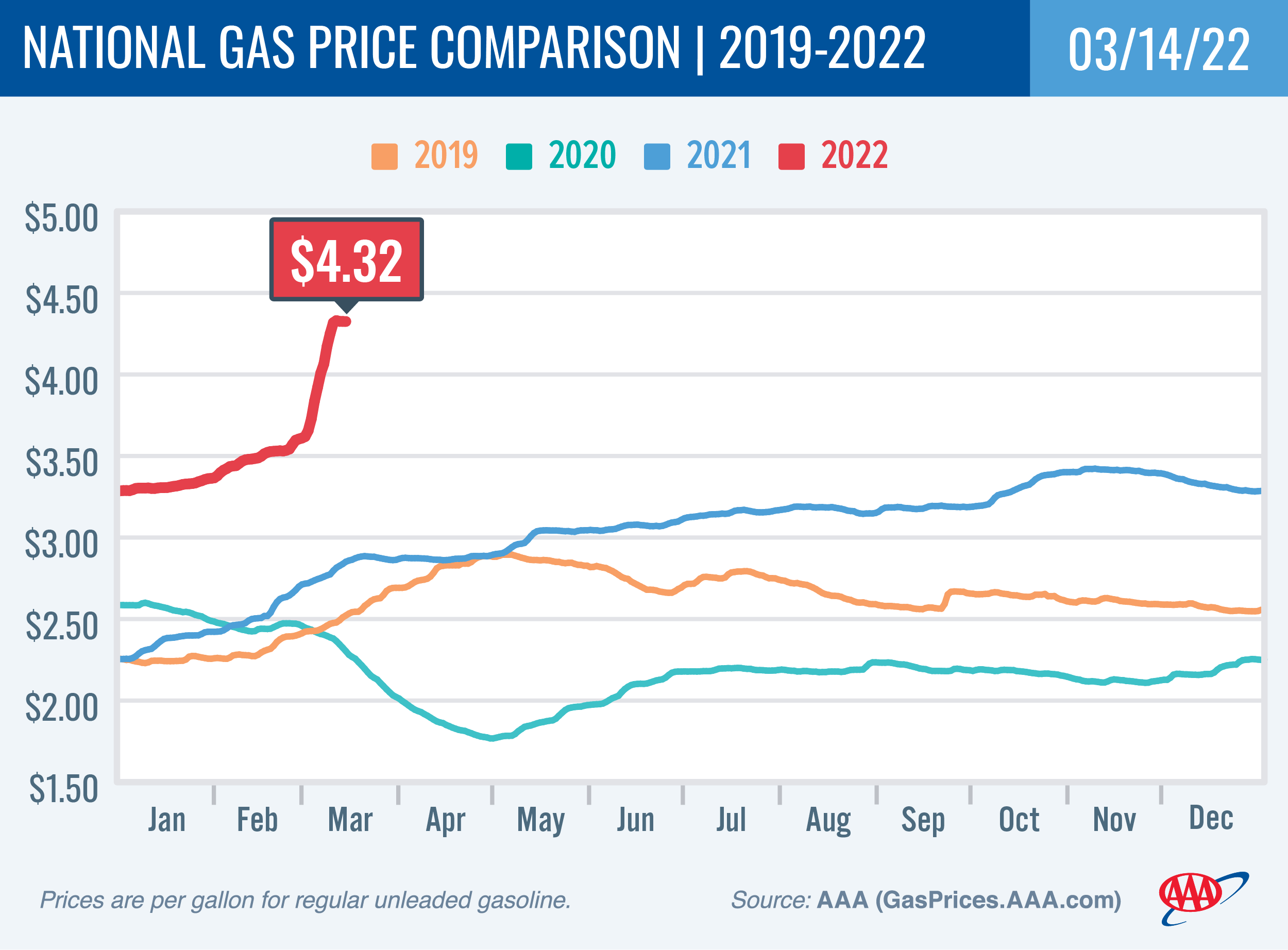
Diesel
For the week, the national average climbs 36 cents to $5.12 a gallon. Oregon’s average jumps 45 cents to $5.38. Both averages are slightly lower than the record highs reached in the last week. A year ago the national average for diesel was $3.08 and the Oregon average was $3.14.
Find current fuel prices at GasPrices.AAA.com.
AAA news releases, high resolution images, broadcast-quality video, fact sheets and podcasts are available on the AAA NewsRoom at NewsRoom.AAA.com.
Find local news releases at https://oregon.aaa.com/community/media/media-contacts.html
Fuel prices are updated daily at AAA’s Daily Fuel Gauge at AAA Gas Prices. For more info go www.AAA.com. AAA Oregon/Idaho provides more than 850,000 members with travel, insurance, financial and automotive-related services, and is an affiliate of AAA National, serving more than 62 million motorists in North America.
Updated 3/8/2022
Oregon, National Averages Soar to New Record Highs
Russian Invasion of Ukraine Fuels Skyrocketing Oil, Gas Prices
PORTLAND, Ore., – Russia’s unprovoked and violent invasion of Ukraine has sent crude oil prices skyrocketing above $120/bbl, the highest price since July 2008. The soaring oil prices have sent gas prices to new record highs, breaking records set in 2008. All 50 states are seeing dramatic increases in gas prices. For the week, the national average for regular jumps 54 cents to $4.17 a gallon. The Oregon average shoots up 55 cents to $4.59.
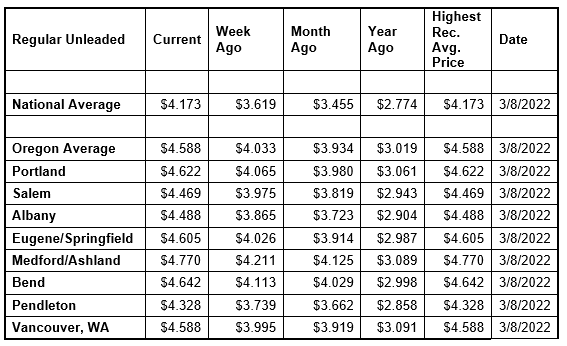
These prices eclipse the old record highs set in 2008 when the national average peaked at $4.11 on July 17, and the Oregon average peaked at $4.29 on July 3.
Today President Biden announced a U.S. ban on Russian oil imports. The President said this has strong bipartisan support in Congress as Americans rally to support the Ukrainian people, and that this and other sanctions have wreaked havoc on the Russian economy. But President Biden says there will be costs as well here in the U.S., including even higher gas prices which hurt American families.
The United Kingdom also announced it will phase out Russian oil imports by the end of the year. The European Union has also outlined a plan to stop using Russian energy.
About 8% of oil used in the U.S. last year came from Russia, while about 25% of Europe’s oil is imported from Russia. The U.S. is the largest oil producer in the world. Other top producers are Saudi Arabia and Russia.
Last week, the International Energy Agency (IEA) announced a coordinated release of crude oil from its 31 member countries’ strategic reserves, including the U.S., Germany, Canada, South Korea, and Mexico, to help counter the impact of rising crude prices. On Friday, IEA said member states committed to releasing a total of 61.7 million bbl from their strategic reserves to reassure markets roiled by the fallout from Russia’s invasion of Ukraine. This amount—half of which is expected to come from the U.S.—is the largest coordinated release since IEA was founded in 1974.
“Drivers are experiencing pain at the pumps, and its impossible to predict how high prices might go, as a war rages in Europe. Besides the tragic human toll, the Russian invasion of Ukraine is having economic consequences here at home and around the world,” says Marie Dodds, public affairs director for AAA Oregon/Idaho.
Traditionally, gas prices jump in March and April, as the switch to summer-blend fuels occurs and the spring and summer travel season heat up.
U.S. gasoline demand rose slightly from 8.66 million b/d to 8.74 million b/d. Total domestic gasoline stocks decreased by 500,000 bbl to 246 million bbl last week, according to the U.S. Energy Information Administration (EIA). The increase in gas demand and a reduction in total supply contribute to rising pump prices. But the major driver is rising oil prices. Consumers can expect gas prices to keep climbing as long as crude prices rise.
Quick stats
All 50 states and the District of Columbia have significant increases for the week. Virginia (+66 cents) has the largest weekly increase. Hawaii (+15 cents) has the smallest. Oregon (+55 cents) has the 27th-largest increase in the nation.
California ($5.44) is the most expensive state in the nation and is the first state to ever have an average above $5 a gallon. There are 28 states and the District of Columbia with an average at or above $4 a gallon.
The cheapest gas in the nation is in Oklahoma ($3.72) and Missouri ($3.73). This week no states have averages below $3 a gallon, same as a week ago. For the 61st week in a row, no state has an average below $2 a gallon.
All 50 states and the District of Columbia have higher prices now than a month ago. The national average is 72 cents more and the Oregon average is 65 cents more than a month ago. This is the 33rd– largest monthly increase in the nation. Delaware (+83 cents) has the largest month-over-month increase. Hawaii (+30 cents) has the smallest.
All 50 states and the District of Columbia have higher prices now than a year ago, and all have a current average that’s a dollar or more higher than a year ago. The national average is $1.40 more and the Oregon average is $1.57 more than a year ago. This is the third-largest yearly increase in the nation. California (+$1.69) has the biggest yearly increase. Nebraska (+$1.04 cents) has the smallest year-over-year increase.
West Coast
The West Coast region continues to have the most expensive pump prices in the nation with every state except Arizona in the top 10.
| Rank | Region | Price on 3/8/22 | ||
| 1 | California | $5.44 | ||
| 2 | Hawaii | $4.72 | ||
| 3 | Nevada | $4.67 | ||
| 4 | Oregon | $4.59 | ||
| 5 | Washington | $4.55 | ||
| 6 | Alaska | $4.50 | ||
| 7 | Illinois | $4.43 | ||
| 8 | New York | $4.37 | ||
| 9 | Connecticut | $4.36 | ||
| 10 | District of Columbia | $4.35 |
California is the most expensive state for the 59th week in a row with Hawaii, Nevada, Oregon, Washington, and Alaska rounding out the top six. Arizona is 12th. Oregon is fourth for the second week in a row.
Like the rest of the country, all seven states have weekly increases: Nevada (+64 cents) has the largest in the region while Hawaii (+15 cents) has the smallest week-over-week increase in the region and the nation.
The refinery utilization rate on the West Coast is relatively steady, going from79.9% to 79.5% for the week ending February 25. The rate has ranged between about 76% and 88% in the last year.
According to EIA’s latest weekly report, total gas stocks in the region rose slightly from 29.88 million bbl. to 29.99 million bbl.
Oil market dynamics
Crude prices continue to surge in response to the invasion of Ukraine by Russia. As the conflict continues, the oil markets will likely respond this week by increasing the price of crude oil to reflect more risk of disruption to tight global oil supplies. Additionally, EIA reported that total domestic crude stocks decreased by 2.6 million bbl last week to 413.4 million bbl. The current stock level is approximately 15% lower than at the end of February 2021, contributing to pressure on domestic crude prices.
At the close of Friday’s formal trading session, WTI increased by $8.01 to settle at $115.68. At Monday’s formal trading session, WTI rose $3.72 to close at $119.40. Today crude is trading around $127, compared to $103 a week ago. Crude prices are about $61 more than a year ago.
Drivers can find current gas prices along their route with the free AAA Mobile app for iPhone, iPad and Android. The app can also be used to map a route, find discounts, book a hotel and access AAA roadside assistance. Learn more at AAA.com/mobile.
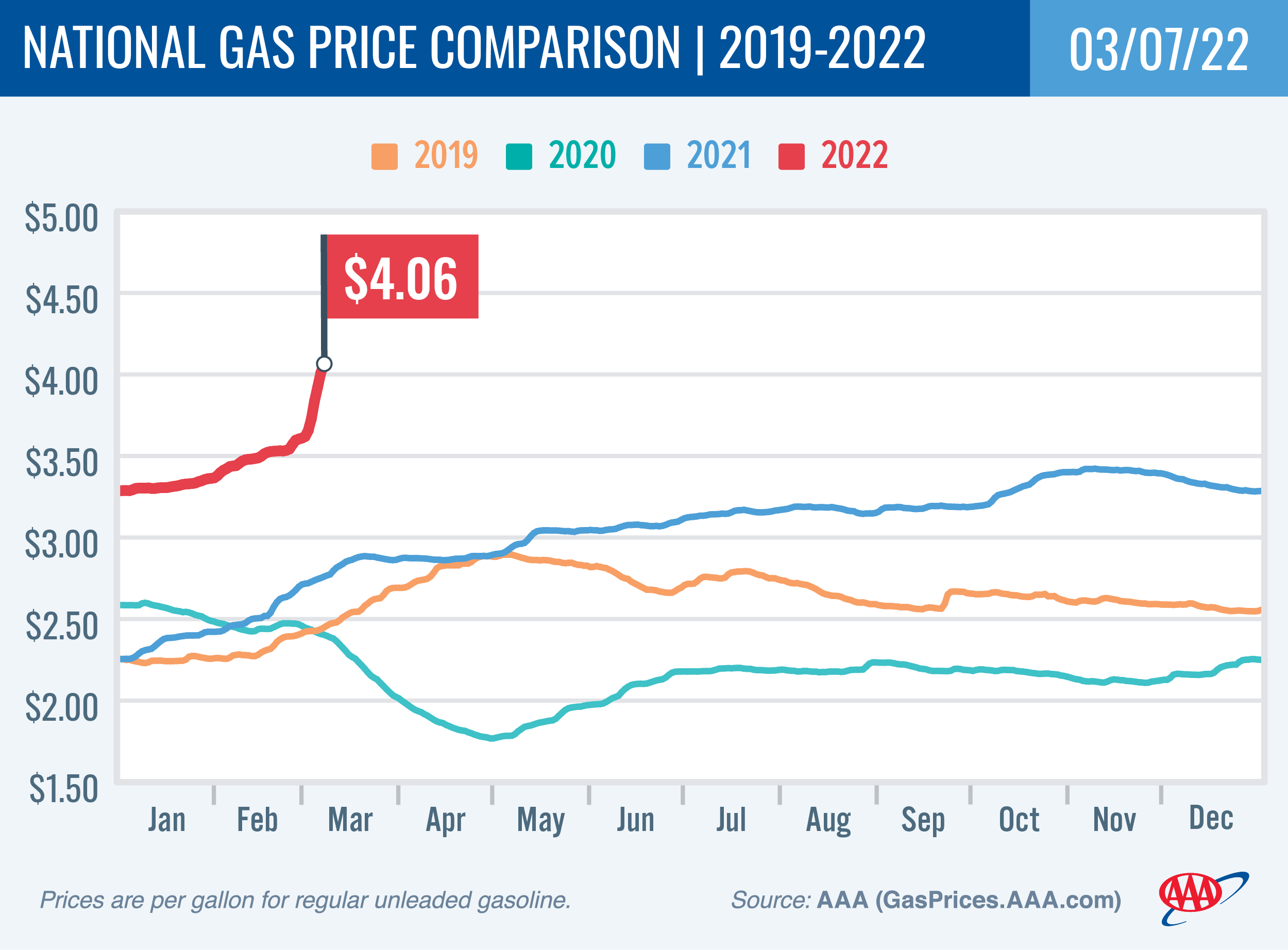
Diesel
For the week, the national average soars 74 cents to $4.76 a gallon. Oregon’s average jumps 55 cents to $4.59. A year ago the national average for diesel was $3.01 and the Oregon average was $3.05.
Find current fuel prices at GasPrices.AAA.com.
AAA news releases, high resolution images, broadcast-quality video, fact sheets and podcasts are available on the AAA NewsRoom at NewsRoom.AAA.com.
Find local news releases at https://oregon.aaa.com/community/media/media-contacts.html
Fuel prices are updated daily at AAA’s Daily Fuel Gauge at AAA Gas Prices. For more info go www.AAA.com. AAA Oregon/Idaho provides more than 850,000 members with travel, insurance, financial and automotive-related services, and is an affiliate of AAA National, serving more than 62 million motorists in North America.
Updated 3/1/2022
Russian Invasion of Ukraine Results in Surging Oil, Gas Prices
PORTLAND, Ore., – Russia’s violent invasion of Ukraine has rocked the global oil market, with crude spiking above $100/bbl, a price last seen in July 2014. The increase in the price of oil has led to higher pump prices in the U.S. with gas prices climbing in all 50 states. For the week, the national average for regular jumps nine cents to $3.62 a gallon. The Oregon average rises a nickel to $4.03.
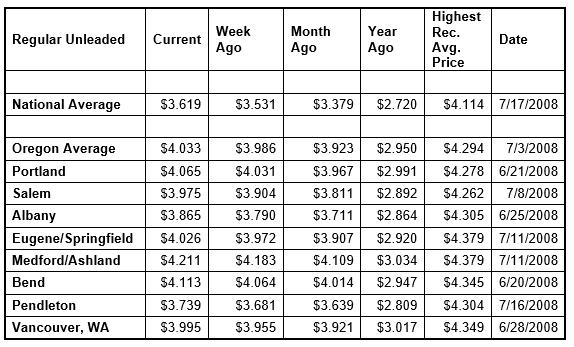
The Oregon average gas price climbed above $4 a gallon last Thursday, Feb. 24, for the first time since October 2012. The national average is at its highest price since July 2014.
“Russia’s invasion of Ukraine and the responding escalating series of financial sanctions by the U.S. and its allies have given the global oil market the jitters with crude climbing above $100 per barrel. Like the U.S. stock market, the oil market responds poorly to volatility and the unknown. It’s a grim reminder that tragic events on the other side of the globe can impact people around the world, including American consumers,” says Marie Dodds, public affairs director for AAA Oregon/Idaho.
Russia is one of the top three oil producers in the world, along with the U.S. and Saudi Arabia. Russia produces about 10 million barrels a day. There are concerns that with the severe economic sanctions that the U.S. and other western nations have imposed on Russia, that it could retaliate by withholding oil from the global market. Europe, in particular, depends on oil from Russia. The world oil market is facing the same factors as many other industries – tight supplies and higher demand as economies around the world emerge from COVID-related economic slowdowns.
Crude is about $105 per barrel today, about $44 higher than a year ago. On average, about 53% of what we pay for in a gallon of gasoline is for the price of crude oil,12% is refining, 21% distribution and marketing, and 15% are taxes, according to the U.S. Energy Information Administration.
U.S. gasoline demand rose slightly from 8.57 million b/d to 8.66 million b/d. Total domestic gasoline stocks decreased by 600,000 bbl to 246.5 million bbl last week, according to the U.S. Energy Information Administration (EIA). The increase in gas demand and a reduction in total supply contribute to rising pump prices. But increasing oil prices play the lead role in pushing gas prices higher. Pump prices will likely continue to rise as crude prices continue to climb.
Travel continues to be impacted by the coronavirus pandemic. Find AAA’s latest COVID-19 information for travelers here.
Quick stats
All 50 states and the District of Columbia have higher prices now than a week ago. Michigan (+21 cents) has the largest weekly increase. Idaho (+2 cents) has the smallest. Oregon (+5 cents) has the 37th-largest increase in the nation.
California ($4.84) and Hawaii ($4.57) continue to have the most expensive gas prices in the country. They are joined by Nevada, Oregon and Washington which are the other states in the nation with averages above $4 a gallon. while all 50 states and the District of Columbia have averages above $3 a gallon.
The cheapest gas in the nation is in Arkansas ($3.24) and Mississippi ($3.27). This week no states have averages below $3 a gallon, same as a week ago. For the 60th week in a row, no state has an average below $2 a gallon.
All 50 states and the District of Columbia have higher prices now than a month ago. The national average is 24 cents more and the Oregon average is 11 cents more than a month ago. This is the 6th– smallest monthly increase in the nation. North Carolina (+40 cents) has the largest month-over-month increase. Idaho (+2 cents) has the smallest.
All 50 states and the District of Columbia have higher prices now than a year ago, and six states, including Oregon, have a current average that’s a dollar or more higher than a year ago. The national average is 90 cents more and the Oregon gas price average is $1.08 more than a year ago. This is the third-largest yearly increase in the nation. California (+$1.15) has the biggest yearly increase. West Virginia (+65 cents) has the smallest year-over-year increase.
West Coast
The West Coast region continues to have the most expensive pump prices in the nation with all seven states in the region in the top 10.
| Rank | Region | Price on 3/1/22 | ||
| 1 | California | $4.84 | ||
| 2 | Hawaii | $4.57 | ||
| 3 | Nevada | $4.04 | ||
| 4 | Oregon | $4.03 | ||
| 5 | Washington | $4.01 | ||
| 6 | Alaska | $3.90 | ||
| 7 | Illinois | $3.87 | ||
| 8 | Arizona | $3.82 | ||
| 9 | New York | $3.81 | ||
| 10 | District of Columbia | $3.79 |
California is the most expensive state for the 58th week in a row with Hawaii, Nevada, Oregon, Washington, and Alaska rounding out the top six. Arizona is eighth. Oregon slips to fourth after two weeks at third.
Like the rest of the country, all seven states have weekly increases: Arizona (+11 cents) has the largest in the region while Washington (+3 cents) has the smallest.
The refinery utilization rate on the West Coast fell from 82.6% to 79.9% for the week ending February 18. The rate has ranged between about 76% and 88% in the last year.
According to EIA’s latest weekly report, total gas stocks in the region fell from 31.8 million bbl. To 29.88 million bbl.
Oil market dynamics
Although crude prices saw some fluctuations on Friday, they surged after Russia launched its military invasion of Ukraine earlier in the week. As the conflict continues, the oil markets will likely respond by continuing to increase the price of crude oil to reflect more risk of disruption to tight global oil supplies this week. Additionally, EIA reported that total domestic crude stocks increased by 4.5 million bbl to 416 million bbl. The current stock level is approximately 10 percent lower than mid-February 2021, contributing to pressure on domestic crude prices.
At the close of Friday’s formal trading session, WTI decreased by $1.22 cents to settle at $91.59. At Monday’s formal trading session, WTI jumped up $4.13 to close at $95.72. Today crude is trading around $104, compared to $92 a week ago. Crude prices are about $43 more than a year ago.
Drivers can find current gas prices along their route with the free AAA Mobile app for iPhone, iPad and Android. The app can also be used to map a route, find discounts, book a hotel and access AAA roadside assistance. Learn more at AAA.com/mobile.
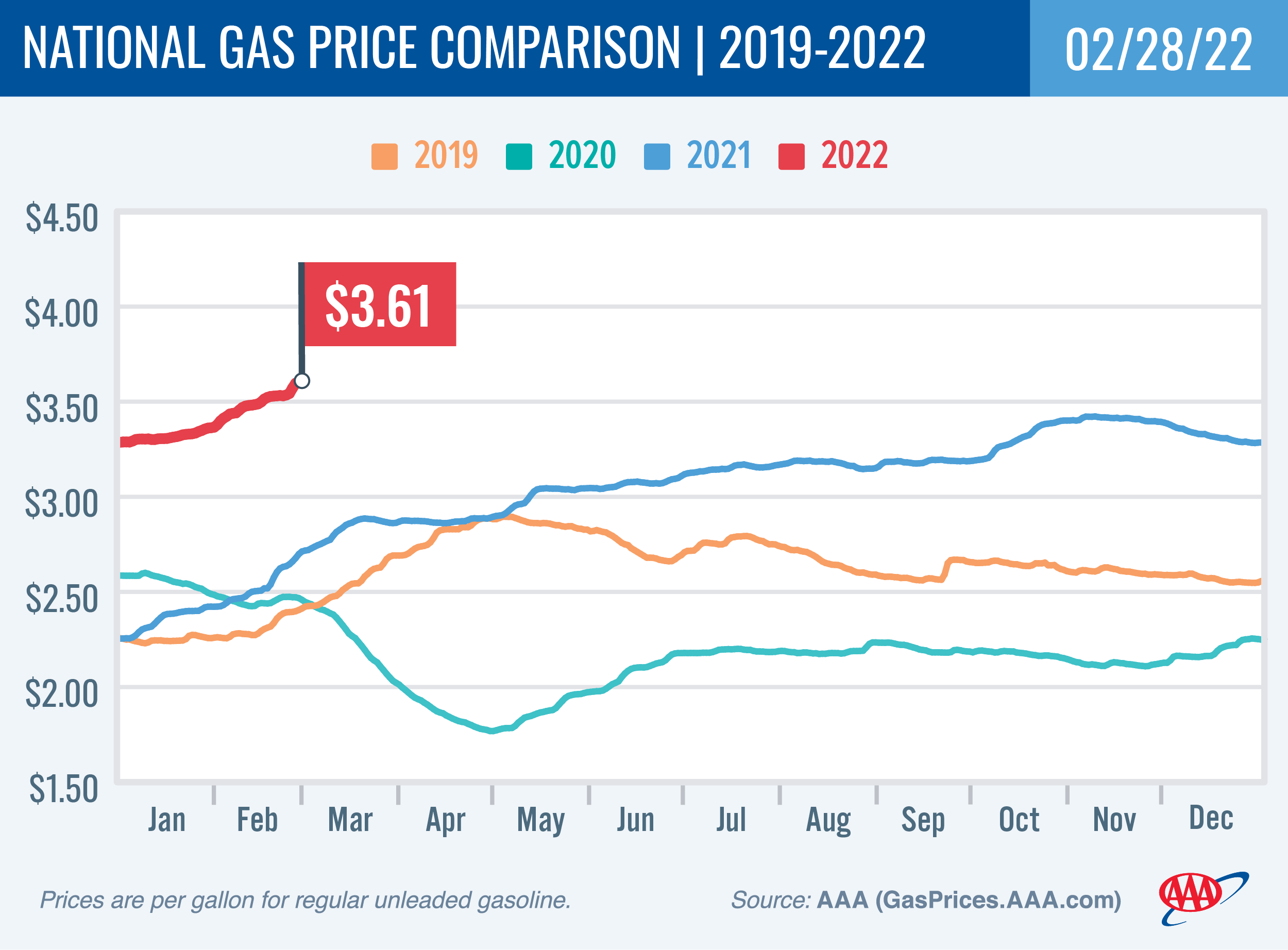
Diesel
For the week, the national average adds seven cents to $4.02 a gallon. Oregon’s average climbs three cents to $4.22. A year ago the national average for diesel was $2.94 and the Oregon average was $3.00.
Find current fuel prices at GasPrices.AAA.com.
AAA news releases, high resolution images, broadcast-quality video, fact sheets and podcasts are available on the AAA NewsRoom at NewsRoom.AAA.com.
Find local news releases at https://oregon.aaa.com/community/media/media-contacts.html
Fuel prices are updated daily at AAA’s Daily Fuel Gauge at AAA Gas Prices. For more info go www.AAA.com. AAA Oregon/Idaho provides more than 850,000 members with travel, insurance, financial and automotive-related services, and is an affiliate of AAA National, serving more than 62 million motorists in North America.
Updated 2/22/2022
Russia-Ukraine Escalation sends Crude Oil to eight-year Highs
Gas Prices Continue to March Higher
PORTLAND, Ore., – The potential invasion of Ukraine by Russia is having a rippling effect on the global oil markets, sending crude oil prices higher, which in turn is driving up the price of gasoline in the U.S. Drivers in 47 states are seeing pump prices rise. For the week, the national average for regular rises four cents to $3.53 a gallon. The Oregon gas price average adds two to $3.99.
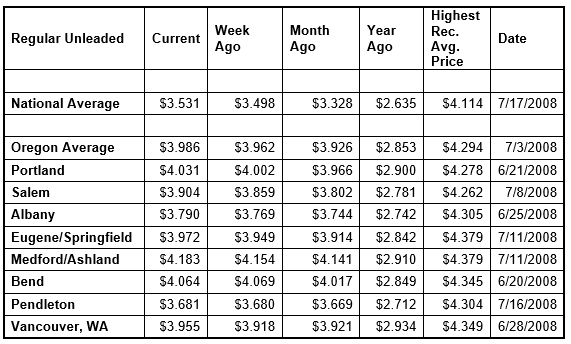
A Russian attack would be met by severe financial sanctions led by the United States and its allies. Russia will likely retaliate by withholding oil from the world market, which is already tight and struggling to keep up with demand as nations worldwide move on from COVID-related economic slowdowns.
“Russia is one of the world’s leading oil producers along with the U.S. and Saudi Arabia. If Russia chooses to take its oil from the global market, that would create even tighter supplies which would result in higher gas prices for American drivers,” says Marie Dodds, public affairs director for AAA Oregon/Idaho.
Crude remains above $90 per barrel, about $31 higher than a year ago. On average, about 53% of what we pay for in a gallon of gasoline is for the price of crude oil,12% is refining, 21% distribution and marketing, and 15% are taxes, according to the U.S. Energy Information Administration.
U.S. gasoline demand fell from 9.13 million b/d to 8.57 million b/d. Total domestic gasoline stocks decreased by 1.3 million bbl to 247.1 million bbl last week, according to the U.S. Energy Information Administration (EIA). Typically, a decrease in gas demand during the winter would put downward pressure on pump prices, but elevated crude prices continue to push pump prices higher.
With the Omicron variant, travel continues to be impacted by the coronavirus pandemic. Find AAA’s latest COVID-19 information for travelers here.
Quick stats
Oregon is one of 47 states and the District of Columbia where prices are higher now than a week ago. Ohio (+10 cents) has the largest weekly increase. Wisconsin and Nebraska are the only states with week-over-week declines and both are just two-tenths of a cent. The average in New Mexico is flat.
California ($4.74) and Hawaii ($4.52) continue to have the most expensive gas prices in the country and are the only states in the nation with averages above $4 a gallon, while all 50 states and the District of Columbia have averages above $3 a gallon.
The cheapest gas in the nation is in Missouri ($3.18) and Arkansas ($3.19). This week no states have averages below $3 a gallon, same as a week ago. For the 59th week in a row, no state has an average below $2 a gallon.
Oregon is one of 49 states and the District of Columbia with higher prices now than a month ago. The national average is 20 cents more and the Oregon average is six cents more than a month ago. This is the 5th– smallest monthly increase in the nation. Delaware (+36 cents) has the largest month-over-month increase. Idaho (-1 cent) is the only state with a month-over-month decline.
All 50 states and the District of Columbia have higher prices now than a year ago, and 11 states have a current average that’s a dollar or more higher than a year ago. The national average is 90 cents more and the Oregon gas price average is $1.13 more than a year ago. This is the second-largest yearly increase in the nation. California (+$1.17) has the biggest yearly increase. West Virginia (+69 cents) has the smallest year-over-year increase.
West Coast
The West Coast region continues to have the most expensive pump prices in the nation with all seven states in the region in the top 10.
| Rank | Region | Price on 2/22/22 | ||
| 1 | California | $4.74 | ||
| 2 | Hawaii | $4.52 | ||
| 3 | Oregon | $3.99 | ||
| 4 | Washington | $3.98 | ||
| 5 | Nevada | $3.96 | ||
| 6 | Alaska | $3.85 | ||
| 7 | New York | $3.75 | ||
| 8 | Pennsylvania | $3.74 | ||
| 9 | District of Columbia | $3.73 | ||
| 10 | Arizona | $3.71 |
California is the most expensive state for the 57th week in a row with Hawaii, Oregon, Washington, Nevada, and Alaska rounding out the top six. Arizona is 10th. Oregon is third for the second week in a row.
All seven states have weekly increases: Nevada (+6 cents), Arizona (+5 cents), Hawaii (+5 cents), Alaska (+3 cents), California (+3 cents), Oregon (+2 cents), and Washington (+2 cents).
The refinery utilization rate on the West Coast rose from 77% to 82.6% for the week ending February 11. The rate has ranged between about 76% and 88% in the last year.
According to EIA’s latest weekly report, total gas stocks in the region show a small decrease from 31.94 million bbl. To 31.18 million bbl.
Oil market dynamics
Although crude prices declined at the end of last week due to increased market expectations that more oil could enter the global market if the U.S. and Iran complete a new nuclear agreement, and related sanctions are lifted, the tension between Russia and Ukraine contributed to rising oil prices earlier in the week. Additionally, EIA reported that total domestic crude stocks increased by 1.1 million bbl to 411.5 million bbl. The current stock level is approximately 11 percent lower than mid-February 2021, contributing to pressure on domestic crude prices. For this week, crude prices could climb if EIA’s next report shows a decrease in total stocks.
At the close of Friday’s formal trading session, WTI slipped 69 cents to settle at $91.07. U.S. markets were closed yesterday for President’s Day. Today crude is trading around $92, compared to $92 a week ago. Crude prices are about $31 more than a year ago.
Drivers can find current gas prices along their route with the free AAA Mobile app for iPhone, iPad and Android. The app can also be used to map a route, find discounts, book a hotel and access AAA roadside assistance. Learn more at AAA.com/mobile.
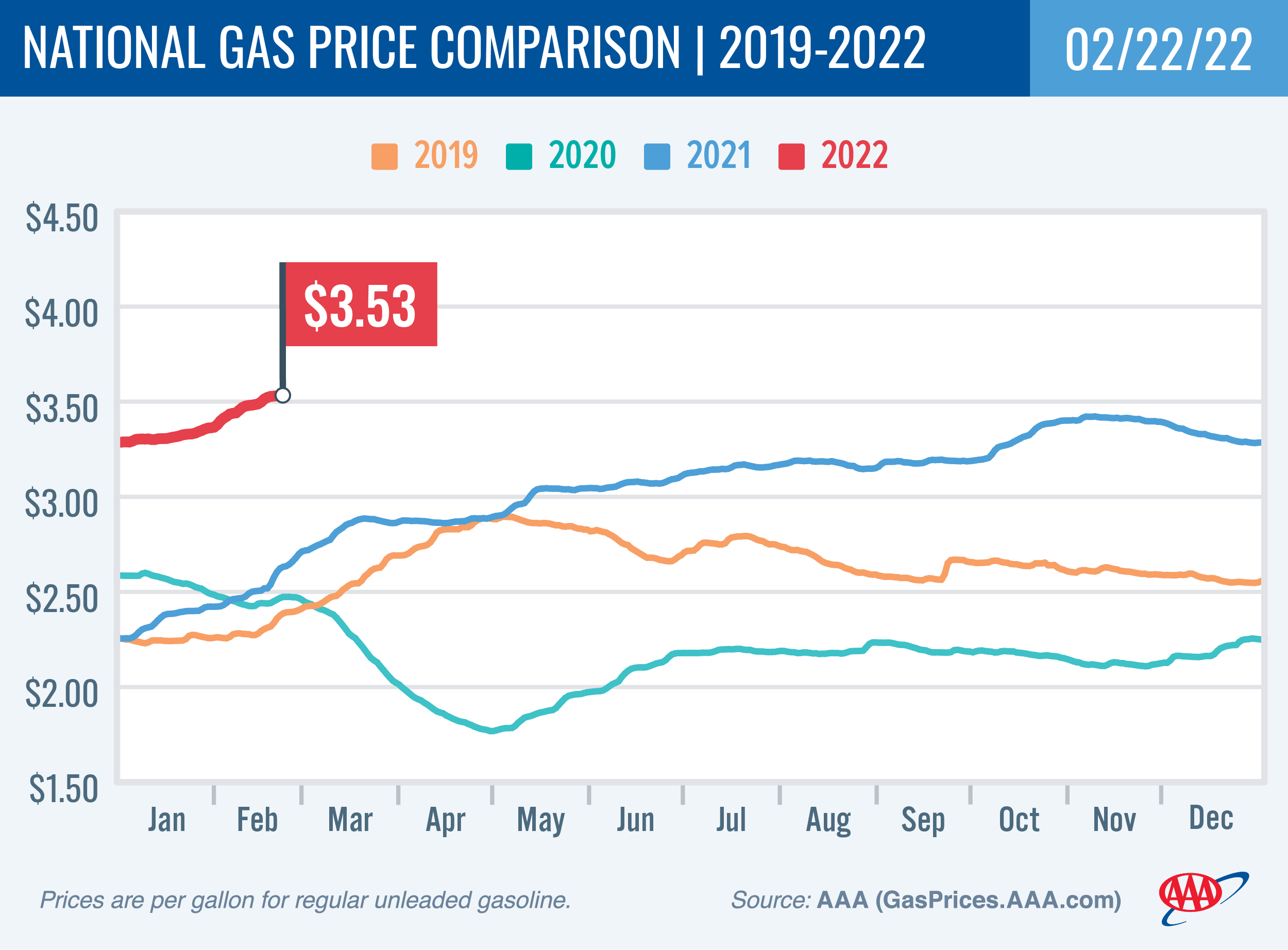
Diesel
For the week, the national average climbs four cents to $3.95 a gallon. Oregon’s average rises two cents to $4.19. A year ago the national average for diesel was $2.85 and the Oregon average was $2.91.
Find current fuel prices at GasPrices.AAA.com.
AAA news releases, high resolution images, broadcast-quality video, fact sheets and podcasts are available on the AAA NewsRoom at NewsRoom.AAA.com.
Find local news releases at https://oregon.aaa.com/community/media/media-contacts.html
Fuel prices are updated daily at AAA’s Daily Fuel Gauge at AAA Gas Prices. For more info go www.AAA.com. AAA Oregon/Idaho provides more than 850,000 members with travel, insurance, financial and automotive-related services, and is an affiliate of AAA National, serving more than 62 million motorists in North America.
Updated 2/15/2022
No Love at the Pumps for Drivers
Gas Prices Continue to Climb
PORTLAND, Ore., – Geopolitical tensions surrounding Russia and whether it will invade Ukraine continue to keep crude oil prices elevated. Crude has surged above $90 per barrel, about $36 higher than a year ago. This is the major driver of higher pump prices, as about 53% of what we pay for in a gallon of gasoline is for the price of crude oil. For the week, the national average for regular rises four cents to $3.50 a gallon. The Oregon average gains three cents to $3.98.
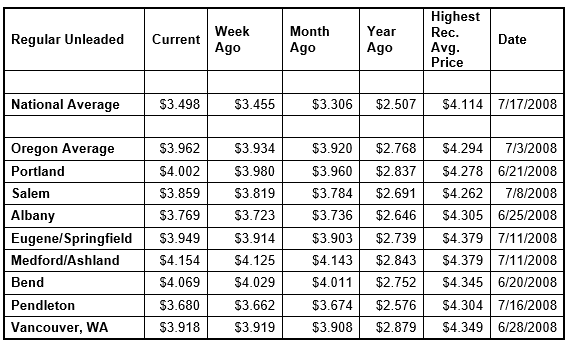
The national average is at its highest price since August 2014; the Oregon average gas price is the highest since July 2014.
Other factors contributing to higher pump prices include rising demand and shrinking supplies of gas in the U.S. Moderating winter weather and optimism over a potential fading of the omicron variant have led to the increase in gas demand.
“More drivers fueling up combined with a persistent tight supply of oil around the globe provide the recipe for higher pump prices. Unfortunately for consumers, it does not appear that this trend will change anytime soon,” says Marie Dodds, public affairs director for AAA Oregon/Idaho.
On average, about 53% of what we pay for in a gallon of gasoline is for the price of crude oil. 12% is refining, 21% distribution and marketing, and 15% are taxes, according to the U.S. Energy Information Administration.
The concern that Russia will react to potential western sanctions by withholding crude oil from the already tight global market puts heavy upward pressure on oil prices. Russia is a member of OPEC+, and any sanctions based on Russia’s actions toward Ukraine may cause it to withhold crude oil from the global market.
The price of crude oil has risen dramatically in the last two months. It was about $65 per barrel on December 1 compared to $91 today on February 15. Oil supplies were already tight and demand is expected to increase this year as global economies emerge from the coronavirus pandemic.
U.S. gasoline demand rose from 8.23 million b/d to 9.13 million b/d. Total domestic gasoline stocks dropped by 1.6 million bbl to 248.4 million bbl last week, according to the U.S. Energy Information Administration (EIA). A decrease in total stocks and increased demand have contributed to upward pressure on pump prices, but rising crude prices continue to play the dominant role in pushing pump prices higher. Gas prices will likely increase as demand grows and crude oil prices remain above $90 per barrel.
With the Omicron variant, travel continues to be impacted by the coronavirus pandemic. Find AAA’s latest COVID-19 information for travelers here.
Quick stats
Oregon is one of 45 states and the District of Columbia where prices are higher now than a week ago. Delaware (+15 cents) has the largest weekly increase. Ohio (-3 cents) has the largest week-over-week decline.
California ($4.71) and Hawaii ($4.47) continue to have the most expensive gas prices in the country and are the only states in the nation with averages above $4 a gallon, while all 50 states and the District of Columbia have averages above $3 a gallon.
The cheapest gas in the nation is in Mississippi ($3.16) and Missouri ($3.17). This week no states have averages below $3 a gallon, same as a week ago. For the 58th week in a row, no state has an average below $2 a gallon.
Oregon is one of 48 states and the District of Columbia with higher prices now than a month ago. The national average is 19 cents more and the Oregon average is four cents more than a month ago. This is the 3rd– smallest monthly increase in the nation. Delaware (+33 cents) has the largest month-over-month increase. Utah (-6 cents) and Idaho (-3 cents) are the only states with month-over-month declines.
All 50 states and the District of Columbia have higher prices now than a year ago, and 22 states and D.C. have a current average that’s a dollar or more higher than a year ago. The national average is 99 cents more and the Oregon gas price average is $1.19 more than a year ago. This is the second-largest yearly increase in the nation. California (+$1.23) has the biggest yearly increase. West Virginia (+78 cents) has the smallest year-over-year increase.
West Coast
The West Coast region continues to have the most expensive pump prices in the nation with all seven states in the region in the top 10.
| Rank | Region | Price on 2/15/22 | ||
| 1 | California | $4.71 | ||
| 2 | Hawaii | $4.47 | ||
| 3 | Oregon | $3.96 | ||
| 4 | Washington | $3.96 | ||
| 5 | Nevada | $3.90 | ||
| 6 | Alaska | $3.82 | ||
| 7 | District of Columbia | $3.72 | ||
| 8 | New York | $3.70 | ||
| 9 | Pennsylvania | $3.69 | ||
| 10 | Arizona | $3.66 |
California is the most expensive state for the 56th week in a row with Hawaii, Oregon, Washington, Nevada, and Alaska rounding out the top six. Arizona is 10th. Oregon moves up to third after five weeks at fourth.
All seven states have weekly increases. Hawaii (+5 cents) has the largest weekly increase in the region. Washington (+1/2 cent) has the smallest weekly increase in the region.
The refinery utilization rate on the West Coast fell from 79.3% to 77% for the week ending February 4. The rate has ranged between about 76% and 88% in the last year.
According to EIA’s latest weekly report, total gas stocks in the region show a small decrease from 31.96 million bbl. to 31.94 million bbl.
Oil market dynamics
The tension between Russia and Ukraine continues to contribute to rising oil prices. Russia is a member of OPEC+, and any sanctions based on their actions toward Ukraine may cause it to withhold crude oil from the global market. Additionally, EIA reported that total domestic crude stocks decreased by 4.7 million bbl to 410.4 million bbl. The current stock level is approximately 13 percent lower than at the beginning of February 2021, contributing to pressure on domestic crude prices. If tension between Russia and Ukraine continues this week or EIA’s next report shows another inventory decline, crude prices could continue to rise.
At the close of Friday’s formal trading session, WTI increased by $3.22 to settle at $93.10. To At the close of Monday’s formal trading session, WTI soared $2.36 to settle at $95.46. Today crude is trading around $92, compared to $89 a week ago. Crude prices are about $36 more than a year ago.
Drivers can find current gas prices along their route with the free AAA Mobile app for iPhone, iPad and Android. The app can also be used to map a route, find discounts, book a hotel and access AAA roadside assistance. Learn more at AAA.com/mobile.
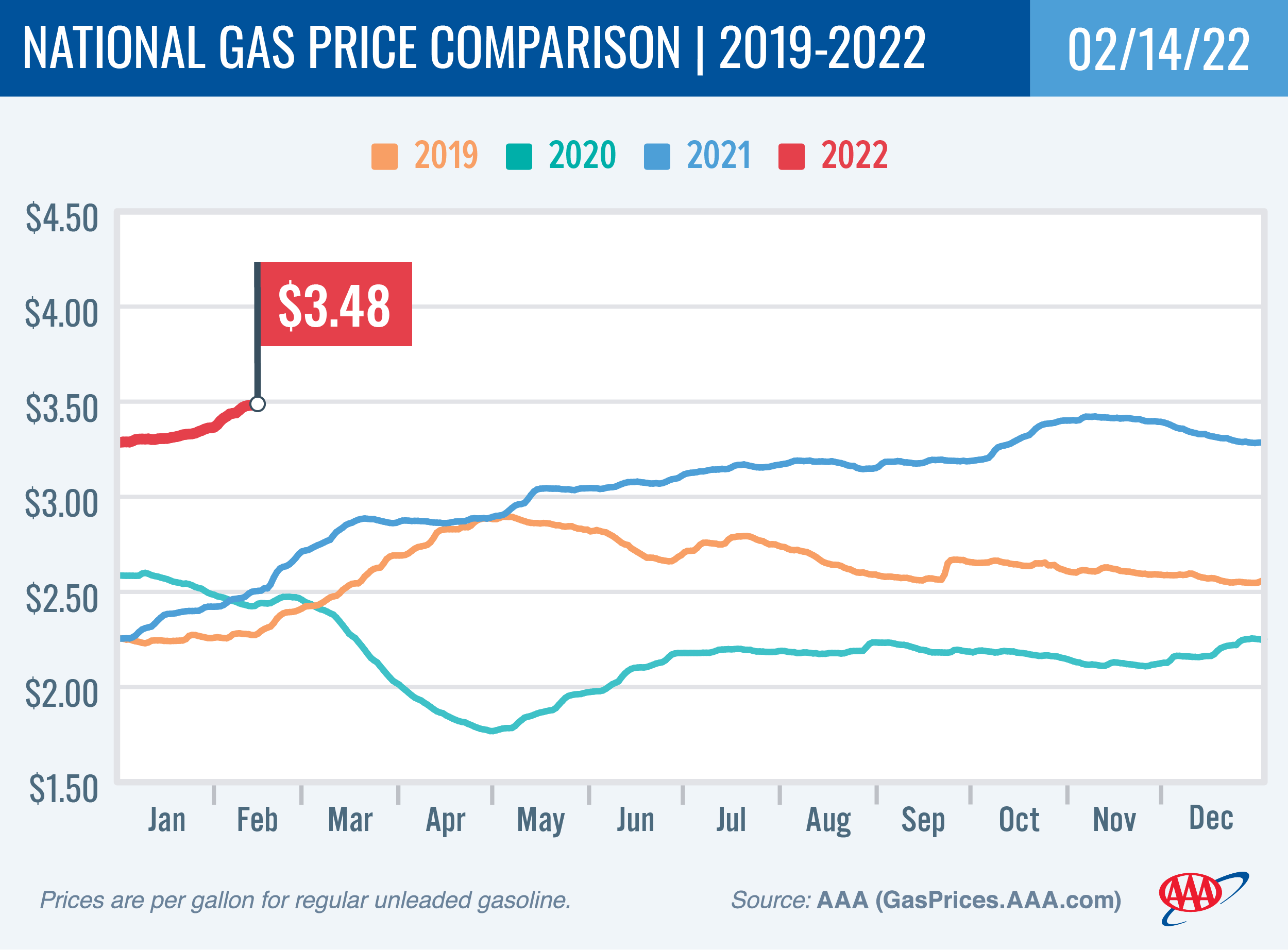
Diesel
For the week, the national average jumps seven cents to $3.91 a gallon. Oregon’s average adds a penny to $4.17. A year ago the national average for diesel was $2.76 and the Oregon average was $2.83.
Find current fuel prices at GasPrices.AAA.com.
AAA news releases, high resolution images, broadcast-quality video, fact sheets and podcasts are available on the AAA NewsRoom at NewsRoom.AAA.com.
Find local news releases at https://oregon.aaa.com/community/media/media-contacts.html
Fuel prices are updated daily at AAA’s Daily Fuel Gauge at AAA Gas Prices. For more info go www.AAA.com. AAA Oregon/Idaho provides more than 850,000 members with travel, insurance, financial and automotive-related services, and is an affiliate of AAA National, serving more than 62 million motorists in North America.
Updated 2/8/2022
Gas Prices Continue to March Higher
Oregon has smallest weekly increase in the nation
PORTLAND, Ore., – Geopolitical tensions surrounding Russia and whether it will invade Ukraine are driving the price of crude oil higher. Crude has surged above $90 per barrel, nearly $30 more than last August. And winter weather in much of the U.S. has increased the demand for heating oil. These factors are causing gas prices to rise in most states but they’re not climbing as fast in Oregon. For the week, the national average for regular jumps eight cents to $3.46 a gallon. The Oregon average gas price adds a penny to $3.93. This is the smallest weekly increase in the nation.
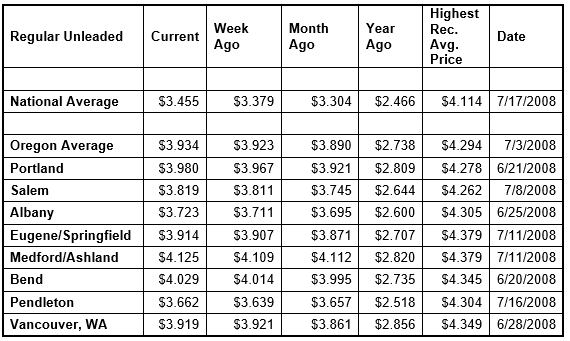
The concern that Russia will react to potential western sanctions by withholding crude oil from the already tight global market puts heavy upward pressure on oil prices. Russia is a member of OPEC+, and any sanctions based on Russia’s actions toward Ukraine may cause it to withhold crude oil from the global market.
“This shows how events on the other side of the globe and the other side of the country. can impact gas prices across the U.S. Unfortunately, drivers are reminded of this by higher pump prices,” says Marie Dodds, public affairs director for AAA Oregon/Idaho.
The price of crude oil has risen dramatically in the last two months. It was about $65 per barrel on December 1 compared to $89 today on February 8. Oil supplies were already tight and demand is expected to increase this year as global economies emerge from the coronavirus pandemic.
U.S. gasoline demand fell from 8.51 million b/d to 8.23 million b/d. Total domestic gasoline stocks grew by 2.1 million bbl to 250 million bbl last week. Usually, an increase in total stocks and a decrease in demand puts downward pressure on pump prices, but the rising cost of oil continues to push prices higher instead. If crude prices continue to climb, pump prices will likely follow suit.
With the Omicron variant, travel continues to be impacted by the coronavirus pandemic. Find AAA’s latest COVID-19 information for travelers here.
Quick stats
Oregon is one of 47 states and the District of Columbia where prices are higher now than a week ago. Oregon (+1 cent) has the smallest week-over-week increase in the nation. Ohio (+15 cents) has the largest. Utah, Idaho and Washington are the only three states with weekly declines and all are less than a penny.
California ($4.68) and Hawaii ($4.42) continue to have the most expensive gas prices in the country and are the only states in the nation with averages above $4 a gallon, while all 50 states and the District of Columbia have averages above $3 a gallon.
The cheapest gas in the nation is in Mississippi ($3.11) and Arkansas ($3.13). This week no states have averages below $3 a gallon, same as a week ago. For the 57th week in a row, no state has an average below $2 a gallon.
Oregon is one of 48 states and the District of Columbia with higher prices now than a month ago. The national average is 15 cents more and the Oregon average is four cents more than a month ago. This is the 7th-smallest monthly increase in the nation. Florida (+27 cents) has the largest month-over-month increase. Utah (-8 cents) and Idaho (-4 cents) are the only states with month-over-month declines.
All 50 states and the District of Columbia have higher prices now than a year ago, and 18 states have a current average that’s a dollar or more higher than a year ago. The national average is 99 cents more and the Oregon average gas price is $1.20 more than a year ago. This is the third-largest yearly increase in the nation. California (+$1.23) has the biggest yearly increase. West Virginia (+83 cents) has the smallest year-over-year increase.
West Coast
The West Coast region continues to have the most expensive pump prices in the nation with all seven states in the region in the top 10.
| Rank | Region | Price on 2/8/22 | ||
| 1 | California | $4.68 | ||
| 2 | Hawaii | $4.42 | ||
| 3 | Washington | $3.95 | ||
| 4 | Oregon | $3.93 | ||
| 5 | Nevada | $3.87 | ||
| 6 | Alaska | $3.79 | ||
| 7 | District of Columbia | $3.65 | ||
| 8 | Arizona | $3.65 | ||
| 9 | Pennsylvania | $3.63 | ||
| 10 | Illinois | $3.62 |
California is the most expensive state for the 55th week in a row with Hawaii, Washington, Oregon, Nevada, and Alaska rounding out the top six. Arizona is eighth. Oregon is fourth for the fifth week in a row.
Six of the seven states have weekly increases. Arizona (+9 cents) has the largest weekly increase in the region. Oregon (+1 cent) has the smallest weekly increase in the region and the nation. Washington is the only state in the region with a week-over-week decrease and it’s just two-tenths of a cent.
The refinery utilization rate on the West Coast dipped from 79.9% to 79.3% for the week ending January 28. The rate has ranged between about 76% and 88% in the last year.
According to EIA’s latest weekly report, total gas stocks in the region are steady at about 31.96 million bbl.
Oil market dynamics
The tension between Russia and Ukraine continues to contribute to rising oil prices. Russia is a member of OPEC+, and any sanctions based on their actions toward Ukraine may cause it to withhold crude oil from the global market. Additionally, EIA reported that total domestic crude stocks decreased by 1.1 million bbl to 415.1 million bbl. The current stock level is approximately 13 percent lower than at the end of January 2021, contributing to pressure on domestic crude prices. If EIA’s next report shows another inventory decline, crude prices could continue to rise.
At the close of Friday’s formal trading session, WTI increased by $2.04 to settle at $92.31. To At the close of Monday’s formal trading session, WTI fell 99 cents to settle at $91.32. Today crude is trading around $89, compared to $88 a week ago. Crude prices are about $36 more than a year ago.
Drivers can find current gas prices along their route with the free AAA Mobile app for iPhone, iPad and Android. The app can also be used to map a route, find discounts, book a hotel and access AAA roadside assistance. Learn more at AAA.com/mobile.
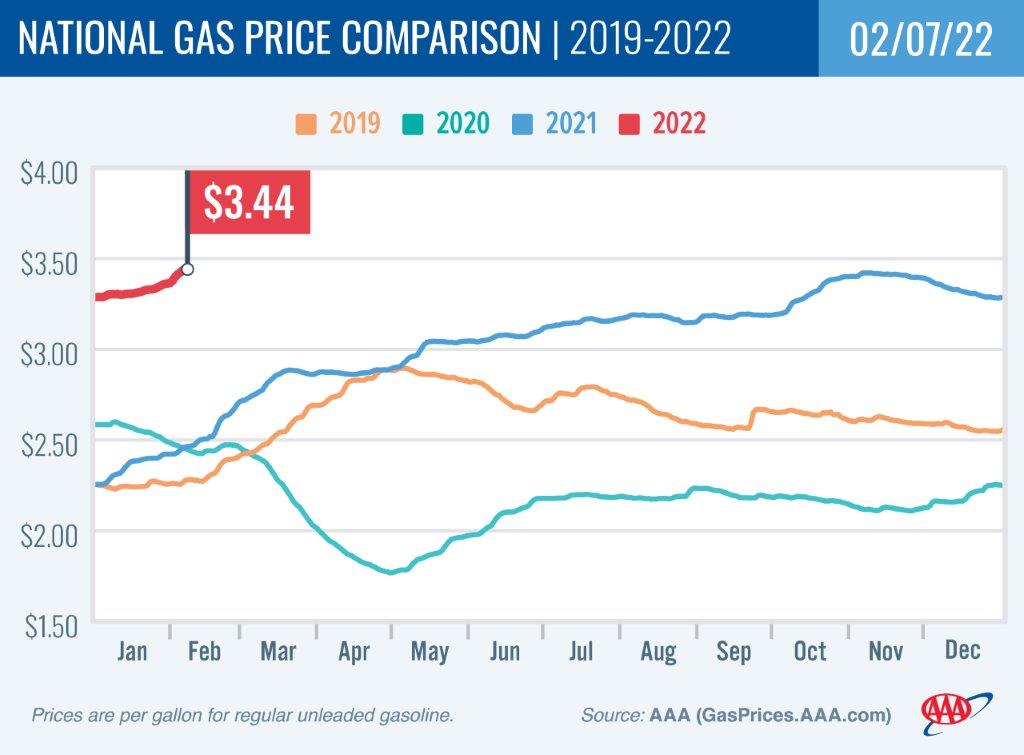
Diesel
For the week, the national average soars a dime to $3.84 a gallon. Oregon’s average adds three cents to $4.16. A year ago the national average for diesel was $2.70 and the Oregon average was $2.79.
Find current fuel prices at GasPrices.AAA.com.
AAA news releases, high resolution images, broadcast-quality video, fact sheets and podcasts are available on the AAA NewsRoom at NewsRoom.AAA.com.
Find local news releases at https://oregon.aaa.com/community/media/media-contacts.html
Fuel prices are updated daily at AAA’s Daily Fuel Gauge at AAA Gas Prices. For more info go www.AAA.com. AAA Oregon/Idaho provides more than 850,000 members with travel, insurance, financial and automotive-related services, and is an affiliate of AAA National, serving more than 62 million motorists in North America.
Updated 2/1/2022
Global Tensions Push Oil Prices Higher
Pump Prices Rise in Most States but Hold Steady in Oregon
PORTLAND, Ore., – Uncertainty over Russia’s intentions toward Ukraine is a driving force behind higher crude oil prices, which are closing in on $90 per barrel. That’s causing gas prices in many states to rise but they’re steady in Oregon for now. For the week, the national average for regular climbs four cents to $3.38 a gallon. The Oregon gas price average slips two-tenths of a cent to $3.92.

“Tensions along the Ukrainian border have helped push crude oil prices higher almost daily over the past week,” says Marie Dodds, public affairs director for AAA Oregon/Idaho. Russia is a member of OPEC+, and any sanctions based on Russia’s actions toward Ukraine may cause it to withhold crude oil from the global market. Higher oil prices will lead to higher pump prices for drivers.
The price of crude oil has risen dramatically in the last two months. It was about $65 per barrel on December 1 compared to $88 today on February 1. Oil supplies were already tight and demand is expected to increase this year as global economies emerge from the coronavirus pandemic.
U.S. gasoline demand rose slightly from 8.22 million b/d to 8.51 million b/d. The increase still puts gas demand in a typical range for the winter driving season, which pre-COVID was 8.8 million b/d in mid-January 2020. Total domestic gasoline stocks grew by 1.3 million bbl to 247.9 million bbl last week, according to the U.S. Energy Information Administration (EIA). Continued growth in crude oil prices has helped maintain elevated pump prices. If oil prices continue to climb toward $90 a barrel, pump prices will likely follow suit.
With the surge of the Omicron variant, travel continues to be impacted by the coronavirus pandemic. Find AAA’s latest COVID-19 information for travelers here.
Quick stats
Oregon is one of six states where prices are lower now than a week ago. All the declines are less than a penny. Idaho (-8/10ths of a cent) has the largest week-over-week decline in the nation. Florida (+12 cents) has the largest weekly increase.
California ($4.64) and Hawaii ($4.40) continue to have the most expensive gas prices in the country and are the only states in the nation with averages above $4 a gallon, while all 50 states and the District of Columbia have averages above $3 a gallon.
The cheapest gas in the nation is in Mississippi ($3.02) and Texas ($3.04). This week no states have averages below $3 a gallon, compared to three a week ago. For the 56th week in a row, no state has an average below $2 a gallon.
Oregon is one of 42 states and the District of Columbia with higher prices now than a month ago. The national average is nine cents more and the Oregon gas price average is 12 cents more than a month ago. This is the 15th-largest monthly increase in the nation. Utah (-11 cents) has the largest month-over-month decrease.
All 50 states and the District of Columbia have higher prices now than a year ago, and 16 states have a current average that’s a dollar or more higher than a year ago. The national average is 96 cents more and the Oregon average gas price is $1.22 more than a year ago. This is the second-largest yearly increase in the nation. California (+$1.23) has the biggest yearly increase. Ohio (+77 cents) has the smallest year-over-year increase.
West Coast
The West Coast region continues to have the most expensive pump prices in the nation with all seven states in the region in the top 10.
| Rank | Region | Price on 2/1/22 | ||
| 1 | California | $4.64 | ||
| 2 | Hawaii | $4.40 | ||
| 3 | Washington | $3.96 | ||
| 4 | Oregon | $3.92 | ||
| 5 | Nevada | $3.81 | ||
| 6 | Alaska | $3.77 | ||
| 7 | District of Columbia | $3.60 | ||
| 8 | Arizona | $3.56 | ||
| 9 | New York | $3.56 | ||
| 10 | Pennsylvania | $3.55 |
California is the most expensive state for the 54th week in a row with Hawaii, Washington, Oregon, Nevada, and Alaska rounding out the top six. Arizona is eighth. Oregon is fourth for the fourth week in a row.
Six of the seven states in the region have some of the smallest changes in the nation this week with averages changing by less than a penny. Hawaii (+4 cents) has the largest weekly gain in the region.
The refinery utilization rate on the West Coast rose is relatively steady, falling from 80.3% to 79.9% for the week ending January 21. The rate has ranged between about 76% and 88% in the last year.
According to EIA’s latest weekly report, total gas stocks in the region rose from 31.09 million bbl to 31.96 million bbl.
Oil market dynamics
The cost of crude oil rose last week despite EIA reporting that total domestic crude stocks increased by 2.4 million bbl to 416.2 million bbl. The current crude stock level is approximately 13 percent lower than in mid-January 2021, contributing to pressure on domestic crude prices. For this week, crude prices could continue to climb if EIA’s next weekly report shows a decrease in total inventory.
At the close of Friday’s formal trading session, WTI increased by 21 cents to settle at $86.82. To At the close of Monday’s formal trading session, WTI rose $1.33 to settle at $88.15. Today crude is trading around $88, compared to $86 a week ago. Crude prices are about $36 more than a year ago.
Drivers can find current gas prices along their route with the free AAA Mobile app for iPhone, iPad and Android. The app can also be used to map a route, find discounts, book a hotel and access AAA roadside assistance. Learn more at AAA.com/mobile.
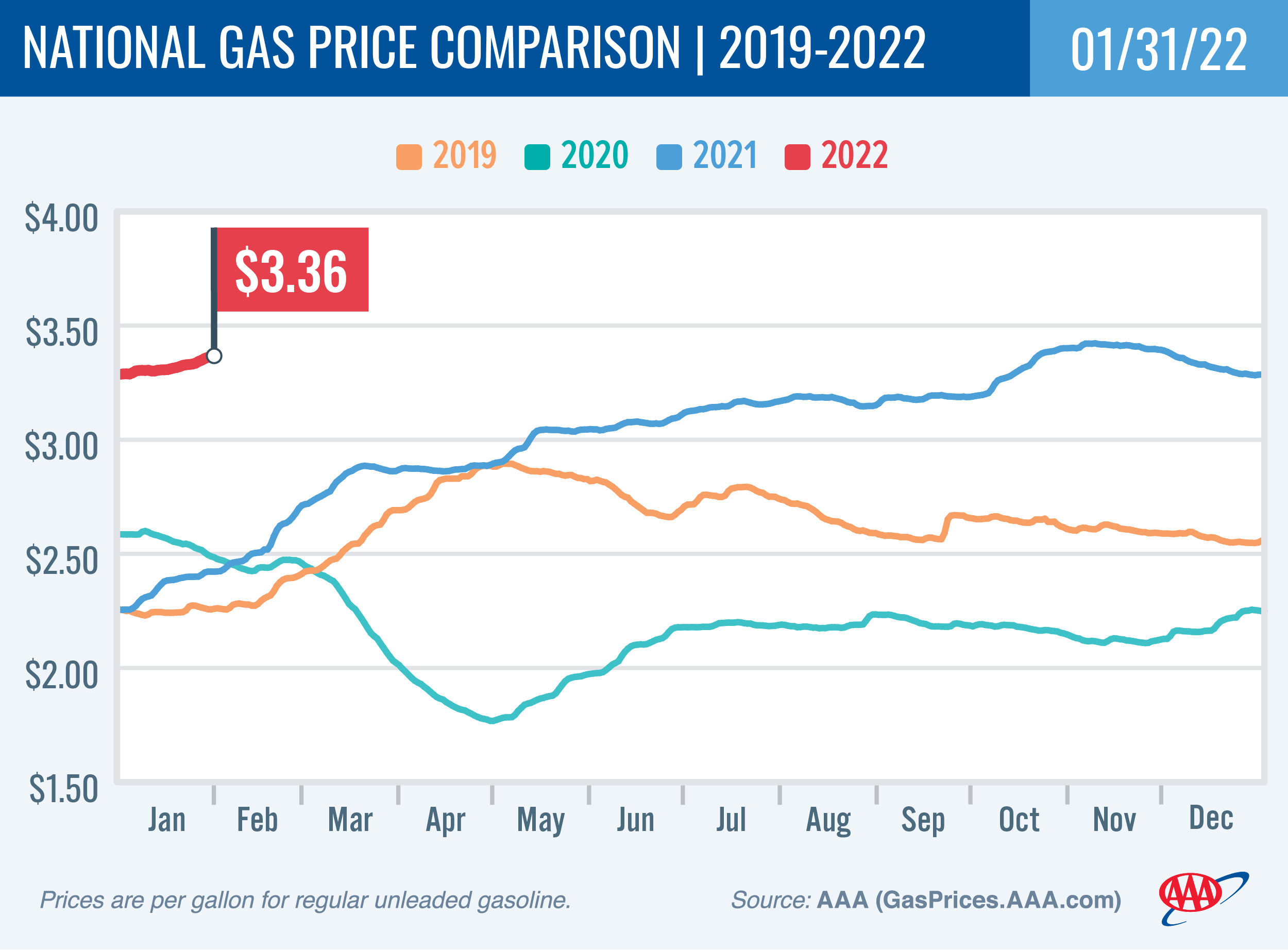
Diesel
For the week, the national average jumps a nickel to $3.73 a gallon. Oregon’s average adds three cents to $4.13. A year ago the national average for diesel was $2.65 and the Oregon average was $2.76.
Find current fuel prices at GasPrices.AAA.com.
AAA news releases, high resolution images, broadcast-quality video, fact sheets and podcasts are available on the AAA NewsRoom at NewsRoom.AAA.com.
Find local news releases at https://oregon.aaa.com/community/media/media-contacts.html
Fuel prices are updated daily at AAA’s Daily Fuel Gauge at AAA Gas Prices. For more info go www.AAA.com. AAA Oregon/Idaho provides more than 850,000 members with travel, insurance, financial and automotive-related services, and is an affiliate of AAA National, serving more than 62 million motorists in North America.
Updated 1/25/2022
Gas Prices Edge Up as Global Oil Supplies Remain Tight
Oregon has second-smallest weekly increase in the country
PORTLAND, Ore., – Despite typical seasonal low demand for gasoline, pump prices are ticking up. The driving force is the rising cost of crude oil which is around $85 per barrel, about $20 more than in November. For the week, the national average for regular rises two cents to $3.34 a gallon. The Oregon gas price average edges up half a cent to $3.93. This is the second-smallest weekly increase for a state average in the country.
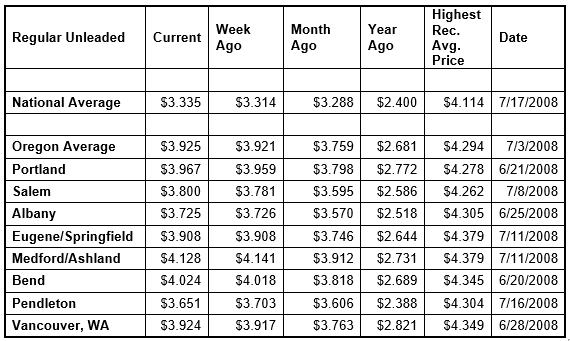
The Oregon average gas price is now at its highest price since July 2014. The national average is at its highest price since December 2021.
“The price of crude oil has skyrocketed from about $65 to $85 per barrel since December 1 based on the belief that demand for crude will rise this year due to expanding economies around the world,” says Marie Dodds, public affairs director for AAA Oregon/Idaho.
Last week, both OPEC and U.S. energy officials said the COVID-19 omicron variant is no longer expected to slow the continued recovery of petroleum demand in 2022. Despite this, OPEC and its allies are maintaining their planned modest production increases and will not dramatically ramp up output. The result will be a continued tight supply of oil.
U.S. gasoline demand rose slightly by 7.91 million b/d to 8.22 million b/d. The slight increase still puts gas demand in the average range for the winter driving season. Total domestic gasoline stocks rose by 5.9 million bbl to 246.6 million bbl last week, according to the U.S. Energy Information Administration (EIA). Typically, pump prices drop due to low gas demand and a rise in supply, but a steady increase in the price of crude oil has prevented this from happening. As oil prices continue to climb, pump prices will likely follow suit.
With the surge of the Omicron variant, travel continues to be impacted by the coronavirus pandemic. Find AAA’s latest COVID-19 information for travelers here.
Quick stats
Oregon is one of 40 states and the District of Columbia with higher prices now than a week ago. Kansas (+7 cents) has the largest weekly increase in the nation. Utah (-3 cents) has the largest week-over-week decline.
California ($4.64) and Hawaii ($4.36) continue to have the most expensive gas prices in the country and are the only states in the nation with averages above $4 a gallon, while 47 states and the District of Columbia have averages above $3 a gallon.
The cheapest gas in the nation is in Kentucky ($2.97) and Mississippi ($2.98). They are among three states that have averages below $3 a gallon. For the 55th week in a row, no state has an average below $2 a gallon.
Oregon is one of 32 states and the District of Columbia with higher prices now than a month ago. The national average is a nickel more and the Oregon gas price average is 17 cents more than a month ago. This is the largest monthly increase in the nation. Utah (-14 cents) has the largest month-over-month decrease.
All 50 states and the District of Columbia have higher prices now than a year ago, and 15 states have a current average that’s a dollar or more higher than a year ago. The national average is 94 cents more and the Oregon average is $1.24 more than a year ago. This is the second-largest yearly increase in the nation. California (+$1.26) has the biggest yearly increase. Kentucky (+71 cents) has the smallest year-over-year increase.
West Coast
The West Coast region continues to have the most expensive pump prices in the nation with all seven states in the region in the top 10.
| Rank | Region | Price on 1/25/22 | ||
| 1 | California | $4.64 | ||
| 2 | Hawaii | $4.36 | ||
| 3 | Washington | $3.96 | ||
| 4 | Oregon | $3.93 | ||
| 5 | Nevada | $3.80 | ||
| 6 | Alaska | $3.77 | ||
| 7 | Arizona | $3.57 | ||
| 8 | District of Columbia | $3.56 | ||
| 9 | Idaho | $3.54 | ||
| 10 | Pennsylvania | $3.53 |
California is the most expensive state for the 53rd week in a row with Hawaii, Washington, Oregon, Nevada, Alaska, and Arizona rounding out the top seven. Oregon is fourth for the third week in a row.
All seven states in the region are seeing small changes this week. Hawaii (+2 cents) has the largest weekly gain in the region. Arizona (-2 cents) has the biggest week-over-week decline.
The refinery utilization rate on the West Coast rose from 76.2% to 80.3% for the week ending January 14. The rate has ranged between about 76% and 88% in the last year.
According to EIA’s latest weekly report, total gas stocks in the region rose from 30.74 million bbl to 31.09 million bbl.
Oil market dynamics
Although crude prices ended the day on Friday down due to weather-related demand concerns, prices generally rose last week despite EIA reporting that total domestic crude stocks increased by 500,000 bbl to 413.8 million bbl. The current crude stock level is approximately 15 percent lower than in mid-January 2021, contributing to pressure on domestic crude prices. For this week, crude prices fell yesterday as markets experienced a sell-off. Oil prices could continue to climb if EIA’s next weekly report shows a decrease in total inventory.
At the close of Friday’s formal trading session, WTI decreased by 41 cents to settle at $85.14. To At the close of Monday’s formal trading session, WTI fell $1.83 to settle at $83.31. Today crude is trading around $84, compared to $85 a week ago. Crude prices are about $31 more than a year ago.
Drivers can find current gas prices along their route with the free AAA Mobile app for iPhone, iPad and Android. The app can also be used to map a route, find discounts, book a hotel and access AAA roadside assistance. Learn more at AAA.com/mobile.

Diesel
For the week, the national average jumps six cents to $3.68 a gallon. Oregon’s average adds four cents to $4.10. A year ago the national average for diesel was $2.64 and the Oregon average was $2.75.
Find current fuel prices at GasPrices.AAA.com.
AAA news releases, high resolution images, broadcast-quality video, fact sheets and podcasts are available on the AAA NewsRoom at NewsRoom.AAA.com.
Find local news releases at https://oregon.aaa.com/community/media/media-contacts.html
Fuel prices are updated daily at AAA’s Daily Fuel Gauge at AAA Gas Prices. For more info go www.AAA.com. AAA Oregon/Idaho provides more than 850,000 members with travel, insurance, financial and automotive-related services, and is an affiliate of AAA National, serving more than 62 million motorists in North America.
Updated 1/18/2022
Climbing Crude Oil Prices Send Pump Prices Higher Despite Lower Demand for Gas
PORTLAND, Ore., – Crude oil prices have surged to around $85 per barrel, and the rising crude prices are elevating gas prices higher at a time of year when they are usually at seasonal lows. For the week, the national average for regular climbs a penny to $3.31 a gallon. The Oregon average adds two cents to $3.92.
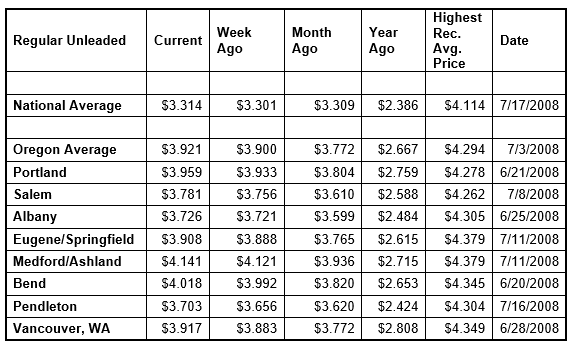
The Oregon gas price average is now at its highest price since July 2014. The national average is at its highest price since December 2021.
Crude oil has surged to around $85 a barrel, fueled by the perception that the COVID-19 Omicron variant may ebb, allowing the world’s economic engines to kick into high gear. The potential increase in oil demand, coupled with lagging crude production, will only increase prices. Since the price of oil accounts for roughly half of what consumers pay at the pump, higher oil costs usually translate into higher fuel costs.
“Since December 1, crude oil has climbed from the mid-$60s to the mid-$80s,” says Marie Dodds, public affairs director for AAA Oregon/Idaho. “The driving factor is global optimism, whether well-founded or not, that the worst of the pandemic may be in the rear view mirror.”
U.S. gasoline demand decreased from 8.17 million b/d to 7.91 million b/d. Winter weather and the COVID-19 omicron variant are the likely reasons behind this recent demand dip. Total domestic gasoline stocks rose by 7.9 million bbl to 240.7 million bbl last week, according to the U.S. Energy Information Administration (EIA). Typically, pump prices decline due to lower gas demand and a rise in total stocks, but continued growth in the price of crude oil has helped to elevate pump prices. As oil prices continue to climb, pump prices will likely follow suit.
With the surge of the Omicron variant, travel continues to be impacted by the coronavirus pandemic. Find AAA’s latest COVID-19 information for travelers here.
Quick stats
Oregon is one of 26 states and the District of Columbia with higher prices now than a week ago. Iowa (+6 cents) has the largest weekly increase in the nation. Ohio (-5 cents) has the largest week-over-week decline.
California ($4.65) and Hawaii ($4.33) continue to have the most expensive gas prices in the country and are the only states in the nation with averages above $4 a gallon, while 42 states and the District of Columbia have averages above $3 a gallon.
The cheapest gas in the nation is in Texas ($2.95) and Mississippi ($2.95). They are among eight states that have averages below $3 a gallon. For the 54th week in a row, no state has an average below $2 a gallon.
Oregon is one of 20 states and the District of Columbia with higher prices now than a month ago. The national average is one-half cent more and the Oregon average is 15 cents more than a month ago. This is the largest monthly increase in the nation. Utah (-15 cents) has the largest month-over-month decrease.
All 50 states and the District of Columbia have higher prices now than a year ago, and 17 states have a current average that’s a dollar or more higher than a year ago. The national average is 93 cents more and the Oregon average gas price is $1.25 more than a year ago. This is the third-largest yearly increase in the nation. California (+$1.30) has the biggest yearly increase. Ohio (+73 cents) has the smallest year-over-year increase.
West Coast
The West Coast region continues to have the most expensive pump prices in the nation with all seven states in the region in the top 10.
| Rank | Region | Price on 1/18/22 | ||
| 1 | California | $4.65 | ||
| 2 | Hawaii | $4.33 | ||
| 3 | Washington | $3.96 | ||
| 4 | Oregon | $3.92 | ||
| 5 | Nevada | $3.81 | ||
| 6 | Alaska | $3.76 | ||
| 7 | Arizona | $3.58 | ||
| 8 | Idaho | $3.55 | ||
| 9 | Pennsylvania | $3.52 | ||
| 10 | District of Columbia | $3.51 |
California is the most expensive state for the 52nd week in a row with Hawaii, Washington, Oregon, Nevada, Alaska, and Arizona rounding out the top seven. Oregon is fourth for the second week in a row.
Oregon (+2 cents), Washington (+2 cents), Alaska (+1 cent) are seeing week-over-week increases. Oregon has the largest weekly gain in the region. Arizona (-1 cent), Hawaii (-1/2 cent), California (-1/2 cent), and Nevada (-1/2 cent) have week-over-week declines.
The refinery utilization rate on the West Coast dropped from 82.2% to 76.2% for the week ending January 7. The rate had ranged between 82% and 88% in the last year.
According to EIA’s latest weekly report, total gas stocks in the region rose from 28.87 million bbl to 30.74 million bbl.
Oil market dynamics
Crude prices rose last week after the EIA reported that total domestic crude stocks decreased by 4.6 million bbl to 413.3 million bbl. The current stock level is approximately 14.3 percent lower than during the first week of January 2021, contributing to pressure on domestic crude prices. For this week, crude prices could continue to climb if EIA’s next report shows another decrease in total inventory.
At the close of Friday’s formal trading session, WTI increased by $1.70 to settle at $83.82. Today crude is trading around $85, compared to $81 a week ago. Crude prices are about $30 more than a year ago.
Drivers can find current gas prices along their route with the free AAA Mobile app for iPhone, iPad and Android. The app can also be used to map a route, find discounts, book a hotel and access AAA roadside assistance. Learn more at AAA.com/mobile.
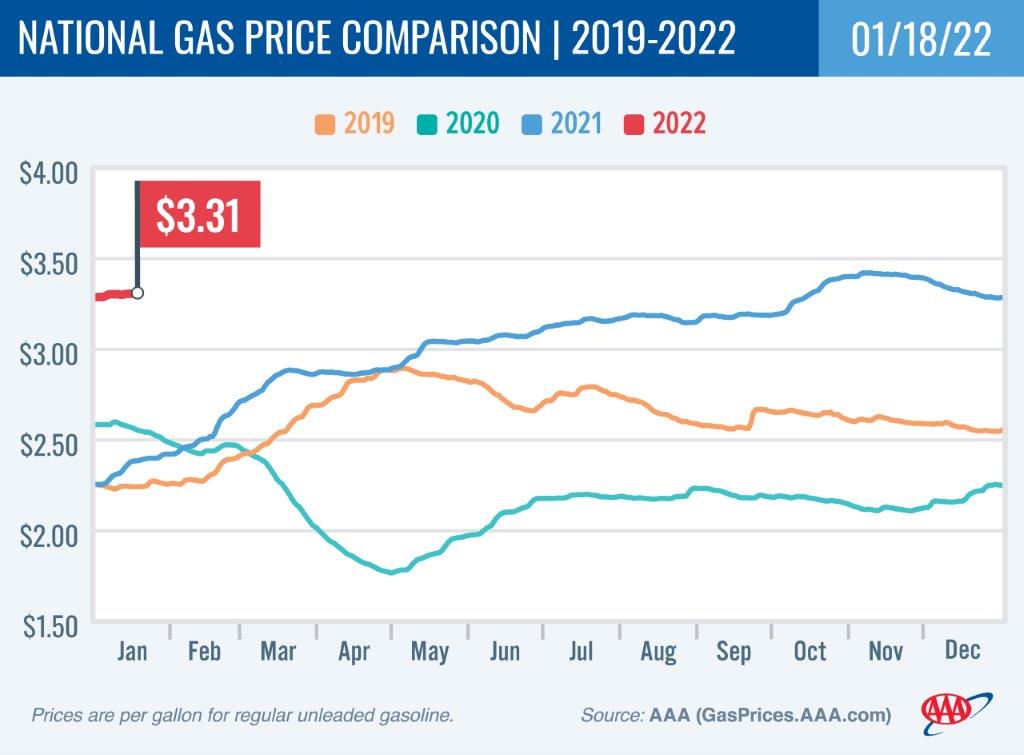
Diesel
For the week, the national average gains three cents to $3.62 a gallon. Oregon’s average shoots up eight cents to $4.06. A year ago the national average for diesel was $2.63 and the Oregon average was $2.75.
Find current fuel prices at GasPrices.AAA.com.
AAA news releases, high resolution images, broadcast-quality video, fact sheets and podcasts are available on the AAA NewsRoom at NewsRoom.AAA.com.
Find local news releases at https://oregon.aaa.com/community/media/media-contacts.html
Fuel prices are updated daily at AAA’s Daily Fuel Gauge at AAA Gas Prices. For more info go www.AAA.com. AAA Oregon/Idaho provides more than 850,000 members with travel, insurance, financial and automotive-related services, and is an affiliate of AAA National, serving more than 62 million motorists in North America.
Updated 1/11/2022
Pump Prices Climb due to Rising Crude Prices, Refinery Issues
Oregon has fifth-largest weekly jump in the country
PORTLAND, Ore., – Gas prices are moving higher, driven primarily by a jump in crude oil prices. Some refinery and distribution issues in the Pacific Northwest are causing prices here to rise faster than the national average. For the week, the national average for regular climbs a penny to $3.30 a gallon. The Oregon average jumps seven cents to $3.90. This is the fifth-largest weekly jump of a state average in the nation.

The Oregon average gas price is now at its highest price since August 2014. The national average is at its highest price since December 2021.
Crude oil has surged to $80 a barrel. Events on the far side of the globe are fueling the recent rise. Social unrest and violence in Kazakhstan, a member of the OPEC+ alliance, have forced that nation to cut production. Before the recent flare-up of violence, Kazakhstan pumped nearly 2 million barrels of crude a day. In contrast, the United States, as the top oil-producing country in the world, pumped an average of 18.6 million barrels a day.
“Since the global price for oil accounts for nearly half of what consumers pay at the pump, higher oil costs will usually result in higher gasoline costs,” says Marie Dodds, public affairs director for AAA Oregon/Idaho. “Markets, in general, don’t like uncertainty and volatility, and the oil market is no exception. The oil production cuts by Kazakhstan demonstrate that in times of tight supply, it doesn’t take much to put upward pressure on the overall price of oil.”
Here in the Pacific Northwest, some refinery and distribution snags have led to some supply disruptions. At least two refineries including HollyFrontier Puget Sound and Phillips 66 Ferndale have reportedly had some issues, impacting Washington and Oregon. Weather has also played a role. Mountain snow has made traveling over the passes challenging, and flooding has impacted roads in Washington.
“The West Coast region tends to produce about as much gasoline as is consumed. So when refinery and distribution issues put a crimp in supplies, prices can climb in a hurry,” adds Dodds.
Crude oil ended 2021 at $75 per barrel, then rose above $79 on Jan. 6. Crude oil prices tumbled in late November from $84 per barrel to below $70 per barrel, due to fears of a global shutdown and decreased demand for oil caused by news of the Omicron variant.
U.S. gasoline demand decreased from 9.72 million b/d to 8.17 million b/d. Total domestic gasoline stocks rose by 10.1 million bbl to 232.8 million bbl last week, according to the U.S. Energy Information Administration (EIA). Typically, pump prices decline due to lower gas demand and a rise in total stocks, but continued growth in the price of crude oil has helped to elevate pump prices. As oil prices continue to climb near $80 a barrel, pump prices will likely follow suit.
With the surge of the Omicron variant, travel continues to be impacted by the coronavirus pandemic. Find AAA’s latest COVID-19 information for travelers here.
Quick stats
Oregon is one of 23 states and the District of Columbia with higher prices now than a week ago. Indiana (+15 cents) has the largest weekly increase in the nation. Oregon (+7 cents) has the fifth-largest weekly increase. Utah (-4 cents) has the largest week-over-week decline.
California ($4.65) and Hawaii ($4.34) continue to have the most expensive gas prices in the country and are the only states in the nation with averages above $4 a gallon, while 42 states and the District of Columbia have averages above $3 a gallon.
The cheapest gas in the nation is in Texas ($2.90) and Oklahoma ($2.92). They are among eight states that have averages below $3 a gallon. For the 53rd week in a row, no state has an average below $2 a gallon.
Oregon is one of only seven states and the District of Columbia with higher prices now than a month ago. The national average is three cents less and the Oregon average is 11 cents more than a month ago. This is the largest monthly increase in the nation. Arizona (-16 cents) has the largest month-over-month decrease.
All 50 states and the District of Columbia have higher prices now than a year ago, and 21 states have a current average that’s a dollar or more higher than a year ago. The national average is 98 cents more and the Oregon gas price average is $1.26 more than a year ago. This is the fourth-largest yearly increase in the nation. California (+$1.36) has the biggest yearly increase. Kentucky (+76 cents) has the smallest year-over-year increase.
West Coast
The West Coast region continues to have the most expensive pump prices in the nation with all seven states in the region in the top 10.
| Rank | Region | Price on 1/11/22 | ||
| 1 | California | $4.65 | ||
| 2 | Hawaii | $4.34 | ||
| 3 | Washington | $3.94 | ||
| 4 | Oregon | $3.90 | ||
| 5 | Nevada | $3.82 | ||
| 6 | Alaska | $3.75 | ||
| 7 | Arizona | $3.60 | ||
| 8 | Idaho | $3.55 | ||
| 9 | Pennsylvania | $3.52 | ||
| 10 | Connecticut | $3.49 |
California is the most expensive state for the 51st week in a row with Hawaii, Washington, Oregon, Nevada, Alaska, and Arizona rounding out the top seven. Oregon moves up a spot to fourth after 13 weeks at fifth.
Oregon (+7 cents), Washington (+5 cents), Alaska (+4 cents) and Hawaii (+1 cent) are seeing week-over-week increases. Oregon (+7 cents) has the largest weekly gain in the region. Arizona (-2 cents), Nevada (-2 cents) and California (-1/2 cent) have week-over-week declines.
The refinery utilization rate on the West Coast decreased from 83.8% to 82.2% for the week ending December 31. The rate has ranged between 82% and 88% in the last year.
According to EIA’s latest weekly report, total gas stocks in the region rose from 27.39 million bbl to 28.87 million bbl.
Oil market dynamics
Although crude oil prices moved lower on Friday due to contract pricing fluctuations at the beginning of the year and demand concerns over the COVID-19 omicron variant, crude prices increased overall last week after the EIA reported that total domestic crude stocks decreased by 2.1 million bbl last week to 417.9 million bbl. The current stock level is approximately 14 percent lower than at the end of December 2020, contributing to pressure on domestic crude prices. For this week, crude prices could continue to climb if EIA’s next report shows another inventory decline.
At the close of Friday’s formal trading session, WTI decreased by 56 cents to settle at $78.90. At the close of Monday’s formal trading session, WTI fell 67 cents to close at $78.23. Today crude is trading around $81, compared to $77 a week ago. Crude prices are about $26 more than a year ago.
Drivers can find current gas prices along their route with the free AAA Mobile app for iPhone, iPad and Android. The app can also be used to map a route, find discounts, book a hotel and access AAA roadside assistance. Learn more at AAA.com/mobile.
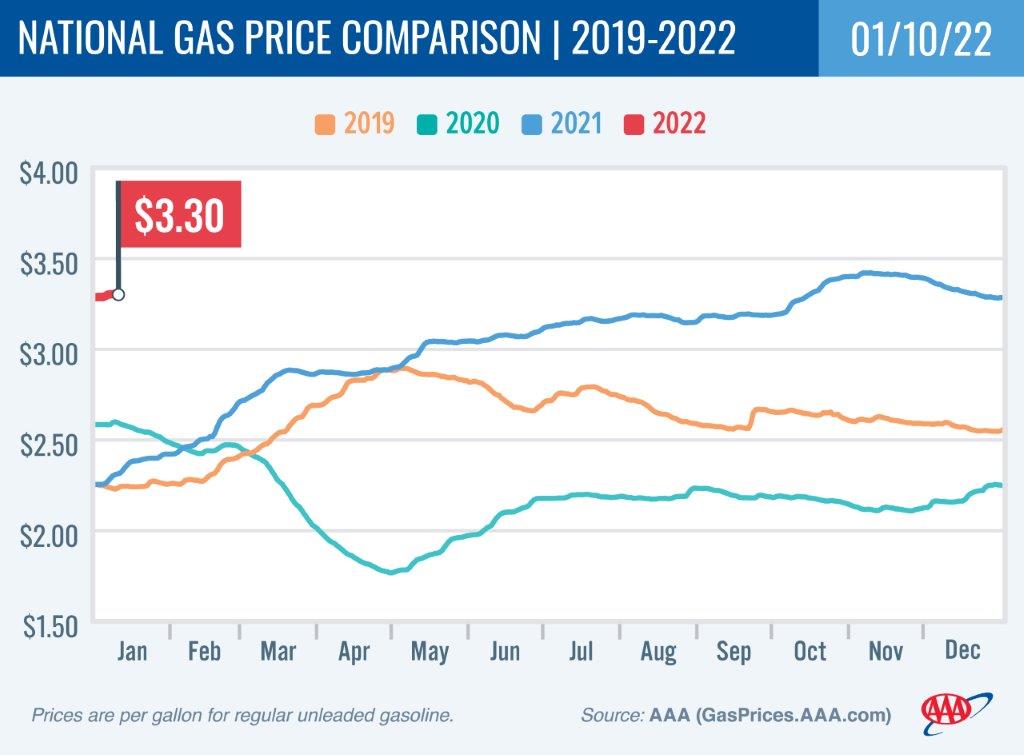
Diesel
For the week, the national average adds a penny to $3.59 a gallon. Oregon’s average shoots up 11 cents to $3.98. A year ago the national average for diesel was $2.59 and the Oregon average was $2.73.
Find current fuel prices at GasPrices.AAA.com.
AAA news releases, high resolution images, broadcast-quality video, fact sheets and podcasts are available on the AAA NewsRoom at NewsRoom.AAA.com.
Find local news releases at https://oregon.aaa.com/community/media/media-contacts.html
Fuel prices are updated daily at AAA’s Daily Fuel Gauge at AAA Gas Prices. For more info go www.AAA.com. AAA Oregon/Idaho provides more than 850,000 members with travel, insurance, financial and automotive-related services, and is an affiliate of AAA National, serving more than 62 million motorists in North America.
Updated 1/4/2022
Refinery, Distribution, Weather Issues Send Pump Prices Higher
Oregon has largest weekly jump in the country
PORTLAND, Ore., – A refinery fire in Texas and some distribution snags in the Pacific Northwest are putting upward pressure on pump prices as 2022 begins. For the week, the national average for regular edges up half a cent to $3.29 a gallon. The Oregon average gas price shoots up six cents to $3.83. This is the largest weekly jump in the nation.
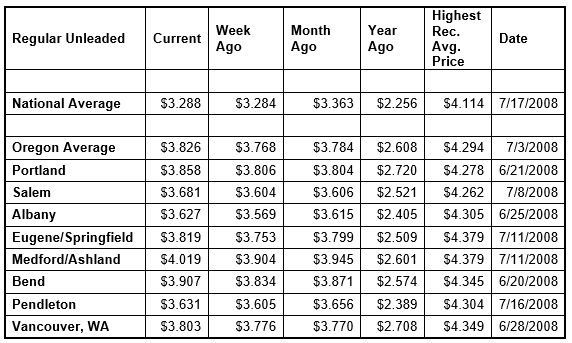
A pre-Christmas fire at the Exxon Mobil Corp plant in Baytown, Texas, is causing reduced output. Recent reporting, however, indicates the damage was to a non-refining section of the complex. The plant is the nation’s fourth-biggest oil refinery, with the capacity to process 560,500 barrels per day of crude.
Here in the Pacific Northwest, some issues at terminals in the Portland area as well as winter weather shutting down mountain passes have created tight supplies, causing retail pump prices to rise.
“In addition to the refinery and terminal issues, the Omicron variant is also influencing oil and fuel prices, as fears of the economic impact create uncertainty,” says Marie Dodds, public affairs director for AAA Oregon/Idaho. “Investors worry that the surge in COVID-19 cases due to the Omicron variant will lead to reduced future global oil consumption.”
Crude oil dropped to $68 per barrel on Dec. 20, then climbed above $75 per barrel on Dec. 27 and has remained above that benchmark since then. Crude oil prices tumbled in late November from $84 per barrel to below $70 per barrel, due to fears of a global shutdown and decreased demand for oil caused by news of the Omicron variant.
U.S. gasoline demand increased from 8.99 million b/d to 9.72 million b/d. Total domestic gasoline stocks decreased slightly by 1.5 million bbl to 222.7 million bbl last week, according to the U.S. Energy Information Administration (EIA). Growing demand and tight supply would support more significant increases in pump prices, but fluctuations in the price of crude oil have helped to limit price increases. If oil prices climb, pump prices will likely follow suit.
With the surge of the Omicron variant, travel continues to be impacted by the coronavirus pandemic. Find AAA’s latest COVID-19 information for travelers here.
Quick stats
Oregon is one of 22 states and the District of Columbia with higher prices now than a week ago. Oregon (+6 cents) has the largest weekly increase in the nation. Arizona (-4 cents) has the largest week-over-week decline.
California ($4.66) and Hawaii ($4.33) continue to have the most expensive gas prices in the country and are the only states in the nation with averages above $4 a gallon, while 39 states and the District of Columbia have averages above $3 a gallon.
The cheapest gas in the nation is in Oklahoma ($2.89) and Texas ($2.91). They are among 11 states that have averages below $3 a gallon. For the 52nd week in a row, no state has an average below $2 a gallon.
Oregon and Washington are the only two states that have higher prices now than a month ago. The national average is eight cents less and the Oregon average gas price is four cents more than a month ago. Michigan (-17 cents) has the largest month-over-month decrease.
All 50 states and the District of Columbia have higher prices now than a year ago, and 26 states and D.C. have a current average that’s a dollar or more higher than a year ago. The national average is $1.03 more and the Oregon average is $1.22 more than a year ago. This is the sixth-largest yearly increase in the nation. California (+$1.41) has the biggest yearly increase. Ohio (+82 cents) has the smallest year-over-year increase.
West Coast
The West Coast region continues to have the most expensive pump prices in the nation with all seven states in the region in the top 10.
| Rank | Region | Price on 1/4/22 | ||
| 1 | California | $4.66 | ||
| 2 | Hawaii | $4.33 | ||
| 3 | Washington | $3.89 | ||
| 4 | Nevada | $3.84 | ||
| 5 | Oregon | $3.83 | ||
| 6 | Alaska | $3.71 | ||
| 7 | Arizona | $3.62 | ||
| 8 | Idaho | $3.57 | ||
| 9 | Pennsylvania | $3.53 | ||
| 10 | Connecticut | $3.50 |
California is the most expensive state for the 50th week in a row with Hawaii, Washington, Nevada, Oregon, Alaska, and Arizona rounding out the top seven. Oregon is fifth for the 13th week in a row.
Four of the seven states in the region are seeing week-over-week increases. Oregon (+6 cents) has the largest weekly gain in the region and the country. Arizona (-4 cents) has the largest week-over-week decline in the region and the country.
The refinery utilization rate on the West Coast decreased from 84.3% to 83.8% for the week ending December 24. The rate has ranged between 82% and 88% in the last year.
According to EIA’s latest weekly report, total gas stocks in the region fell from 28.24 million bbl to 27.39 million bbl.
Oil market dynamics
Despite demand concerns over the omicron variant of COVID-19, crude prices have increased since the EIA reported that total domestic oil stocks decreased by 3.6 million bbl last week to 420 million bbl. The current stock level is 14.9 percent lower than at the end of December 2020, contributing to domestic crude prices. This week, prices could continue to climb if EIA’s next weekly report shows another decrease in total stocks.
At the close of Friday’s formal trading session, WTI decreased by $1.78 to settle at $75.21. At the close of Monday’s formal trading session, WTI added 87 cents to close at $76.08. Today crude is trading around $77, compared to $76 a week ago. Crude prices are about $28 more than a year ago.
Drivers can find current gas prices along their route with the free AAA Mobile app for iPhone, iPad and Android. The app can also be used to map a route, find discounts, book a hotel and access AAA roadside assistance. Learn more at AAA.com/mobile.
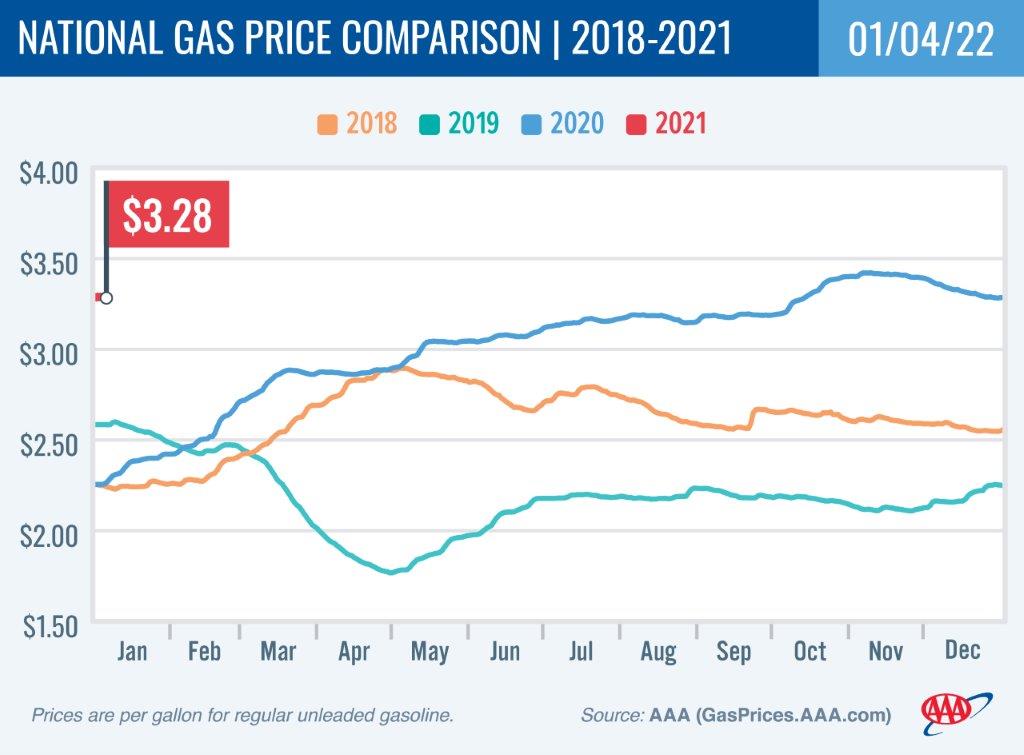
Diesel
For the week, the national average holds steady at $3.57 a gallon. Oregon’s average jumps six cents to $3.87. A year ago the national average for diesel was $2.57 and the Oregon average was $2.73.
Find current fuel prices at GasPrices.AAA.com.
AAA news releases, high resolution images, broadcast-quality video, fact sheets and podcasts are available on the AAA NewsRoom at NewsRoom.AAA.com.
Find local news releases at https://oregon.aaa.com/community/media/media-contacts.html

